












































FIX IT FAST WITH K-SEAL kseal.com MADE IN THE USA Also Seals Cracked Heads & Cracked Porous Blocks 9 Can Be Added to a Hot or Cold Engine* 9 NOT liquid glass / Sodium Silicate 9 Can Be Added to the Overflow Tank Coolant Leak? Just Shake, Pour & Go Permanently Fix Leaks in the: 9 Radiator 9 Water Pump Casing 9 Heater Core 9 Freeze Plug 9 Block / Head 9 Head Gasket AND MOST FINE RETAILERS * WARNING/Caution: Take care before opening the cooling system when engine hot as it may be under pressure and could cause injury. Always consult a qualified mechanic before proceeding. If in doubt wait until engine cools or add via overflow tank. AVAILABLE AT: K-Seal has been independently tested to meet ASTM D3147. Works on hard plastic and safe for use with all water cooled engines. WORKSON ALUMINUMHEADS NO DRAINING NO FLUSHING
CONGRATULATIONS ON 75 YEARS OF RACING ENTERTAINMENT


















WinCraft celebrates 30 years as a NASCAR licensee, employing over 600 people, embracing domestic manufacturing and servicing fans nationwide.




























FLAGS � LICENSE PLATES � DRINKWARE � DECALS � COLLECTOR PINS � MORE AVAILABLE
STORE.NASCAR.COM GOD BLESS AMERICA
24/7/365 ON
FOUNDERS DAY





DECEMBER 14, 1947


• A series of three meetings convened at the Streamline Hotel to establish criteria for professional stock car racing, leading to the formation of NASCAR. In this group: Front row, kneeling (L-R) - Chick DiNatale, Jimmy Quisenberry, Ed Bruce, Jack Peters, Alvin Hawkins. Back row, standing (L-R) - Freddie Horton, Sam Packard, Ed Samples (hidden), Joe Ross, Marshall Teague, Bill Tuthill, Joe Littlejohn, Bob Osiecki, Buddy Shuman, Lucky Sauer (hidden), Tom Galan, Eddie Bland, Bill France Sr., Bob Richards, Harvey Tattersall Jr., Fred Dagavar, Bill Streeter and Jimmy Cox. (Photo by ISC Archives/CQ-Roll Call Group via Getty Images)
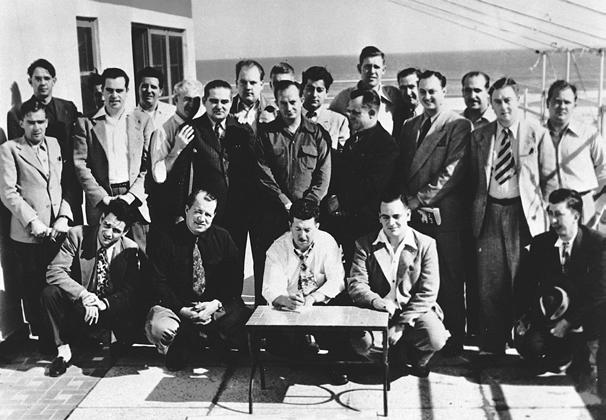
• The site and location where it all began, the Streamline Hotel in Daytona Beach, Florida. Preliminary meetings for the formation of NASCAR were held here in 1947, with incorporation taking place the following year. (Photo by ISC Archives/CQ-Roll Call Group via Getty Images)

• This was the scene in what was called the “smoke-filled room,” as 35 men met to form what would ultimately become the National Association for Stock Car Automobile Racing (NASCAR). The room was located on the second floor of the Streamline Hotel in Daytona Beach, Florida. (Photo by ISC Images Archives via Getty Images)
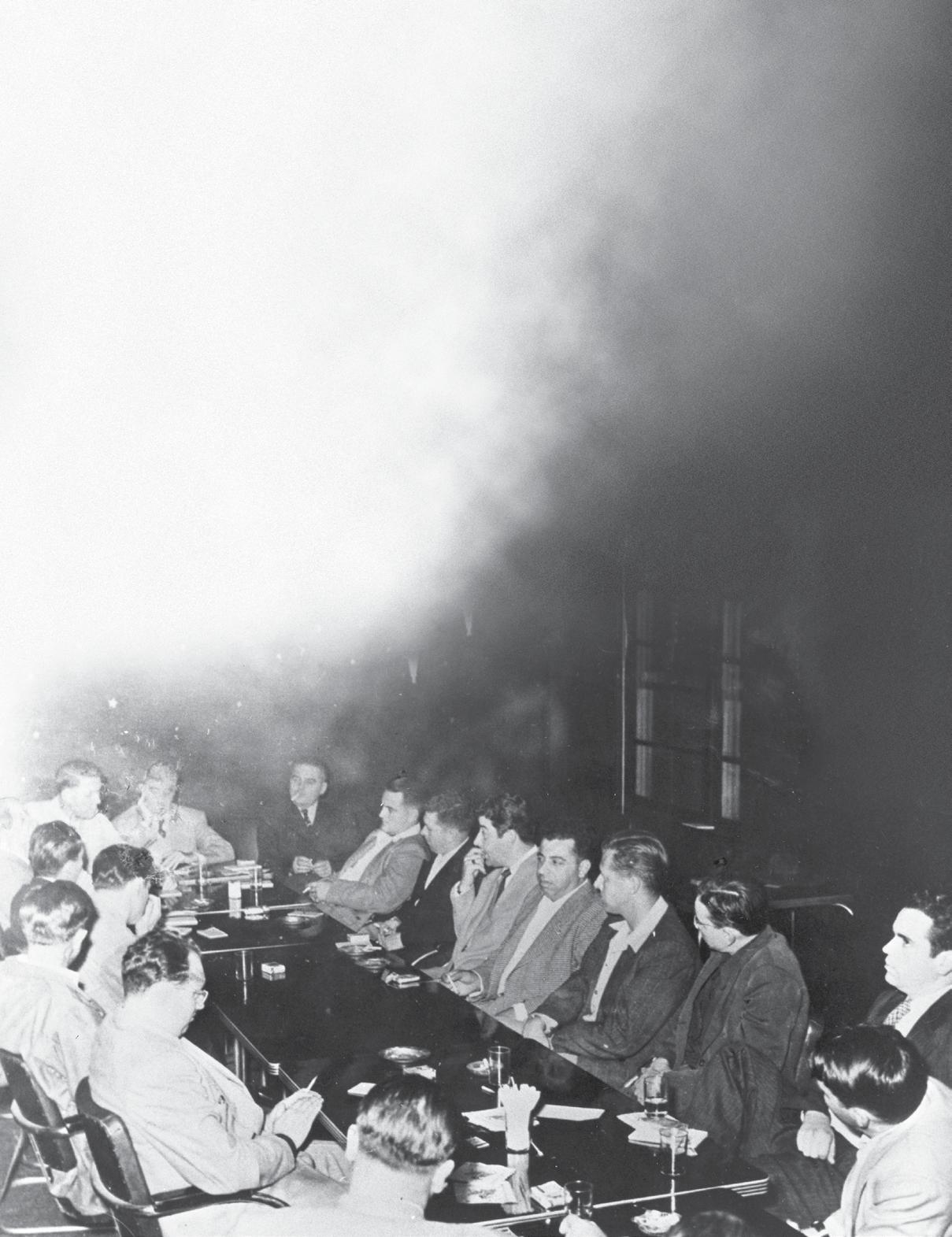
02 PHOTOGRAPHY: GETTY IMAGES FOUNDERS DAY

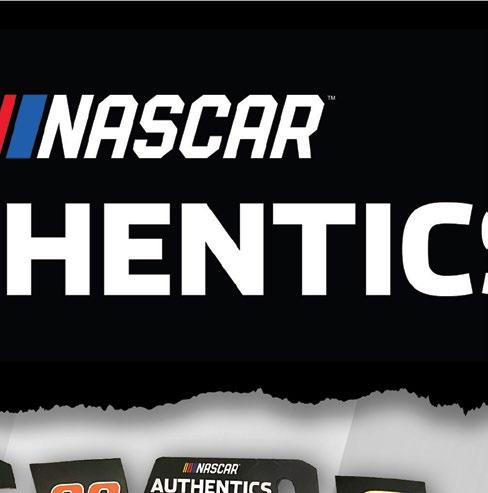


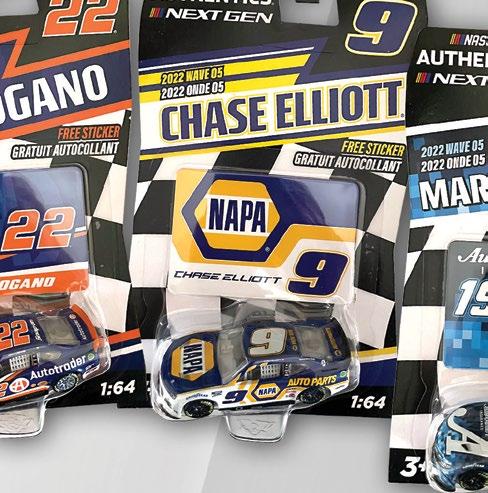




NASCAR LOGOS THROUGH THE YEARS

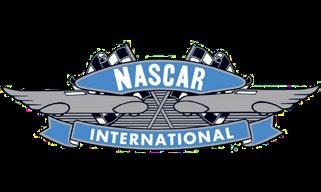

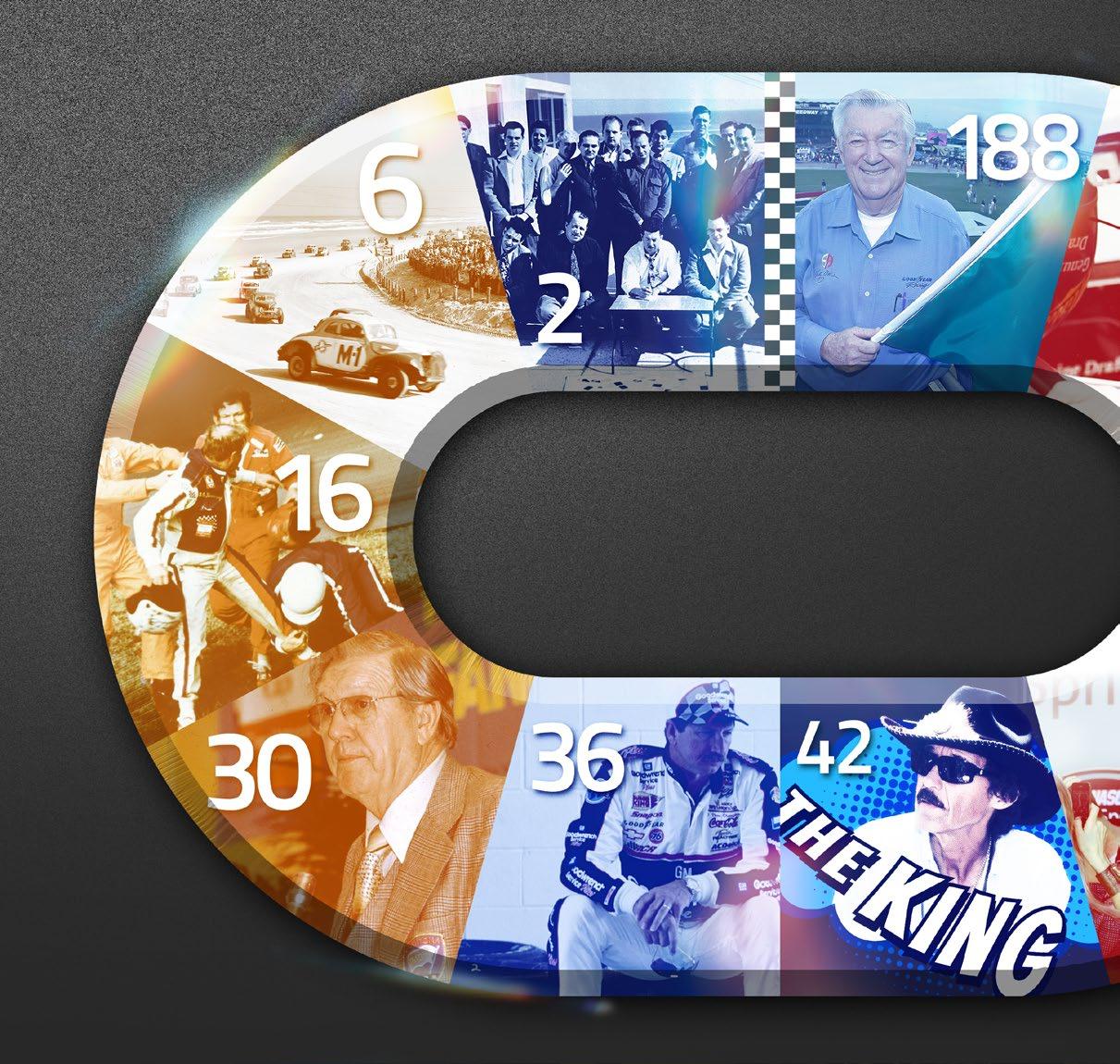
04 PHOTOGRAPHY: GETTY IMAGES
75 YEARS OF RACING HISTORY
1948-1955 1956-1963 1964-1975
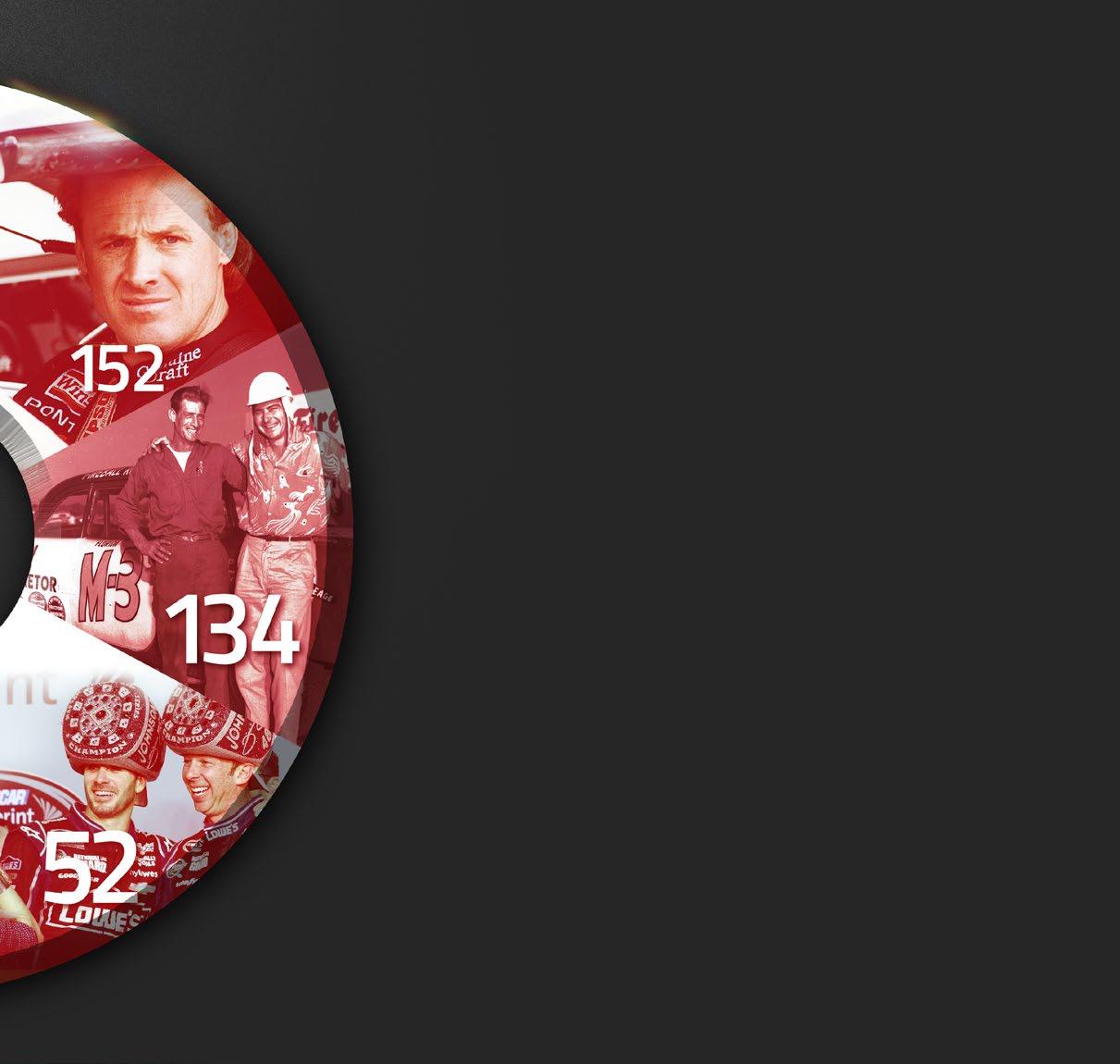






02 Founders Day 06 NASCAR at 75 16 12 Moments that Defined NASCAR 30 Trailblazers & Game Changers 32 Greatest Owners 34 Best Rivalries 36 Biggest Troublemakers 38 NASCAR’s Heartbreakers 40 Iconic Sponsors 42 Legendary Nicknames 44 Milestone Moments 52 Year-By-Year Recaps 128 Evolution of the NASCAR Cup Series Car 134 Don’t Call it a Throwback 138 Gone But Not Forgotten 148 Telling the NASCAR Story 150 Racing Collectibles 152 Legends of the Sport 188 Reflections of a Champion: Bobby Allison 192 What NASCAR Means to Me 05 PHOTOGRAPHY: GETTY IMAGES 1976-2016 2017-PRESENT 2023 CONTENTS
BY MIKE NEFF




The history of NASCAR is filled with colorful characters and remarkable stories. As the sanctioning body celebrates its 75th anniversary, it is a good opportunity to look back at the names, places and events that have shaped the sport.
It all started in the 1940s on the dusty dirt tracks scattered across the Southeast. It progressed through the development of superspeedways, purpose-built race cars, corporate involvement, a safety crisis and the social media explosion to the uber competitive sport that we have today.

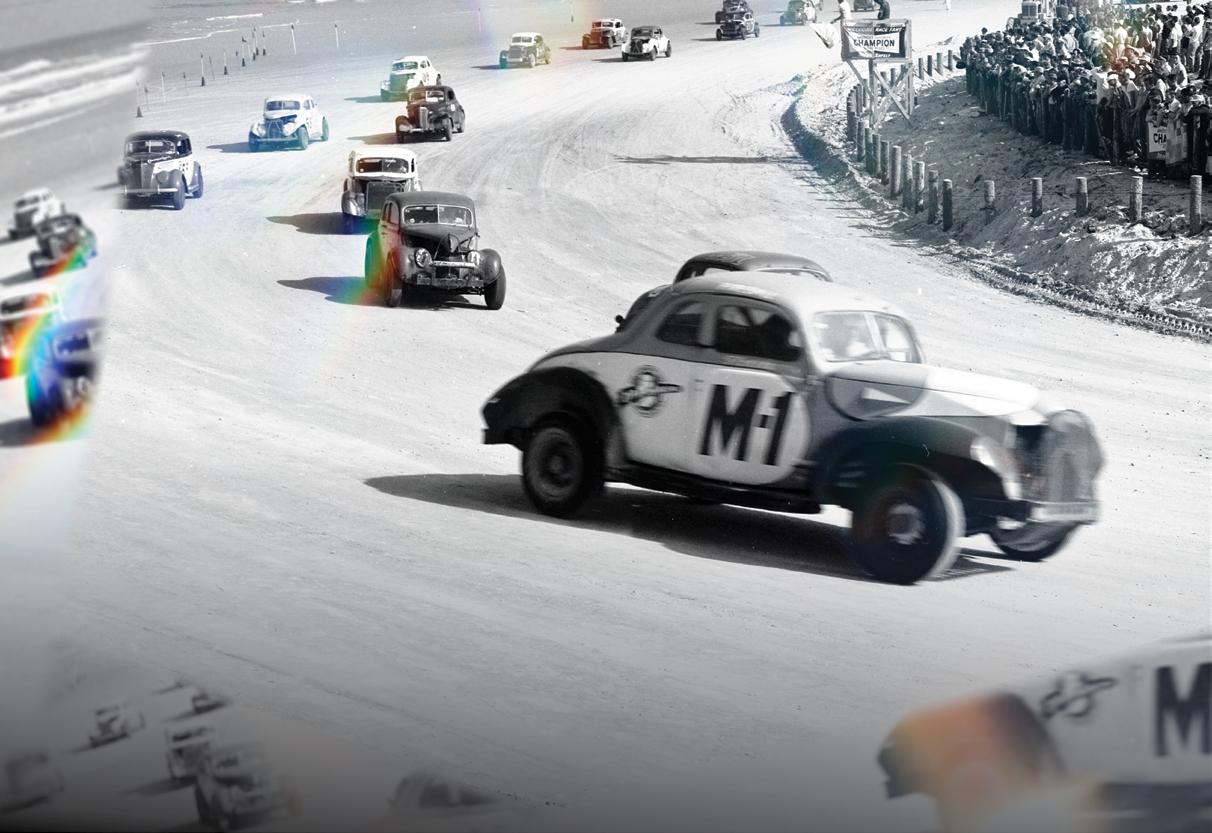
It is a commonly held belief that the first auto race occurred when the second automobile was built. It might not have happened quite that quickly but the competitive nature of human beings has always shown through and, when you have people who modify machines to perform better than originally designed, they are going to want to find out who built the best version.




In the hills of Appalachia, moonshine was a way of life dating back to the founding of the country. The practice of distilling accelerated during prohibition. The basic premise that the whiskey was not taxed, immediately set up a competition among the people making the hooch and the people responsible for collecting the taxes or stopping the creation of the illegal liquor.
In order for the moonshiners to evade the revenue officers, they modified their cars to be faster and handle better than those driven by the authorities. It wasn’t long before the moonshiners decided to get together and see who had the fastest car.
As the races became bigger and more popular, individuals started promoting them and promising







































































































































































06 NASCAR AT 75
prize money for the winners. This immediately presented opportunities for unscrupulous characters. There were few to no rules for the cars and, routinely, these promoters would put on the race, collect the gate and skip out before the checkered flag, leaving the winners begging for their winnings.

In the mid-’40s, “Big Bill” France, a racer and businessman who lived in Daytona Beach, Florida, mounted an effort to bring organization and structure to the sport of stock-car racing.
After a meeting at the Streamline Hotel in December 1947, the National Association for Stock Car Auto Racing was incorporated. It took a year to put the Strictly Stock division together but in 1949, some 12,000 fans attended the first race in Charlotte, North Carolina, and the rest is history.
That first year of the Cup Series saw eight races make up the entire schedule. The following year was a 19-race schedule that laid the groundwork for the












































early years of the sport. The barnstorming years ran from 1949 through 1971.
After the first two years, the average season had 48 races per year. 1964 saw the most races in a single season with 62. Richard Petty was the champion that year for the first of his seven titles. Three years later, while securing his second championship, Petty set the record for the most wins in a single season. He visited Victory Lane 27 times out of the 48 races he contested that year.
1972 was the beginning of what is known as the Modern Era of NASCAR. R.J. Reynolds Tobacco Co. approached Junior Johnson, one of the early superstars of the sport, to discuss sponsorship for his team. Early in the discussions, Johnson realized the dollars being tossed around were far bigger than just a race team.
The end result was R.J. Reynolds becoming the title sponsor of NASCAR’s premier series and rebranding it to the Winston Cup Series. A couple of the changes, besides the huge increase in money behind the sport, altered the sport for decades to come.
Dirt-track racing was dropped from the schedule. The final dirt race was run in Raleigh, North Carolina, until the series returned to dirt in 2021. Races were also removed from small short tracks. Race tracks shorter than a half mile were dropped from the schedule and still have not returned, other than the exhibition race at the iconic L.A. Memorial Coliseum.
Early in the Modern Era, NASCAR racing slowly evolved into a business. Purpose-built race cars and sponsorships became commonplace but, for the most part, things were still very local and regional.
That changed as the end of the 1980s and beginning of the ’90s rolled around. Corporate sponsorship came to the forefront with national companies recognizing that NASCAR was at the doorstep of an explosion in popularity. Dale Earnhardt was the blue- collar champion of the sport who, by the mid’90s, became the second seven-time champion in NASCAR history.
Jeff Gordon was the newcomer and he became the de facto poster boy for corporate involvement in the sport. As the sport’s popularity skyrocketed, International Speedway Corp. and Speedway Motorsports Inc. grabbed the reins of facility ownership. Their leadership built race tracks across the country, elevating NASCAR racing to a national sport.
The increased popularity was a boon for the sport, the race teams and the competitors. The money being invested in speed was pushing the envelope faster and faster on the asphalt stadiums around the country. Unfortunately, while speed increased at a rapid rate, the safety aspects of the sport, while moving forward, were not moving at a pace consistent with the speeds of the cars.
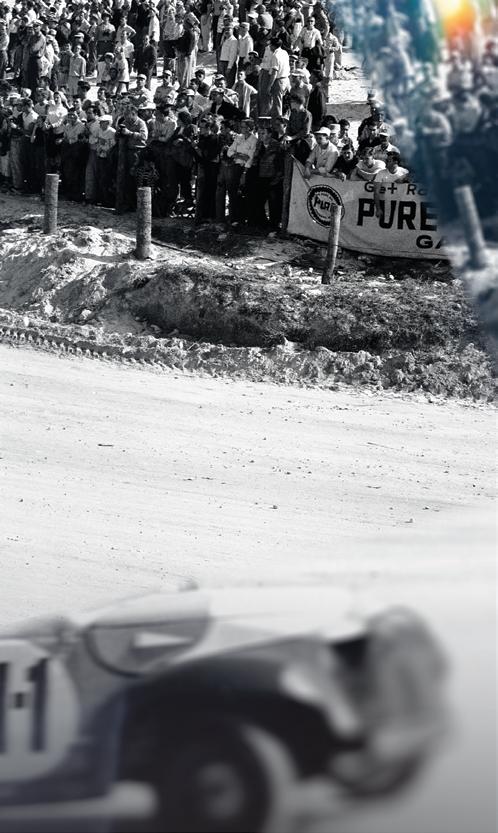
The end result was multiple competitor fatalities at the turn of the century. The discussion of safety intensified but the event that changed the sport, and safety, forever was the death of Dale Earnhardt on the final lap of the 2001 Daytona 500.
That fateful day turned the entire focus of the sport to safety and, thankfully, there has not been a fatality in NASCAR, at the national level, since that race.
As the sport marks its 75th anniversary, the technology and methodology of putting cars on the race track has changed dramatically. The seventh generation car is now a predominantly single-source supplier vehicle. Every team gets its parts from the same manufacturers and customization is all but non-existent. The result is that driver skill and strategy are now at a premium and the parity from the top teams to the bottom teams has never been closer.
The sport dipped in popularity during the mid- to late-2010s, but the last couple of years have seen a rebound in television ratings and overall popularity.
07
THE BARNSTORMING & BEACH RACING YEARS










































The passing of the 18th amendment to the U.S. Constitution had an unintended consequence. Hundreds, if not thousands, of men across the southeastern portion of the country modified their cars to be able to carry moonshine from the hills of Appalachia to customers across the region.
Any time people modify a vehicle from its original state, they will want to prove their car is the fastest. Moonshiners were no different. As a result, especially after the 21st amendment repealed prohibition, men wanted the opportunity to race against other, similar drivers.
Across the region, on horse racing tracks, asphalt tracks or just in open fields, groups would gather and uncommon men would push their cars to the limits to determine who was the best and fastest. Unfortunately, promoters of many of these outlaw races were unscrupulous individuals who would frequently disappear with the gate money and fail to pay out the promised purses. There were no consistent rules so people would modify their rides, sometimes dangerously so, in order to gain an advantage.
Similarly, there were race events held in Daytona Beach, Florida, that incorporated a portion of highway A1A and a stretch of the World’s Most Famous Beach. The beach was famous for land speed records early in the 20th century, so incorporating it into a race course made sense.






















When the city first tried to organize a race, the number of fans overwhelmed the infrastructure and thousands of people ended up watching the race for free. The event was called after 75 of the scheduled 78 laps because the turns were becoming impassable thanks to wrecked and abandoned cars.











































“Big Bill” France worked with the Elks Club of Daytona Beach to put on the second race. It went better but still lost money. France assumed leadership after that and began to make the event into a profitable venture.











08 NASCAR AT 75

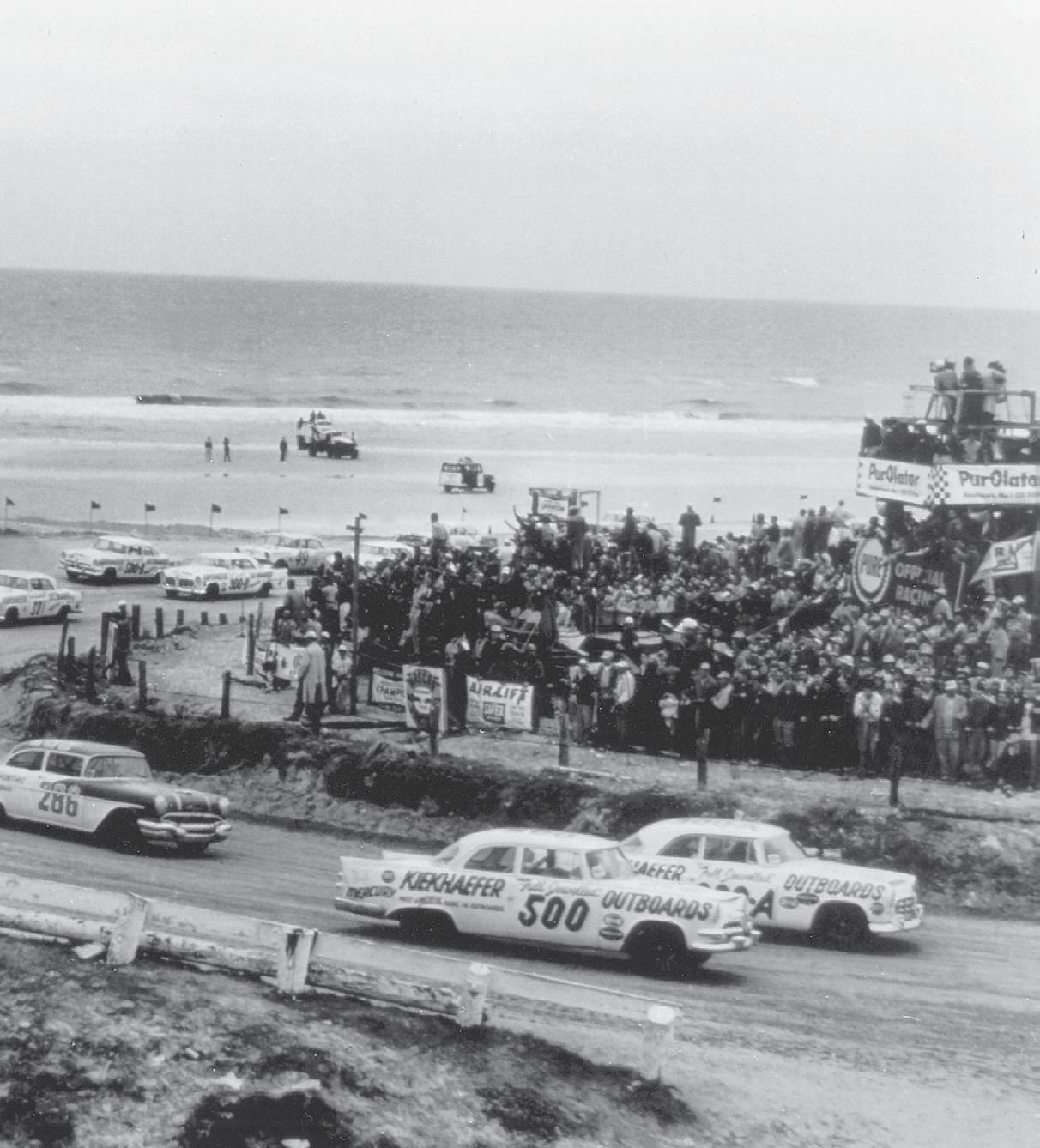
09
UNIFICATION & EXPANSION
































































Following World War II, barnstorming of race tracks was popular but it was not good for the competitors. There was no consistency in regulations and the people who were organizing the events were often nefarious characters. France saw auto racing as a sport for the masses and wanted to make it more reputable.
He gathered some 30 influential people in racing at the Streamline Hotel in 1947. They collectively dis cussed their visions of stock-car racing and eventually hammered out a set of bylaws for something called the National Association for Stock Car Auto Racing. It resulted in a group of races in 1948 for modified cars, which saw Red Byron crowned as the champion.

The following year, France’s vision of a “Strictly Stock” series came to fruition and an eight-race sea son concluded with Byron taking that title as well.








Over the next 22 years, the sport hosted an average of more than 48 races per season. The vast ma jority of them were at small bullrings scattered across the Southeast with occasional races in the Northeast. 1964 was the busiest race season with 62 events taking place. Richard Petty scored the first of his seven championships in NASCAR’s premier division that season with nine victories dur ing the year.
In 1967, Petty set the all-time, single-season win record, grabbing 27 trophies out of the 49 races contested that season. Petty won 21 races in 1971 for his third title and put the period on the initial era of NASCAR. The 1972 season would look completely different thanks to a new title sponsor that would transform the sport.
During the 1971 season, Junior Johnson had meetings with the marketing people from R.J. Reynolds Tobacco Co. He was looking for sponsorship for his race team but quickly realized the budget they were suggesting was far more immense than he needed. He connected them with the leadership of NASCAR and the Modern Era of the sport began in 1972.
RJR had an enormous promotional budget thanks to the tobacco advertising ban that was signed into law in 1970 by President Richard Nixon. The Winston budget included a pre-season event in Winston-Salem, North Carolina, that offered fans the opportunity to get up-close and personal with their favorite drivers.
Winston put together media guides and built media centers at several race tracks. Another change was that local bullrings and dirt tracks were removed from the sched ule. Only half mile and bigger tracks were on the schedule and none of them had a dirt surface. Richard Petty continued his dominance of the sport by winning his second consecutive title.
This period saw Cale Yarborough win three consecutive titles. Darrell Waltrip came onto the scene and also managed three championships. Dale Earnhardt became the only drive to date to win the rookie-of-the-year award and follow it up with a series championship the next season. Purpose-built race cars became the norm, aerodynamics started to come into play and, by the mid-’80s, some teams began using athletes on their crews to speed up pit stops.
At the beginning of the ’90s, Earnhardt wrapped up his seventh championship, becoming the second driver in series history to accomplish the feat. He then passed the torch to Jeff Gordon.
10 NASCAR AT 75


11
SPONSORS FOSTER GROWTH



















































































The Winston money was still flowing into NASCAR in the early 1990s, while the increasing demand for live sports on television and the growing interest in NASCAR generated a con siderable amount of corporate sponsorship.
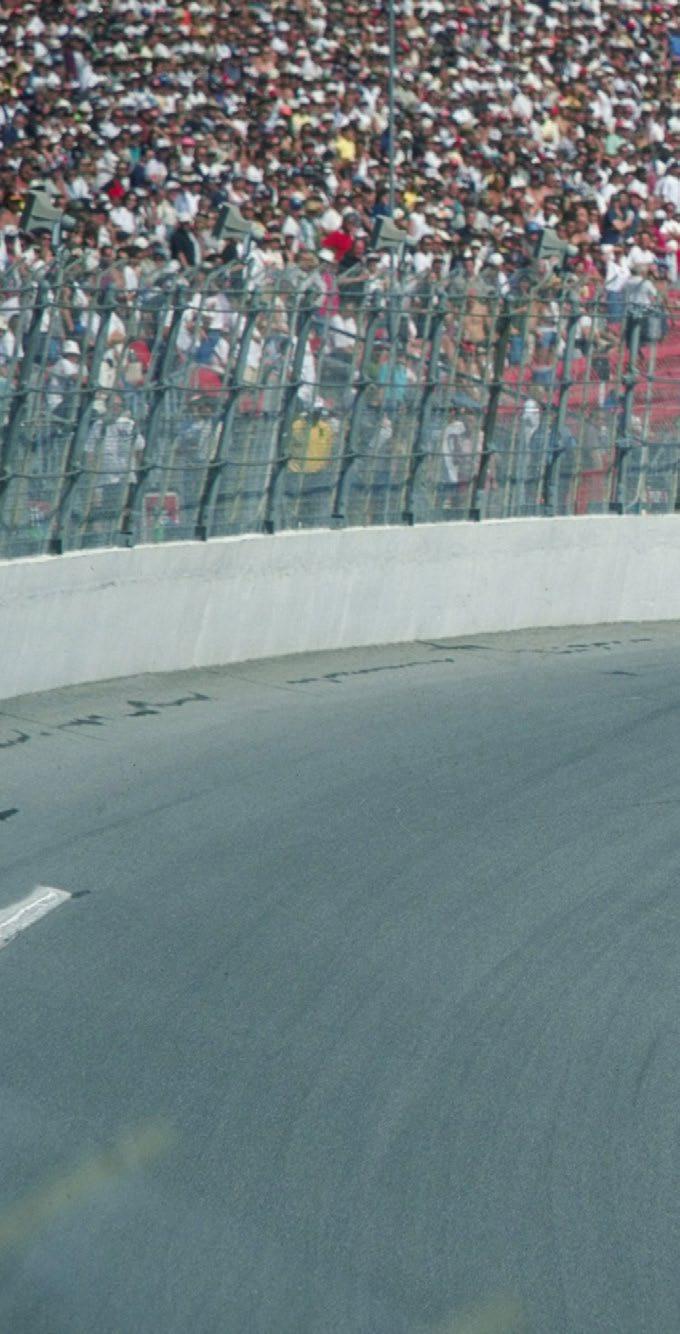
DuPont was on Jeff Gordon’s car as soon as he came into the Cup Series and the rainbow paint scheme became synonymous with not only the car and driver, but the Rainbow Warrior pit crew. General Motors jumped on the No. 3 car of Dale Earnhardt and that sponsorship became synonymous with winning.
More and more teams were able to land companies such as Kellogg’s, Valvoline, Home Depot, Lowe’s and FedEx over the next few years. Those sponsorships were for full seasons, not just a handful of races. The TV cameras were on, and the businesses soon realized the value of putting their brands on the high-powered cars running in circles on Sundays.
While the corporations were getting on board, two entities made moves to control most of the venues where NASCAR conducted its events. International Speedway Corp. (now part of NASCAR) built Daytona International Speedway and Talladega Superspeedway. The company eventually built and acquired more tracks through purchase and a merger with Penske Motorsports. While ISC was expanding its holdings, Speedway Motorsports Inc. was doing the same. The company that owned Charlotte Motor Speedway bought Atlanta in 1990. Under the direction of Bruton Smith, SMI continued to acquire more and more facilities through the 2000s.
Today, NASCAR and Speedway Motorsports own most of the tracks on the NASCAR Cup Series schedule. They have worked together to expand the sport’s revenue stream, thanks to a collective agreement with the broadcast partners versus the older agreements that were struck indi vidually with each track.


The most recent broadcast rights agreement for the sport was worth more than $800 million per year. The next agreement, which will start in 2025, is most likely going to be a billion dollars per year.





































12 NASCAR AT 75


13
DRIVING TOWARD THE FUTURE

During the Go-Go ’80s and especially the ’90s, NASCAR racing was booming, on and off the track. Engineers and mechanics were making race cars faster and faster, but few were focusing on the safety side of the sport. Seats were getting better. Seat belts were becoming more advanced and flame resistant suits were becoming lighter and more comfortable. Unfortunately there was little to no work being done on the forces imparted on drivers during impacts.
Race tracks were still surrounded by concrete walls and catch fences were designed with support poles on the inside of the fence where they could be contacted by the cars if they became airborne. That focus all changed in the early 2000s.
In two separate crashes at New Hampshire Motor Speedway during 2000, Adam Petty and Kenny Irwin Jr. were both killed. Petty was the fourth generation of the famous Petty racing family. Tony Roper also passed away from injuries suffered in a crash at Texas Motor Speedway.
These deaths were followed by Dale Earnhardt’s fatal accident on the final lap of the 2001 Daytona 500.





After losing its biggest star, the motorsports industry responded. Head-and-neck restraints became standard for all drivers and Steel and Foam Energy Reduction (SAFER) barriers were installed at tracks hosting NASCAR national series races. NASCAR also built an R&D Center in Concord, North Carolina, where it is constantly working on safety innovations.
The work and changes have paid off as NASCAR’s national series have been fatality free for more than 20 years.

Over the last few years, the mechanical side of the sport has seen some major changes. The Car of Tomorrow was developed with a larger green house, more bars and energy absorbing foam to make drivers safer. Full containment seats have bigger head rests to minimize head shake during incidents. Driver comfort has also been a focus.
The latest cars are so air tight that temperatures are higher than ever for the drivers during a race. Keeping drivers cool prevents dehydration and over taxation on the circulatory system.

























The newest car, known as Generation Seven or Next Gen, is a huge departure from the previ ous generations. All of the cars since the day of the truly stock cars have been hand built, custom race cars. This new car is a single-supplier sourced car. Teams purchase parts from a designated supplier and they are not allowed to alter them before they put them on the race cars. The only actual customization on the cars is on the dash board.
The end result is that the racing comes down to driver skill, strategy and minor car adjustments. The first year with this car resulted in 19 different winners. That ties the record for the most in the history of the sport, all of which happened before 1972 except 2001.
The sanctioning body is also continuing to build the sport. The NASCAR Cup Se ries will return to a temporary track at the L.A. Memorial Coliseum for a preseason exhibition race. The sport is also heading back to North Carolina’s North Wilkes boro Speedway for the first time since 1996. Speedway Motorsports is also work ing to bring NASCAR back to Fairgrounds Speedway Nashville, another historic race track that has not hosted a NASCAR Cup Series race since 1984.
Fans have asked for more short-track races and more road courses, and the people who run the sport are doing all they can to oblige them.
Seventy-five years have flown by; here’s looking forward to 75 more.
































14 NASCAR AT 75

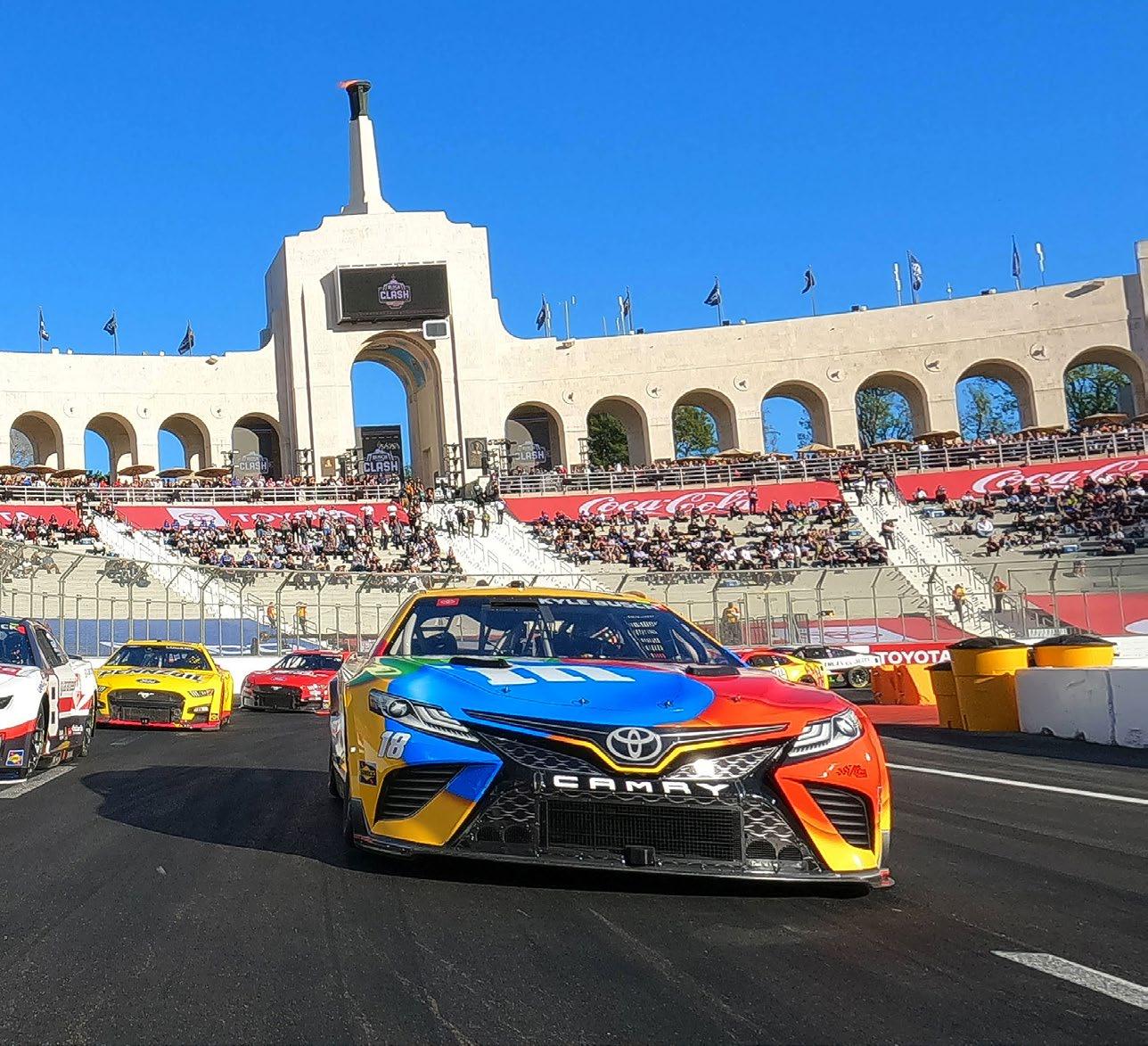
15
A DOZEN MILESTONE MOMENTS THAT DEFINED NASCAR

As NASCAR celebrates its landmark 75th anniversary, let’s take a look back at a dozen iconic, unforgettable moments in NASCAR history that transformed the sport and made it what it is today.



 BY JARED TURNER
BY JARED TURNER



16 MILESTONE MOMENTS

17
ACHAOTICFINISH,ACRAZYFIGHTANDARACETHAT THRUSTNASCARINTOTHENATIONALSPOTLIGHT


THE FIRST 500-MILE RACE EVER BROADCAST LIVE AND IN ITS ENTIRETY on network television proved to be the most important race in NASCAR history. With the entire East Coast from Georgia to Maine hunkered down due to a massive winter storm, many who knew nothing about NASCAR tuned into CBS’ coverage of the 1979 Daytona 500 because they simply had nothing better to do. It’s safe to say they didn’t walk away disappointed.
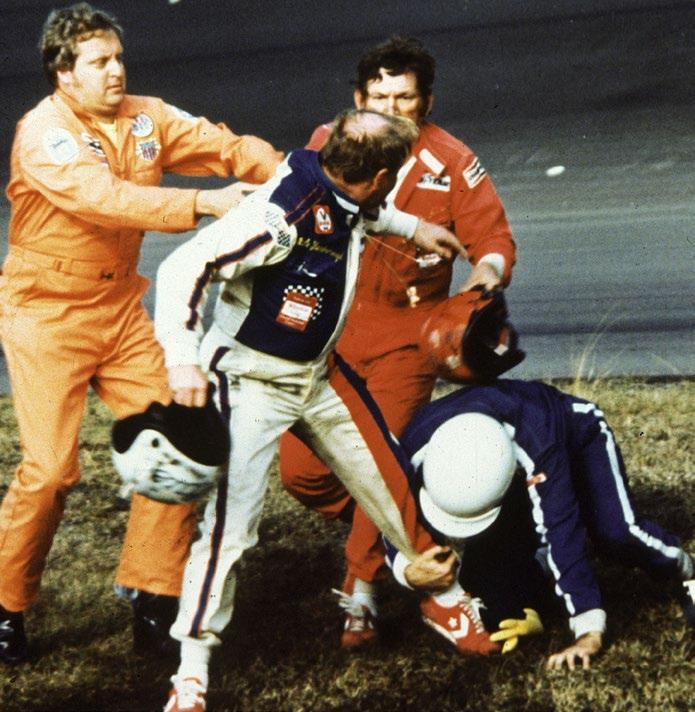
In addition to seeing a young rookie and future NASCAR Hall of Famer named Dale Earnhardt make his first start in NASCAR’s premier event, the roughly 6.5 million TV viewers and 120,000 in attendance witnessed a frenzied last-lap battle for the lead between reigning, three-time Cup Series champion Cale Yarborough and cagy veteran Donnie Allison that culminated in the two drivers bouncing hard off of each other multiple times before crashing –and paved the way for then-six-time Cup Series champion Richard Petty to go from third to first in the final half a lap and edge Darrell Waltrip for an improbable sixth Daytona 500 victory.
The real fireworks occurred after the race, however, when Allison and his older brother, Bobby, engaged Yarborough in a bareknuckle fistfight, which was captured on live television and only further fueled viewers’ appetite for this sport about which many who watched that day knew so little.
RICHARD PETTY’S LAST RACE, JEFF GORDON’S FIRST RACE AND A DOWN-TO-THE-WIRE CHAMPIONSHIP BATTLE
ASIDE FROM THE 1979 DAYTONA 500, NO RACE IN NASCAR’S 74-YEAR history is of greater consequence than the 1992 Hooters 500 at Atlanta Motor Speedway, where a confluence of circumstances created an afternoon for the ages.
First, there was the fact that this was Richard Petty’s 1,184th and final start in NASCAR’s premier series. Meanwhile, a little-known open-wheel driver named Jeff Gordon – who would go on to win four Cup Series championships and 93 races, second only to Petty and David Pearson – was making his first start in NASCAR’s premier division. Then, there was the matter of the battle for the Cup Series championship – and the six drivers who arrived at Atlanta with a mathematical chance of being crowned champ.
After championship favorite Davey Allison was eliminated in a wreck, it came down to Alan Kulwicki and Bill Elliott. While Elliott won the race, Kulwicki won the championship by a meager 10 points – at that time the closest championship margin in NASCAR history.
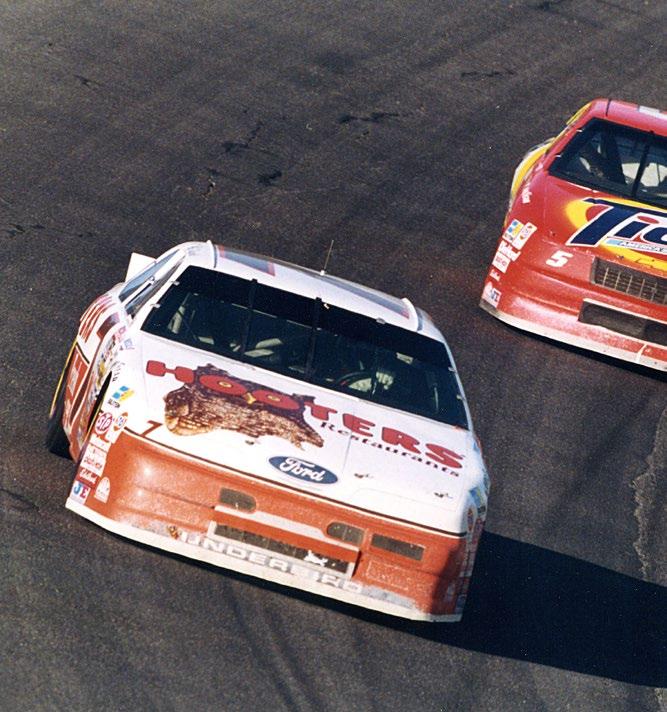 1979 DAYTONA 500
1992 HOOTERS 500 AT ATLANTA
1979 DAYTONA 500
1992 HOOTERS 500 AT ATLANTA
18 PHOTOGRAPHY: GETTY IMAGES MILESTONE MOMENTS
CELEBRATING OVER 70 YEARS OF MANUFACTURING OUR PRODUCTS IN AMERICA AND OVER 30 YEARS


OF BEING A PROUD SUPPORTER OF RACING
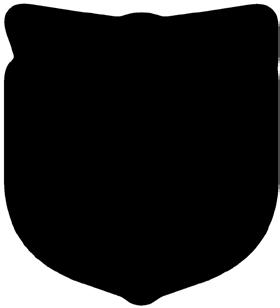
Whelen designs and manufactures reliable and powerful warning lights, white illumination lighting, sirens, controllers, and high-powered warning systems for Automotive and Mass Notification industries worldwide. Whelen products are proudly designed and manufactured in America and is tested on-site to meet the toughest industry certifications. On the road and around the world, Whelen is trusted to be seen, trusted to be heard, trusted to perform.
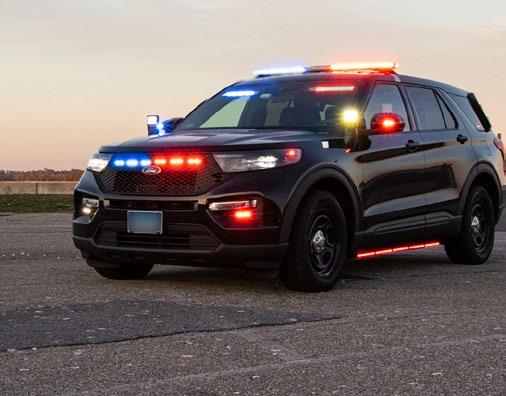
51 Winthrop Road • Chester, CT USA 06412 @WhelenENG whelen.com

DALE EARNHARDT’S LONG-AWAITED, IMMENSELY POPULAR DAYTONA 500 WIN IN 1998
ONE OF THE MOST POPULAR WINS IN NASCAR HISTORY TOOK PLACE AT the 1998 Daytona 500 when Dale Earnhardt – in his 20th attempt to win The Great American Race – finally prevailed, scoring the victory in his iconic black No. 3 Chevrolet of Richard Childress Racing.

Earnhardt, who had lost this race in just about every way imaginable in his 19 previous tries, showed up at The World Center of Racing with one of the fastest cars as he so often did, but unlike in his previous attempts to win NASCAR’s most prestigious event, nothing went terribly wrong. Earnhardt led 107 of 200 laps, taking the top spot for good with 61 laps to go. Despite facing strong challenges from the likes of Rusty Wallace, Jeremy Mayfield, Jeff Gordon, Bobby Labonte and teammate Mike Skinner, Earnhardt never cracked under the pressure as he held off a late charge from Labonte to take the yellow flag and the white flag together and be assured of the victory (back then, the entire final lap could be run under caution).
Earnhardt later celebrated by spinning through the frontstretch infield grass before pulling down pit road where he was congratulated by at least one member of practically every team – a truly once-in-a-lifetime type of spectacle that you had to see to believe.
1985
SOUTHERN
500 BILL ELLIOTT’S MILLION-DOLLAR PAYDAY AT THE 1985 SOUTHERN 500
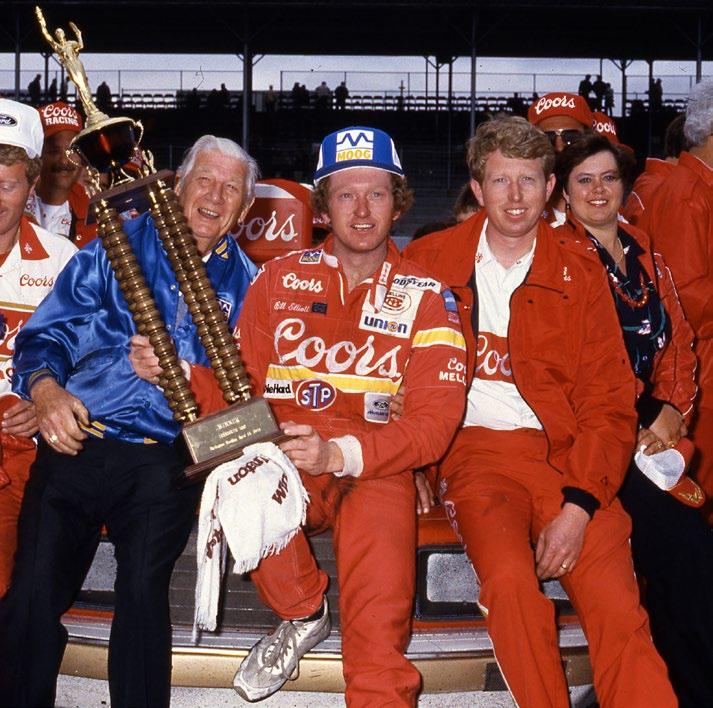
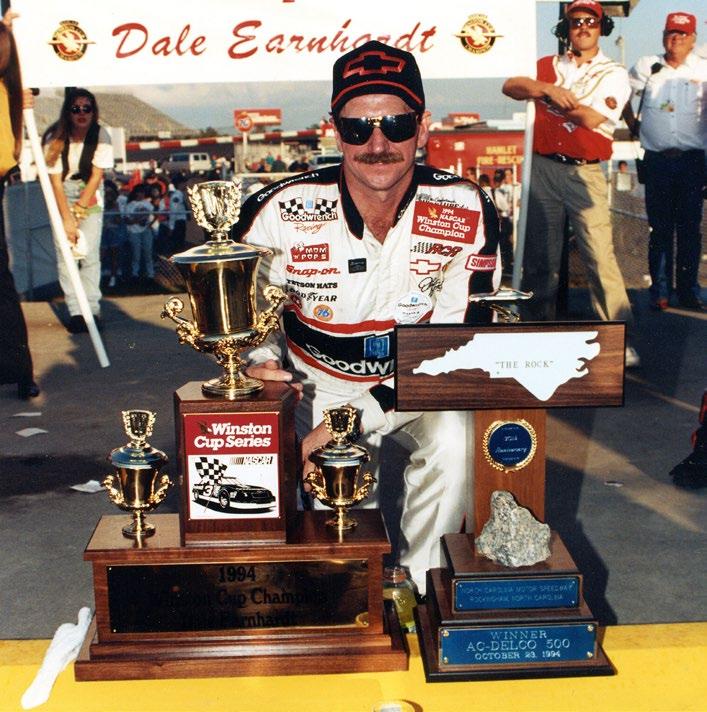
AT THE END OF THE 1984 SEASON, R.J. REYNOLDS TOBACCO CO. and its Winston brand — the title sponsor of NASCAR’s premier series — announced a new program called “The Winston Million.”

The idea was simple: Any driver who the following year could win three of NASCAR’s four “crown-jewel” races – the Daytona 500, the Winston 500 at Talladega, the Coca-Cola 600 at Charlotte and the Southern 500 at Darlington – would pocket a $1 million bonus from R.J. Reynolds.
In those days, winner’s purses were substantially smaller than they are now, so the thought of earning $1 million for a single race win was pretty hard to fathom. Yet it happened – thanks to Bill Elliott’s amazing drive to victory in the Southern 500 that followed his wins in the Daytona 500 and the Talladega spring race.
One of the sport’s most popular drivers, Elliott was the focus of a media avalanche that Labor Day weekend at Darlington and saw his popularity soar to unprecedented heights after he won the pole, led 100 laps and captured the win in front of a roaring crowd.
Appropriately, Elliott earned also left Darlington with a new nickname: “Million-Dollar Bill.”
1998 DAYTONA 500
20 PHOTOGRAPHY: GETTY IMAGES MILESTONE MOMENTS
But in 1992, leaders at Charlotte Motor Speedway were determined to become the rst 1.5 mile NASCAR track to stage a night race.
They partnered with Musco Lighting, which innovated its state-of-the-art Mirtran System™ creating the light levels and glare-free visibility critical for driver safety. On May 16, 1992, “One Hot Night” at Charlotte Motor Speedway was an overwhelming success, ushering in a new era for NASCAR.

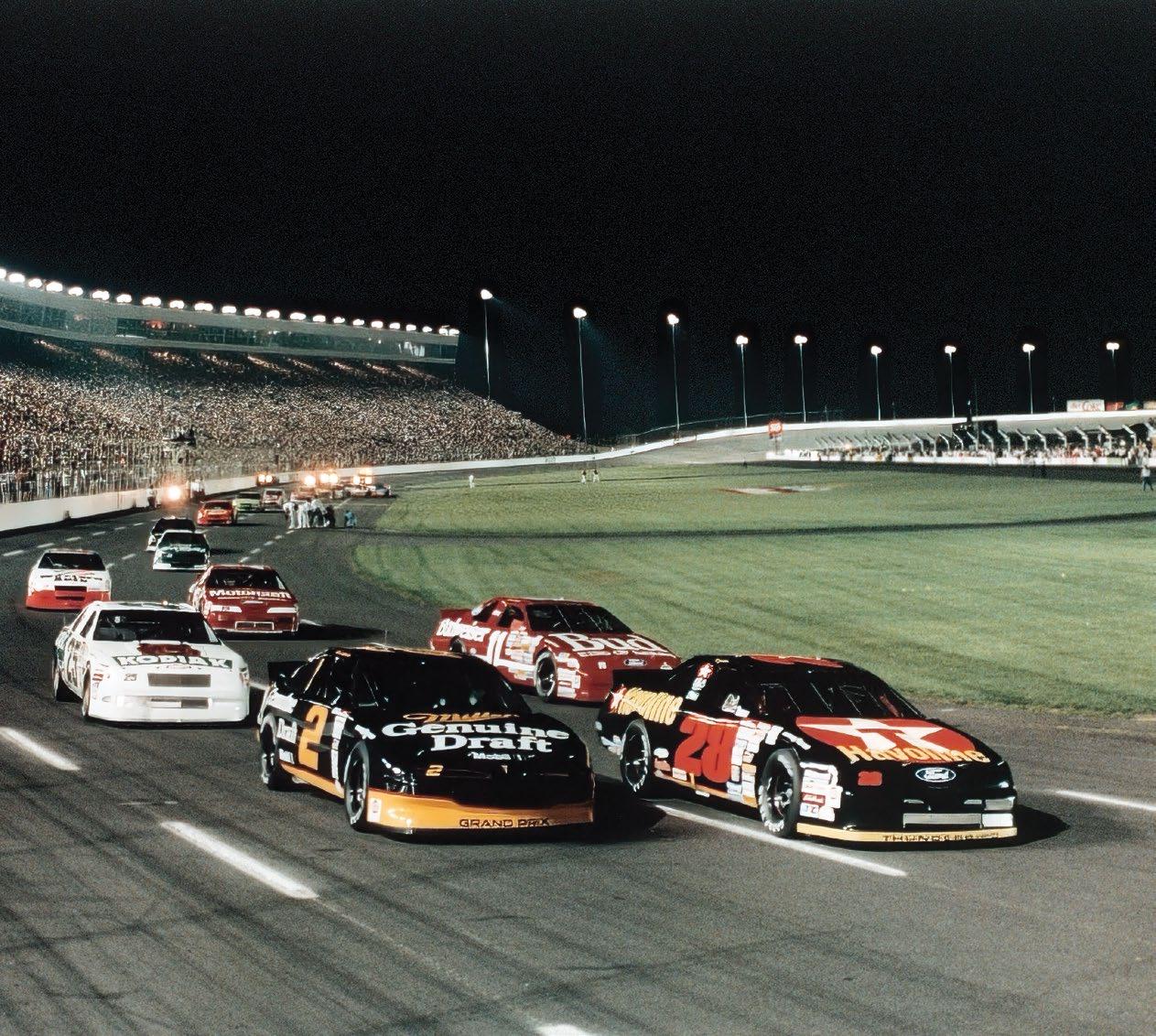
“’One Hot Night’ will always be one of our proudest milestones at Musco. Since they dropped the green ag on the Winston in May of 1992, it opened the door to lighting race tracks of all shapes and sizes around the globe. On behalf of our entire team, congratulations to NASCAR on its 75th anniversary of creating countless memories for race fans everywhere.”
– Je Rogers President, Musco Lighting

LLC · ADNA23-1
©2023 Musco Sports Lighting,
Scan here or go to www.youtube.com/ watch?v=HhnPTgKtlRw&t=22s to get the whole story. Point Your Camera Here
They said large-track night racing in NASCAR wasn’t possible.
DALE EARNHARDT’S DOMINANT RUN TO A RECORD-TYING SEVENTH CHAMPIONSHIP
BEFORE ERNIE IRVAN SUFFERED A SEASON-ENDING INJURY IN A crash at Michigan International Speedway in August 1994, he and Dale Earnhardt were locked in a close battle for the Cup Series championship that saw the two veterans pass the points lead back and forth on multiple occasions over the season’s first 20 races.
But Irvan’s injury effectively put the championship on ice as Earnhardt – who held a slim points lead at the time – never again relinquished his position atop the standings and put so much distance between himself and his closest pursuers that he managed to clinch the championship at Rockingham Speedway with two races still on the schedule.
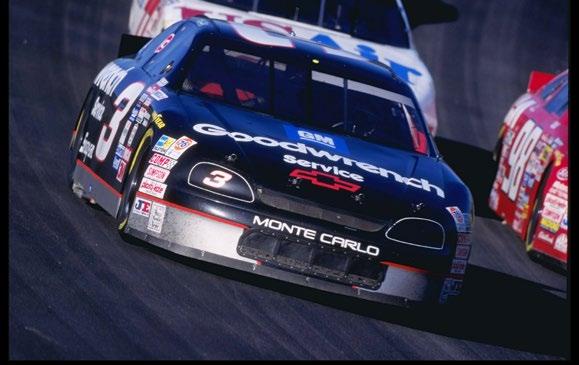
Of course, this wouldn’t have been possible once NASCAR added a 10-race season-ending playoff for its top division a decade later, but with the championship back then being based on total points accumulated over the season, Earnhardt simply continued to pad his points lead in Irvan’s absence.
Earnhardt, who captured the title on the same day as his fourth and final win of 1994, became just the second driver in NASCAR history to win seven championships, joining “The King” Richard Petty, who celebrated his last championship in Earnhardt’s rookie season of 1979.

HOMESTEAD-MIAMI
JIMMIE JOHNSON’S LATE-RACE SURGE TO WIN A RECORD-TYING SEVENTH CHAMPIONSHIP
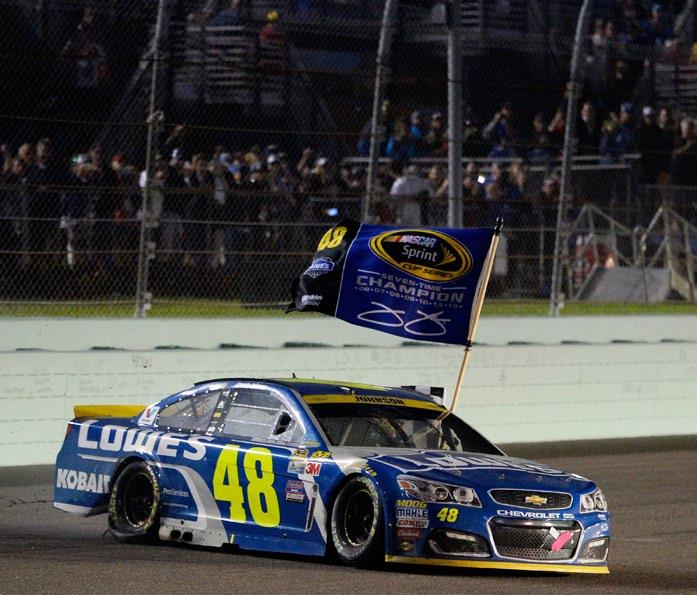
PRIOR TO 2016, JIMMIE JOHNSON HAD WON SIX NASCAR CUP SERIES championships but none in the elimination-style playoff format that culminates in one final race where four drivers compete straight up for the


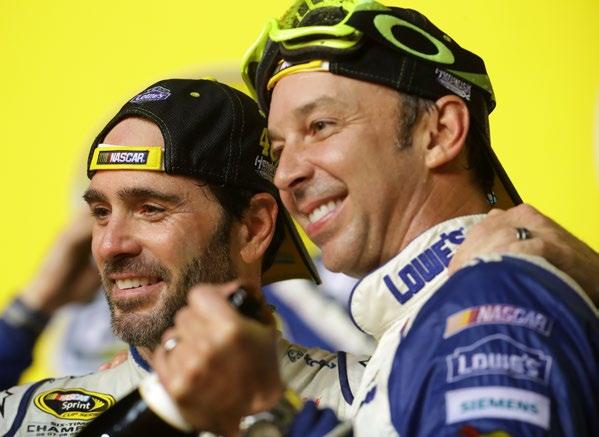
But entering the 2016 finale at Homestead-Miami Speedway, Johnson was one of the four drivers with a shot to bring home the big trophy, and bring home the trophy he did – moving into a tie with seven-time champions Richard Petty and the late Dale Earnhardt for most titles in NASCAR’s premier division.
Make no mistake about it, though: Johnson didn’t win his seventh championship with ease. He spent most of the race running last among the four title contenders, benefiting greatly when frontrunning championship contender Carl Edwards was caught up in a wreck in the final laps.
Later, crew chief Chad Knaus used some shrewd pit strategy to get Johnson out front for the first time all day just ahead of the final restart with two laps to go, and Johnson managed to hang on over those two green-flag laps to win the title over Joey Logano, who finished fourth in the race and second in the championship standings.
1994 CUP
SERIES SEASON
2016 SEASON FINALE AT
22 PHOTOGRAPHY: GETTY IMAGES MILESTONE MOMENTS
Country Music Hall of Fame member Marty Robbins proved that it can take just three chords—or up to 500 miles—to reach the truth. From Talladega to Tennessee, country music is the soundtrack of the racetrack.
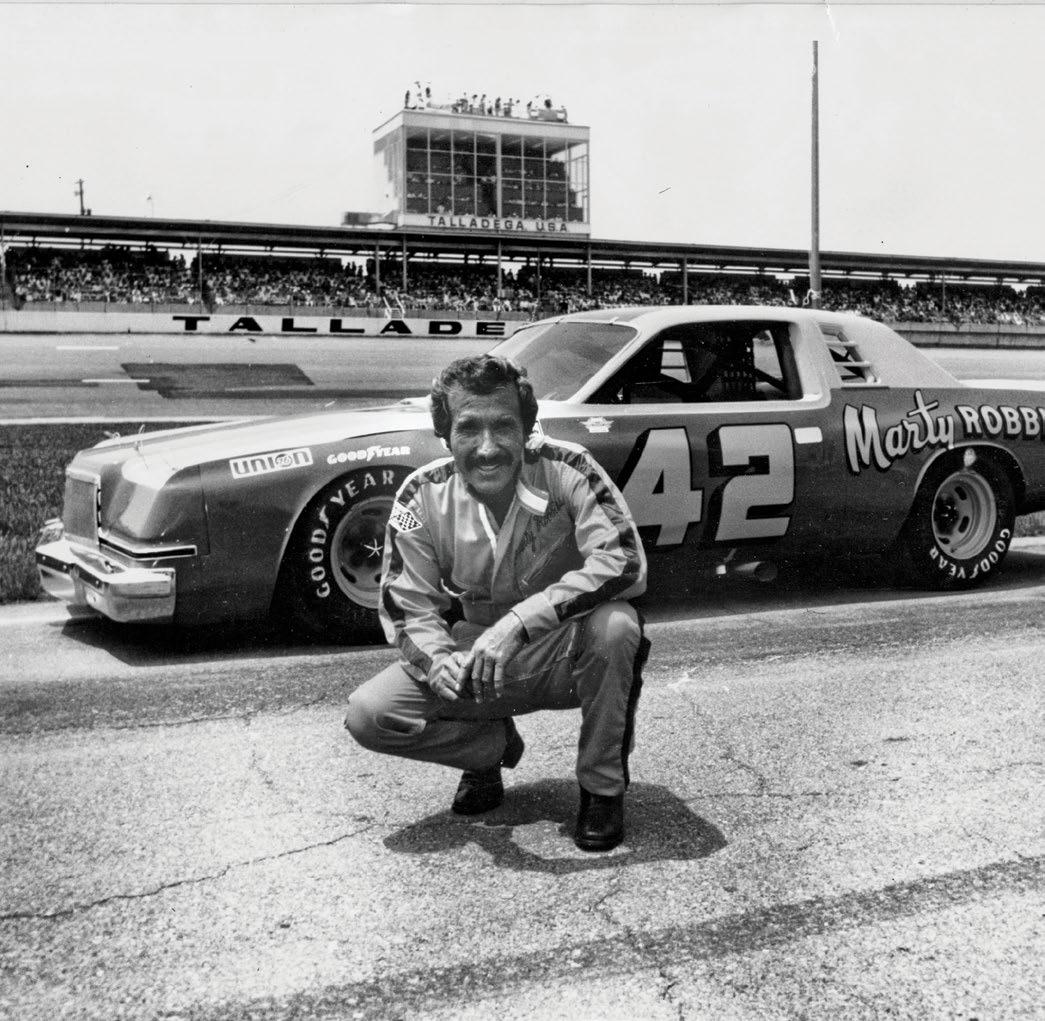
BUCKLE UP. GET DOWN.

CLICK IT AND TICKET
400

JEFF GORDON’S HOMETOWN WIN IN THE INAUGURAL BRICKYARD 400
ONCE CONSIDERED LITTLE MORE THAN A PIPE DREAM, THE idea of stock cars competing at world-famous Indianapolis Motor Speedway – a track steeped in Indy car tradition – became reality on Aug. 6, 1994, with the running of the inaugural Brickyard 400. Immediately considered the second biggest race on the Cup Series schedule, trailing only the Daytona 500 in prestige, that first Brickyard 400 featured lots of drama – including an ontrack dustup between brothers Geoff and Brett Bodine that resulted in Geoff, the older sibling, crashing out of the race. The battle for the win ultimately came down to Ernie Irvan and Jeff Gordon – who, although born in Vallejo, California, spent a significant portion of his childhood years just down the road from IMS in Pittsboro, Indiana. Gordon, whose No. 24 rainbow-colored Chevrolet was one of the fastest cars all race long, took the lead for good with six laps to go when Irvan’s race-leading Ford cut down a tire, ending his chances of a victory.

400 RICHARD PETTY’S LANDMARK 200TH VICTORY AT DAYTONA ON

JULY 4, 1984
WITH RONALD REAGAN – THE FIRST SITTING U.S. president to ever attend a NASCAR race – watching from a suite high above Daytona International Speedway, seventime NASCAR Cup Series champion Richard Petty claimed his 200th and final victory in dramatic fashion on July 4, 1984, by edging three-time champion and fellow NASCAR legend Cale Yarborough in a photo finish.
After being passed for the lead by Yarborough coming down the backstretch on the final lap, Petty used a classic slingshot move to regain the top spot in Turns 3 and 4 and then held on to score a win that to this day remains one of the most iconic moments in NASCAR history. After the race, Petty – or “The King,” as he’s long been known – received heartfelt congratulations from Reagan, who had given the command to start the engines from Air Force One before landing at the nearby airport and joining NASCAR president Bill France Jr. to watch the final laps unfold.

1994 BRICKYARD
1984 FIRECRACKER
24 PHOTOGRAPHY: GETTY IMAGES MILESTONE MOMENTS

JEFF GORDON’S MILLION-DOLLAR TRIUMPH


LOOKING TO BECOME ONLY THE SECOND DRIVER TO CLAIM A $1 MILLION bonus from R.J. Reynolds Tobacco Co. and its Winston brand that was serving as the Cup Series’ title sponsor, Jeff Gordon needed to win the Southern 500 to cash in on his potentially huge payday, for which he alone was eligible by virtue of winning the Daytona 500 and the Coca-Cola 600 – two of three “crown-jewel” events that had taken place earlier in the 1997 season. Seeking his third consecutive Southern 500 win, Gordon not surprisingly showed up at the track “Too Tough to Tame” with an extremely fast race car. The only problem? Jeff Burton’s No. 99 Roush Racing Ford was just as fast – maybe even a tick faster – so when Gordon came out of Turn 4 to take the white flag, he had a review mirror full of Burton, who pulled to Gordon’s inside and made an aggressive attempt to pass. But before Burton could get completely up alongside Gordon’s No. 24 Hendrick Motorsports Chevrolet, the 1995 Cup Series champion threw an aggressive block on Burton, pinching him down and forcing Burton to momentarily back out of the throttle before the two entered Turn 1. Gordon then held Burton at bay over the remainder of the final lap to join 1985 Southern 500 winner Bill Elliott as a recipient of the coveted “Winston Million.”
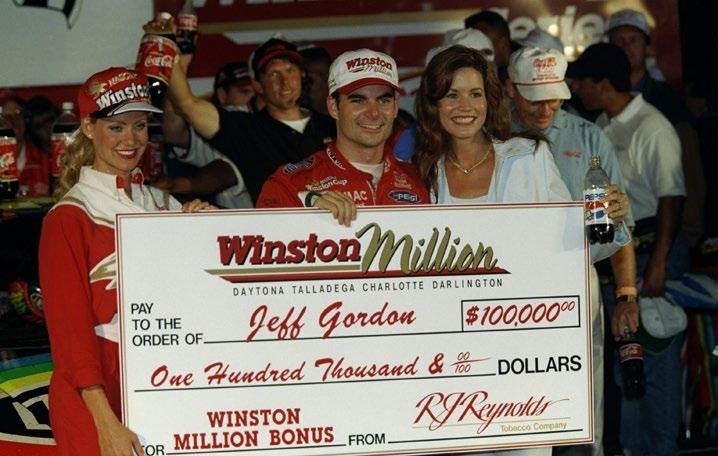
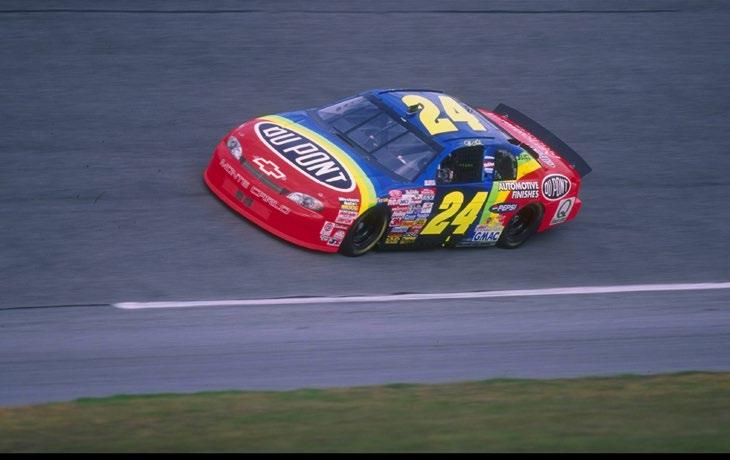
DALE EARNHARDT JR.’S EMOTIONAL WIN AT DAYTONA IN JULY 2001
ONE OF THE MOST EMOTION-FILLED WEEKENDS IN NASCAR history took place in July 2001 at Daytona International Speedway where the Cup Series returned to compete less than five months after the tragic death of Dale Earnhardt in a crash on the final lap of the Daytona 500.

Racing with the heaviest hearts of all were Michael Waltrip and Dale Earnhardt Jr., who had finished 1-2 in the Daytona 500 just seconds after Earnhardt – their team owner – crashed into the Turn 4 wall while running just behind them on the race track. Racing in memory of the man who had given them so much, Earnhardt Jr. and Waltrip swept the top two finishing positions in the July Daytona race just as they did in February – only this time, it was Earnhardt Jr. coming out on top and Waltrip finishing second.
After the race, the two teammates celebrated together on top of Waltrip’s car, as their pit crews joined in the fun just below and a jam-packed grandstand bellowed its approval.
1997 SOUTHERN
500 AT DARLINGTON
2001 PEPSI 400 AT DAYTONA
26 PHOTOGRAPHY: GETTY IMAGES MILESTONE MOMENTS




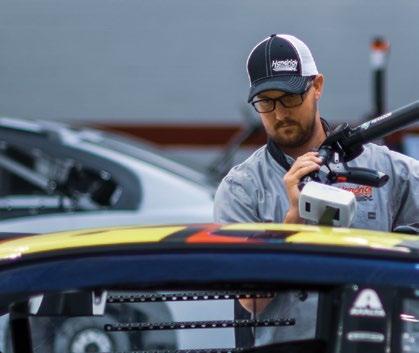

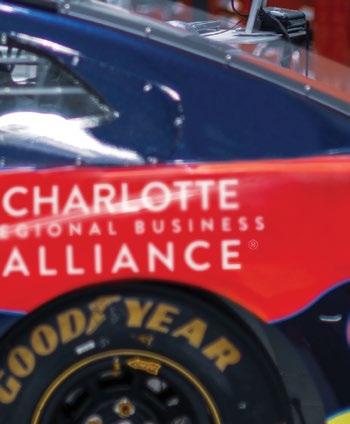


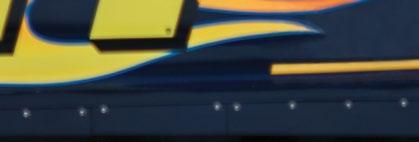






WHY ARE 90% OF NASCAR TEAMS HEADQUARTERED IN THE CHARLOTTE REGION? THEY LIKE LIVING HERE. On the short list of best places to live and work, the Charlotte Region combines wide-open opportunity with incredible livability.¹ As a Top 5 region where millennials are moving in the No. 1 state for business, it’s the nation’s most promising place for business relocation and expansion.² LEARN WHY BUSINESS IS BETTER HERE CHARLOTTEREGION.COM 1. North Carolina is the #1 state for business (CNBC). 2. Charlotte is the 5th best city for Millennials (Homebuyer.com, 2021).
1999 BRISTOL NIGHT RACE DALE EARNHARDT’S CONTROVERSIAL ‘RATTLE HIS CAGE’ MOVE ON TERRY LABONTE
LOVED BY ROUGHLY HALF OF THE NASCAR FAN BASE AND LOATHED by the other for much of his career, Dale Earnhardt built a reputation early on as one of the sport’s most aggressive drivers. Nicknamed “The Intimidator,” the second-generation driver raced especially aggressively on the short tracks where contact is generally deemed more acceptable – and there was no short track on the schedule where Earnhardt customarily took a more no-holds-barred approach than Bristol Motor Speedway, a highbanked .533-mile short track in eastern Tennessee.

Four years after finishing second to Terry Labonte in the Bristol Night Race when he sent Labonte’s No. 5 Hendrick Motorsports Chevrolet spinning just as it took the checkered flag, it was Earnhardt vs. Labonte Round Two in 1999 — but this time, Earnhardt spun Labonte in Turns 1 and 2 on the final lap and moved past to score a highly unpopular victory that drew boisterous disapproval from the 100,000-plus fans in attendance.
Earnhardt, meanwhile, quipped in Victory Lane that he hadn’t meant to wreck Labonte, only to “rattle his cage.”
2011 SEASON FINALE AT HOMESTEAD-MIAMI TONY STEWART AND CARL EDWARDS’ BATTLE FOR THE MOST CLOSELY CONTESTED CHAMPIONSHIP
IN THE 10 YEARS BEFORE NASCAR INSTITUTED ELIMINATION rounds and a single race championship for its premier series in 2014, the Cup Series champion was determined based on total points accumulated over 10 playoff races.
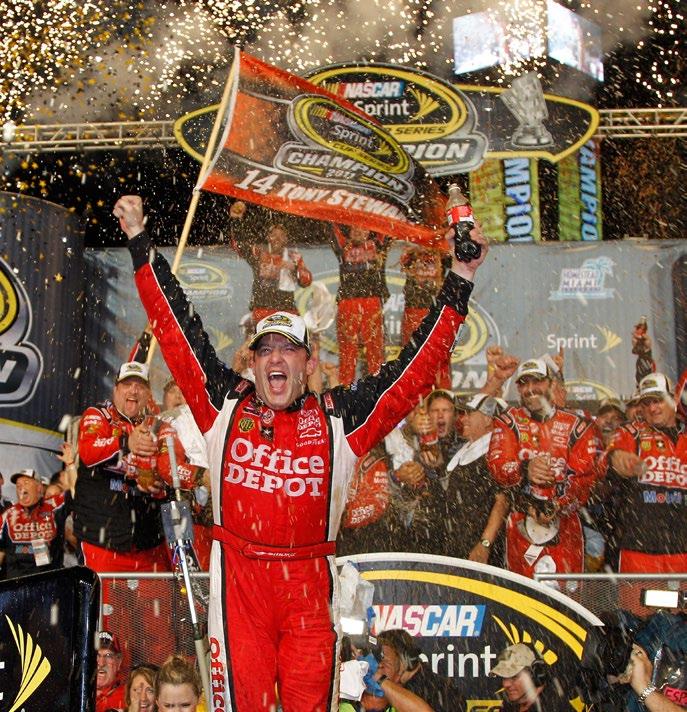
So, unlike today, title contenders didn’t enter the final race with the same number of points nor was the champion based simply on who among the title contenders finished best in the final event. Therefore, it was theoretically possible for the championship contenders to finish the season with the same number of points – although that had never happened in more than 60 years of NASCAR history. Against all odds, it finally did happen in 2011 when Tony Stewart and Carl Edwards came home first and second, respectively, in the season finale at Homestead-Miami Speedway, finishing the year deadlocked in points. But Stewart, who had five victories to Edwards’ one, was declared champion in a tiebreaker based on number of wins. Given that it’s no longer possible for championship contenders to finish a season tied in points, 2011 will likely forever stand as the Cup Series’ closest championship battle.


28 PHOTOGRAPHY: GETTY IMAGES MILESTONE MOMENTS
THE MOST RELIABLE RIMFIRE PISTOL FAMILY

Easy-to-rack slide
Double stack 13-round capacity
Slide-mounted optic ready

TaurusUSA.com
NEW
10 WHO MADE AN IMPACT WITHOUT A HELMET
BY JARED TURNER
Here are 10 individuals who had a major impact on the business of NASCAR without trading paint on the race track:
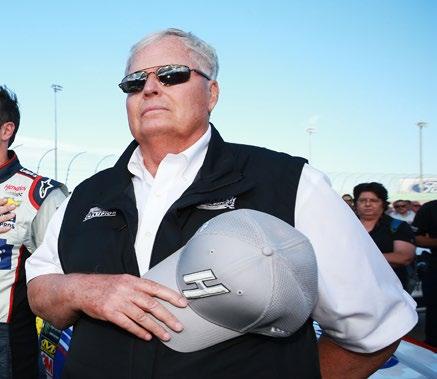
“BIG BILL” FRANCE: Without the entrepreneurial vision of William H.G. “Big Bill” France, NASCAR in all likelihood wouldn’t exist today. It was France, who formally established the sport in February 1948 after a now-famous meeting on Dec. 14, 1947, at the Streamline Hotel in Daytona Beach, Florida, with a group of racers who agreed to work together to form what would become America’s premier sanctioning body for stock-car auto racing.
Along with being credited as the founder of NASCAR, France oversaw the building of two iconic race tracks – Daytona International Speedway and Talladega Superspeedway. France passed away in 1992 – 18 years before being posthumously enshrined in the NASCAR Hall of Fame as part of its inaugural five-member class.
BILL FRANCE JR.: The son of NASCAR’s founder, Bill France Jr. took the reins of the sport from his father in 1972 by becoming NASCAR’s president – a title he held for nearly 30 years. “Bill Jr.,” as NASCAR’s second-generation leader was known, later spent time as NASCAR’s chairman, and then as its vice chairman, prior to his 2007 death and 2010 NASCAR Hall of Fame induction.
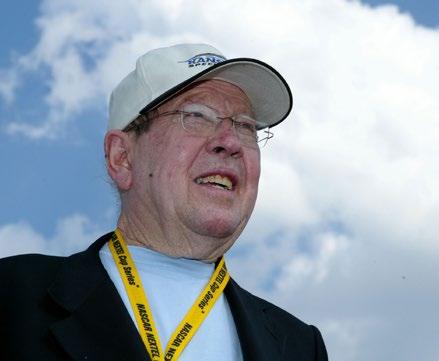
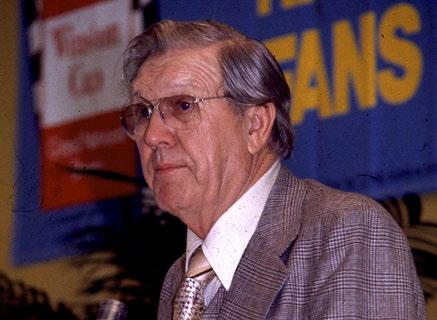
It was under Bill Jr.’s watch that NASCAR morphed into a national, and to some degree, international sport with race tracks all over the U.S. and drivers from various regions of the country. It was also under France’s guidance that NASCAR signed its original multi-billion dollar media rights deal with current broadcast partners FOX Sports and NBC.

BRUTON SMITH: Arguably NASCAR’s most prolific track owner and promoter, Bruton Smith was the founder and CEO of Speedway Motorsports – the parent company of more than 10 modern-day race tracks, including Charlotte Motor Speedway, which Smith designed and built in 1959 with help from business partner and NASCAR pioneer Curtis Turner.
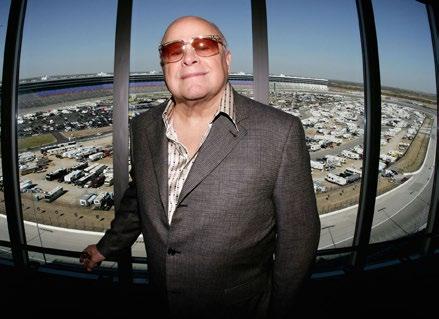
Since overseeing the construction of CMS, Smith’s company has expanded its portfolio to include Texas Motor Speedway, Bristol Motor Speedway, Atlanta Motor Speedway, Sonoma Raceway and various other venues both old and new to the Cup Series schedule. Smith, who died in June 2022 at age 95, also founded Speedway Children’s Charities – a nonprofit organization that supports children in need.


RICK HENDRICK: Winner of a record 14 NASCAR Cup Series championships and nearly 300 Cup Series races as a team owner, Rick Hendrick is the gold standard for chief executives of racing teams that compete in NASCAR. The list of drivers who’ve raced for Hendrick Motorsports over the past almost-40 years include the likes of seven-time Cup Series champion Jimmie Johnson, four-time champion Jeff Gordon, 2020 champion Chase Elliott, 2021 champ Kyle Larson and 15-time National Motorsports Press Association Most Popular Driver Award winner Dale Earnhardt Jr.
A leukemia survivor, Hendrick created the Hendrick Marrow Program, which has raised more than $12 million since 1997 to help those fighting cancer.
LEONARD WOOD: A word-class innovator, mechanic, engine builder and crew chief who is widely credited as the inventor and mastermind of the modern-day pit stop, Leonard Wood will forever be remembered as one NASCAR’s foremost revolutionaries.
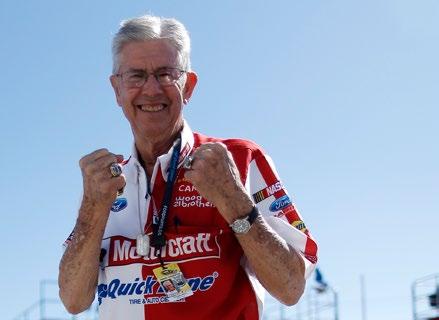
30 TRAILBLAZERS
The brother of Wood Brothers Racing founder and 2012 NASCAR Hall of Fame inductee Glen Wood, Leonard Wood entered the NHoF in 2013 and remains active today at age 88. Thanks in large part to his contributions, Wood Brothers Racing is one of the most successful teams in NASCAR history, with 99 wins in NASCAR’s premier series. It has fielded cars for some of the sport’s most legendary drivers – including Cale Yarborough, David Pearson, Junior Johnson, Mario Andretti and A.J. Foyt.
DALE INMAN: The only crew chief in NASCAR history with eight championships at the sport’s highest level, Dale Inman became famous while working with his cousin – Richard Petty – who won all of his record-tying seven Cup Series championships with Inman at his side. Inman’s other championship came in 1984 with Terry Labonte and team owner Billy Hagan’s team, but Inman reunited with Petty in 1986 after a nearly five-year absence.
Inman, a 2012 NASCAR Hall of Fame inductee who worked his final race as a crew chief in 1988 with Petty – may be most remembered for the incredible 1967 season in which he and Petty earned a record-setting 27 wins, including 10 in a row.
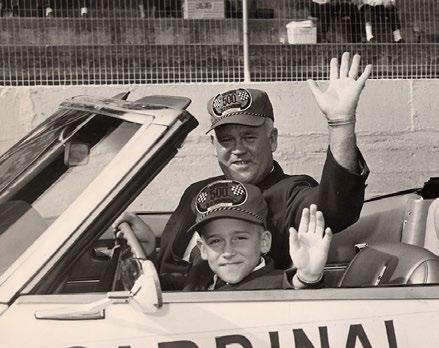
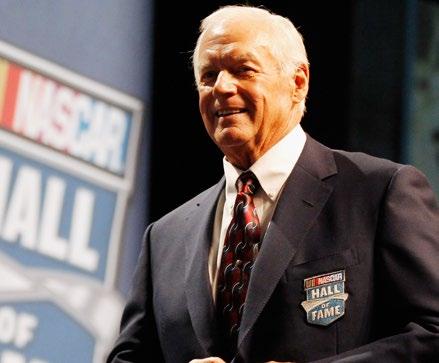
H. CLAY EARLES: Before there was NASCAR, there was Martinsville Speedway – which hosted its first race in September 1947 thanks to the vision and efforts of its founder and longtime owner, motorsports pioneer H. Clay Earles. Although Earles passed away in 1999, his legacy lives on through his grandson — current-day Martinsville Speedway president Clay Campbell — and the fact that Martinsville is the only track from NASCAR’s inaugural Cup Series season of 1949 that still holds a pair of series points races.
Originally a dirt track, Martinsville may be best known for its signature hot dogs and the iconic grandfather clock that it awards to all race winners at the long-sincepaved .526-mile, paperclip-shaped oval. The grandfather clock tradition began in 1964 – at Earles’ request.
ROGER PENSKE: A three-time NASCAR Cup Series championship team owner who fielded his first Cup Series entry in 1972 with Donnie Allison, Roger Penske has been to Victory Lane 135 times over an amazing run that goes back nearly four decades in NASCAR.
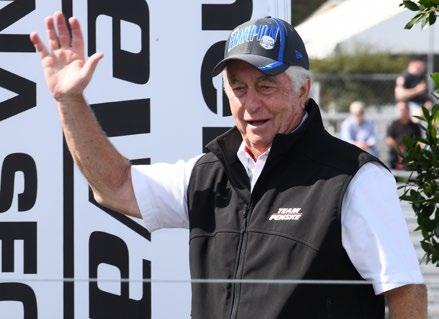

Penske, whose nickname is “The Captain,” captured his first victory as a Cup Series team owner in 1973 with Mark Donohue, and other well-known drivers who’ve wheeled his Cup Series cars include Donnie’s brother, Bobby Allison, along with Rusty Wallace, Ryan Newman, Kurt Busch, Brad Keselowski and newly crowned 2022 Cup Series champion Joey Logano, who’s delivered two Cup Series titles for Penske in the last five years.
KEN SQUIER: With an unmistakable voice that routinely filled the homes of untold millions of NASCAR race viewers for nearly 30 years, Ken Squier is rightfully nicknamed “The Voice of NASCAR.”

After co-founding the Motor Racing Network (MRN Radio) in 1970, Squier took his broadcasting talents to television with CBS’ coverage of the 1979 Daytona 500 — the first NASCAR race aired on live TV from start to finish. The race turned out to be one of the most consequential events in NASCAR history when brothers Donnie and Bobby Allison teamed up to engage Cale Yarborough in a post-race fisticuffs after Donnie crashed along with Yarborough on the final lap, opening the door for Richard Petty to score an unlikely win. “And there’s a fight – between Cale Yarborough and Donnie Allison,” Squier exclaimed from the CBS broadcast booth. “The tempers, overflowing.”
CHAD KNAUS: Easily the most successful crew chief of NASCAR’s “modern era” that began in 1972, Chad Knaus was atop Jimmie Johnson’s pit box for 81 of Johnson’s 83 victories as driver of the No. 48 Hendrick Motorsports Chevrolet (Knaus was serving a suspension when Johnson won his other two).
More notably, Knaus guided Johnson to his seven Cup Series championships that tied the all-time record for most titles previously set by Richard Petty and the late Dale Earnhardt. Since moving away from a crew chief role at the end of 2020, the second of two seasons he spent with Hendrick driver William Byron, Knaus has stepped into an executive role with the company as vice president of competition.
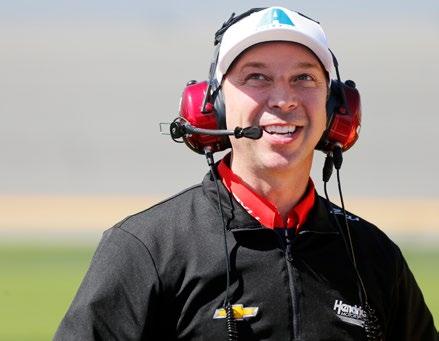
31
NASCAR TEAMS MAKE THE SPEED



Even NASCAR’s greatest drivers wouldn’t have found success if not for the men and women “back at the shop.” Here’s a look at some of the most iconic teams in NASCAR history.
HENDRICK MOTORSPORTS: When Joseph Riddick “Rick” Hendrick formed AllStar Racing (now Hendrick Motorsports) in 1984, he came close to folding several times in the first couple of years due to lack of money. But once his teams started winning both races (291) and Cup Series championships (14), HMS has gone on to become the sport’s most successful organization.
PETTY ENTERPRISES: A close second to Hendrick Motorsports, Petty Enterprises was formed by team patriarch Lee Petty in 1949 and continued by son Richard. The Petty camp has earned 268 NASCAR Cup Series victories, with Richard contributing the most (196 wins and seven championships). While the Petty clan became the most successful organization in the 1960s and 1970s, by the 1980s things had gotten lean – and have continued that way since.
ROUSH FENWAY KESELOWSKI
RACING: This team has gone from Roush Racing to Roush Fenway Racing to Roush Fenway Keselowski Racing in 2022 when NASCAR Cup Series driver Brad Keselowski joined the organization as a driver and parttime owner (with the plan he’ll succeed team patriarch Jack Roush when his racing days are over). The organization has 138 Cup Series wins and two series championships, but has struggled of late, with no points finishes higher than 15th since 2015.

JOE GIBBS RACING: When NFL coach Joe Gibbs announced he was forming a NASCAR team in 1992, many laughed at him. But using the same diligence and strategy he utilized on the gridiron; Joe Gibbs Racing has gone on to 200 career Cup Series wins and five series championships. Unfortunately, the two sons Joe Gibbs planned to succeed him in running the organization, J.D. and Coy, have passed away, leaving the future of JGR unclear.
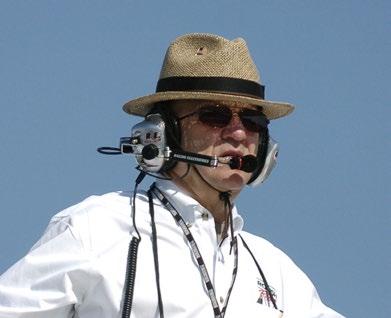
TEAM PENSKE: Operated by perhaps the most iconic team owner in all of motorsports (including his tremendous success in Indy car racing), Roger Penske has built a NASCAR organization that can hold its own against any rival, with 135 Cup Series wins and three championships (all in the last decade, including Joey Logano winning the 2022 crown). Austin Cindric, who won the 2022 Daytona 500, and Ryan Blaney are on the cusp of becoming NASCAR greats.



JUNIOR JOHNSON AND ASSOCIATES: Junior Johnson was among the first five inductees into the NASCAR Hall of Fame, not just for his 50 victories as a driver, but also for the 132 wins he amassed as a Cup Series team owner, including six championships (three each by Cale Yarborough and Darrell Waltrip). Johnson was an innovator, mentor and one of the most intelligent men to ever sit behind the wheel or atop the pit box.

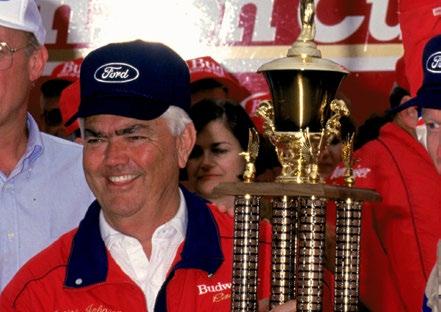
RICHARD CHILDRESS RACING: Like many of his predecessors, Richard Childress went from being a so-so driver to an outstanding team owner, amassing 113 Cup Series victories and six championships. All of the team’s titles came with Dale Earnhardt driving and RCR has struggled to find its footing since his death in 2001 Daytona 500. However, with Kyle Busch joining the team this year, look for a major uptick in performance, wins and championships.



WOOD BROTHERS RACING: A true family operation that began in little, bucolic Stuart, Virginia, Glen Wood and brother Leonard formed the backbone of the organization. When Glen retired in the late 1980s, his sons, Eddie and Len, took over leadership of the organization, roles they continue in to this day. The organization has won 99 NASCAR Cup Series races, but has never earned a championship.

HOLMAN MOODY: From 1957 until 1973, Holman Moody was one of the most feared organizations in NASCAR. Backed by Ford Motor Co., it also was one of the most coveted destinations for drivers, winning 96 races with the likes of Fred Lorenzen, Mario Andretti (won his only Daytona 500 in 1967 for Holman Moody), Bobby Allison, Joe Weatherly and David Pearson, who brought the company its only two NASCAR Cup Series championships

32 BIGGEST & BEST: TEAMS
WORDS: JERRY BONKOWSKI
Pursue your passion and pull away from the competition at Liberty University.





A proud sponsor of William Byron and the LU24 Chevy Camaro ZL1, Liberty University o ers more than 700 programs of study, including business and engineering. Whether you prefer the on-campus experience or the convenience of an online education, Liberty has the right fit for you!





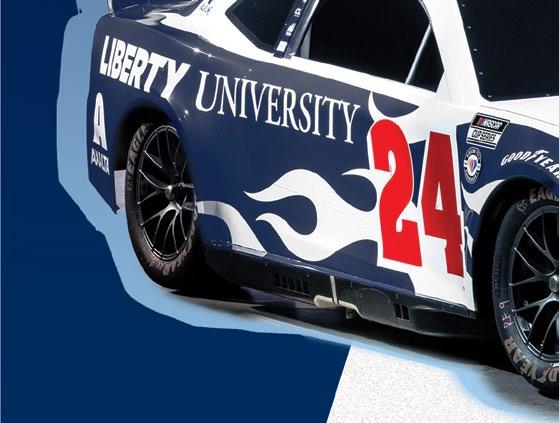


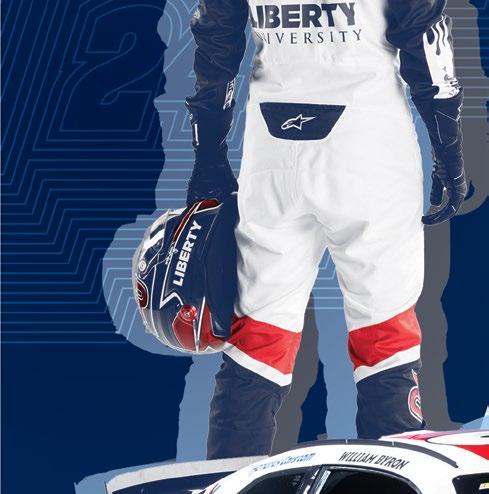

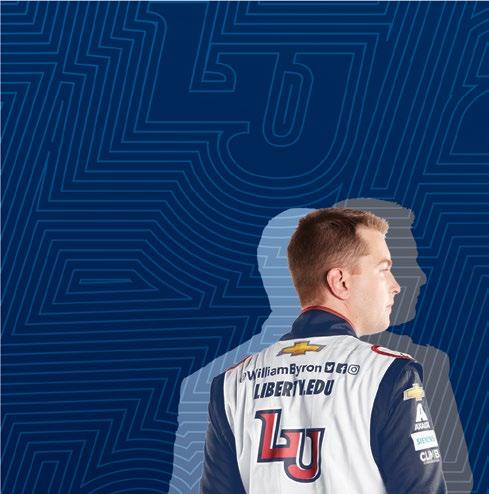
SCAN for more INFORMATION or a CHANCE TO WIN. LIBERTY.EDU/24
© 2023 Hendrick Motorsports, LLC
RIVALRIES CAPTIVATE NASCAR FANS
The best thing about NASCAR is winning, but the sport’s many rivalries are a close second. Which driver(s) is/are the best? Who’s the fastest or savviest? Who gets the best bragging rights? Fans love to argue and debate these topics. Here’s our picks for the all-time best rivalries:
DALE EARNHARDT VS. JEFF GORDON
While they raced just eight years (1993-2000) against each other, Dale Earnhardt vs. Jeff Gordon was one of the best rivalries the sport has ever seen. Earnhardt was “The Intimidator,” while Gordon was “Wonder Boy.” Their rivalry was fierce, leading NASCAR’s huge surge in popularity during the 1990s and into the 2000s before Earnhardt’s death at Daytona in February 2001. They were like wrestlers on-track with their bravado and loved to get fans fired up, but were great friends off-track and sold a ton of merchandise together, laughing all the way to the bank.
CHEVROLET VS. FORD
There’s been a massive rivalry for decades between Chevrolet and Ford – also known as the battle between the Bow Tie (Chevy) and the Blue Oval (Ford) – that began on the race track and extended to auto dealer showrooms. One humorous sidelight: There were countless decals produced that promoted a fan’s loyalty, most notably a cartoon character urinating on the logo of their arch-rival manufacturer. There have been other makes over the years, including Toyota (currently) and formerly Dodge, Chrysler, Pontiac, Oldsmobile and Buick, but no one has ever come close to Chevy vs. Ford.
KYLE BUSCH VS. EVERYBODY
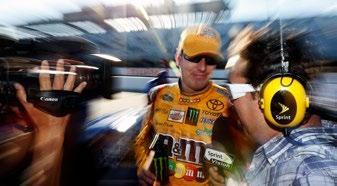

THE YOUNGER BUSCH BROTHER HAS HAD MORE rivals and enemies than perhaps any other driver in NASCAR history. When he first came on the scene, he was young, brash, cocky … but could wheel the hell out of a race car. As he’s gotten older, got married and had a family, Busch has mellowed somewhat. But if a race is on the line, he’s still the best pick to win.
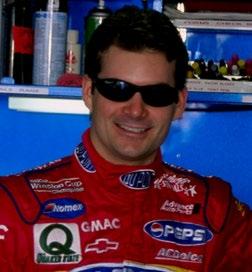
RICHARD PETTY VS. DAVID PEARSON

NASCAR’S ALL-TIME BEST RIVALRY WAS Richard Petty vs. David Pearson. They called each other the toughest driver they ever faced. They finished 1-2 in 63 of their respective wins against each other. If it hadn’t been for the other, Petty might have had 300 wins and Pearson would have lots more than 105 victories

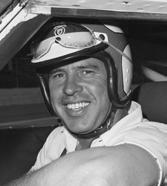

DALE SR. VS. THE DAYTONA 500
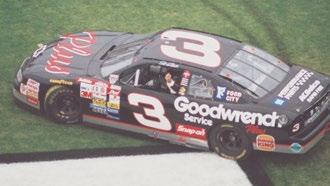
NO MATTER HOW HARD HE TRIED, DALE Earnhardt could not win the sport’s biggest race, the Daytona 500. He tried everything to win The Great American Race but always came up short. Just when he was ready to give up, he finally reached Victory Lane in his 20th try in 1998. Fittingly, all teams came onto pit road to cheer and congratulate him.



34
BIGGEST & BEST: RIVALRIES
WORDS: JERRY BONKOWSKI
All of the biggest families in NASCAR under one roof. Bring your family to the NASCAR Hall of Fame and make new memories in our racing simulator and pit crew challenge or get up close with the iconic cars along Glory Road. With over 850 artifacts and 50 interactive exhibits that span generations, everyone will find something for the scrapbook. THIS IS OUR SPORT. THIS IS OUR HOUSE.
nascarhall.com
NASCAR ® and NASCAR Hall of Fame ® are registered trademarks of the National Association for Stock Car Auto Racing, Inc. © 2023.

DRIVERS WHO EMBRACED THE BOOS
If NASCAR fans don’t like a driver, they quickly let ’em know with boos. But several drivers have let that animosity work in their favor.
THE MAN WITH THE SNIDELY WHIPLASH mustache was one of NASCAR’s most aggressive drivers and he was hated by fans of rival drivers who fell victim to Earnhardt and his famous “chrome horn.” When fans booed, The Intimidator would tick ’em off even more with a big smile in return.
DARRELL WALTRIP
THE MUHAMMAD
Ali of NASCAR, aka “I am the Greatest!” But as much as fans hated him for his cockiness and braggadocio, Waltrip backed it all up with 84 wins and three championships. Ironically, once he went into the FOX broadcast booth, he became one of the most beloved personalities in the sport.
JIMMIE JOHNSON & CHAD KNAUS
EARNHARDT’S ARCHrival. If you loved Earnhardt, you hated Gordon. But the irony is the duo was actually good friends off-track and their rivalry in many ways was just an act. Gordon was one of the biggest thorns in
ANOTHER OVERTLY AGGRESSIVE racer who had no problem mixing it up with fellow drivers in and out of his race car. He endured a number of suspensions for his actions but has gone on to be quite the entrepreneur, including operating the very successful Stadium Super Trucks Series.
You can’t mention one without the other. Fans hated Johnson for all his wins and championships, while crew chief Knaus was booed because how he loved to push the envelope –some would call it outright cheating.


EXTREMELY TALENTED BUT HE was like a fish out of water in his seven years in NASCAR. Whether it was because he was a foreign-born driver or his abject cockiness at times, JPM had more than his share of boos.
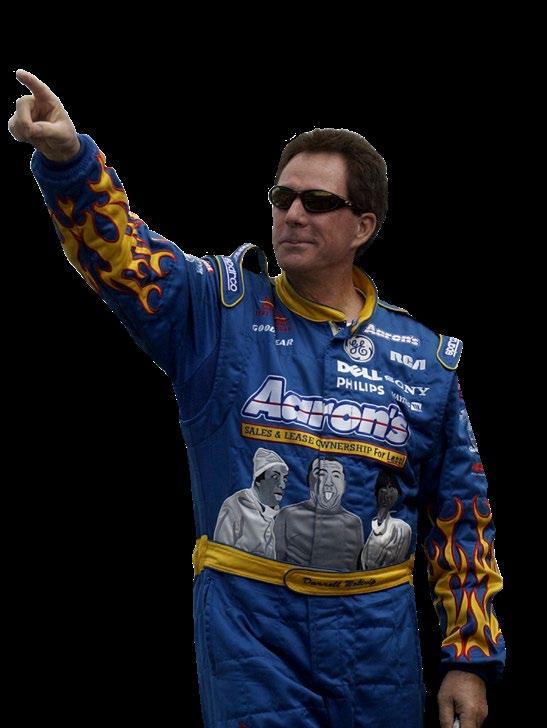

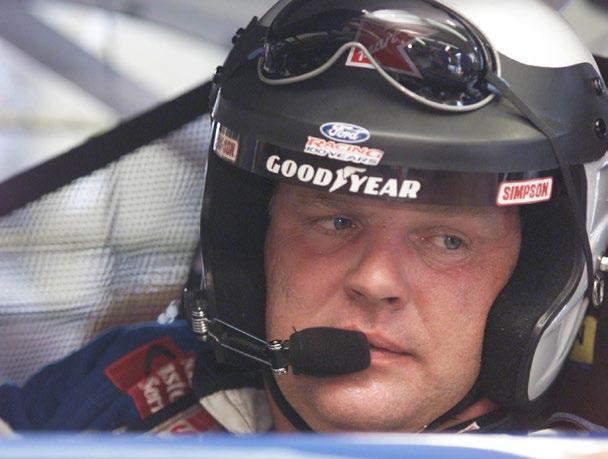
KYLE BUSCH


THE YOUNGER BUSCH brother was easy to hate because of his oftentimes standoffish attitude, his complaints about virtually everything, his aggressive driving and his overt cockiness. While he still has occasional episodes of the old Kyle, marriage and fatherhood have mellowed him.
WHILE “MR. Excitement” drew his share of boos, he also was wildly cheered for the day he punched Kurt Busch in the nose.
36
JUAN PABLO MONTOYA
JEFF GORDON
ROBBY GORDON
JIMMY SPENCER
BIGGEST & BEST: TROUBLEMAKERS
DALE EARNHARDT
WORDS: JERRY BONKOWSKI
Model
Bring Home, Fast, Easy, Beautiful Mowing
The Model R is the perfect Walker Mower for residential properties. The belt-driven mower blades make operation smooth and quiet without compromising on the Walker Mower’s distinct advantages. The Model R provides the premium Walker experience so you can bring home fast, easy, beautiful mowing.


Model R Features:
• An integrated side discharge deck design
• 42, 48, and 54 inch cutting widths
• Optional mulch kit
• Optional side-mount grass catcher
• Optional 48” dozer blade attachment
• Tilt-up deck and tilt-open seat for easy maintenance
See for yourself on your own property.
Request a free demonstration today!
FAN FAVORITES WHO NEVER WON A TITLE
They were some of the greatest and most popular drivers in NASCAR, but they all had one thing missing – They never won a Cup Series championship.
MARK MARTIN
THE PRIDE AND JOY OF Batesville, Arkansas, is arguably the best driver in NASCAR history to never win a Cup Series championship. He earned 40 wins in 882 career starts and from 1989 through 2009 (he began Cup Series racing in 1981 and officially retired after the 2013 season), finished in the top 5 in 13 seasons, and four others in the top 10. Martin came ever so close to winning a championship, finishing runner-up an uncanny five times (1990, 1994, 1998, 2002 and 2009), but he never was able earn the title of NASCAR Cup Series champion.
CARL EDWARDS
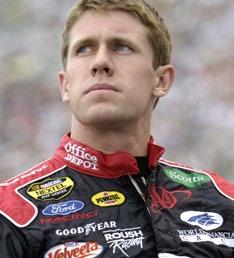


WHEN PEOPLE TALK ABOUT Edwards, he would fall under the “What Might Have Been?” category. He just missed winning the 2011 Cup Series championship on a tiebreaker to Tony Stewart. And from 2005 through 2016, Edwards recorded six season finishes in the top 5 and two other top-10 showings. He shocked the sport when he suddenly announced prior to the 2017 season that he was stepping away (although he never used the word “retire”). While there was hope he’d eventually return, even part time, we’re now going on seven years and we’re still waiting for “Cousin Carl” to return to racing.
DALE EARNHARDT JR.
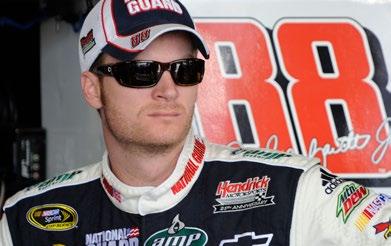
THE SON OF LEGENDARY DALE

Earnhardt, the man nicknamed “Junior” and “Little E” was voted NASCAR’s Most Popular Driver for 12 years by fans and peers. He won 26 races in 631 starts, but inconsistency and mistakes cost him dearly, preventing
him from ever winning even one Cup Series championship, although he did win Xfinity Series titles in 1998 and 1999. His highest Cup Series finish was third in 2003. He also finished fifth three different times, but he just didn’t have what it took to win one, let alone seven Cup Series championships as his late father did.
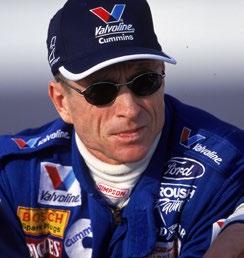
JUNIOR JOHNSON
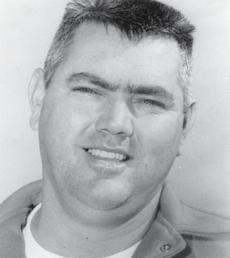
ROBERT GLENN JOHNSON JR., known simply as “Junior,” was one of the top drivers and owners in NASCAR history. That’s why he was among the first five inductees of the NASCAR Hall of Fame. As an owner, his teams won 132 races and six championships. But as a driver, while he earned 50 wins, the most of any driver who never won a championship, Junior never earned the coveted Cup Series crown. But there’s a reason why: He never ran a full season in his 14 years behind the wheel, with his best overall season finishes being sixth (achieved twice).
RICKY RUDD
IF HE WASN’T A RACE CAR DRIVER, Ricky Rudd would have made a great mailman because neither snow nor rain nor heat nor gloom of night would keep this NASCAR racer from his appointed rounds, including a record of 788 consecutive starts (from 1981 through 2005), since broken by Jeff Gordon. Rudd made 906 starts in his Cup Series career, earning 23 wins (including at least one win in 16 straight seasons, from 1983-1996). While Rudd had season finishes five times in the top 5 and 14 times in the top 10 during 33 seasons, he never earned a Cup Series championship.
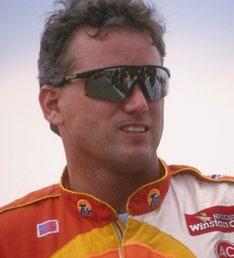
38 BIGGEST & BEST: HEARTBREAKERS
WORDS: JERRY BONKOWSKI

7 ICONIC NASCAR SPONSORS
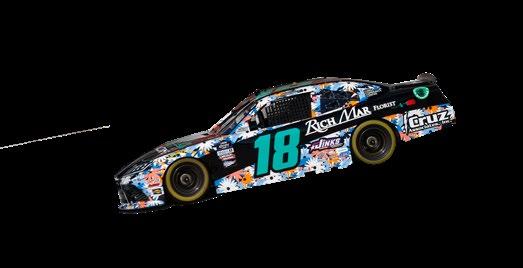
EVERYTHING FROM AN OIL ADDITIVE TO A SOFT DRINK

Corporate sponsorship is the engine that drives every type of auto racing. Since NASCAR’s debut as a sanctioning body in 1948, there have been countless exemplary companies that have financially supported its competitors and series. Whether painted on a race car or supporting the sport in other ways, fans have long had a unique relationship with corporate sponsors. In fact, many will solely purchase products from a company because it sponsors their favorite driver’s car.
STP
Dating back five decades, oil additive STP has had a constant presence in NASCAR racing; starting with Fred Lorenzen in 1971. The Petty-blue-and-fluorescent-red colors eventually became symbolic with Richard Petty, who captured four of his recordtying seven Cup Series championships while sponsored by STP (1972, 1974, 1975 and 1979). STP still has relevance in the sport, last sponsoring Erik Jones in 2021.
LOWE’S

Then there’s Lowe’s, which was Jimmie Johnson’s primary sponsor for 17 years. In that time, the No. 48 team also won seven championships, including five in a row (2006-2010), making the home improvement chain the primary sponsor to win the most titles in NASCAR history.
COCA-COLA
As far back as 1970, Coca-Cola has had a presence in NASCAR. Don Tarr was the first Coke driver before it sponsored Bobby Allison – in a car owned by Junior Johnson – later that decade. Coca-Cola branched into race sponsorship in the 1980s for the spring race at Atlanta and then took over the naming rights of the series’ longest race at Charlotte Motor Speedway on Memorial Day Weekend in 1985. It’s a tradition that continues nearly four decades later, with the beverage occasionally being on cars, too.
WINSTON
While the Cup Series doesn’t presently have a title sponsor (it has four premier partners), Winston cigarettes took its activation to the next level when the R.J. Reynolds brand sponsored the series from 1971 to 2003. Winston was the first non-automotive company to sponsor NASCAR racing a full-time basis. To honor that era of the sport, there’s a Winston Cup Museum in Winston Salem, North Carolina.
GM GOODWRENCH

Speaking of sponsors that have won plenty of championships, it’s worth bringing up GM Goodwrench. Synonymous with Richard Childress Racing and Dale Earnhardt, the famed No. 3 car won four titles and 45 races in Goodwrench colors before Earnhardt’s death in the 2001 Daytona 500. Kevin Harvick then sported the Goodwrench colors and won in his third career Cup Series start. If you visit a track this season, you are guaranteed to see black GM Goodwrench apparel.
GOODYEAR
In order to make efficient time around the track and help keep the drivers safe, the NASCAR Cup Series has relied on Goodyear Tire & Rubber Co. for nearly seven decades (1954) as the “Official Tire of NASCAR.” As NASCAR has become more innovative, so too has Goodyear. In 1972, the company introduced the racing slick, radial tires debuted in 1989 and multi-zone tread arrived in 2013. With the Next Gen car being introduced in 2022, Goodyear had the challenge of making an 18-inch racing tire, though it’s been delivering a similar product to consumers for years.
DUPONT/AXALTA
When DuPont entered the sport in 1992, it was during a changing of the guard. Not only was it Richard Petty’s last race, but it was Jeff Gordon’s first race, in what turned out to be a first-ballot Hall of Fame career. The Wonder Boy won a career-high 13 races in 1998, along with four championships between 1995 and 2001. The rainbow warrior paint scheme is regarded as one of the most eye-catching in NASCAR history. DuPont’s flamed scheme that began in 2001, isn’t bad either. Now rebranded as Axalta, the company is still sponsoring Hendrick Motorsports.
AN INCREDIBLE RIDE FOR RICH MAR FLORIST
GOING INTO OUR SIXTH SEASON OF NASCAR RACING, WHAT AN INCREDIBLE RIDE IT HAS BEEN. track, Rich Mar Florist Racing has had the privilege of sponsoring many drivers and teams. The highlight of our on-track success so far has been sponsoring Kyle Larson in 2021 when he was the series champion, and last year when James Davison and Joe Gibbs Racing finished fourth in the Xfinity Series race on the Charlotte ROVAL. A big thanks to Garrett Smithley, Josh Bilicki, Spencer Boyd, Stefan Parsons, Ryan Ellis and Sage Karam, who constantly carry our brand colors. Success on the track has led to success in so many areas, and we can’t wait to see what’s next for us in NASCAR. Happy Anniversary!
JONATHON MORRISSEY | OWNER, RICH MAR FLORIST
40 BIGGEST & BEST: SPONSORS WORDS: DUSTIN ALBINO

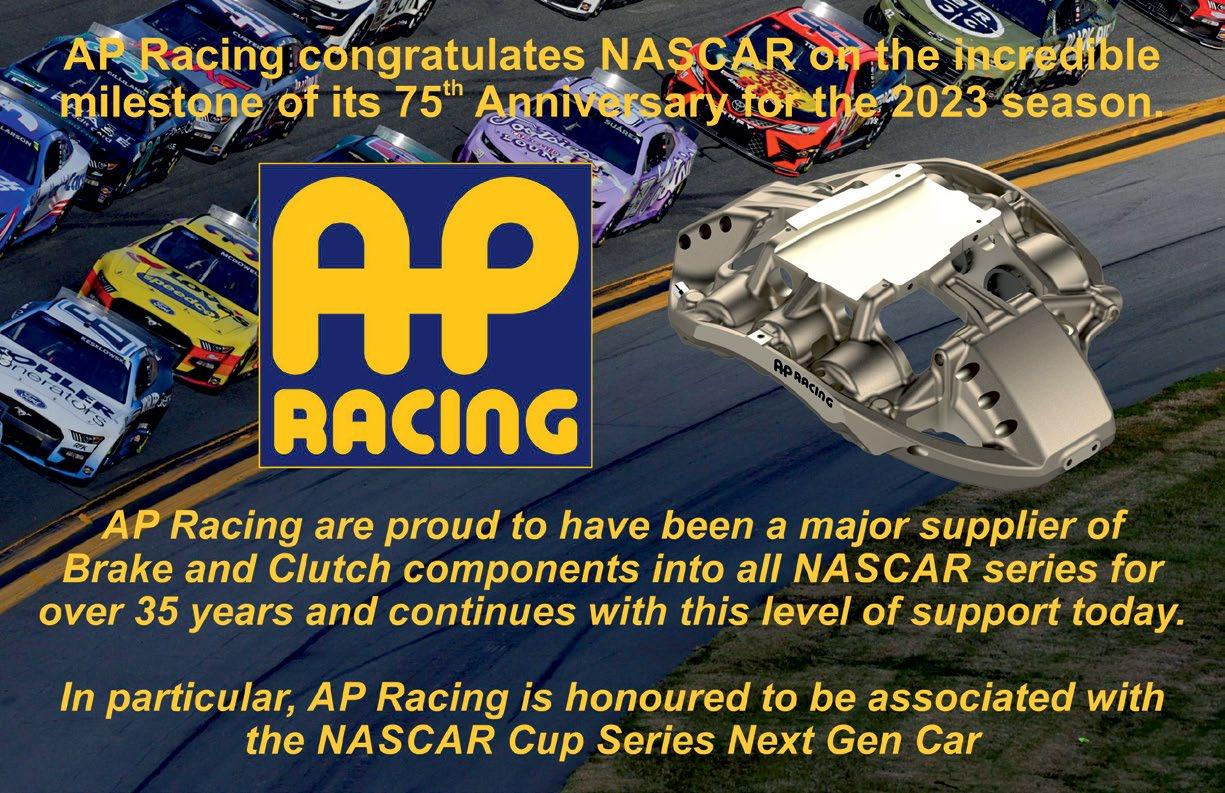
THE INTIMIDATOR TO JAWS
NICKNAMES HAVE LONG ADDED COLOR TO NASCAR

While NASCAR drivers are among the most fearless people in the world, many racers have nicknames that add to their on-track persona. Over the last 75 years, there have been some dandies, with no discrimination among success. Here are some of the best nicknames in the sport’s history.
THE KING: Between 1967 and 1971, Richard Petty won double-digit races every year. With his dominance, he was coined “The King.” It’s a moniker that he still rocks today, with his Charlie 1 Horse cowboy hat.

THE INTIMIDATOR: Undeniably, Dale Earnhardt is among the greats in NASCAR history. And he didn’t shy away from his aggressive nature on the track. At times, it was move out of the way or get moved, but his nickname came to life with his “pass in the grass” of Bill Elliott during The Winston at Charlotte Motor Speedway in 1987.
THE SILVER FOX: With a winning percentage of 18.3, David Pearson, to many, is NASCAR’s GOAT. Though he never ran a full season, Pearson would often hang low in the opening stint of races before leaping to the front of the pack toward the end.
JAWS: No driver in NASCAR history was a better smack-talker than Darrell Waltrip. Cale Yarborough took notice early in DW’s career and gave him the “Jaws” nickname. Waltrip put it to good use in rivalries with Yarborough, Earnhardt and Rusty Wallace.
FIREBALL: In high school, Glenn Roberts was a standout baseball player who knew how to throw heat. Roberts is known as one of the best drivers to never claim a NASCAR Cup Series championship, despite winning 33 of his 206 starts.


SMOKE: Where there’s smoke, there’s fire, and Tony Stewart knew how to burn the tires off his car. The nickname “Smoke” predates his NASCAR driving days and reportedly goes back to when he ran sprint cars; when he would spin his tires off the corners so much that smoke would billow from his rear tires.

ROWDY: Love him or hate him, Kyle Busch has been among the most polarizing figures in the history of NASCAR. His “Rowdy” nickname came from his aggressive style on the track and his ruthless attitude. The Rowdy tagline has been associated with him since the mid-2000s, and he eventually created an energy drink, named Rowdy.
AWESOME BILL FROM DAWSONVILLE: The Elliotts have a long lineage in NASCAR, and have always stuck to their Dawsonville, Georgia, roots. Bill Elliott won 28 races in the back half of the 1980s, en route to the 1988 Cup Series title.
THE ROCKETMAN: In the 2000s, Ryan Newman was fun to watch in qualifying. He won a career-high 11 poles during his sophomore 2003 season, and finished his career with 51 total – 43 of which came for Team Penske. Between 2003 and 2005, the Indiana native started from the pole in six straight races at Atlanta Motor Speedway – a track record.
MR. EXCITEMENT: Before his NASCAR career began, Jimmy Spencer was anointed with the nickname “Mr. Excitement” for his aggressive nature in modifieds. Spencer was relevant through the 1990s and early 2000s, before becoming an analyst for SPEED. There, he was known for never holding back his bold opinions and beliefs.
RAINBOW WARRIORS: With a rainbow wrapped DuPont Chevrolet, Jeff Gordon and his No. 24 team quickly became known as the “Rainbow Warriors” in the 1990s. Gordon won three championships in the decade and double-digit races in three straight years (1996-1998).
42 WORDS: DUSTIN ALBINO BIGGEST & BEST: NICKNAMES
Southern California’s GREATER ONTARIO is where it’s happening. It’s a place where you can enjoy hiking, skiing, fishing, or biking in our scenic mountains during the day, then dive into the diverse culinary scene, and live entertainment in the evening. The great outdoors in less than one hour in any direction, you’ll find alpine lakes, deserts, vineyards, or the Pacific Ocean. GREATER ONTARIO is the ultimate destination for your next adventure with a multitude of amenities, lodging, the annual Route 66 Cruisin’ Reunion car show held the third week in September, capped with enviable sunshine 300 days out of the year. Start


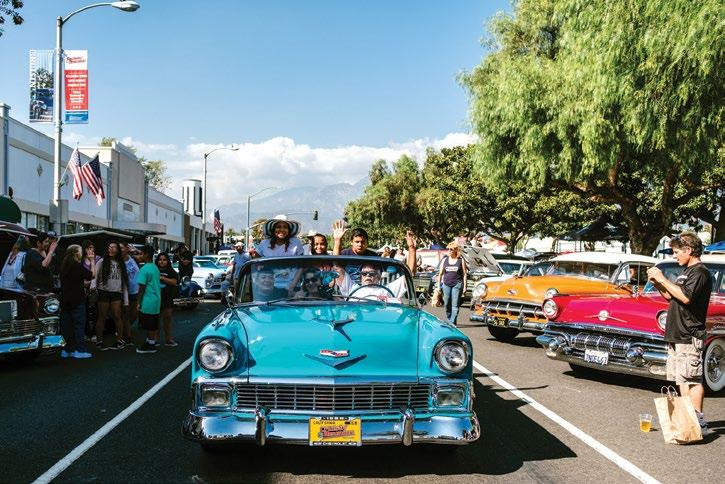


your
at GOcvb.org
an adventurous spirit, and we’ll take care of the rest.
visit
Bring
800.455.5755
MILESTONE MOMENTS EVENTS THAT SHAPED NASCAR HISTORY
NASCAR is currently celebrating its 75th Anniversary of competition after the sanctioning body was officially incorporated on Feb. 21, 1948, in Daytona Beach, Florida.
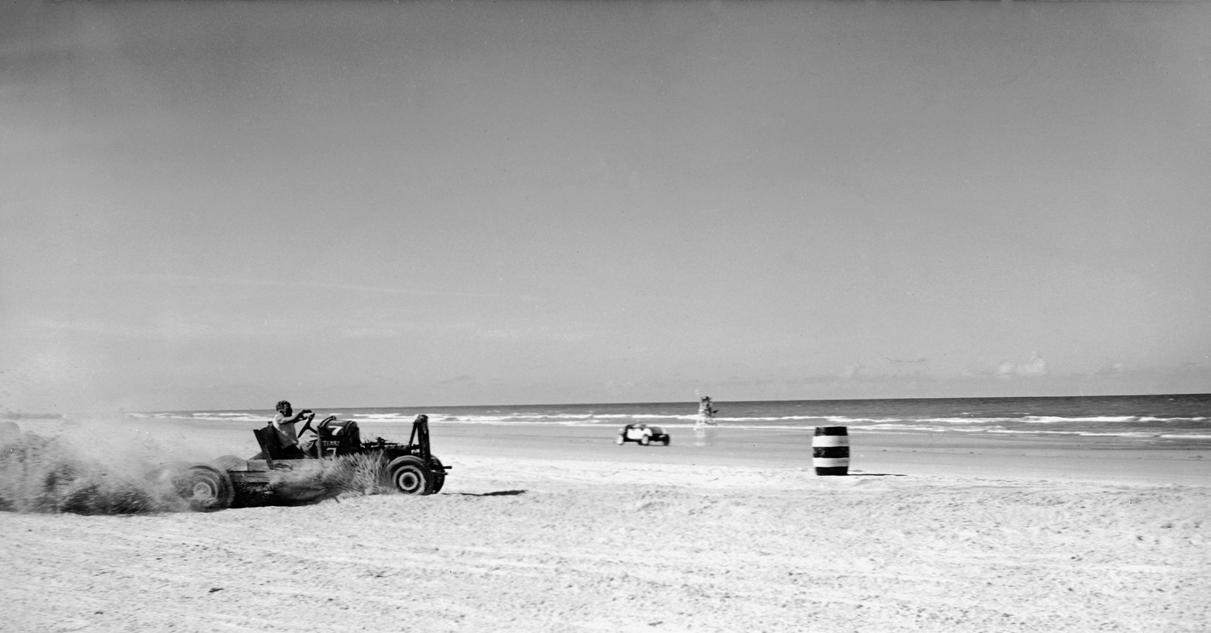
Many significant milestones have been achieved over those seven decades that have positioned NASCAR racing among the premier major league sports around the world.
Seeking to prove which make of car was the fastest and most reliable among America’s auto manufacturers, their “Win on Sunday/Sell on Monday” sale strategies were successful as auto executives hired the absolute best drivers to wheel their latest creations on a variety of race tracks around the country.
Those who piloted the earliest creations were farmers,


millworkers, mechanics and moonshiners. They were unafraid to push Chevrolets, Dodges, Fords, Hudsons and Mercurys to their absolute limits, while seeking to become woven as champions into NASCAR’s incredible history.
The sport’s legendary superstars are household names – Allison, Baker, Earnhardt, Panch, Pearson, Petty, Roberts, Turner, Weatherly and Yarborough, to name only a very few. Many were fathers who raced to glory on NASCAR’s short tracks and superspeedways before passing their professions down to their sons.
Here is a look back at several milestone events that helped shape American stock car racing into the sport we celebrate and enjoy today.
44 PHOTOGRAPHY: GETTY IMAGES MILESTONE
MOMENTS
THE FIRST CUP SERIES RACE
JUNE 19, 1949
When World War II officially ended on Aug. 9, 1945, American servicemen returned home to rebuild their lives and they searched for work to support their families.
Some had raced cars in vacant pastures before the war, which began with the bombing of Pearl Harbor on Dec. 7, 1941. The rush of wartime remained, prompting a large number of men to either try their hand at stock car racing or return to the new and vastly popular pastime that was quickly being organized.
When William Getty “Bill” France formed NASCAR on Feb. 21, 1948, there were five other groups attempting to organize sanctioning bodies to present stock car racing.
Driver Robert Nolin “Red” Byron won 11 of 52 races during the 1948 season and was crowned NASCAR’s first Modified champion.
The success of the Modified stockers made France thirst for more. He then promoted NASCAR’s first Strictly Stock race on the newly built Charlotte Speedway, a dirt track located near the North Carolina city’s Wilkinson Boulevard.
From the very start, the Strictly Stocks were billed as NASCAR’s premier division,
A NEW ERA DAWNS
SEPTEMBER 4, 1950

On Dec. 13, 1949, land developer Harold Brasington became somewhat of a laughingstock around Darlington County, South Carolina, after he began clearing 70 acres of brush from a former cotton field adjacent to Hartsville Highway.
After attending the Indianapolis 500 in May 1949, it became Brasington’s dream to build a race track that resembled the famed 2.5-mile Indy layout.
Everyone thought he had lost his mind but still, many around the small hamlet of Darlington, South Carolina, bought stock in his risky venture.
The second biggest shareholder, Sherman Ramsey, gave Brasington the acreage needed to make the venture come to fruition. On a handshake, Ramsey agreed to Brasington’s terms as long as the minnow pond located outside the second turn remained untouched.
The two business entrepreneurs created an egg-shaped oval that became one of the toughest tracks in motorsports.
Brasington is known to have said to Sherman, “You go fishing and I’ll go to work.”
Only nine months later, Brasington cut the thick red ribbon on his 1.25-mile superspeedway, the first paved oval of its kind in the South and a sight to behold by the townsfolk who had never seen such a spectacle.
which today is known as the NASCAR Cup Series. For weeks leading up to the June 19, 1949, race, talk of the upcoming event spread rapidly. Predictions of a large crowd were correct as 13,000 filled the makeshift wooden bleachers.
After 200 laps on the three-quarter-mile, dust-generating dirt surface, Kansan Jim Roper was declared the winner in the Lincoln he drove from his home state. Roper inherited the victory when the rear leaf springs on the 1947 Ford driven by apparent winner Glenn Dunaway were deemed illegal.

Roper had seen a comic strip in the newspaper announcing the race and drove without stopping over several days to get to the track.
“That strip always advertised the air shows and it was pretty popular at the time. I always read it,” Roper said in the April 1992 edition of American Racing Classics. “That fellow (cartoonist Zack Moseley) had the race mentioned in it and we decided to give it a try.
“That ($2,000 to win) was pretty big money back then (nearly $21,600 in today’s money).”
There were 12 Fords, four Hudsons, six Oldsmobiles, three Lincolns, two Buicks, two Chryslers, two Kaisers, one Cadillac and one Mercury in the 33-car field. Roper drove his winning No. 34 Lincoln, with his trophy in the passenger seat, back to Kansas after the race.
NASCAR scheduled the track’s first race – the Southern 500 – for Sept. 4, 1950. Brasington worried he wouldn’t fill all 9,000 seats he had constructed by way of concrete bleachers. Instead, 25,000 spectators showed up and camped all around the speedway with nowhere to house them. Many camped around the town square and on the courthouse steps in Darlington hoping to score a race day ticket.

A field of 75 cars took the green flag for the 400-lap event led by pole winner Curtis Turner from Virginia. The 500-mile race spanned 6 hours and 38 minutes with drivers suffering so many blown tires that some were secretly taken off passenger cars in the field to finish the race.
California native Johnny Mantz wheeled an underpowered six-cylinder Plymouth to victory using a set of hard Indianapolis-style tires for the entire race, averaging 75.250 mph. Team owner Red Vogt protested the win but nothing illegal was found. Mantz’s strategy of pacing himself while others raced hard was his advantage for winning.
45 PHOTOGRAPHY: GETTY IMAGES
THE INAUGURAL DAYTONA 500
FEBRUARY 22, 1959
THE TRAGEDIES OF 1964
JAN. 19, 1964 - NOV. 8, 1964

When Daytona International Speedway opened on Feb. 6, 1959, it was truly the largest race track NASCAR racers had ever seen at 2.5 miles in length.
Drivers had experienced the treacherous Darlington Raceway at 1.25 miles in length for eight previous seasons, but the newly constructed superspeedway in Daytona Beach, Florida, was expected to generate the fastest speeds ever experienced to that point in stock car racing.
Bill France, the founder of NASCAR and builder of the speedway, recognized the value of newspaper headlines and stretched practice and qualifying sessions over a 10-day period. He also conceived the idea of holding single-car qualifying sessions as well as two traditional 125-mile qualifying events to set the starting field.

When race day arrived, 59 cars lined up for the 200-lap race with Shorty Rollins and Bob Welborn leading the field. Seven drivers did not make the starting field and were forced to load their cars and return home.
There were 33 lead changes in the race with driver Johnny Beauchamp flagged the winner over Lee Petty in a three-car photo-finish that included Joe Weatherly crossing the line one lap down. Petty felt he was the winner and posted a protest to have the finish checked.
At the time, the only way to resolve the issue was through the use of a photo-finish camera posted at the start-finish line. The film had to be developed and enlarged enough to see which car was ahead at the finish.
Both drivers commented they felt they had won, according to Greg Fielden’s “40 Years of Stock Car Racing” book series.
“I had Beauchamp by a good two feet. In my own mind, I know I won,” Petty said during post-race interviews.
Beauchamp replied, “I had him by two feet. I glanced over to Lee Petty’s car as I crossed the finish line and I could see his headlight slightly back of my car. It was so close I didn’t know how they would call it, but I thought I won.”
Fireball Roberts, an early leader in the race, was standing near the finish line and said: “There’s no doubt about it, Petty won.”
Photos and newsreel footage were studied over a three-day period before France declared Petty the winner the following Wednesday. Petty was given his trophy and check in his home. It was Lee Petty’s only Daytona 500 victory.

The 1964 NASCAR Cup Series season began on Jan. 19 at California’s Riverside International Raceway. That day, driver Joe Weatherly had returned to the nine-turn road course after a transmission change when his Bud Moore Engineering Mercury slammed driver side first into the turn six wall, taking his life instantly.
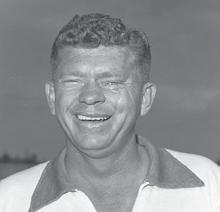
Only five months later, multiple tragedies occurred at Charlotte Motor Speedway in the Coca-Cola 600 and at Indianapolis Motor Speedway in the Indianapolis 500.
At Charlotte, NASCAR legend Glenn “Fireball” Roberts suffered severe burns in a three-car crash involving Ned Jarrett and Junior Johnson during the seventh lap of the 400-lap race.
The Tavares, Florida, native succumbed to his injuries 39 days later on July 2, 1964, after remaining in critical condition.
The same day as the 600, Eddie Sachs and Dave McDonald lost their lives in a horrendous multi-car crash and fire on the second lap of the Indianapolis 500.
Another driver to lose his life during the 1964 season was Jimmy Pardue, who was killed during a tire test at Charlotte on Sept. 22.
As a direct result of those crashes, fire-resistant uniforms were developed to keep flames away from drivers amid terrible crashes. Also developed that year were tire inner liners that kept tires from blowing out completely at high speeds. The inner shell of the tire remained intact to give drivers stability while bringing their cars under control. Also, roll cage construction was improved to protect the drivers.
Possibly the most important innovation came with the introduction of the fuel cell, a rubber bladder designed to prevent fueltank explosions, as was the case in Roberts’ crash at Charlotte.


Also, fire extinguisher systems were eventually developed and added to the front, rear and cockpit areas on the race car that can be activated by the push of a button.
As the decades passed, car construction, five-point seat belt harnesses, full-face helmets and HANS devices have brought injury and death in NASCAR competition to an absolute minimum.
“The 1964 NASCAR season as well as the tragedy of the deaths at Indianapolis that year paved the way for many safety innovations that were so desperately needed,” said H.A. “Humpy” Wheeler, formerly with Firestone Tire & Rubber Co. and also Charlotte Motor Speedway. “Because of those tragic deaths, other drivers were able to remain safe in the years to come. So many innovations have been improved upon that are still being used to some degree today.”
46 PHOTOGRAPHY: GETTY IMAGES MILESTONE MOMENTS
PETTY’S PHENOMENAL 1967
JAN. 22, 1967 - NOV. 5, 1967

There are times in professional sports when one season stands out above all the rest. Everything comes together perfectly, and no one can truly explain why or how it all came together.
That happened in 1967 when seventime NASCAR Cup Series champion Richard Petty drove a single 1966 Plymouth to more wins in a single season than anyone in NASCAR history.
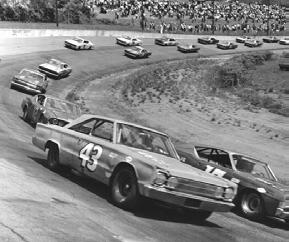
After 48 starts during that year’s NASCAR Cup Series season, Petty had won 27 races, including a NASCAR-record 10 consecutively. In all, the dominant signature Petty blue Mopar machine tallied 36 victories from 1966 to 1967.
At that time, having a car that finished 27 races was quite a feat, let alone win them. Many times, cars were crashed so badly they had to be scrapped and replaced with new ones. Miraculously, this particular car never suffered major damage of any kind, other than the occasional sheet metal rubs and bumps while battling for position. No matter where the car was raced, it was considered the class of the field and the car every driver wanted to defeat.
The famed Plymouth was the first to be loaned to the NASCAR Hall of Fame for its
WINSTON MONEY TRANSFORMS NASCAR
JANUARY 10, 1971
From its inception in June 1949 through November 1970, NASCAR’s premier series grew in popularity, most notably as a regional southern sport.
Then, circumstances far removed from stock car racing prompted a well-known corporation based in Winston Salem, North Carolina, to look for a new stage from which to promote its products.
On April 1, 1970, President Richard Nixon signed legislation banning tobacco advertising from being broadcast on television and radio. For years prior to the decision, public health advocates had touted the risks of using tobacco.
The timing was perfect as Detroit’s Big Three automakers – Ford, General Motors and Chrysler – had all but eliminated their factory support of race teams after years of entering and leaving the sport over rules disputes.
When Junior Johnson, a former NASCAR driver turned team owner, approached R.J. Reynolds Tobacco Co. officials about sponsoring his Chevrolet for the 1971 season, he quickly realized their desire to be a part of the sport was far bigger than sponsoring a single car. Johnson introduced RJR executives to

grand opening in Charlotte in 2010.
“The Plymouth Belvedere was a special car,” Petty said the day it was presented. “Back then we usually found a car that was good on short tracks or speedways or dirt tracks, but not many that were good everywhere. That Plymouth was fast no matter where we ran it.”
Dale Inman, crew chief for 193 of Petty’s 200 career victories, remembers the car as one of the absolute best that ever came out of the team’s Level Cross, North Carolina, shop.
“Back then, it was such a feat to not fall out of 10 races in a row, let alone win them,” Inman said. “There were a lot of 100-mile races, but still, to win that many was remarkable with the way the motors, wheel bearings and rear-ends were in that era. All that stuff is so much better now. “
Since opening 72 years ago, Petty Enterprises fielded Oldsmobiles, Plymouths, Fords, Dodges, Chevrolets and Pontiacs. Through 2007 when the organization ceased its NASCAR Cup Series efforts, the team had collected 268 wins, 10 Cup Series championships and nine Daytona 500 victories with Lee and Richard Petty as well as Pete Hamilton. The Pettys’ phenomenal 1967 season helped bring NASCAR to the forefront in newspapers alongside professional stick-and-ball sports.
NASCAR founder Bill France with the idea of becoming the first series sponsor in the sanctioning body’s then 23-year history.
The tobacco giant’s entrance into auto racing was a life preserver for NASCAR that resulted in several other Fortune 500 corporations being introduced to auto racing in the decades to come. RJR reduced the Winston Cup Series schedule from 48 races to 33, eliminating many dirt and asphalt short tracks from the circuit. A revamped points system was also put in place to accommodate the shorter, streamlined schedule.
In 1971, RJR spent hundreds of thousands of dollars on track improvements, repairing and painting buildings with the company’s signature red-andwhite Winston colors and adding signage, structures and seating where needed. RJR also began sponsoring the Winston 500 at Talladega Superspeedway.
From 1971 through 2003, the Winston Cup Series was recognized as one of the best auto racing sponsorship programs around the world. RJR also delved into NHRA Drag racing, the IMSA Camel GT Series for sports cars and backed the Lotus Formula One team from 1987 until 1990.
RJR’s most popular sponsorship package in NASCAR was the Winston Million, which was won by Bill Elliott in 1985 at Darlington Raceway as well as Jeff Gordon at the same track in 1997.
47 PHOTOGRAPHY: GETTY IMAGES
RICHARD PETTY VERSUS DAVID PEARSON
FEBRUARY 15, 1976

Throughout their careers, NASCAR Cup Series champions Richard Petty and David Pearson finished first and second to one another a total of 63 times with Pearson coming out first 33 times to Petty’s 30.

In February 1976, the ending to the Daytona 500 at Daytona International Speedway came down to one of the most exciting finishes in the then 17-year history of The Great American Race.
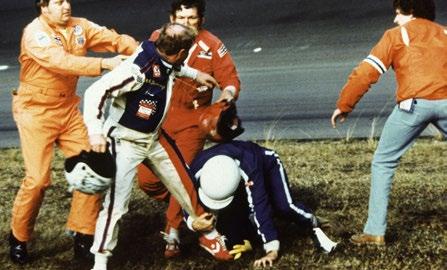
The two legendary drivers dogged each other throughout the 200-lap event with Pearson playing a waiting game in second as the laps clicked down to the finish. With one lap remaining, Pearson, driving the famed Wood Brothers Racing No. 21 Mercury, dropped low going into turn three to make his move around Petty’s No. 43 STP Dodge. Pearson had Petty cleared but saw Petty drop low to come back as they two leaders worked through the fourth turn with the checkered flag in sight.
In the chute between Turn Four and the start-finish line, it appeared Petty had Pearson beat, but when he pulled in front to complete the pass, the cars bumped. Petty worked to clear Pearson’s Mercury but came up short by a mere foot, sending both drivers hard into the outside retaining wall and spinning wildly into the tri-oval grass.
Petty spun down the track while Pearson spun toward pit road and clipped a lapped car. Petty was a mere 25 yards from the startfinish line frantically trying to get his Dodge refired. Pearson had the presence of mind to push in the clutch to keep his engine running and drove under the checkered flag at only 20 mph. Petty’s power came from a few crew members who ran to push him across the line.
“My engine never died,” Pearson said in Victory Lane. “Before I hit the wall I popped the clutch, put it in neutral and revved the engine as high as I could to keep it from stalling.”

The significance is that national news outlets, such as ABC’s “Good Morning America,” interviewed both drivers the day after the race in New York City, further bringing NASCAR into the national spotlight. It was the first time NASCAR had been featured on a major news show the morning after a race.
‘AND THERE’S A FIGHT!’

FEBRUARY 18, 1979
The 1979 Daytona 500 marked the first time the crown jewel event of the NASCAR Cup Series was televised live, flag to flag to a national audience.
After days of hard rain in Daytona Beach, Florida, the 200-lap event at the 2.5-mile Daytona International Speedway started under threatening skies. The Feb. 18 race was viewed by a national television audience on CBS as well as 120,000 fans in attendance.
Millions on the eastern seaboard were trapped in their homes by a massive snowstorm that stretched from north Florida to the state of Maine. There were only three national television networks at that time as broadcasting choices that day were NBA basketball, a western movie and the Daytona 500.
Seventy-eight drivers attempted to qualify for 41 available positions in the 500 field, led by pole position winner Buddy Baker. By race’s end, there were a total of 36 lead changes in the 3-hour, 30-minute race.
Drivers Donnie Allison, Cale Yarborough and Bobby Allison crashed together to bring out the second caution flag on lap 31. All three drivers would be the center of attention at race’s end when Donnie Allison and Yarborough crashed on the final lap while battling for the victory, with their damaged cars coming to rest at the bottom of Turn Three and handing the victory to Richard Petty.
When Bobby Allison stopped to give his brother a ride to the garage area, a fight broke out among the trio of drivers.
The brief skirmish on national television caught the attention of those watching who had never seen a NASCAR race, prompting conversations among casual fans as well as those who had followed the sport for many years. Among those who were introduced to the sport that day were a number of people from corporate America, looking to possibly join the sport in a sponsorship capacity.
While Yarborough and the Allison brothers were later fined for their actions, Petty enjoyed his sixth of seven Daytona 500 victories as the surprise winner. The native of Level Cross, North Carolina, had undergone major stomach surgery just a week before the race and was told by his doctors that he should not race due to the severity of the procedure.
The Daytona 500 victory also helped the Petty team renew its sponsorship with STP. Petty went on to race an additional 13 years before hanging up his helmet in 1992.

48 PHOTOGRAPHY: GETTY IMAGES MILESTONE MOMENTS
ELLIOTT BANKS THE WINSTON MILLION
SEPTEMBER 1, 1985

At the NASCAR Cup Series Awards Banquet in New York City during the winter of 1984, R.J. Reynolds Tobacco Co. offered $1 million to any driver who could win three of NASCAR’s four biggest races.
Ironically, the series sponsor felt the odds were a bit great to fulfill, as they did not initially set aside the funding to pay the Winston Million.
Bill Elliott, driver of the No. 9 Melling Racing Ford Thunderbird fielded by his family team, was able to accomplish the impossible by winning the 1985 Daytona 500 at Daytona International Speedway, the Winston 500 at Talladega Superspeedway and the Southern 500 at Darlington Raceway, giving NASCAR one of the greatest Cinderella stories in all of professional sports.
Having suffered brake issues during the Coca-Cola 600 at Charlotte Motor Speedway, the Elliott family, of Dawsonville, Georgia, made the quest for stardom even more special because they were considered everyday folks, just like their fans. They pulled off the impossible simply by giving their absolute best effort in the
EARNHARDT FINALLY WINS THE DAYTONA 500
FEBRUARY 15, 1998
Dale Earnhardt’s love for Daytona International Speedway began as a young child when his father, Ralph Earnhardt, brought him oranges from Florida when he ran Sportsman Division races there during the early 1960s.
On Feb. 18, 1979, Dale Earnhardt, of Kannapolis, North Carolina, fired the engine in his Rod Osterlund-owned Chevrolet and began a 20-year quest to win the Daytona 500. But seemingly every year, there would be some type of mechanical issue, a crash not of his making or worst yet, he’d come up agonizingly short of victory.
From 1979 through 1997, the seven-time NASCAR Cup Series champion logged 34 wins at the Florida track in events such as 125-qualifying races, Busch Clashes and IROC (International Race of Champions) races. The one race that eluded him year after year for two decades was the Daytona 500.
The close ones came in 1986 when he ran out of gas and lost it to Geoff Bodine. Then, in 1990, he blew a tire on the final lap and lost to Derrike Cope. In 1991, he was forced to watch Dale Jarrett beat him to the checkered flag. Then there was another second-place finish to Jarrett in 1996.
On Feb. 15, 1998, the Daytona 500 victory finally came. While driving his black No. 3 Richard Childress Racing Chevrolet, Earnhardt averaged 172.712 mph over the 500-mile distance and took home a then-record $1 million prize.
Following his victory, crews from competing teams lined pit road to
garage and behind the wheel.
Each time the Elliott brothers – Bill, Dan and Ernie – would enter a track during the 1985 season, Bill Elliott set up the Ford’s chassis in addition to driving. Ernie Elliott would build and tune the car’s engines while Dan Elliott would manage the car’s springs and shocks. It was a magical union among brothers, often taking them away from the media to concentrate on making their Fords go so fast.
“There was a good deal of pressure on the team all week, and there was pressure to keep the car together during the race,” Elliott told the NASCAR Hall of Fame. “Anything could have happened. I could have run the car into the wall. But everything worked out.”
All told, the Elliotts collected 11 victories in 1985 but fell just short of winning the NASCAR Cup Series championship to driver Darrell Waltrip and team owner Junior Johnson. Still, having won the Winston Million made it a season to remember throughout NASCAR’s incredible storied history.
Elliott’s total Darlington earnings were $1,053,725, more than five times his take for winning the Daytona 500 earlier that year.
All told, Bill Elliott recorded 44 victories during his career and earned the 1988 Cup Series championship. He made his final series start at Daytona in July 2012.

congratulate the 46-year-old racer before he drove his car onto the grass and did several celebratory doughnuts prior to visiting Victory Lane.
Earnhardt’s 1998 win is arguably the most sentimental of all Daytona 500 triumphs considering no other driver had come so close so many times before rolling into Victory Lane.
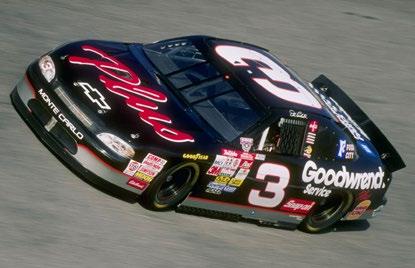
Those around him that memorable February afternoon had never see him more relaxed and upbeat than when he finally achieved his greatest personal accomplishment.
“Twenty years! Can you believe it? We won it! The Daytona 500 is ours! Every which way I could lose it, I’ve lost it. Now I’ve won it and I don’t car how I’ve won it. We won it,” Earnhardt said in a post-race interview that day.
49 PHOTOGRAPHY: GETTY IMAGES
HISTORICAL NASCAR FAST FACTS
 BY BEN WHITE
BY BEN WHITE
NASCAR FOUNDER BILL FRANCE AND THE NAME GRAND NATIONAL
After seeing the movie “National Velvet” starring Elizabeth Taylor in 1944, NASCAR founder Bill France adopted the Grand National label for his premier stock car series. The movie featured horse racing with Taylor competing for a victory in the Grand Nationals. The division is known today as the NASCAR Cup Series.
PETTY DID NOT WIN ALL 200 WITH NO. 43
Seven-time NASCAR Cup Series champion Richard Petty is known for driving the iconic No. 43 throughout his 32-year career. However, eight of Petty’s 200 victories came using different car numbers. The King won twice with No. 42 (1962 and 1966) and six times with No. 41, five in 1963 and once in 1964.
ROOKIE WINNERS IN THE CUP SERIES
Since 1972, rookie winners in the NASCAR Cup Series are: Earl Ross, Dale Earnhardt, Ron Bouchard, Morgan Shepherd, Davey Allison, Tony Stewart, Matt Kenseth, Dale Earnhardt Jr., Kevin Harvick, Jamie McMurray, Ryan Newman, Jimmie Johnson, Greg Biffle, Kyle Busch, Denny Hamlin, Juan Pablo Montoya, Joey Logano, Brad Keselowski, Trevor Bayne and Chris Buescher.
INDY CAR DREAMS
Drivers Tony Stewart, Jimmie Johnson, Jeff Gordon and Ricky Rudd set out to build
Indy Car careers before they came to NASCAR. Among them, only Stewart and Johnson have fulfilled that mission. Stewart was crowned the 1996 Indy car champion while Johnson is currently pursuing an Indy car career.
RICHARD PETTY TOLD NOT TO RACE
A week before winning the 1979 Daytona 500, Richard Petty had major stomach surgery and was told by his doctors that he should not race. The Randleman, North Carolina, native won his sixth of seven Daytona 500s when Cale Yarborough and Donnie Allison crashed on the final lap.
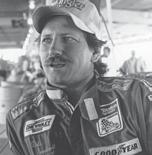
WING TIPS WERE BEST

Throughout a 35-year career, driver Dave Marcis chose to wear a Sunday wingtip shoe when he drove race cars in NASCAR competition. The Wausau, Wisconsin, native selected the shoe over others because of its hard sole that protected his feet from blistering due to hot floorboards in Cup Series race cars.

CALE YARBOROUGH LED ALL 500 LAPS
On March 25,1973, Cale Yarborough drove his Junior Johnson-prepared No. 11 Chevrolet to victory at Bristol Motor Speedway, leading the entire 500-lap race distance. The driver from Timmonsville, South Carolina, lapped the field by the 100th lap and was never contested for the win on the famed .533-mile Tennessee track.
DAYTONA’S FIRST BLACK FLAG


During the first practice session prior to the inaugural Daytona 500 on Feb. 22, 1959, driver Herman Beam received the track’s first black flag for going out to practice without his helmet. The Johnson City, Tennessee, native entered 194 NASCAR events from 1957 through 1963, scoring 57 top-10 finishes.
A PHENOMENAL SEASON
In 1973, three-time NASCAR champion David Pearson won 10 superspeedway races and one short-track event in only 18 Cup Series starts for Wood Brothers Racing that season. The Spartanburg, South Carolina, driver collected 43 of his 105-career victories, including the 1976 Daytona 500, with the Virginia-based team before his retirement in 1986.
JARRETT WINS BY A WIDE MARGIN
Two-time NASCAR champion Ned Jarrett, driver of the No. 11 Bowani Racing Ford, won the 1965 Southern 500 at Darlington Raceway by 14 laps, or 19.25 miles. The Conover, North Carolina, native saved his engine by turning it off in the turns and refiring it on the front and back straightaways.
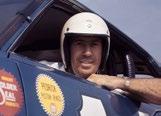
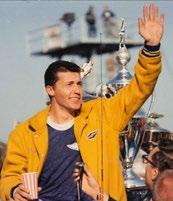
MAY DROVE FIVE CARS IN ONE RACE
NASCAR Cup Series driver Dick May drove five different race cars for five different owners, including himself, during the 1975 MasonDixon 500 at Dover International Speedway. With heat reaching nearly 100 degrees, May drove portions of the race in relief of four drivers as the race spanned nearly five hours.
50 PHOTOGRAPHY: GETTY IMAGES MILESTONE MOMENTS
TIM FLOCK AND HIS PASSENGER
APRIL 5, 1953
Two-time NASCAR champion Tim Flock came from a family of showmen who loved to perform in front of crowds at every possible chance. By the fifth race of the 1953 season, the reigning NASCAR Cup Series champion had a gimmick to help garner headlines everywhere he raced during the 37-race season.

Team owner Ted Chester was visiting a pet store in Atlanta when he came across a rhesus monkey, one of the smallest and most personable of all simians. A sign on the cage indicated his name was Jocko. Chester knew it was the thing to do when he mouthed the name “Jocko Flocko,” and figured it would be a great addition to have the monkey ride along with Flock in NASCAR races, complete with a custom-made helmet and uniform.
Chester owned the car and knew he would have little trouble convincing Flock to be part of the stunt. After all, his champion driver loved publicity.
Flock honestly thought his team owner had been hitting the liquor bottle once too often, especially since it had never been done. The driver did not ask NASCAR and instead, had a special seat made for his passenger. Jocko broke into NASCAR racing at the Charlotte Fairgrounds Speedway on April 5, 1953, riding co-pilot in

the No. 91 Hudson. They started from the pole position and led seven times for 87 laps but fell off the pace on lap 125 with engine problems.
The two traveled to Richmond, Virginia, on April 19 but did not start, followed by Macon, Georgia, on May 3 where they finished fifth. They continued to Columbia, South Carolina, and finished second; followed by Hickory, North Carolina, on May 16 where they celebrated the victory. Then it was on to Martinsville, Virginia, where they finished 32nd, Columbus, Ohio, and finished 22nd and Raleigh, North Carolina, on May 30 and finished third. That is where Jocko’s racing career came to an end.
“He thought it was time to check the right front tire so he unfastened his seat belt and went down to the trap door to take a look,” Flock said in his book, “Tim Flock – Race Driver,” published in May 1991. “Jocko pulled the chain, peered in the hole and got zinged by a small piece of debris right between the eyes.”
Jocko went wild, forcing Flock to visit pit road and drop him off for the very last time.
CONGRATULATIONS! CONGRATULATIONS! on Celebrating

LEARN MORE ai167336675831_2023 01 NASCAR anniversary.pdf 1 1/10/23 10:06 AM
NASCAR THROUGH THE YEARS


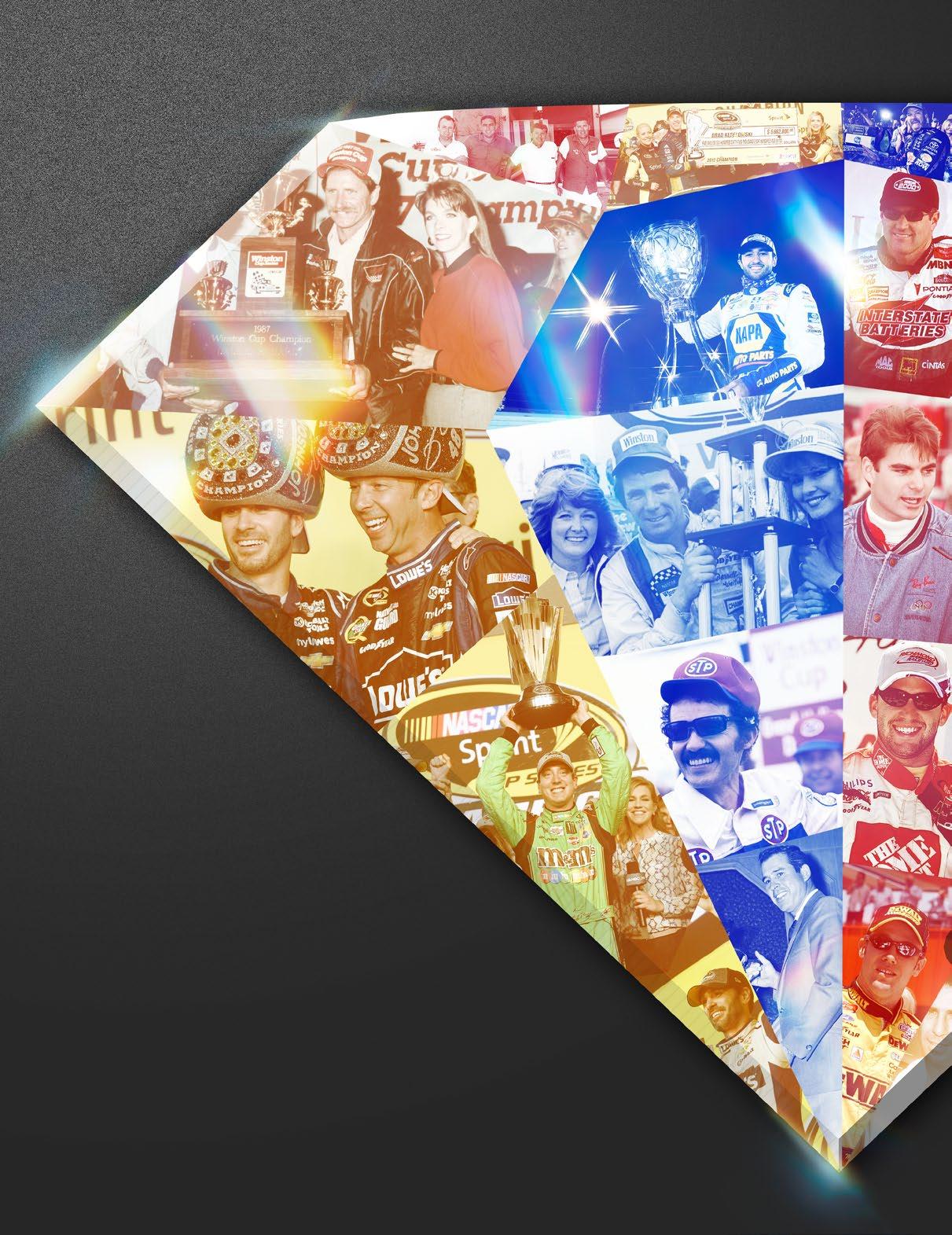 WRITTEN BY RACING HISTORIAN BEN WHITE
WRITTEN BY RACING HISTORIAN BEN WHITE



 EDITED BY KEITH WALTZ
EDITED BY KEITH WALTZ

52 THROUGH THE YEARS
Strictly Stock Title to Byron
In 1949, Red Byron and team owner Raymond Parks earned their spots in NASCAR history by logging two wins, four top-10 finishes and one pole position en route to the inaugural NASCAR Cup Series championship.

The 1949 season was the first for NASCAR’s Strictly Stock division, known today as the NASCAR Cup Series. Under the leadership of “Big” Bill France. the sanctioning body was incorporated on Feb. 21, 1948.
The inaugural season of eight races on tracks in five states began at a half-mile dirt oval in Charlotte, North Carolina. On June 19, 1949, 33 cars entered the 200-lap event with Glenn Dunaway, of Gastonia, North Carolina, initially flagged the winner. However, illegal rear leaf springs under his Ford gave secondplace finisher Jim Roper of Kansas the victory.
Red Byron topped series race No. 2 at the 4.1-mile Beach and Road Course in Daytona Beach, Florida, on July 10 over Tim Flock. Bob Flock, of Atlanta, won on the dirt oval in Hillsboro, North Carolina, on Aug. 7.
Curtis Turner tamed the field at Pennsylvania’s Langhorne Speedway on Sept. 11, while Jack White won in Hamburg, New York, on Sept. 18 and Byron notched his second victory in Martinsville, Virginia, on Sept. 25.
Lee Petty was victorious in Pittsburgh, Pennsylvania, on Oct. 2 while Bob Flock earned his second victory at North Wilkesboro Speedway to close the season on Oct. 16.
Byron was crowned champion over Petty by 122 points at race’s end. Finishing third was Bob Flock, followed by Bill Blair, Fonty Flock, Ray Erickson, Tim Flock, Dunaway and Frank Munday.
Byron only raced in nine additional Cup Series events through 1951. The Alabama native passed away on Nov. 11, 1960.
SEASON RECAP
DATE CIRCUIT WINNER
June 19 Charlotte Speedway Jim Roper
July 10 Daytona Beach and Road Course Red Byron
Aug. 7 Occoneechee Speedway Bob Flock
Sept. 11 Langhorne Speedway Curtis Turner
Sept. 18 Hamburg Speedway Jack White
Sept. 25 Martinsville Speedway Red Byron
Oct. 2 Heidelberg Speedway Lee Petty
Oct. 16 North Wilkesboro Speedway Bob Flock
NO. 1 SONG: “RIDERS IN THE SKY” BY VAUGHN MONROE
GALLON OF GAS: 27 CENTS PRESIDENT: HARRY S. TRUMAN
POP CULTURE: GEORGE ORWELL INTRODUCES HIS DYSTOPIAN NOVEL, “1984,” IN WHICH A FUTURE TOTALITARIAN STATE UTILIZES GOVERNMENT SURVEILLANCE TO VIOLATE THE CITIZENS’ FREEDOMS.
BEST DRIVER
RED BYRON, WHEELING AN OLDSMOBILE fielded by Atlanta businessman Raymond Parks, won two of the eight races en route to the inaugural championship in what is now known as the NASCAR Cup Series. An Alabama native, Byron suffered severe shrapnel wounds to his left leg during World War II, and his race car was modified so he could use his injured leg to operate the clutch. Lee Petty finished second in the standings with Bob Flock third.
BEST RACE
ON SEPT. 11, SOUTHERN MOONSHINERS
Curtis Turner, Bob Flock and Red Byron showed the northern spectators their driving skills on the circular dirt track in Langhorne, Pa. The trio led numerous times with Turner holding the point for 60 laps, followed by Flock with 52 and Byron with 15. In the end, Turner pulled away and collected the $2,250 first-place money. Lee Schmidt, of Milwaukee, Wis., also led 73 of the race’s 200 laps.
TOP CARS
CARRYING THE NO. 22, RED Byron’s 1949 Oldsmobile was the top car of the 1949 season with two wins and four top-10 results in six starts.
Driving the No. 42 car fielded by Petty Enterprises, Lee Petty’s 1949 Plymouth recorded five top-10 finishes, including a single victory.
53
1949
49
Rexford Wins Title in NASCAR’s Second Season
In February 1950, NASCAR launched the second season of its premier stock car racing series. The nomadic circuit showed incredible potential for growth as the debut of Darlington Raceway, the sport’s first paved superspeedway, foreshadowed the future.
NASCAR’s newly named Grand National division – dropping the Strictly Stock title – was attracting drivers in search of an adventure. NASCAR founder Bill France sanctioned 19 races as the organization’s premier series visited Florida, New York, Ohio, Pennsylvania, Indiana, North Carolina and Virginia. Seventeen of the races were on dirt tracks with the new paved superspeedway in Darlington, South Carolina, and the combination beach/road course in Daytona Beach, Florida, adding variety to the schedule.
Oldsmobiles won 10 of the 19 events with drivers Curtis Turner, Fireball Roberts, Bill Rexford, Dick Linder and Fonty Flock. Plymouth drivers Johnny Mantz, Leon Sales, Herb Thomas and Lee Petty joined Ford/Lincoln-Mercury pilots Bill Blair, Lloyd Moore, Harold Kite, Tim Flock and Bill Florian in Victory Lane.
Rexford, a virtual unknown from Western New York, began his championship quest with a victory at Ohio’s Canfield Motor Speedway on May 30 in an Oldsmobile owned by Julian Buesink. But the title fight came down to a battle between Rexford and Roberts over the final three races. Rexford led the standings after a sixth-place finish at the fairgrounds in Vernon, New York, on Oct. 1, a race Roberts did not enter. Following race No. 17, Roberts was back on top after finishing sixth at Virginia’s Martinsville Speedway, but Rexford ended up third on the same day at Winchester Speedway in Indiana and retook the point lead. Roberts’ blown engine in the final race at Occoneechee Speedway in Hillsboro, N.C., clinched the 1950 Grand National championship for the 23-yearold Rexford.
SEASON RECAP
DATE CIRCUIT WINNER
Feb. 5 Daytona Beach & Road Course Harold Kite
April 2 Charlotte Speedway Tim Flock
April 16 Langhorne Speedway Curtis Tuner
May 21 Martinsville Speedway Curtis Turner
May 30 Canfield Motor Speedway Bill Rexford
June 18 Vernon Fairgrounds Bill Blair
June 25 Dayton Speedway Jimmy Florian
July 2 Monroe County Fairgrounds Curtis Turner
July 23 Charlotte Speedway Curtis Turner
Aug. 13 Occoneechee Speedway Fireball Roberts
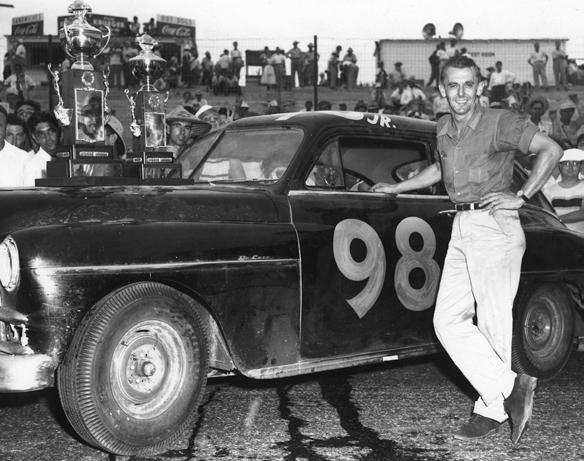
Aug. 20 Dayton Speedway Dick Linder
Aug. 27 Hamburg Speedway Dick Linder
Sept. 4 Darlington Raceway Johnny Mantz
Sept. 17 Langhorne Speedway Fonty Flock
Sept. 24 North Wilkesboro Speedway Leon Sales
Oct. 1 Vernon Fairgrounds Dick Linder
Oct. 15 Martinsville Speedway Herb Thomas
Oct. 15 Funk’s Speedway Lloyd Moore
Oct. 29 Occoneechee Speedway Lee Petty
TOP CARS
GLENN “FIREBALL” ROBERTS, of Palatka, Florida, wheeled Sam Rice’s Oldsmobile to one victory and five top-10 finishes in nine series starts.
PRESIDENT: HARRY S TRUMAN NO. 1 SONG: “GOODNIGHT, IRENE” BY GORDON JENKINS
TOP NEWS: JAN. 17: THE GREAT BRINKS ROBBERY IN BOSTON JUNE 16: “FATHER OF THE BRIDE” RELEASED AUG. 5: FLORENCE CHADWICK SWIMS

BEST DRIVER
DRIVING THE NO. 41
Oldsmobile owned by John Eanes, Curtis Turner scored four wins in 16 starts. He visited Victory Lane at Langhorne (Pa.) Speedway, Martinsville (Va.) Speedway, the Monroe County Fairgrounds in Rochester, New York, and Charlotte (N.C.) Speedway en route to a fifth-place finish in the championship standings. The native of Floyd, Virginia, recorded 10 top-10 results with an average start of 5.2 and an average finish of 14.7.
BEST RACE

JOHNNY MANTZ, winner of the inaugural Southern 500 at South Carolina’s Darlington Raceway on Sept. 4, 1950, became a NASCAR star with only one career victory. The native of Long Beach, California, used hard truck tires, similar to those seen in Indy car racing, and led 351 of 400 laps as he capitalized on the heavy attrition. Mantz gained the lead at lap 50 and never looked back. He participated in only 12 NASCAR premier series events through 1956.

54 THROUGH THE YEARS
THE ENGLISH CHANNEL
1950
50
Thomas Tough in Title Fight
During NASCAR’s third Cup Series season, Herb Thomas was crowned champion after recording seven victories and 19 top-10 finishes in 34 starts. Thomas drove the No. 92 Fabulous Hudson Hornet entered by car owner Ted Chester of Atlanta.

In 1951, sports fans across the country enjoyed professional baseball, football and basketball, with stock car racing steadily gaining a foothold in the South. Other racing organizations came and went as NASCAR emerged from the pack, partly because fearless mountain moonshiners were becoming its stars.
The sport was expanding its footprint but “Big” Bill France, NASCAR’s founder, wanted more, securing six events on the West Coast. France even added some star power by enticing Bill Holland, the 1949 Indianapolis 500 winner, to join the fray.
Holland was set to drive the same No. 98 Plymouth Johnny Mantz had used to win the inaugural Southern 500 at South Carolina’s Darlington Raceway a year earlier in seven races but flipped the car at Charlotte Speedway on April 1. Instead, Holland drove in five remaining races for Hugh Westmoreland and Cal Connell.
Thanks to the efforts of fellow driver Marshall Teague, Thomas was quite successful in the Fabulous Hudson Hornet. It was Teague who explained to Hudson’s executives the benefits of winning in front of thousands of fans on the 41-race schedule. Teague was not only a driver but also an auto racing adviser to the automaker.
Thomas won NASCAR’s premier championship over the Flock brothers, Fonty and Tim, who ended up second and third.
SEASON RECAP
DATE CIRCUIT WINNER
Feb. 11 Daytona Beach and Road Course Marshall Teague
April 1 Charlotte Speedway Curtis Turner
April 8 Lakeview Speedway Tim Flock
April 8 Carrell Speedway Marshall Teague
April 15 Occoneechee Speedway Fonty Flock
April 22 Arizona State Fairgrounds Marshall Teague
April 29 North Wilkesboro Speedway Fonty Flock
May 6 Martinsville Speedway Curtis Turner
May 30 Canfield Fairgrounds Marshall Teague
June 10 Columbus Speedway Tim Flock
June 16 Columbia Speedway Frank Mundy
June 24 Dayton Speedway Curtis Turner
June 30 Carrell Speedway Lou Figaro
July 1 Grand River Speedrome Marshall Teague
July 8 Bainbridge Speedway Fonty Flock
July 15 Heidelberg Speedway Herb Thomas
July 29 Asheville-Weaverville Speedway Fonty Flock
July 31 Monroe County Fairgrounds Lee Petty
Aug. 1 Altamont Speedway Fonty Flock
Aug. 12 Michigan Fairgrounds Tommy Thompson
Aug. 19 Fort Miami Speedway Tim Flock
Aug. 24 Morristown Speedway Tim Flock
Aug. 25 Greenville-Pickens Speedway Bob Flock
Sept. 3 Darlington Raceway Herb Thomas
Sept. 7 Columbia Speedway Tim Flock
Sept. 8 Central City Speedway Herb Thomas
Sept. 15 Langhorne Speedway Herb Thomas
Sept. 23 Charlotte Speedway Herb Thomas
Sept. 23 Dayton Speedway Fonty Flock
Sept. 30 Wilson County Speedway Fonty Flock
Oct. 7 Occoneechee Speedway Herb Thomas
Oct. 12 Thompson Speedway Neil Cole
Oct. 14 Martinsville Speedway Frank Mundy
Oct. 14 Pine Grove Speedway Tim Flock
Oct. 14 Oakland Stadium Marvin Burke
Oct. 21 North Wilkesboro Speedway Fonty Flock
Oct. 28 Hanford Motor Speedway Danny Weinberg
Nov. 4 Jacksonville Speedway Herb Thomas
Nov. 11 Lakewood Speedway Tim Flock
Nov. 11 Carrell Speedway Bill Norton
Nov. 25 Lakeview Speedway Frank Munday
TOP MOVIES: AMERICAN IN PARIS AND THE AFRICAN QUEEN GALLON OF GAS: 27 CENTS
POP CULTURE: THE POPULAR “I LOVE LUCY” TV SHOW DEBUTED ON CBS
BEST DRIVER
FONTY FLOCK, DRIVER OF THE NO.
14 Oldsmobile fielded by Frank Christian, won eight races in 1951, the most of any driver. He logged 22 top-10 finishes but failed to finish nine times – four due to crashes and five due to mechanical issues. Without the DNFs, Flock could have challenged Herb Thomas for the title. Instead, the native of Decatur, Georgia, settled for second in points, the best of his nine-year career.
BEST RACE
ON AUG. 12, TOMMY THOMPSON WON the inaugural Motor City 250 at the Detroit Fairgrounds. Fifty-nine cars took the green flag in a race that turned out to be a demolition derby. Thompson battled with veteran Curtis Turner in the closing 25 miles, but both spun, giving the lead to Joe Eubanks. Thompson and Turner returned to action, caught Eubanks and passed him. Overheating KO’d Turner while Thompson won in front of 16,400 fans.
TOP CARS
HERB THOMAS’ NO 92
Fabulous Hudson Hornet won seven times in 1951, while recording 19 top-10 finishes and earning four poles.
Fonty Flock’ s No. 14
Oldsmobile owned by Frank Christian recorded eight wins, 22 top-10 results and 14 pole positions.
55
PRESIDENT: HARRY S. TRUMAN NO. 1 SONG: “TOO YOUNG” BY NAT KING COLE
1951
51
Flock Hustles Hudson to Crown
Tim Flock logged eight wins and 25 top-10 finishes in 33 starts on his way to securing the 1952 NASCAR Cup Series championship. He drove a Hudson Hornet entered by car owner Ted Chester of Atlanta.
Among automotive manufacturers, the Hudson Hornet was by far the most dominant car throughout the 1952 season, winning 27 of the 34 races. Its center of gravity and center point steering system contributed heavily to the car’s success.
Tim Flock won the season opener at Florida’s Palm Beach Speedway, but it was the second race of the season that proved to be the most popular, as an estimated 20,000 spectators saw Marshall Teague win on the 4.1-mile Beach and Road Course in Daytona Beach, Florida.
Sixty-one cars started the crash-filled event with only 10 running at the finish. The race ended on lap 37 (cut by 11 laps) when it was halted due to the high tide.
Another major event came in June at the Michigan Fairgrounds when the second Motor City 250 was run on a one-mile dirt oval that was built in 1899. Before the race, NASCAR offered its first fivefigure purse at $11,675, which equates to $112,831 in today’s dollars.
Another highlight came on Sept. 1, at South Carolina’s Darlington Raceway with the running of the prestigious Southern 500. It was the 25th race of the season and winner Fonty Flack took more than six hours to complete the 500-mile distance.
Herb Thomas won the final race of the year in West Palm Beach, Florida, on Nov. 30 but was still 104 points behind Tim Flock in the championship chase. Flock finished 12th that day after flipping on the 164th lap.
SEASON RECAP
DATE CIRCUIT WINNER
Jan. 20 Palm Beach Speedway
Tim Flock
Feb. 10 Daytona Beach and Road Course Marshall Teague
March 6 Speedway Park
Marshall Teague
March 30 North Wilkesboro Speedway Herb Thomas
April 6 Martinsville Speedway Dick Rathmann
April 12 Columbia Speedway Buck Baker
April. 20 Lakewood Speedway Bill Blair
April 27 Central City Speedway Herb Thomas
May 4 Langhorne Speedway Dick Rathmann
May 10 Darlington Raceway Dick Rathmann
May 18 Dayton Speedway Dick Rathmann
May 30 Canfield Fairgrounds Herb Thomas
June 1 Fort Miami Speedway Tim Flock
June 1 Hayloft Speedway Gober Sosebee
June 8 Occoneechee Speedway Tim Flock
June 15 Charlotte Speedway Herb Thomas
June 29 Michigan Fairgrounds Tim Flock
July 1 Stamford Park Speedway Buddy Shuman
July 4 Shangri-La Speedway Tim Flock
July 6 Monroe Speedway Tim Flock
July 11 Morristown Speedway Lee Petty
July 20 Playland Park Speedway Tim Flock
Aug. 15 Monroe County Fairgrounds Tim Flock
Aug. 17 Asheville-Weaverville Speedway Bob Flock
Sept. 1 Darlington Raceway Fonty Flock
Sept. 7 Central City Speedway Lee Petty
Sept. 14 Langhorne Speedway Lee Petty
Sept. 21 Dayton Speedway Dick Rathmann
Sept. 28 Wilson County Speedway Herb Thomas
Oct. 12 Occoneechee Speedway Fonty Flock
Oct. 19 Martinsville Speedway Herb Thomas
Oct. 26 North Wilkesboro Speedway Herb Thomas
Nov. 16 Lakewood Speedway Donald Thomas
Nov. 30 Palm Beach Speedway Herb Thomas
PRESIDENT: HARRY S TRUMAN NO. 1 SONG: “BLUE TANGO” BY LEROY ANDERSON


TOP MOVIES: SINGIN’ IN THE RAIN AND HIGH NOON GALLON OF GAS: 27 CENTS
POP CULTURE: “THE TODAY SHOW” FIRST AIRED ON NBC
BEST DRIVER
TIM FLOCK, DRIVING A HUDSON
Hornet fielded by Ted Chester, tied championship rival Herb Thomas with eight victories during the season. However, the Atlanta native didn’t let anything stop him from claiming the title. All he had to do to earn the crown was to start the season finale but still, on lap 164, Flock flipped his car. Uninjured, Flock said, “I bet I’m the only guy who ever won a championship while in his head.”
BEST RACE
FONTY FLOCK, DRIVER OF THE NO. 14 Oldsmobile, won the biggest race of his career when he topped the Southern 500 at Darlington Raceway in South Carolina. Flock started from the pole and led 321 of the 367 laps after making only three pit stops during the race. Johnny Patterson finished second followed by Hern Thomas, Bob King and Banjo Matthews.
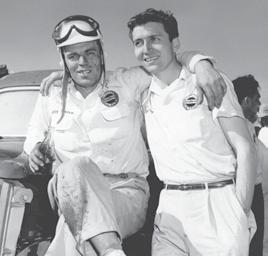
TOP CARS
TIM FLOCK’S NO. 91
Fabulous Hudson Hornet recorded eight wins, 25 top-10 finishes and claimed four poles in 33 starts.
Herb Thomas’ No 92
Fabulous Hudson Hornet also claimed eight victories with 22 top-10 results in 32 appearances.
56 THROUGH THE YEARS
1952 52
Thomas First Repeat Champ
During NASCAR’s fifth Cup Series season, Herb Thomas continued his winning ways and was crowned champion for a second time following 12 wins and 31 top10 results while driving his own Hudson Hornet.
Following a remarkable NASCAR season in 1952, fans across the nation were ready for another outstanding year of racing that spanned from Feb. 1 in West Palm Beach, Florida, to Nov. 1 in Atlanta. Nine of the 37 races that season were standalone events that took drivers as far away as Nebraska and South Dakota.
Thomas’ dominant performance throughout the season was no match for those who challenged him. His dozen wins were far greater than the five each logged by Lee Petty and Dick Rathmann, followed by four each by Buck Baker and Fonty Flock.
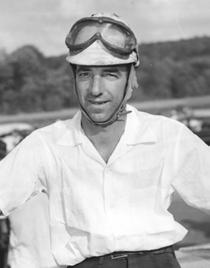
Thomas and crew chief Smokey Yunick were magical, as consistency proved to be the foundation for their championship season. Once again, the Hudson Hornet was dominant, winning 22 of 37 races including a stretch of 16 out of 20.
The one-mile Raleigh Speedway in North Carolina joined the NASCAR Cup Series schedule in 1953. A race was run on May 30, the same day as the Indianapolis 500, and was won by Fonty Flock in front of a crowd of 15,235 spectators.
The Raleigh track was billed as “a one-mile super-fast track” in newspaper ads and one that fit the rising speeds NASCAR’s engine builders were beginning to generate.
Also, NASCAR and Pennsylvania’s Langhorne Speedway joined forces to promote the International Stock Car Grand Prix, a 200mile race open to foreign and domestic cars. Dick Rathmann won the race in a Hudson Hornet with Cup Series cars sweeping the top-five positions.
SEASON RECAP
DATE CIRCUIT WINNER
Feb. 1 Palm Beach Speedway Lee Petty
Feb. 15 Daytona Beach and Road Course Bill Blair
March 8 Harnett Speedway Herb Thomas
March 29 North Wilkesboro Speedway Herb Thomas
April 5 Charlotte Speedway Dick Passwater
April 19 Richmond Raceway Lee Petty
April 26 Central City Raceway Dick Rathmann
May 3 Langhorne Speedway Buck Baker
May 9 Columbia Speedway Buck Baker
May 16 Hickory Speedway Tim Flock
May 17 Martinsville Speedway Lee Petty
May 24 Powell Motor Speedway Herb Thomas
May 30 Raleigh Speedway Fonty Flock
June 7 Louisiana Fairgrounds Lee Petty
June 14 Five Flags Speedway Herb Thomas
June 21 Langhorne Speedway Dick Rathmann
June 26 Tri-City Speedway Herb Thomas
June 28 Wilson Speedway Fonty Flock
July 3 Monroe County Speedway Herb Thomas
July 4 Piedmont Interstate Fairgrounds Lee Petty
July 10 Morristown Raceway Dick Rathmann
July 12 Lakewood Speedway Herb Thomas
July 22 Rapid Valley Speedway Herb Thomas
July 26 Lincoln City Fairgrounds Dick Rathmann
Aug. 2 Davenport Speedway Herb Thomas
Aug. 9 Occoneechee Speedway Curtis Turner
Aug. 16 Asheville-Weaverville Speedway Fonty Flock
Aug. 23 Princess Anne Speedway Herb Thomas
Aug. 29 Hickory Speedway Fonty Flock
Sept. 7 Darlington Raceway Buck Baker
Sept.13 Central City Speedway Speedy Thompson
Sept. 20 Langhorne Speedway Dick Rathmann
Oct. 3 Bloomsburg Fairgrounds Herb Thomas
Oct. 4 Wilson Speedway Herb Thomas
Oct. 11 North Wilkesboro Speedway Speedy Thompson
Oct. 13 Martinsville Speedway Jim Paschal
Nov. 1 Lakewood Speedway Buck Baker
PRESIDENT: DWIGHT D. EISENHOWER NO. 1 SONG: “FIVE LONG YEARS” BY EDDIE BOYD NO. 1 BOX OFFICE: THE NAKED SPUR GALLON OF GAS: 27 CENTS
POP CULTURE: HANK WILLIAMS, ONE OF THE MOST SIGNIFICANT MUSIC ARTISTS OF ALL TIME, SUFFERED A FATAL HEART
BEST DRIVER
HERB THOMAS, DRIVER OF A HUDSON HORNET fielded by himself and crew chief Smokey Yunick, won double the races than any other driver in 1953. No matter where Thomas raced, he was considered the favorite to win. His car always seemed to be the class of the field, especially since it was an ultracompetitive Hudson and the fact it carried a very durable engine built by Yunick. The 1953 season was considered the best of Thomas’ 10-year career.
BEST RACE
ON SEPT. 1,1953, BUCK BAKER SURVIVED A wreck fest as he led 35 laps en route to winning the Southern 500 at South Carolina’s Darlington Raceway. The third running of the race featured 59 starters with many spins, but only four caution flags for 17 laps. There were several frightening crashes, including driver Mike Magill going through a gap in the retaining wall and crashing his Lincoln into the parking lot. Baker took the lead with 10 laps remaining.
TOP CARS
HERB THOMAS WHEELED his own No. 91 Fabulous Hudson Hornet to 12 victories with 31 top-10 finishes and 12 pole positions.
Lee Petty, driver of the No. 42 Petty Enterprises Oldsmobile, logged five wins in 36 starts with 31 top-10 results.
57
1953
ATTACK ON JAN. 1.
53
Lee Petty Wins 1st Title
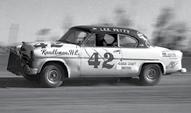
In only its sixth season as a sanctioning body, NASCAR saw many drivers struggle to find a place in the sport. Some had difficulty with various rule changes and stepped away at times during the season. That left the door open for Petty and Thomas to shine and they logged seven and 12 wins, respectively, during the eight-month season.
Petty fell shy of Thomas by five in the win column. Still, his 24 top-five finishes and 32 top-10 results paved the way to his first of three NASCAR Cup Series championships. Petty ended up with a 283-point advantage over Thomas when the season ended at North Carolina’s North Wilkesboro Speedway on Oct. 24 Thomas, the 1951 and 1953 champion, logged 19 top-five results and 27 top-10 finishes in 34 starts, but he was running at the finish in only 24 races. Thomas’ biggest victory of the season came in the Southern 500 at South Carolina’s Darlington Raceway.
Petty’s most significant triumph of 1954 was in the 160-lap season-opening event on the beach and road course in Daytona Beach, Florida. It came after apparent winner Tim Flock was disqualified for an illegal carburetor.
On June 13, NASCAR sanctioned its first road course event on the airport tarmac in Linden, New Jersey, with Al Keller winning the race in a Jaguar.
Interestingly, Buck Baker, Dick Rathmann, Hershel McGriff, Keller, Jim Paschal, Curtis Turner, Gober Sosbee, John Soares and Danny Letner all enjoyed at least one victory each over the course of the season.
PRESIDENT: DWIGHT D. EISENHOWER
SEASON RECAP
DATE CIRCUIT WINNER
February 7 Palm Beach Speedway
February 21
Beach and Road Course
March 7 Jacksonville Speedway Park
March 21
March 28
March 28
Speedway
April 4 North Wilkesboro Speedway
April 18 Orange Speedway
Thomas
Thomas
Thomas
Rathmann
Rathmann
Thomas
April 25 Central City Speedway Gober Sosebee
May 2 Langhorne Speedway
May 9 Wilson Speedway
May 16 Martinsville Speedway
May 23 Sharon Speedway
May 29 Raleigh Speedway
May 30 Charlotte Speedway
May 30 Carrell Speedway
Thomas
Baker
Paschal
Petty
Thomas
Baker
Soares
June 6 Columbia Speedway Curtis Turner
June 13 Linden Airport
June 17 Williams Grove Speedway
Keller
Thomas
June 19 Hickory Speedway Herb Thomas
June 25 Monroe County Fairgrounds Lee Petty
July 3 Piedmont Interstate Fairgrounds
Thomas
July 4 Asheville-Weaver Speedway Herb Thomas
July 10 Santa Fe Speedway Dick Rathmann
July 11 Grand River Speedrome Lee Petty
July 30 Morristown Speedway Buck Baker
August 1 Oakland Stadium
August 13 Charlotte Speedway
August 22 Bay Meadows Speedway
August 29 Corbin Speedway
September 6 Darlington Raceway
Letner
Petty
McGriff
Petty
Thomas
September 12 Central City Speedway Hershel McGriff
September 24 Charlotte Speedway Hershel McGriff
September 26 Langhorne Speedway Herb Thomas
October 10 Memphis-Arkansas Speedway Buck Baker
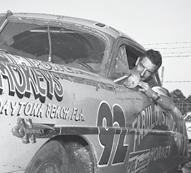
October 17 Martinsville Speedway Lee Petty
October 24 North Wilkesboro Speedway Hershel McGriff
NO. 1 SONG: “LITTLE THINGS MEAN A LOT” BY KITTY KALLEN


NO. 1 BOX OFFICE: ON THE WATERFRONT
BEST DRIVER
DRIVING HIS OWN PETTY ENGINEERING
Oldsmobile, Lee Petty relied on consistency at the front of the field to score seven victories and his first-career NASCAR championship. The Level Cross, North Carolina, native is known as the first NASCAR driver to rely on racing alone as his livelihood. He kept his cars clean and away from crashes on the track to keep repairs down. His smooth driving style kept him in contention throughout the 37-race season.
BEST RACE
AT GEORGIA’S LAKEWOOD SPEEDWAY on March 21, 1954, Herb Thomas edged Buck Baker and Dick Rathmann in a threewide photo finish. Thomas and Baker were eventually put a lap down for not falling to the rear of the field after pitting under caution. Rathmann was penalized for receiving fuel while on the race track. When many more drivers were found in violation of the rules, NASCAR officials dropped all penalties and declared Thomas the winner.
TOP CARS
LEE PETTY’S 1954 PETTY
Engineering No. 42
Oldsmobile 88 won seven series races as Petty claimed his first NASCAR championship.
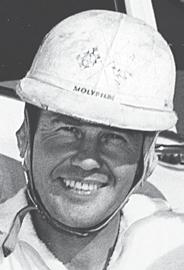
Herb Thomas’ 1954 Smokey
Yunick-owned No. 92 Hudson
Hornet topped 12 races with Thomas finishing second in the point standings.
58 THROUGH THE YEARS
Lee Petty and Herb Thomas, two of NASCAR’s early stars, proved they were the top championship contenders of the 1954 Cup Series season, winning a combined 19 of 37 races.
Herb
Daytona
Lee
Petty
Herb
Herb
Lakewood Speedway
Oglethorpe
Al
Keller
Dick
Oakland Speedway
Dick
Herb
Herb
Buck
Jim
Lee
Herb
Buck
John
Al
Herb
Herb
Danny
Lee
Hershel
Lee
Herb
54
1954
Flock Flies to 18 Wins
In 1955, Atlanta native Tim Flock held steady in one of Carl Kiekhaefer’s Chrysler 300s en route to 18 victories and his second NASCAR Cup Series championship.

Flock completed his seventh NASCAR season that year with the one of the most prominent teams on the circuit. Kiekhaefer, a boat engine manufacturer from Wisconsin, tried his hand at creating a top NASCAR organization. Going into the season, several drivers were hired to wheel his Chryslers, putting top-of-the-line cars and equipment with top drivers. Kiekhaefer was extremely determined to win and knew he had a strong chance with Flock behind the wheel of one his cars.
That year, Flock’s brothers, Fonty and Bob, also wheeled cars out of Kiekhaefer’s stable. It was older brother Tim who proved to have the most successful season.
Flock’s first victory of the season came on the Road and Beach Course in Daytona Beach, Florida, on Feb.27. From there, Flock often began a string of short-track victories that were preceded by 18 pole positions.
His wins came in such places as Rochester, New York; Charlotte, North Carolina; Syracuse, New York; Spartanburg, South Carolina; Weaverville, North Carolina; Morristown, New Jersey; and Langhorne, Pennsylvania, to name only a few.
All told, Flock logged 33 top-10 finishes with an amazing 3.2 average start and a 4.6 average finish. On the other end of the spectrum, Flock’s Chrysler fell out of five events with mechanical issues and did not finish.
Flock ended his season with a victory at Hillsboro Speedway on Oct. 30 and clinched his second NASCAR title. His first championship came while driving a Hudson for team owner Ted Chester in 1952.
SEASON RECAP
DATE CIRCUIT WINNER
Nov. 7 Tri-City Speedway
Feb. 6 Palm Beach Speedway
Feb. 13 Speedway
Feb. 24
March 6
Beach & Road Course
March 26 Columbia Speedway
March 27 Hillsboro Speedway
April 3 North Wilkesboro Speedway
April 17 Montgomery Motor Speedway
April 24
May 1 Charlotte Speedway
May 7 Hickory Speedway
May 8 Fairgrounds Raceway
May 15
Rodeo Grounds
May 15 Martinsville Speedway
May 22 Richmond Raceway
May 28 State Fairgrounds Speedway
May 29 Forsyth County Fairgrounds
June 10 Lincoln Speedway
June 17 Monroe County Fairgrounds
Paschal
Baker
Flock
Flock
Baker
Johnson
Flock
Letner
Flock
Flock
Johnson
Petty
Johnson
Flock
June 18 Fonda Speedway Junior Johnson
June 19 Airborne Speedway
June 24 Southern States Fairgrounds
Petty
Flock
July 6 Piedmont Interstate Fairgrounds Tim Flock
July 9 Columbia Speedway
July 10 Asheville-Weaverville Speedway
July 15 Morristown Speedway
July 29 Altamont-Schenectady Speedway
July 30 New York State Fairgrounds
July 31 Meadows Race Track
Aug. 5 Southern States Fairgrounds
Aug. 7 Forsyth County Fairgrounds
Paschal
Flock
Flock
Johnson
Flock
Flock
Paschal
Petty
Aug. 14 Memphis-Arkansas Speedway Fonty Flock
Aug. 20 Raleigh Speedway
Thomas
Sept. 9 Darlington Raceway Herb Thomas
Sept. 11 Montgomery Speedway Tim Flock
Sept. 18 Langhorne Speedway Tim Flock
Sept. 30 Raleigh Speedway Fonty Flock
Oct. 6 Greenville-Pickens Speedway Tim Flock
Oct. 9 Memphis-Arkansas Speedway Speedy Thompson
Oct. 15 Columbia Speedway Tim Flock
Oct. 16 Martinsville Speedway Speedy Thompson
Oct. 16 Las Vegas Speedway Park Norm Nelson
Oct. 23 North Wilkesboro Speedway Buck Baker
Oct. 30 Orange Speedway Tim Flock
POP CULTURE: “THE MICKEY MOUSE CLUB” DEBUTS GALLON OF GAS: 29¢
BEST DRIVER
DRIVING A WHITE CHRYSLER OWNED BY CARL KIEKHAEFER, FORMER
Charlotte city bus driver Buck Baker went to Victory Lane 14 times in 1956. Baker also accumulated 39 top-10 results in 48 starts that season. He was the class of the field at every track where he raced and was clearly the fan favorite. Baker claimed the championship by 586 points over former teammate Thomas, who did not compete in the final three races.
BEST RACE
ON SEPT. 3, CURTIS TURNER FINALLY WON THE SOUTHERN 500 after eight seasons of entering the prestigious event at South Carolina’s Darlington Raceway. Turner passed Marvin Panch on lap 202 of the 1.375mile oval and never looked back. Turner led four times for a total of 255 of 364 laps. Seventy cars started the race with Turner lining up in the 11th position. Buck Baker earned the pole with a speed of 119.659 mph.
59
1955 55
PRESIDENT: DWIGHT D. EISENHOWER NO. 1 IN THE BOX OFFICE: LADY AND THE TRAMP NO. 1 SONG: “CHERRY PINK AND APPLE BLOSSOM WHITE” BY PEREZ PRADO
Lee
Petty
Herb
Thomas
Lee
Park
Petty
Daytona
Tim
Flock
Lee
Oglethorpe Speedway
Petty
Fonty Flock
Jim
Buck
Tim
Tim
Langhorne Speedway
Buck
Junior
Tim
Tucson
Danny
Tim
Tim
Junior
Lee
Junior
Tim
Lee
Tim
Jim
Tim
Tim
Junior
Tim
Tim
Jim
Lee
Herb
Kiekhaefer’s Chryslers Dominate
Buck Baker and Herb Thomas proved best throughout the 1956 NASCAR Cup Series season, collecting a combined 19 victories during the 56-race schedule. Both drivers were title contenders throughout the year.
Businessman Carl Kiekhaefer came into NASCAR in 1955 with quite a bit of money and plenty of resources. Veteran driver Tim Flock easily won the Cup Series title in one of his cars.
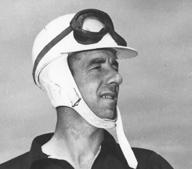
The pressure of driving for Kiekhaefer, however, caused Flock to suffer stomach ulcers. He quit the team 10 races into the 1956 schedule, prompting Kiekhaefer to hire Thomas as his replacement. The updated racing stable now included cars for Baker, Thomas and Alfred “Speedy” Thompson.
Today, historians compare Kiekhaefer’s operation to a large factory effort while at the time all other teams were fielded out of backyard garages. No one could compete with such wealth and status.
Baker won the 1956 Cup Series championship with Thomas finishing second and Thompson third. Thomas left the Kiekhaefer operation in July because of being sent out west to race.
On Oct. 23 at the Cleveland County Fairgrounds in Shelby, North Carolina, Thomas was badly injured in a crash while driving his own Chevrolet. Thomas was leading the points when he was sent into the guardrail by contact from Thompson’s car.
Thomas was gravely injured while Baker went on to win the race. Thompson and Baker were accused of teaming up on Thomas. Baker was eventually cleared, but Thompson was given the wrath of the fans.
Jack Smith, Thompson and Baker won the final three races with Baker claiming the Cup Series title. Kiekhaefer’s cars won 30 of the 56 races, including the final five.
Thomas recovered from his injuries during the offseason.
SEASON RECAP
July
Aug.
Aug.
Aug.
Aug.
Aug.
Aug.
Aug.
Aug.
Sept.
Sept.
Sept.
Sept.
Sept.
Sept.
Sept.
Oct.
Speedway Fireball Roberts
Oct. 17 Charlotte Speedway Buck Baker
Oct. 23 Cleveland County Speedway Buck Baker
Oct. 28 Martinsville Speedway Jack Smith
Nov. 11 Hickory Speedway Speedy Thompson
Nov. 18 Wilson Speedway Buck Baker
PRESIDENT: DWIGHT D. EISENHOWER NO. 1 SONG: “HEARTBREAK HOTEL” BY ELVIS PRESLEY


NO. 1 BOX OFFICE: THE TEN COMMANDMENTS GALLON OF GAS: 30 CENTS
POP CULTURE: PRESIDENT DWIGHT EISENHOWER SIGNS THE FEDERAL AID HIGHWAY ACT, CREATING THE INTERSTATE HIGHWAY SYSTEM
BEST DRIVER
DRIVING A WHITE CHRYSLER OWNED BY CARL Kiekhaefer, former Charlotte city bus driver Buck Baker went to Victory Lane 14 times in 1956. Baker also accumulated 39 top-10 results in 48 starts that season. He was the class of the field at every track where he raced and was clearly the fan favorite. Baker claimed the championship by 586 points over former teammate Thomas, who did not compete in the final three races.
BEST RACE
ON SEPT. 3, CURTIS TURNER FINALLY WON THE Southern 500 after eight seasons of entering the prestigious event at South Carolina’s Darlington Raceway. Turner passed Marvin Panch on lap 202 of the 1.375-mile oval and never looked back. Turner led four times for a total of 255 of 364 laps. Seventy cars started the race with Turner lining up in the 11th position. Buck Baker earned the pole with a speed of 119.659 mph.
TOP CARS
BUCK BAKER’S KIEKHAEFER
Chrysler won 14 times in 48 starts to claim the 1956 NASCAR Cup Series championship.
Speedy Thompson’s Kiekhaefer
Chrysler topped eight races with 29 top-10 results en route to third in the standings.
60 THROUGH THE YEARS 56
DATE CIRCUIT WINNER Nov. 13 Hickory Speedway Tim Flock Nov. 20 Charlotte Speedway Fonty Flock Nov. 20 Willow Springs Speedway Chuck Stevenson
11 West Palm Beach Speedway Herb Thomas Jan. 22 Arizona State Fairgrounds Buck Baker
26 Daytona Beach and Road Course Tim Flock
4 West Palm Beach Speedway Billy Myers
18 Wilson Speedway Herb Thomas March 25 Lakewood Speedway Buck Baker
8 North Wilkesboro Speedway Tim Flock
22 Langhorne Speedway Buck Baker
29 Richmond Raceway Buck Baker May 5 Columbia Speedway Speedy Thompson May 6 Harris Speedway Speedy Thompson May 10 Greenville-Pickens Speedway Buck Baker
12 Hickory Speedway Speedy Thompson May 13 Orange Speedway Buck Baker May 20 Martinsville Speedway Buck Baker May 25 Lincoln Speedway Buck Baker May 27 Charlotte Speedway Speedy Thompson May 27 Portland Speedway Herb Thomas May 30 Redwood Speedway Herb Thomas May 30 New York State Fairgrounds Buck Baker June 3 Merced Fairgrounds Herb Thomas
10 Memphis-Arkansas Speedway Ralph Moody
15 Southern States Fairgrounds Speedy Thompson June 22 Monroe Fairgrounds Speedy Thompson June 24 Portland Speedway John Kieper
1 Asheville-Weaverville Speedway Lee Petty
4 Raleigh Speedway Fireball Roberts
7 Piedmont Interstate Fairgrounds Lee Petty
8 Sacramento Fairgrounds Lloyd Dane
21 Soldier Field Fireball Roberts
27 Cleveland County Fair Speedy Thompson
Dec.
Feb.
March
March
April
April
April
May
June
June
July
July
July
July
July
July
29 Montgomery Speedway Mavin Panch
3 Oklahoma State Fairgrounds Jim Paschal
12 Road America Tim Flock
17 Old Bridge Stadium Ralph Moody
19 Bay Meadows Race Course Eddie Pagan
22 Norfolk Speedway Billy Myers
23 Piedmont Interstate Fairgrounds Ralph Moody
25 Coastal Speedway Fireball Roberts
26 Portland Speedway Royce Haggerty
3 Darlington Raceway Curtis Turner
9 Chisholm Speedway Buck Baker
12 Southern States Fairgrounds Ralph Moody
23 Langhorne Speedway Paul Goldsmith
23 Portland Speedway Lloyd Dane
29 Columbia Speedway Buck Baker
30 Orange Speedway Fireball Roberts
7 Tennessee-Carolina
1956
Baker and Panch Dominate
The 1957 NASCAR premier series season saw a very popular former-bus-driverturned-racer from Charlotte, North Carolina, successfully defend his title as Buck Baker – driving his own car – battled the factory teams for the championship.
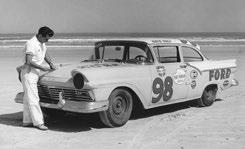
The 1957 Monster Energy NASCAR Cup Series season consisted of 53 races on tracks both dirt and paved. Thirty-eight races were held on dirt, 10 on paved surfaces and five on road courses. Eight were contested on short tracks with two being run on the superspeedways in Darlington, South Carolina, and Raleigh, North Carolina.
Chevrolets won 21 of 53 events and enjoyed a title run as Baker took top honors with 10 victories. Ford’s drivers won 16 races, while Oldsmobile drivers logged four wins to Pontiac’s two triumphs.
Baker began his championship quest with an early season victory on the short track in Hillsboro, North Carolina, in his blackand-white No. 87 Chevrolet he built himself. Baker finished among the top 10 in 38 of the 40 races he entered with 35 of those coming in consecutive races.
Rising star Marvin Panch won the first race of the season at the Willow Springs road course in Lancaster, California, driving Pete DePaolo’s No. 98 Ford. He followed it by winning again at Concord (N.C.) Speedway, establishing himself as a season-long frontrunner and title hopeful.
Panch also fielded his own car for a portion of the schedule and over the next 11 months he and Baker combined for 16 victories, 52 top-five finishes and 65 top-10 results. When the 1957 season ended in Greensboro, North Carolina, on Oct. 27, Baker had successfully defended his 1956 NASCAR title by 760 points.
SEASON RECAP
DATE CIRCUIT WINNER
Nov. 11 Willow Springs Int’l Raceway Marvin Panch
Dec. 2 Concord Speedway Marvin Panch
Dec. 30 Titusville-Cocoa Speedway Fireball Roberts
Feb. 17 Daytona Beach & Road Course Cotton Owens
March 3 Concord Speedway Jack Smith
March 17 Wilson Speedway Ralph Moody
March 24 Orange Speedway Buck Baker
March 31 Asheville-Weaverville Speedway Buck Baker
April 7 North Wilkesboro Speedway Fireball Roberts
April 14 Langhorne Speedway Fireball Roberts
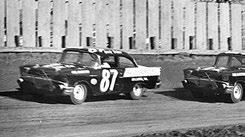
April 19 Southern States Fairgrounds Fireball Roberts
April 27 Hub City Speedway Marvin Panch
April 28 Greensboro Agricultural Fairgrounds Paul Goldsmith
April 28 Portland Speedway Art Watts
May 4 Cleveland County Fairgrounds Fireball Roberts
May 5 Atlantic Rural Exposition Fairgrounds Paul Goldsmith
May 19 Martinsville Speedway Buck Baker
May 26 Portland Speedway Eddie Pagan
May 30 Eureka Speedway Lloyd Dane
May 30 Lincoln Speedway Buck Baker
June 1 Lancaster Speedway Paul Goldsmith
June 8 Los Angeles Fairgrounds Eddie Pagan
June 15 Newport Speedway Fireball Roberts
June 20 Columbia Speedway Jack Smith
June 22 Capitol Speedway Bill Amick
June 29 Hub City Speedway Lee Petty
June 30 Speedway Park Buck Baker
July 4 Raleigh Speedway Paul Goldsmith
July 12 Southern States Fairgrounds Marvin Panch
July 14 Memphis-Arkansas Speedway Marvin Panch
July 14 Portland Speedway Eddie Pagan
July 20 Hickory Speedway Jack Smith
July 24 Norfolk Speedway Buck Baker
July 30 Lancaster Speedway Speedy Thompson
Aug. 4 Watkins Glen International Buck Baker
Aug. 4 Kitsap County Airport Parnelli Jones
Aug. 10 Lincoln Speedway Marvin Panch
Aug. 16 Old Bridget Stadium Lee Petty
Aug. 26 Coastal Speedway Gwyn Staley
Sept. 2 Darlington Raceway Speedy Thompson
Sept. 5 New York State Fairgrounds Gwyn Staley
Sept. 8 Asheville-Weaverville Speedway Lee Petty
Sept. 8 California State Fairgrounds Danny Graves
Sept. 15 Santa Clara Fairgrounds Marvin Porter
Sept. 15 Langhorne Speedway Gwyn Staley
Sept. 19 Columbia Speedway Buck Baker
Sept. 21 Cleveland County Fairgrounds Buck Baker
Oct. 5 Southern States Fairgrounds Lee Petty
Oct. 6 Martinsville Speedway Bob Welborn
Oct. 12 Newberry Speedway Fireball Roberts
Oct. 13 Concord Speedway Fireball Roberts
Oct. 20 North Wilkesboro Speedway Jack Smith
Oct. 27 Central Carolina Fairgrounds Buck Baker
NOV.
BEST DRIVER
GLENN “FIREBALL” ROBERTS
collected eight victories in 42 starts. The native of Apopka, Florida, showed strength in Pete DePaolo’s No. 22 factory-supported Ford as well the Ford Roberts fielded himself in 22 races. His year was that of feast or famine as his cars failed to finish 10 times. His average start was 5.8 and average finish was 9.2, slightly less than Baker’s statistics.
BEST RACE
ALFRED “SPEEDY” THOMPSON, driving his own Chevrolet, passed veteran Curtis Turner on the 216th of 364 laps to collect the most prestigious victory of his career in the Southern 500 at South Carolina’s Darlington Raceway. Thompson led 210 laps and averaged 100.094 mph in the hot, attrition-filled event. Sadly, driver Bobby Myers lost his life in a multi-car crash on the 27th lap of the race.
TOP CARS
BUCK BAKER, DRIVER and owner of the No. 87 Chevrolet Bel Air, logged 10 victories, 30-top-five finishes, 38 top-10 results and six pole positions.
Marvin Panch, driver of the No. 98 DePaolo Ford, scored six wins, 22 top-five results, 27 top-10 finishes and four pole positions.
61
PRESIDENT: DWIGHT D. EISENHOWER NO. 1 SONG: “ALL SHOOK UP,” BY ELVIS PRESLEY TOP NEWS: MAY 6: JFK AWARDED PULITZER PRIZE JUNE 27: HURRICANE AUDREY LANDS
1957
22: CONSTRUCTION OF DAYTONA INTERNATIONAL SPEEDWAY ANNOUNCED
57
Consistency Key to Petty’s Title
Drivers Lee Petty and Buck Baker proved they were the top championship contenders of the 1958 NASCAR Cup Series season, winning a combined 10 of 51 races over the course of the year.
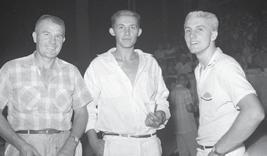
As the season began, Detroit’s Big Three automakers were not convinced stock car racing was the great marketing tool for selling their inventories that NASCAR founder “Big” Bill France had been touting.
The manufacturers were pulling out of the sport, leaving drivers to also become team owners, and the top stars weren’t seeing the dollar signs they had hoped for.
Those who helped start the sport, such as Herb Thomas, Tim Flock, Fonty Flock, Marshall Teague, Frank Munday, Curtis Turner, Hershel McGriff and others, had collectively won 152 of the first 277 races from 1949 to 1956. None of those drivers won a race in 1957. New faces were racing to the front, and fans were leaving for other sports.
France needed a new star, someone who would put people back in the grandstands. Glen “Fireball” Roberts proved to be the answer. To France’s surprise, the 29-year-old native of Daytona Beach, Florida, only entered 10 races in 1958 but made six visits to Victory Lane. His biggest win that year came on July 4 at North Carolina’s Raleigh Speedway with earnings of $32,218, which was a small fortune for that time.
Among those also going to Victory Lane that season, Lee Petty won seven races to set the stage for his second Cup Series championship while driving his own 1957 Oldsmobile.
Fifteen drivers won Cup Series races in 1958 with Junior Johnson and Roberts each scoring six victories. Petty was best in championship points to earn his second crown.
SEASON RECAP
DATE CIRCUIT WINNER
Nov. 3 Champion Speedway
Feb. 23 Daytona Beach and Road Course
March 2 Concord Speedway
March 15
Speedway
March 16 Wilson Speedway
March 23

Speedway
April 5 Champion Speedway
White
Petty
Turner
Petty
Baker
Welborn
April 10 Columbia Speedway Speedy Thompson
April 12 Hub City Speedway Speedy Thompson
April 13 Lakewood Speedway Curtis Turner
April 18 Southern States Fairgrounds Curtis Turner
April 20 Martinsville Speedway Bob Welborn
April 25 Old Dominion Speedway Frankie Schneider
April 27 Old Bridge Stadium Jim Reed
May 3 Greenville-Pickens Speedway Jack Smith
May 11 Central Carolina Fairgrounds Bob Welborn
May 15 Starkey Speedway Jim Reed
May 18 North Wilkesboro Speedway Junior Johnson
May 24 Bowman Gray Stadium Bob Welborn
May 30 New Jersey State Fairgrounds Fireball Roberts
June 1 Riverside International Raceway Eddie Gray
June 5 Columbia Speedway Junior Johnson
June 12 New Bradford Speedway Junior Johnson
June 15 Reading Fairgrounds Junior Johnson
June 25 Lincoln Speedway Lee Petty
June 28 Hickory Speedway Lee Petty
June 29 Asheville-Weaverville Speedway Rex White
July 4 Raleigh Speedway Fireball Roberts
July 12 McCormick Field Jim Paschal
July 16 State Line Speedway Shorty Rollins
July 18 Exposition Speedway Lee Petty
July 19 Civic Stadium Jim Reed
July 25 Monroe County Fairgrounds Cotton Owens
July 26 Wall Stadium Jim Reed
Aug. 2 Bridgehampton Raceway Jack Smith
Aug. 7 Columbia Speedway Speedy Thompson
Aug. 10 Fairgrounds Speedway Nashville Joe Weatherly
Aug. 17 Asheville-Weaverville Speedway Fireball Roberts
Aug. 22 Bowman Gray Stadium Lee Petty
Aug. 23 Rambi Race Track Bob Welborn
Sept. 1 Darlington Raceway Fireball Roberts
Sept. 5 Southern States Fairgrounds Buck Baker
Sept. 7 Fairgrounds Speedway Birmingham Fireball Roberts
Sept. 7 Sacramento Fairgrounds Parnelli Jones
Sept. 12 Gastonia Fairgrounds Buck Baker
Sept. 14 Richmond Raceway Speedy Thompson
Sept. 28 Orange Speedway Joe Eubanks
Oct. 5 Salisbury Speedway Lee Petty
Oct. 12 Martinsville Speedway Fireball Roberts
Oct. 26 Lakewood Speedway Junior Johnson
PRESIDENT: DWIGHT D. EISENHOWER NO. 1 SONG: “JAILHOUSE ROCK” BY ELVIS PRESLEY

NO. 1 BOX OFFICE: TOUCH OF EVIL GALLON OF GAS: 30 CENTS
POP CULTURE: WESTERNS SUCH AS GUNSMOKE & WAGON TRAIN BECAME BIG HITS ON TELEVISION
BEST DRIVER
LEE PETTY, DRIVING HIS OWN PETTY Engineering Oldsmobile, relied on consistency at the front of the field to score seven victories and claim his second NASCAR championship. The native of Level Cross, North Carolina, is known as the first NASCAR driver to rely on racing alone as his livelihood. He kept his cars clean and away from crashes on the track to keep repairs down. His smooth driving style had him in contention throughout his 50 starts.
BEST RACE
A REPORTED CROWD OF 15,000 fans saw the lead change hands eight times among seven drivers before Fireball Roberts claimed the victory in the July 4 Raleigh 250 at North Carolina’s Raleigh Speedway. Driving Frank Strickland’s No. 22 Chevrolet, Roberts passed Buck Baker for the lead on lap 194 and never looked back. His margin of victory was more than a lap of the one-mile paved track.
TOP CARS
LEE PETTY
drove the No. 42 Petty Enterprises
Oldsmobile to seven victories and 44 top-10 finishes en route to his second series championship.
Former Charlotte city bus driver Buck Baker won three times with 35 top-10 results in his own No. 87 Chevrolet.
62 THROUGH THE YEARS 58
Rex
Paul Goldsmith
Lee
Curtis
Champion
Lee
Buck
Orange
Bob
1958
Title No. 3 for Lee Petty
In 1959, Lee Petty, a resident of Level Cross, North Carolina, won 11 races, including the inaugural Daytona 500, on short tracks and superspeedways and earned his third NASCAR premier series championship.
Petty was in his 11th year of racing in NASCAR’s premier series after making his first start during the inaugural season of competition in 1949. He fielded his own Oldsmobile and Plymouth with help from sons Richard and Maurice Petty, as well as nephew Dale Inman.
Richard Petty was also in his second season of NASCAR competition after winning rookie-of-the-year honors in 1958.
Lee Petty had already claimed championships on the elite stock car circuit in 1954 and again in 1958. He was on top of his game as the defending champion and was poised to put together another successful season.
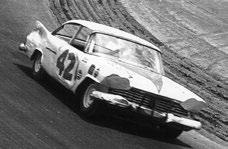
His closest rival, Cotton Owens of Spartanburg, South Carolina, was also a mechanic-turned driver and had established himself as a winner on many southern short tracks. Owens managed to score a victory at Richmond Raceway late in the season, while his 22 top-10 finishes kept him in the title hunt with Petty.
From the beginning of the season, Petty set the pace after winning the Daytona 500 over Johnny Beauchamp in a controversial photo-finish. Like Owens, Petty also performed well and kept his name at the top of the win column.
After 10 additional victories on short tracks, Petty secured his third title by winning two of the final three races of the year. All told, Petty logged 27 top-five finishes and 35 top-10 results in 42 starts that season. He won the title over Owens by 974 points.
SEASON RECAP
November
February
February
March
March
March
March
March
May 17
May 22
May
May
June
June
June 14 Lakewood Speedway
June
June
June
June
June 28
July
July
July 26
August 1 Rambi Raceway Ned Jarrett
August 2 Charlotte Fairgrounds Ned Jarrett
August 9 Fairgrounds Speedway Nashville Joe Lee Johnson
August 16 Asheville-Weaverville Speedway Bob Welborn
August 21 Bowman Gray Stadium Rex White
August 22 Greenville-Pickens Speedway Buck Baker
August 29 Columbia Speedway Lee Petty
September 7 Darlington Raceway Jim Reed
September 11 Hickory Speedway Lee Petty

September 13 Richmond Raceway Cotton Owens
September 13 Sacramento Fairgrounds Eddie Gray
September 20 Orange Speedway Lee Petty
September 27 Martinsville Speedway Rex White
October 11 Asheville-Weaverville Speedway Lee Petty
October 18 North Wilkesboro Speedway Lee Petty
October 25 Concord Speedway Jack Smith
PRESIDENT: DWIGHT D. EISENHOWER NO. 1 BOX OFFICE: BEN-HUR NO. 1 SONG: “THE BATTLE OF NEW ORLEANS,” BY JOHNNY HORTON GALLON OF GAS: 25¢ POP CULTURE: HAWAI’I BECOMES THE 50TH STATE
BEST DRIVER
LEE PETTY, DRIVER OF THE NO. 42
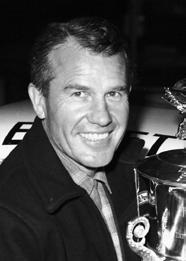
Petty Enterprises Oldsmobile and Plymouth, was a careful racer while managing to keep his cars up front throughout the 44-race NASCAR schedule. Petty only fell out of eight races that year due to broken axles, engine issues and one crash. The 45-year old driver kept his overall plan in sight and captured his third title with overwhelming dominance. It came through careful driving and careful maintenance of his cars.
BEST RACE
ON FEB. 22, 1959, PETTY battled Johnny Beauchamp for the victory in the inaugural Daytona 500, crossing under the checkered flag with Joe Weatherly alongside, one lap down. Both Petty and Beauchamp went to Victory Lane with the win initially going to Beauchamp. Three days later, a photograph shot near the start-finish line proved Petty was the winner. He was given the winner’s trophy at his home in North Carolina.
TOP CARS
THE 1959 OLDSMOBILE LEE
Petty owned and maintained from his Level Cross, North Carolina, shop, producing 11 wins, 27 top-five finishes and 35 top-10 results.
The 1959 Pontiac Cotton Owens owned and maintained at his shop in Spartanburg, South Carolina, producing one win, 13 top-five results and 22 top-10 finishes.
63
DATE LOCATION WINNER
19 Champion Speedway Bob Welborn
20 Daytona International Speedway Bob Welborn
22 Daytona International Speedway Lee Petty
1 Orange Speedway Curtis Turner
8 Concord Speedway Curtis Turner
22 Lakewood Speedway Johnny Beauchamp
29 Wilson Speedway Junior Johnson
30 Bowman Gray Stadium Jim Reed
4 Columbia Speedway Jack Smith
5 North Wilkesboro Speedway Lee Petty
26 Reading Speedway Junior Johnson May 2 Hickory Speedway Junior Johnson May 3 Martinsville
Lee
April
April
April
Speedway
Petty
Trenton
Tom
Speedway
Pistone
Charlotte
Lee
Fairgrounds
Petty
24 Fairground Speedway Nashville Rex White
30 Ascot Stadium Parnelli Jones
Jack
5 Hub City Speedway
Smith
13 Greenville-Pickens Speedway Junior Johnson
Lee
Petty
18 Columbia Speedway Lee Petty
20 Wilson Speedway Junior Johnson
21 Richmond Raceway Tom Pistone
27 Bowman Gray Stadium Rex White
Asheville-Weaverville
Speedway Rex White
4 Daytona International Speedway Fireball Roberts
21 Heidelberg Raceway Jim Reed
Charlotte
Fairgrounds Jack Smith
1959 59
Underdog Scenario
BEST DRIVER
SEASON RECAP
DATE LOCATION WINNER
The 1960 NASCAR season actually started with two races in late 1959 and featured a total of 44 events on a variety of tracks, including both paved and dirt short tracks along with a pair of new 1.5-mile speedways, as the sport began to expand its horizons.
The Chevrolets fielded by General Motors won 20 of the 44 races, including the Daytona 500, Charlotte’s new World 600 and the series championship. Ford drivers won 15 races, while Chrysler’s conservative effort logged nine total victories for its drivers.
The intensely competitive field of drivers included Rex White, in the No. 4 Chevrolet he owned, and rising star Richard Petty, part of the powerful Petty Enterprises operation. White, a native of Taylorsville, North Carolina, and Petty, of Level Cross, North Carolina, were involved in an interesting battle for the series championship.
White’s lone career NASCAR title came through consistent finishes, highlighted by victories in Montgomery, Alabama; Weaverville, North Carolina; Martinsville, Virginia; North Wilkesboro, North Carolina; and twice in Columbia, South Carolina. He accumulated 25 top-five finishes and 35 top-10 results.
After a long year full of triumphs and occasional setbacks, White was crowned the 1960 champion after finishing fifth in the season finale at Atlanta Motor Speedway.
Petty’s three victories came on short tracks in Martinsville, Virginia; Hillsboro, North Carolina; and the fairgrounds oval in Charlotte, North Carolina. His 16 top-five results and 30 top-10 finishes were not quite as strong as the numbers amassed by White. Petty’s season long tally of 17,228 points fell 3,936 short of White’s 21,164.
REX WHITE WON THE 1960 Monster Energy NASCAR Cup Series championship by wheeling the gold-and-white No. 4 Chevrolets he and crew chief Louis Clements constructed with financial support from various sponsors that kept White’s fledgling team in business. White was consistent everywhere he raced, often finishing among the lead cars as he posted six victories, 25 top-five results and 35 top-10 finishes. At 5-foot-4, White bested all other drivers by capturing NASCAR’s top honor.
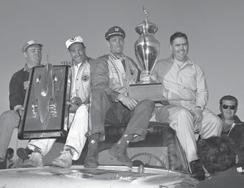
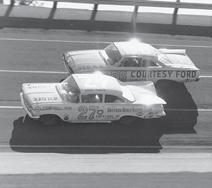

BEST RACE

DRIVING A 1960 Chevrolet sorely lacking in horsepower, Junior Johnson won the Daytona 500 after discovering how to draft other cars. After being pulled to the front by faster cars, Johnson took the lead with eight laps remaining when the rear window blew out of Bobby Johns’ car and he spun. Johnson, a moonshiner from Wilkes County, North Carolina, picked up the ride in John Masoni’s car just eight days before the race.
TOP CARS
REX WHITE, IN THE NO
4. Impala sponsored by Nalley Chevrolet, collected six victories, 25 top-five finishes and 35 top-10 results in 40 starts.
Richard Petty, driving the No. 43 Petty Enterprises Plymouth, amassed three wins, 15 top-five results and 30 top-10 finishes in 40 starts.
Nov. 8 Charlotte Fairgrounds Jack Smith
Nov. 26 Columbia Speedway Ned Jarrett
Feb. 12 Daytona International Speedway Fireball Roberts
Feb. 12 Daytona International Speedway Jack Smith
Feb. 14 Daytona International Speedway Junior Johnson
Feb. 28 Charlotte Fairgrounds Richard Petty
March 27 North Wilkesboro Speedway Lee Petty
April 3 Arizona State Fairgrounds John Rostek
April 5 Columbia Speedway Rex White
April 10 Martinsville Speedway Richard Petty
April 15 Hickory Speedway Joe Weatherly
April 17 Wilson Speedway Joe Weatherly
April 18 Bowman Gray Stadium Glen Wood
April 23 Greenville-Pickens Speedway Ned Jarrett
April 24 Asheville-Weaverville Speedway Lee Petty
May 14 Darlington Raceway Joe Weatherly
May 28 Hub City Speedway Ned Jarrett
May 29 Orange Speedway Lee Petty
June 5 Richmond International Raceway Lee Petty
June 12 Marchbanks Speedway Marvin Porter
June 19 Charlotte Motor Speedway Joe Lee Johnson
June 26 Bowman Gray Stadium Glen Wood
July 4 Daytona International Speedway Jack Smith
July 10 Heidelberg Stadium Lee Petty
July 17 Montgomery Air Base Rex White
July 23 Rambi Raceway Buck Baker
July 31 Atlanta Motor Speedway Fireball Roberts
Aug. 3 Dixie Speedway Ned Jarrett
Aug. 7 Fairgrounds Speedway Johnny Beauchamp
Aug. 14 Asheville-Weaverville Speedway Rex White
Aug. 16 Hub City Speedway Cotton Owens
Aug. 18 Columbia Speedway Rex White
Aug. 20 South Boston Speedway Junior Johnson
Aug. 23 Bowman Gray Stadium Glen Wood
Sept. 5 Darlington Raceway Buck Baker
Sept. 9 Hickory Speedway Junior Johnson
Sept. 11 Sacramento Fairgrounds Jim Cook
Sept. 15 Gamecock Speedway Ned Jarrett
Sept. 18 Orange Speedway Richard Petty
Sept. 25 Martinsville Speedway Rex White
Oct. 2 North Wilkesboro Speedway Rex White
Oct. 16 Charlotte Motor Speedway Speedy Thompson
Oct. 23 Richmond International Raceway Speedy Thompson
Oct. 30 Atlanta Motor Speedway Bobby Johns
PRESIDENT John F. Kennedy
NO. 1 AT THE BOX OFFICE
Ben-Hur
NO. 1 SONG
“Theme From a Summer Place,” Percy Faith and His Orchestra

POP CULTURE
- 1960 Olympics open in Rome, Italy
- Elvis Presley returns to U.S. after military service.
GALLON OF GAS 31 Cents
1960
64
60
THROUGH THE YEARS
The 1960 season featured a popular underdog who battled for a championship against the sport’s top teams. When the dust settled, a new champion was crowned.
A Fight to the Finish
Ned Jarrett and Rex White used talent on the short tracks to become the championship contenders during the 1961 NASCAR Cup Series season, collecting a combined eight victories throughout the 52-race premier series schedule.
BEST DRIVER
JOE WEATHERLY, driving a Ford owned by Doc White and a Pontiac owned by Bud Moore, won nine NASCAR Cup Series races during the 1961 season. The Norfolk, Virginia, native opened the season with a victory in the final event at the Charlotte Fairgrounds. He also won at Daytona, twice at Charlotte Motor Speedway and on short tracks in Myrtle Beach, South Carolina; Hillsboro, North Carolina; Richmond, Virginia; Martinsville, Virginia; and Bristol, Tennessee.
BEST RACE
SEASON RECAP
DATE LOCATION WINNER
November 6 Charlotte Fairgrounds Joe Weatherly
November 20 Speedway Park Lee Petty
February 24 Daytona International Speedway Fireball Roberts
February 24 Daytona International Speedway Joe Weatherly
February 26 Daytona International Speedway Marvin Panch
March 4 Piedmont Interstate Fairgrounds Cotton Owens
March 5 Asheville-Weaverville Speedway Rex White
March 12 Marchbanks Speedway Fireball Roberts
March 26 Atlanta Motor Speedway Bob Burdick
April 1 Greenville-Pickens Speedway Emanuel Zervakis
April 2 Orange Speedway Cotton Owens
April 3 Bowman Gray Stadium Rex White
April 9 Martinsville Speedway Fred Lorenzen
April 16 North Wilkesboro Speedway Rex White
April 20 Columbia Speedway Cotton Owens
April 22 Hickory Motor Speedway Junior Johnson
April 23 Richmond Raceway Richard Petty
April 30 Martinsville Speedway Junior Johnson
May 6 Darlington Raceway Fred Lorenzen
May 21 Charlotte Motor Speedway Richard Petty
May 21 Charlotte Motor Speedway Joe Weatherly
May 21 Riverside International Raceway Lloyd Dane
May 27 Ascot Speedway Eddie Gray
May 28 Charlotte Motor Speedway David Pearson
June 2 Piedmont Interstate Fairgrounds Jim Paschal
June 4 Alabama State Fairgrounds Ned Jarrett

June 8 Greenville-Pickens Speedway Jack Smith
June 10 Bowman Gray Stadium Rex White
June 17 Norwood Arena Emanuel Zervakis
Jarrett, a native of Newton, North Carolina, had competed in NASCAR’s premier series for eight seasons before making a championship bid in 1961. Team owner B.G. Holloway fielded the No. 11 Chevrolet with Bud Allman serving as chief mechanic, a position known today as crew chief, for 46 of 52 races on the schedule.
Jarrett visited Victory Lane only once, topping Jim Paschal in a 100-mile event on June 4 at the Alabama State Fairgrounds in Birmingham. His championship season was sealed by consistency through 29 top-five finishes and 34 top-10 results.
White, driving his own No. 4 Chevrolet, won seven races in 47 starts that season, logging 29 top-five results and 38 top-10 finishes. The Taylorsville, North Carolina, native employed Louis Clements, grandfather of current Xfinity Series competitor Jeremy Clements, as his chief mechanic. Even though their number of wins was far greater that Jarrett’s, the team came up 840 points short under the system NASCAR used that year.
Races of 249 miles or less were awarded 50 points to the winner. Races of 250 to 399 miles awarded 100 points to the winner. Races lasting 400 miles or longer awarded 150 points to the winner. White failed to finish seven times during the season as the number of laps completed was also a factor in determining the championship.
White’s wins came at Bowman Gray Stadium (3) in Winston-Salem, North Carolina; North Wilkesboro (N.C.) Speedway (2); Asheville-Weaverville (N.C.) Speedway; and Hickory (N.C.) Motor Speedway.
ON MAY 6, 1961, young Fred Lorenzen, driving a Holman Moody Ford, and veteran Curtis Turner, in the Wood Brothers Racing Ford, battled for the win in the Rebel 300, bumping an estimated 50 times in the final 20 laps. Turner blocked Lorenzen numerous times while shaking fists at one another until Lorenzen faked high and went low. Lorenzen held a six-car length lead with two laps remaining and maintained it until crossing under the checkered flag.
TOP CARS
Ned Jarrett’s No. 11 blue-and-white Chevrolet Impala owned by B.G. Holloway – a onerace winner.
Rex White’s No. 4 goldand-white Chevrolet Impala – winner of seven races.
June 23 Hartsville Speedway Buck Baker
June 24 Starkey Speedway Junior Johnson
July 4 Daytona International Speedway David Pearson
July 9 Atlanta Motor Speedway Fred Lorenzen
July 20 Columbia Speedway Cotton Owens
July 22 Rambi Raceway Joe Weatherly
July 29 Bristol Motor Speedway Jack Smith
August 6 Fairgrounds Speedway Nashville Jim Paschal
August 9 Bowman Grady Stadium Rex White
August 13 Asheville-Weaverville Speedway Junior Johnson
August 18 Southside Speedway Junior Johnson
August 27 South Boston Speedway Junior Johnson
September 4 Darlington Raceway Nelson Stacy
September 8 Hickory Motor Speedway Rex White
September 10 Richmond Raceway Joe Weatherly
September 10 Sacramento Fairgrounds Eddie Gray
September 17 Atlanta Motor Speedway David Pearson
September 24 Martinsville Speedway Joe Weatherly
October 1 North Wilkesboro Speedway Rex White
October 15 Charlotte Motor Speedway Joe Weatherly
October 22 Bristol Motor Speedway Joe Weatherly
October 28 Greenville-Pickens Speedway Junior Johnson
October 29 Orange Speedway Joe Weatherly
PRESIDENT John F. Kennedy
NO. 1 AT THE BOX OFFICE
West Side Story
NO. 1 SONG
“Tossin’ and Turnin’” by Bobby Lewis
POP CULTURE
Navy Commander
Alan B. Shepard Jr. rockets
116.5 miles up into space.
GALLON OF GAS
31 Cents
1961
65 61
Weatherly Tops Petty in Title Tilt
Former motorcycle champion Joe Weatherly, of Norfolk, Virginia, proved to be the class of the field and was crowned NASCAR Cup Series champion in 1962 with nine wins and 45 top-10 results.
BEST DRIVER
JOE WEATHERLY, driver of the No. 8 Bud Moore Engineering Pontiac, won nine races – all on short tracks –while finishing outside the top 10 only seven times in 52 starts. His union with Bud Moore seemed a bit magical in the sense that they were strong at every race they entered. Weatherly’s seven pole positions also sent a message to his fellow competitors that 1962 was his year to claim NASCAR’s coveted Cup Series championship.
BEST RACE
SEASON RECAP
DATE LOCATION WINNER
Nov. 5 Concord Speedway Jack Smith
Nov. 12 Asheville-Weaverville Speedway Rex White
Feb. 16 Daytona Int’l Speedway Fireball Roberts
Feb. 16 Daytona Int’l Speedway Joe Weatherly
Feb. 18 Daytona Int’l Speedway Fireball Roberts
Feb. 25 Concord Speedway Joe Weatherly
March 4 Asheville-Weaverville Speedway Joe Weatherly
March 17 Savannah Speedway. Jack Smith
March 18 Orange Speedway Rex White
April 1 Richmond Raceway Rex White
April 13 Columbia Speedway Ned Jarrett
April 15 North Wilkesboro Speedway Richard Petty
April 19 Greenville Pickens Speedway Ned Jarrett
April 21 Rambi Raceway Jack Smith
April 22 Martinsville Speedway Richard Petty
April 23 Bowman Gray Stadium Rex White

April 29 Bristol Motor Speedway Bobby Johns
May 4 Southside Speedway Jimmy Pardue
May 5 Hickory Speedway Jack Smith
May 6 Concord Speedway Joe Weatherly
May 12 Darlington Raceway Nelson Stacy
May 19 Piedmont Interstate Fairgrounds Ned Jarrett
May 27 Charlotte Motor Speedway Nelson Stacy
June 10 Atlanta Motor Speedway Fred Lorenzen
June 16 Bowman Gray Stadium Johnny Allen
June 19 Augusta Speedway Joe Weatherly
June 22 Southside Speedway Jim Paschal
June 23 South Boston Speedway Rex White
July 4 Daytona International Speedway Fireball Roberts
As the 1962 NASCAR Cup Series season began, the Automobile Association of America was still claiming that stock car racing should be banned as too dangerous, a movement that began in 1957. The resolution had been adopted by the Big Three automakers after receiving Congressional pressure on the basis that promoting speed and horsepower wasn’t safe for the general public, especially teenagers.
But the automakers had assembly lines of cars to sell and racing on the high banks of Daytona, Darlington, Atlanta and Charlotte provided perfect venues. A way around the moves to ban racing was to supply the teams “under the table” in secret. By June, Ford Motor Co. withdrew from the AAA, as did the other manufacturers.
The cars to beat that year were the Pontiac driven by Weatherly and fielded by team owner Bud Moore, and the Petty Enterprises Plymouth driven by Richard Petty with eight wins to his credit. Weatherly’s additional eight topfive results and six top-10 finishes made the difference in championship points over Petty.
Weatherly was very superstitious. The Southern 500 at Darlington Raceway was a big problem for the NASCAR star. The race was the 13th annual event and Weatherly told track president Bob Colvin that he would not compete.
Colvin had a handshake deal with Weatherly and demanded that Weatherly honor the agreement, but Weatherly refused to have anything to do with the No. 13. Colvin angrily appeased Weatherly by renaming the 1962 Southern 500 the “The 12th Renewal of the Southern 500.”

DRIVING THE LEWIS Clements No. 4 Chevrolet, Rex White admitted he had “little to no chance” of winning the Dixie 400 at Atlanta Motor Speedway, but he drafted off of faster cars and logged his 28th-career victory in the final race of the season. White conserved fuel and made one less pit stop. The pre-race strategy worked to White’s advantage when leader Marvin Panch had to pit in the closing laps.
TOP CARS

JOE WEATHERLY’S No. 8 Bud Moore Engineering Pontiac went to Victory Lane nine times and had 45 top-10 finishes. Richard Petty, driving the No. 43 Petty Enterprises Plymouth, recorded eight wins and 38 top-10 results in 52 starts.
July 7 Columbia Speedway Rex White
July 13 New Asheville Speedway Jack Smith
July 14 Greenville-Pickens Speedway Richard Petty
July 17 Augusta International Speedway Joe Weatherly
July 20 Savannah Speedway Joe Weatherly
July 21 Rambi Raceway Ned Jarrett
July 29 Bristol Motor Speedway Jim Paschal
Aug. 3 Boyd Speedway Joe Weatherly
Aug. 5 Fairgrounds Speedway Nashville Jim Paschal
Aug. 8 Huntsville Speedway Richard Petty
Aug. 12 Asheville-Weaverville Speedway Jim Paschal
Aug. 15 Roanoke Raceway Richard Petty
Aug. 18 Bowman Gray Stadium Richard Petty
Aug. 21 Hub City Speedway Richard Petty
Aug. 25 Valdosta 75 Speedway Ned Jarrett
Sept. 3 Darlington Raceway Larry Frank
Sept. 7 Hickory Speedway Rex White
Sept. 9 Richmond Raceway Joe Weatherly
Sept. 11 Dog Track Raceway Ned Jarrett
Sept. 13 Augusta Speedway Fred Lorenzen
Sept. 23 Martinsville Speedway Nelson Stacy
Sept. 30 North Wilkesboro Speedway Richard Petty
Oct. 14 Charlotte Motor Speedway Junior Johnson
Oct. 28 Atlanta Motor Speedway Rex White
PRESIDENT John F. Kennedy
NO. 1 AT THE BOX OFFICE
Lawrence of Arabia
NO. 1 SONG
POP CULTURE
The music industry was booming. Elvis released the singles “Return to Sender” & “Can’t Help Falling in Love.”
GALLON OF GAS
31 Cents
1962
66
62
THROUGH THE YEARS
“Stranger on the Shore” by Acker Bilk
Weatherly Drives for 9 Owners
Reigning NASCAR Cup Series champion Joe Weatherly was best known for winning a second consecutive title in 1963 while bumming rides with nine team owners. He notched three wins and 35 top-10 finishes that season.

BEST DRIVER
FRED LORENZEN, driver of the No. 28 Holman Moody Ford, entered only 29 of 55 races and still managed to become the first driver in NASCAR to earn six figures in prize money during a single season. The Elmhurst, Indiana. native won six times, scored 23 top-10 finishes and claimed eight pole positions. It was the greatest season of his 12-year career. No other driver before him in NASCAR’s then 14-year history had come close.
BEST RACE
SEASON RECAP
DATE LOCATION WINNER
Nov. 4 Birmingham Speedway Jim Paschal
Nov. 11 Golden Gate Speedway Richard Petty
Nov. 22 Tar Heel Speedway Jim Paschal
Jan. 20 Riverside International Raceway Dan Gurney
Feb. 22 Daytona International Speedway Junior Johnson
Feb. 22 Daytona International Speedway Johnny Rutherford
Feb. 24 Daytona International Speedway Tiny Lund
March 2 Piedmont Speedway Richard Petty
March 3 Asheville-Weaverville Speedway Richard Petty
March 10 Orange Speedway Junior Johnson
March 17 Atlanta Motor Speedway Fred Lorenzen
March 24 Hickory Speedway Junior Johnson
March 31 Bristol Motor Speedway Fireball Roberts
April 4 New Augusta Speedway Ned Jarrett
April 7 Richmond Raceway Joe Weatherly
April 13 Greenville-Pickens Speedway Buck Baker
April 14 South Boston Speedway Richard Petty
April 15 Bowman Gray Stadium Jim Paschal
April 21 Martinsville Speedway Richard Petty
April 28 North Wilkesboro Speedway Richard Petty
May 2 Columbia Speedway Richard Petty
May 5 Tar Heel Speedway Jim Paschal
May 11 Darlington Raceway Joe Weatherly
May 18 Old Dominion Speedway Richard Petty
May 19 Southside Speedway Ned Jarrett
June 2 Charlotte Motor Speedway Fred Lorenzen
June 9 Birmingham International Raceway Richard Petty
June 30 Atlanta Motor Speedway Junior Johnson
July 4 Daytona International Speedway Fireball Roberts
July 7 Rambi Raceway Ned Jarrett
Weatherly was riding high during the winter months between seasons, having won the 1962 Cup Series title with team owner Bud Moore. However, a phone call soured Weatherly’s good mood when Moore reported he simply didn’t have the money or equipment to run the entire 55-race schedule. Weatherly took the news in stride and began thinking about how to defend his title.
The Norfolk, Virginia, driver took it upon himself to formulate a plan to make all of the races. He would drive the races Moore had scheduled and spend hours on the phone talking his way into other rides throughout the season. He would get into cars that he knew had no chance to win but would complete laps, gain positions and manage respectable finishes while saving the owners’ cars.
Weatherly drove for Moore, as well as Cliff Stewart, Fred Harb, Pete Stewart, Floyd Powell, Major Melton, Possum Jones, Worth McMillan and Wade Younts –names not associated with wins or championships other than Moore. Weatherly wanted nothing but to win. He had the tenacity of a bulldog and would never give up.
By season’s end, Weatherly had enough points to beat Richard Petty, even though Petty won 14 times and entered one more race than Weatherly. All told, Weatherly found himself 1,228 points ahead when the checkered flag waved at Riverside International Raceway on Nov. 3.
The other big story of the year was Fred Lorenzen, winner of six races, banking six figures in prize money with Ford’s Holman Moody team.
DRIVING THE NO. 21 Wood Brothers Racing Mercury, Tiny Lund won the 1963 Daytona 500 as a substitute driver after Marvin Panch was injured days before the event in a crash during practice for a sports car race at Daytona International Speedway. Lund helped rescue Panch from his burning car and was given the ride at Panch’s suggestion. Lund, a surprise winner, was in Daytona Beach hoping to find a car to drive in the 500.
TOP CARS
ALL THREE OF CHAMPION Joe Weatherly’s series victories came in the No. 8 Pontiac owned and prepared by legendary mechanic Bud Moore. Richard Petty recorded 14 wins and 34 top-10 finishes behind the wheel of the No. 43 Petty Enterprises Plymouth.
July 10 Savannah Speedway Ned Jarrett
July 11 Dog Track Speedway Jimmy Pardue
July 13 Bowman Gray Stadium Glen Wood
July 14 New Asheville Speedway Ned Jarrett
July 19 Old Bridge Stadium Fireball Roberts
July 21 Bridgehampton Circuit Richard Petty
July 28 Bristol Motor Speedway Fred Lorenzen
July 30 Greenville-Pickens Speedway Richard Petty
Aug. 4 Fairgrounds Speedway Nashville Jim Paschal
Aug. 8 Columbia Speedway Richard Petty
Aug. 11 Asheville-Weaverville Speedway Fred Lorenzen
Aug. 14 Piedmont Fairgrounds Ned Jarrett
Aug. 16 Bowman Gray Stadium Junior Johnson
Aug. 18 W. Virginia International Speedway Fred Lorenzen
Sept. 2 Darlington Raceway Fireball Roberts
Sept. 6 Hickory Speedway Junior Johnson
Sept. 8 Richmond Raceway Ned Jarrett
Sept. 22 Martinsville Speedway Fred Lorenzen
Sept. 24 Dog Track Speedway Ned Jarrett
Sept. 29 North Wilkesboro Speedway Marvin Panch
Oct. 5 Tar Heel Speedway Richard Petty
Oct. 13 Charlotte Motor Speedway Junior Johnson
Oct. 20 South Boston Speedway Richard Petty
Oct. 27 Orange Speedway Joe Weatherly
Nov. 3 Riverside International Raceway Darel Dieringer
PRESIDENT John
F. Kennedy
NO. 1 AT THE BOX OFFICE
The Great Escape
NO. 1 SONG
“Sugar Shack” by Jimmy Gilmore and the Fireballs
POP CULTURE
The Best-Selling Fiction
Novel was “The Shoes of the Fisherman” by Morris L. West
GALLON OF GAS
30 Cents
1963
67 63
In 1964, Richard Petty and his familyowned team, Petty Enterprises, proved best, collecting the coveted NASCAR Cup Series championship after logging nine wins, 37 top-five results, 43 top-10 finishes and eight pole positions in 61 starts.
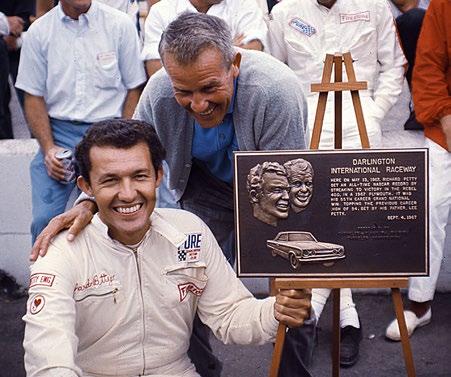
BEST DRIVER
DRIVING NO. 11
Fords for a pair of owners, Ned Jarrett won 15 of 59 races during the 1964 NASCAR Cup Series season. He was consistently the best driver with 40 top-five finishes and 42 top-10 results as well as nine pole positions. Jarrett’s quest for a third series championship was derailed by failing to finish 23 races, primarily due to a rash of engine failures.
BEST RACE
SEASON RECAP
DATE LOCATION WINNER
Nov. 10 Concord International Speedway Ned Jarrett
Richard Petty Claims First Title 64
Nov. 17 Augusta International Raceway Fireball Roberts
Dec. 1 Jacksonville Speedway Wendell Scott
Dec. 29 Savannah Speedway Richard Petty
Jan. 19 Riverside International Raceway Dan Gurney
Feb. 21 Daytona International Speedway Junior Johnson
Feb. 21 Daytona International Speedway Bobby Isaac
Feb. 23 Daytona International Speedway Richard Petty
Mar. 10 Richmond Raceway David Pearson
Mar. 22 Bristol Motor Speedway Fred Lorenzen
Mar. 28 Greenville-Pickens Speedway David Pearson
Mar. 30 Bowman Gray Stadium Marvin Panch
Apr. 5 Atlanta Motor Speedway Fred Lorenzen
Apr. 11 Asheville-Weaverville Speedway Marvin Panch
Apr. 12 Orange Speedway David Pearson
Apr. 14 Piedmont Interstate Fairgrounds Ned Jarrett
Apr. 16 Columbia Speedway Ned Jarrett
Apr. 19 North Wilkesboro Speedway Fred Lorenzen
Apr. 26 Martinsville Speedway Fred Lorenzen
May 1 Savannah Speedway LeeRoy Yarbrough
May 9 Darlington Raceway Fred Lorenzen
May 15 Langley Field Speedway Ned Jarrett
May 16 Hickory Speedway Ned Jarrett
May 17 South Boston Speedway Richard Petty
May 24 Charlotte Motor Speedway Jim Paschal
May 30 Greenville-Pickens Speedway LeeRoy Yarbrough
May 31 New Asheville Speedway Ned Jarrett
Jun. 7 Atlanta Motor Speedway Ned Jarrett
Jun. 11 Concord International Speedway Richard Petty
Jun. 14 Fairgrounds Speedway Nashville Richard Petty
The 1964 season actually began in November 1963 with four races being run before the new year. The series also visited the serpentine circuit in Riverside, California, prior to the prestigious Daytona 500 in February. Petty, at the young age of 26, won at Savannah Speedway on Dec. 29 and then collected the first of seven Daytona 500 victories at the 2.5-mile Daytona International Speedway.
It was the first superspeedway victory of Petty’s career. Having suffered a horrendous crash during a qualifying race prior to the 1961 Daytona 500, Lee Petty entered only two races in 1964 and retired from driving to concentrate on his son’s championship effort. Richard Petty’s brother, Maurice, built engines for the team’s Plymouths with strength enough to win seven additional short-track races.
Ned Jarrett, driving the No. 11 Fords owned by Charles Robinson (4 races) and Bondy Long (55 race), entered 59 races that season, winning 15 Times. His biggest victory came June 7 at Atlanta Motor Speedway over Petty after leading 66 of 267 laps. Petty bested Jarrett in the championship standings by 5,302 points at season’s end.
Tragically, NASCAR stars Joe Weatherly, Fireball Roberts and Jimmie Pardue died in crashes. Weatherly lost his life in Riverside, California, on Jan. 19. Roberts was involved in a multi-car crash at Charlotte Motor Speedway on May 24 and succumbed to his injuries on July 2. Pardue died after crashing during a tire test at Charlotte on Sept. 22.
ON JULY 4, A.J. FOYT and Bobby Isaac exchanged the lead 16 times in the final 56 laps of the 160-lap Firecracker 400 at Daytona International Speedway. Driving a Dodge owned by Ray Nichels, Foyt claimed the win after passing Isaac just before reaching the startfinish line to record his first of seven NASCAR triumphs. Foyt’s victory was marred by the announcement that Fireball Roberts had died after a lengthy hospital stay.
TOP CARS
RICHARD PETTY’S NO. 43 Petty Enterprises Plymouth won nine times in 1964 with 43 top-10 finishes and eight pole positions in 61 starts.
Ned Jarrett’s 1964 No. 11 Long/Robinson Ford went to Victory Lane 15 times and had 42 top10 results in 59 races.
Jun. 19 Chattanooga International Raceway David Pearson
Jun. 21 Birmingham International Raceway Ned Jarrett
Jun. 23 Valdosta 75 Speedway Buck Baker
Jun. 26 Piedmont Interstate Fairgrounds Richard Petty
Jul. 4 Daytona International Speedway A.J. Foyt
Jul. 8 Old Dominion Speedway Ned Jarrett
Jul. 10 Old Bridge Speedway Billy Wade
Jul. 12 Bridgehampton Raceway Billy Wade
Jul. 15 Islip Speedway Billy Wade
Jul. 19 Watkins Glen International Billy Wade
Jul. 21 Lincoln Speedway David Pearson
Jul. 26 Bristol Motor Speedway Fred Lorenzen
Aug. 2 Fairgrounds Speedway Nashville Richard Petty
Aug. 7 Rambi Raceway David Pearson
Aug. 9 Asheville-Weaverville Speedway Ned Jarrett
Aug. 13 Dog Track Speedway Ned Jarrett
Aug. 16 West Virginia International Speedway Richard Petty
Aug. 21 Columbia Speedway David Pearson
Aug. 22 Bowman Gray Stadium Junior Johnson

Aug. 23 Roanoke Raceway Junior Johnson
Sept. 7 Darlington Raceway Buck Baker
Sept. 11 Hickory Speedway David Pearson
Sept. 14 Richmond Raceway Cotton Owens
Sept. 18 Old Dominion Speedway Ned Jarrett
Sept. 20 Orange Speedway Ned Jarrett
Sept. 27 Martinsville Speedway Fred Lorenzen
Oct. 9 Savannah Speedway Ned Jarrett
Oct. 11 North Wilkesboro Speedway Marvin Panch
Oct. 18 Charlotte Motor Speedway Fred Lorenzen
Oct. 25 Harris Speedway Richard Petty
Nov. 1 Augusta Speedway Darel Dieringer
Nov. 8 Jacksonville Speedway Ned Jarrett
PRESIDENT Lyndon B. Johnson
NO. 1 AT THE BOX OFFICE Mary Poppins
NO. 1 SONG
“I Want To Hold Your Hand” by The Beatles

POP CULTURE
The Warren Commission concludes that Lee Harvey Oswald acted alone in assassinating President Kennedy.
GALLON OF GAS 30 Cents
1964
68
THROUGH THE YEARS
Jarrett Best Amid Turmoil
“Gentleman” Ned Jarrett, NASCAR’s 1961 Cup Series champion, enjoyed his second championship in 1965 on the strength of 13 wins and 45 top-10 finishes. The native of Conover, North Carolina, excelled on the short tracks.
BEST DRIVER
NED JARETT, DRIVING the No. 11 Ford owned by Bondy Long, began the season showing signs of championship form. He won by the fifth race and continued to show strength throughout the season, amassing 13 wins in 54 starts. His tenacity and determination, including a 14-lap lead in the Southern 500 at Darlington Raceway, proved he could win NASCAR’s top prize. Many times he looked to be out of contention but came back to win.
BEST RACE
SEASON RECAP
DATE LOCATION
65
WINNER
Jan. 17 Riverside International Raceway Dan Gurney
Feb. 12 Daytona International Speedway Darel Dieringer
Feb. 12 Daytona International Speedway Junior Johnson
Feb. 14 Daytona International Speedway Fred Lorenzen
Feb. 27 Piedmont Interstate Fairgrounds Ned Jarrett
Feb. 28 Asheville-Weaverville Speedway Ned Jarrett
March 7 Richmond Raceway Junior Johnson
March 14 Orange Speedway Ned Jarrett
April 11 Atlanta Motor Speedway Marvin Panch
April 17 Greenville-Pickens Speedway Dick Hutcherson
April 18 North Wilkesboro Speedway Junior Johnson
April 25 Martinsville Speedway Fred Lorenzen
April 28 Columbia Speedway Tiny Lund
May 2 Bristol Motor Speedway Junior Johnson
May 8 Darlington Raceway Junior Johnson
May 14 Langley Field Speedway Ned Jarrett
May 15 Bowman Gray Stadium Junior Johnson
May 16 Hickory Speedway Junior Johnson
May 23 Charlotte Motor Speedway Fred Lorenzen
May 27 Cleveland County Fairgrounds Ned Jarrett
May 29 New Asheville Speedway Junior Johnson
May 30 Harris Speedway Ned Jarrett
June 3 Fairgrounds Speedway Nashville Dick Hutcherson
June 6 Birmingham Int’l Raceway Ned Jarrett
June 13 Atlanta Motor Speedway Marvin Panch
June 19 Greenville-Pickens Speedway Dick Hutcherson
June 24 Rambi Speedway Dick Hutcherson
June 27 Valdosta 75 Speedway Cale Yarborough
July 4 Daytona International Speedway A.J. Foyt
July 8 Old Dominion Speedway Junior Johnson
July 9 Old Bridge Stadium Junior Johnson
NASCAR drivers and teams looked to 1965 as a new start in the world of stock car racing, but with NASCAR officials banning Chrysler’s hemi engine the optimism was short-lived.
The Pettys were died-in the-wool Chrysler campaigners, so they decided to go drag racing. Chrysler pulled its financial support of NASCAR, leaving father Lee Petty and sons Richard and Maurice to build a Plymouth Barracuda drag racing car. They labeled it “43 Jr. – Outlawed” and hit the quarter-mile.
From there, Fords were king of NASCAR, but fans didn’t want to just see one manufacturer race against itself. All short tracks and superspeedways on the Cup Series schedule reported low advance ticket sales. Track executives were in dire straits. With few fans coming through their turnstiles, they faced certain financial doom.
After discussions with both NASCAR and USAC, the hemi engine was approved for use in Plymouth Belvederes and Coronets on tracks of one mile or less and road courses.
Track promoters celebrated the progress but needed one more incentive, that being the reinstatement of driver Curtis Turner. Turner had been banned by “Big” Bill France for life after trying to organize a union among NASCAR drivers in 1961. After much persuasion, France finally reinstated Turner.
The Floyd, Virginia, native returned for six races, winning the inaugural event at Rockingham Speedway on Oct. 31, 1965.
Jarrett captured the Cup Series title by 3,034 points over Dick Hutcherson.
DRIVING THE NO. 21 Wood Brothers Racing Ford, Marin Panch outlasted his overheating Galaxie to win the Dixie 400 at Atlanta Motor Speedway. The Oakland, California, native fought off thoughts of parking the car “a dozen times,” but was saved by caution periods at the right time to cool the engine. With 60 laps remaining, Panch pushed the throttle as instructed by his team via chalkboard. Panch led Darel Dieringer at the end under caution.
TOP CARS
NED JARRETT DROVE the top car as Bondy Long’s No. 11 Ford scored 13 wins and 45 top-10 finishes in 54 series starts.
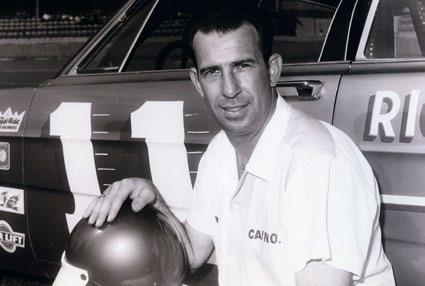
Dick Hutcherson, driver of the No. 29 Holman Moody Ford, notched nine wins with 37 top-10 results in 52 races.
July 14 Islip Speedway Marvin Panch
July 18 Watkins Glen International Marvin Panch
July 25 Bristol Motor Speedway Ned Jarrett
July 31 Fairgrounds Speedway Nashville Richard Petty
Aug. 5 Cleveland County Speedway Ned Jarrett
Aug. 8 Asheville-Weaverville Speedway Richard Petty
Aug. 13 Smoky Mountain Raceway Dick Hutcherson
Aug. 14 Piedmont Interstate Fairgrounds Ned Jarrett
Aug. 15 Augusta International Speedway Dick Hutcherson
Aug. 19 Columbia Speedway David Pearson
Aug. 24 Dog Track Speedway Dick Hutcherson
Aug. 25 Baltimore-Washington Speedway Ned Jarrett
Aug. 28 Bowman Gray Stadium Junior Johnson
Sept. 6 Darlington Raceway Ned Jarrett
Sept. 10 Hickory Speedway Richard Petty
Sept. 14 Lincoln Speedway Dick Hutcherson
Sept. 17 Old Dominion Speedway Richard Petty
Sept. 18 Richmond Raceway David Pearson
Sept. 26 Martinsville Speedway Junior Johnson
Oct. 3 North Wilkesboro Speedway Junior Johnson
Oct. 17 Charlotte Motor Speedway Fred Lorenzen
Oct. 24 Orange Speedway Dick Hutcherson
Oct. 31 Rockingham Speedway Curtis Turner
Nov. 7 Dog Track Speedway Ned Jarrett
PRESIDENT Lyndon B. Johnson
NO. 1 AT THE BOX OFFICE
The Sound of Music
NO. 1 SONG
The Gemini Space Program continued to form the foundation for an eventual moon landing.
GALLON OF GAS
31 Cents
1965
69
“Wooly Bully” by Sam the Sham and the Pharaohs POP CULTURE
Pearson’s First Title
Drivers David Pearson and James Hylton proved best during the 49-race NASCAR Cup Series season of 1966. Pearson logged 15 victories and the championship, while Hylton challenged with 20 top-five finishes.
Having been in NASCAR’s premier division for only five seasons, Pearson, a native of Spartanburg, South Carolina, had one of his best rides with team owner Cotton Owens, also based in the same city.
Pearson drove Owens’ white-and-red No. 6 Dodge in 42 of 49 races but managed to post enough top finishes to score his first-career championship. Ironically, all of his victories that year came on short tracks throughout the Southeast and New England. Pearson logged 25 top-five finishes and fell out of only nine events due to mechanical issues.
Pearson’s biggest victory of the season came at Virginia’s Richmond Raceway in the Capital City 300 on Sept. 11, 1966, where he led 242 of 300 laps.

Hylton, his closest championship rival, had served as a crew chief for Rex White in 1960 before fielding and driving his own Dodge. The native of Inman, South Carolina, was able to build his season on consistent top-five and top-10 finishes en route to his best championship finish to date. Hylton also finished second in points to Richard Petty in 1967.
Sadly, Hylton was killed in a highway accident earlier this year while traveling home form Alabama’s Talladega Superspeedway, a track where he won in 1972.
BEST DRIVER
DAVID PEARSON, wheeling the No. 6 Dodge owned by Cotton Owens, logged a season-high 15 victories, double the amount of wins by any other driver. His smooth driving style allowed him to save his equipment until the final laps before making his charge to the front. Short tracks proved to be where Pearson shined. His strategy of laying back prompted media outlets to dub him “The Silver Fox” as his hair turned gray during later years.
BEST RACE
ON AUG. 27, 1966, newcomer Bobby Allison battled veteran Curtis Turner in a crowd-stirring, car-smashing event at Bowman Gray Stadium in Winston Salem, North Carolina. Turner hooked Allison’s Chevrolet and spun him out on lap eight of 250. Allison returned the favor, spinning Turner on lap 98. Turner waited on Allison to come back by, but Allison crashed into Turner again. The two made contact twice more before being separated by NASCAR officials.
TOP CARS

DAVID PEARSON drove Cotton Owens’ white-and-red No. 6 Dodge to 15 NASCAR Cup Series victories during the 1966 season.
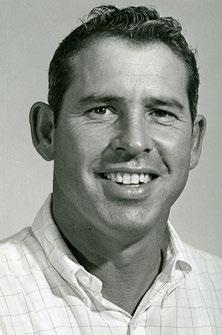
SEASON RECAP
DATE LOCATION WINNER
Nov. 14 Augusta Speedway Richard Petty
Jan. 23 Riverside International Raceway Dan Gurney
Feb. 25 Daytona International Speedway Paul Goldsmith
Feb. 25 Daytona International Speedway Earl Balmer
Feb. 27 Daytona International Speedway Richard Petty
March 13 Rockingham Speedway Paul Goldsmith
March 20 Bristol Motor Speedway Dick Hutcherson
March 27 Atlanta Motor Speedway Jim Hurtubise
April 3 Hickory Motor Speedway David Pearson
April 7 Columbia Speedway David Pearson
April 9 Greenville-Pickens Speedway David Pearson
April 11 Bowman Gray Stadium David Pearson

April 17 North Wilkesboro Speedway Jim Paschal
April 24 Martinsville Speedway Jim Paschal
April 30 Darlington Raceway Richard Petty
May 7 Langley Field Speedway Richard Petty
May 10 Middle Georgia Raceway Richard Petty
May 13 Starlite Speedway Darel Dieringer
May 15 Richmond Raceway David Pearson
May 22 Charlotte Motor Speedway Marvin Panch
May 29 Dog Track Speedway David Pearson
June 2 New Asheville Speedway David Pearson
June 4 Piedmont Interstate Fairgrounds Elmo Langley
June 9 Smoky Mountain Raceway David Pearson
June 12
Asheville-Weaverville Speedway Richard Petty
June 15 Beltsville Speedway Tiny Lund
June 25 Greenville-Pickens Speedway David Pearson
July 4 Daytona International Speedway Sam McQuagg
July 7 Old Dominion Speedway Elmo Langley
July 10 Bridgehampton Raceway David Pearson
July 12 Oxford Plains Speedway Bobby Allison
July 14 Fonda Speedway David Pearson
July 16 Islip Speedway Bobby Allison
July 24 Bristol Motor Speedway Paul Goldsmith
July 28 Smoky Mountain Raceway Paul Lewis
July 30 Fairgrounds Speedway Richard Petty
Aug. 7 Atlanta Motor Speedway Richard Petty
Aug. 18 Columbia Speedway David Pearson
Aug. 21 Asheville-Weaverville Speedway Darel Dieringer
Aug. 24 Beltsville Speedway Bobby Allison
August 27 Bowman Gray Stadium David Pearson
Sept. 5 Darlington Raceway Darel Dieringer
Sept. 9 Hickory Motor Speedway David Pearson
Sept. 11 Richmond Raceway David Pearson
Sept. 18 Orange Speedway Dick Hutcherson
Sept. 25 Martinsville Speedway Fred Lorenzen
Oct. 2 North Wilkesboro Speedway Dick Hutcherson
Oct. 16 Charlotte Motor Speedway LeeRoy Yarbrough
Oct. 30 Rockingham Speedway Fred Lorenzen
PRESIDENT Lyndon B. Johnson
NO. 1 SONG
James Hylton’s No. 48 Hylton Racing Dodge had no victories but was a consistent second-place finish in NASCAR Cup Series points.
“California Dreamin” by The Mamas & The Papas
POP CULTURE
Screen actor Ronald Reagan is elected Governor of California.
GALLON OF GAS 31 Cents
Superstars Junior Johnson and Ned Jarrett retired from driving at the end of the 1966 season, each having 50 wins to their credit. Johnson said years later, “Had I known we were tied, I would have raced a little longer so I could have gotten ahead of him. 1966
70 THROUGH
66
THE YEARS
NO. 1 AT THE BOX OFFICE The Bible: In The Beginning
Petty Wins 27 Races
BEST DRIVER
RICHARD PETTY, driver of the No. 43 Petty Enterprises Plymouth, dominated the win column by putting his car in Victory Lane at 27 of 49 NASCAR Cup Series races. The team’s season proved so magical that Petty was just as surprised as his fans. Petty and his crew entered each race expecting to win and very few mechanical problems or crashes during the season often left them in position to best their closest competitors.
BEST RACE
SEASON RECAP
DATE LOCATION
WINNER
November 13 Augusta Raceway Richard Petty
January 29 Riverside International Raceway Parnelli Jones
February 24 Daytona International Speedway LeeRoy Yarbrough
February 24 Daytona International Speedway Fred Lorenzen
February 26 Daytona International Speedway Mario Andretti
March 5 Asheville-Weaverville Speedway Richard Petty
March 19 Bristol Motor Speedway David Pearson
March 25 Greenville-Pickens Speedway David Pearson
March 27 Bowman Gray Stadium Bobby Allison
April 2 Atlanta Motor Speedway Cale Yarborough
April 6 Columbia Speedway Richard Petty
April 9 Hickory Motor Speedway Richard Petty
April 16 North Wilkesboro Speedway Darel Dieringer
April 23 Martinsville Speedway Richard Petty
April 28 Savannah Raceway Bobby Allison
April 30 Richmond Raceway Richard Petty
May 13 Darlington Raceway Richard Petty
May 19 Beltsville Speedway Jim Paschal
May 20 Langley Speedway Richard Petty
May 28 Charlotte Motor Speedway Jim Paschal
June 2 Asheville Speedway Jim Paschal
June 6 Middle Georgia Raceway Richard Petty
June 8 Smoky Mountain Raceway Richard Petty
June 10 Birmingham International Speedway Bobby Allison
June 18 Rockingham Speedway Richard Petty
June 24 Greenville-Pickens Speedway Richard Petty
In 1967, Richard Petty and his Petty Enterprises crew put together the most phenomenal season in NASCAR history. The driver from Level Cross, North Carolina, won 27 of 49 races, including 10 consecutively.
During the 1967 NASCAR Cup Series season, Petty wheeled a solid blue 1967 Plymouth with the famed No. 43 on its doors and roof. The single car he and crew chief Dale Inman campaigned that season proved to be the most competitive piece of machinery to come out of the Level Cross, North Carolina, stable in the team’s illustrious 43-year history.
With the help of his father, Lee Petty, and his brother, Maurice, building the engines, Petty began the year with a victory in Augusta, Georgia. It proved to be a warm-up for what would become an amazing season. All told, Petty won 27 times on a variety of tracks.
Petty and the No. 43 team were unstoppable from Aug. 12 to Oct. 1. The 10-race win streak began at the famed quarter-mile Bowman Gray Stadium in Winston-Salem, North Carolina, and ended at North Wilkesboro Speedway. The streak included one win on a superspeedway, at Darlington Raceway in South Carolina on Sept. 4. Petty’s only other superspeedway win came at Rockingham Speedway on June 18. With so many victories to his credit that year, there was little doubt as to which driver would be crowned champion by season’s end.
Petty’s closest rival in points was James Hylton, a former crewman for 1960 champion, Rex White, who wheeled the No. 48 Dodge for team owner Bud Hartje. Hylton was unable to score a victory, but finished consistently enough to take second-place prize money in the point standings
ON SEPT. 4, 1967, Petty started the Southern 500 at Darlington Raceway from the pole position and led 345 of the race’s 367 laps on what was then a 1.375-mile track. Drivers such as David Pearson, Buddy Baker and Donnie Allison held the lead briefly throughout the race but could not match Petty’s strength. His performance was indicative of how he managed the entire season, going into each event as the favorite.
TOP CARS
RICHARD PETTY’S blue 1967 Plymouth Belvedere posted 27 victories, 38 top-five finishes and claimed 19 pole positions.
James Hylton, who wheeled a 1965 Dodge for Bud Hartje, recorded 26 top-five finishes and 39 top-10 results during the season.
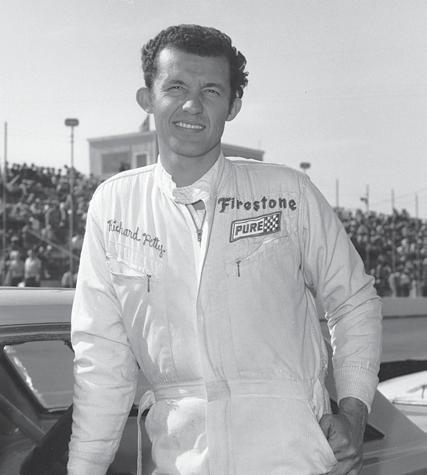
June 27 Montgomery Speedway Jim Paschal
July 4 Daytona International Speedway Cale Yarborough
July 9 Trenton Speedway Richard Petty
July 11 Oxford Plains Speedway Bobby Allison
July 13 Fonda Speedway Richard Petty
July 15 Islip Speedway Richard Petty
July 23 Bristol Motor Speedway Richard Petty
July 27 Smoky Mountain Raceway Dick Hutcherson
July 29 Fairgrounds Speedway Nashville Richard Petty
August 6 Atlanta Motor Speedway Dick Hutcherson
August 12 Bowman Gray Stadium Richard Petty
August 17 Columbia Speedway Richard Petty
August 25 Savannah Speedway Richard Petty
September 4 Darlington Raceway Richard Petty
September 8 Hickory Motor Speedway Richard Petty
September 10 Richmond Raceway Richard Petty
September 15 Beltsville Speedway Richard Petty
September 17 Orange Speedway Richard Petty
September 24 Martinsville Speedway Richard Petty
October 1 North Wilkesboro Speedway Richard Petty
October 15 Charlotte Motor Speedway Buddy Baker
October 29 Rockingham Speedway Bobby Allison
November 5 Asheville-Weaverville Speedway Bobby Allison
PRESIDENT Lyndon B. Johnson
NO. 1 AT THE BOX OFFICE
The Graduate
NO. 1 SONG
“To Sir With Love” by Lulu
POP CULTURE
Rolling Stone magazine debuts in November
GALLON OF GAS 33
1967
71 67
Cents
Title No. 2 for David Pearson
Driving the No. 17 Holman Moody
Ford Torino, David Pearson secured his second NASCAR Cup Series crown during the 1968 season by winning 16 races and logging 38 top-10 finishes in 47 starts.
BEST DRIVER
DAVID PEARSON, driver of the No. 17 Holman Moody Ford, was quiet off the track but allowed his Waddell Wilson-built engines to roar on them. The Spartanburg, South Carolina, native enjoyed a phenomenal season in which his average start was 3.4 and average finish was 5.8 in 16 races. He was known for preserving his equipment until the closing laps and then striking. Later in his career, this strategy earned him the nickname “The Silver Fox.”
BEST RACE
SEASON RECAP
DATE LOCATION WINNER
Nov. 12 Middle Georgia Raceway Bobby Allison
Nov. 26 Montgomery Speedway Richard Petty
Jan. 21 Riverside International Raceway Dan Gurney
Feb. 25 Daytona International Speedway Cale Yarborough
March 17 Bristol Motor Speedway David Pearson
March 24 Richmond Raceway David Pearson
March 31 Atlanta Motor Speedway Cale Yarborough
April 7 Hickory Speedway Richard Petty
April 13
Greenville-Pickens Speedway Richard Petty
April 18 Columbia Speedway Bobby Isaac
April 21 North Wilkesboro Speedway David Pearson
April 28 Martinsville Speedway Cale Yarborough
May 3 Augusta Speedway Bobby Isaac
May 5 Asheville-Weaverville Speedway David Pearson
May 11 Darlington Raceway David Pearson
May 17 Beltsville Speedway David Pearson
May 18 Langley Field Speedway David Pearson
May 26 Charlotte Motor Speedway Buddy Baker
May 31 Asheville Speedway Richard Petty
June 2 Middle Georgia Raceway David Pearson
June 6 Smoky Mountain Raceway Richard Petty
June 8 Birmingham Speedway Richard Petty
June 16 Rockingham Speedway Donnie Allison
June 22 Greenville-Pickens Speedway Richard Petty
July 4 Daytona International Speedway Cale Yarborough
July 7 Islip Speedway Bobby Allison
July 9 Oxford Plains Speedway Richard Petty
On the heels of Richard Petty’s amazing 1967 season with 27 wins in 48 starts, Ford Motor Co. officials wanted to come out swinging in 1968.
Ford had not previously sent its factory-backed teams to short-track events, feeling their money should be spent on the races that were 250 miles or more. But to win a championship, their guns needed to be pointed in all directions.
Dick Hutcherson, a top Ford driver from 1965 to ’67, was asked to step away from driving to work with the up-and-coming David Pearson, already a champion with team owner Cotton Owens in 1966.
The retired Fred Lorenzen teamed with Bobby Allison at Holman Moody as well, and Cale Yarborough was with Wood Brothers Racing.
Allison’s tenure lasted only three races as did Lorenzen’s, even though he won the season opener in Macon, Georgia. Allison broke out his own Chevrolet, won in Islip, New York, and continued to have good finishes before joining team owner Tom Friedkin in late September.
Pearson went to Victory Lane at Bristol Motor Speedway in March and steadily began building his assault on the championship. In May, he won four straight races with three more consecutive wins coming later in the season.
Pearson captured the Cup Series championship by 126 over Bobby Isaac, who was driving Nord Krauskopf’s Dodge. Isaac only scored three wins.
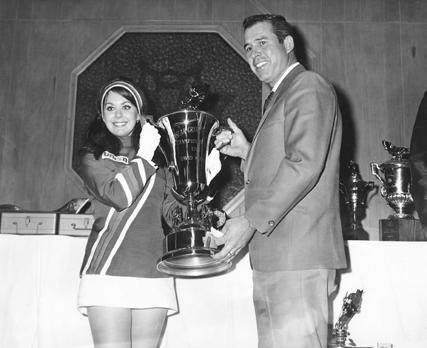
DRIVING THE NO. 21 Wood Brothers Racing Ford, Cale Yarborough held David Pearson at bay on the tight, single groove Darlington Raceway to win the prestigious Southern 500. Pearson was faster, but Yarborough held him off for several laps as attempts to pass for the lead proved unsuccessful. Yarborough eventually bounced off the steel guard rail and hit Pearson’s Ford, causing Pearson to spin. Pearson recovered but could not pass for the win.
TOP CARS
DAVID PEARSON’S NO.
17 Holman Moody Ford notched 16 wins and 38 top-10 finishes after 47 Cup Series starts.
Bobby Isaac’s No. 71 Nord Krauskopf-owned Dodge had 35 top-10 results, including three victories, in 49 races.
July 11 Fonda Speedway Richard Petty
July 14 Trenton Speedway LeeRoy Yarbrough
July 21 Bristol Motor Speedway David Pearson
July 25 Smoky Mountain Speedway Richard Petty
July 27 Fairgrounds Speedway Nashville David Pearson
Aug. 4 Atlanta Motor Speedway LeeRoy Yarbrough
Aug. 8 Columbia Speedway David Pearson
Aug. 10 Bowman Gray Stadium David Pearson

Aug. 18 Asheville-Weaverville Speedway David Pearson
Aug. 23 South Boston Speedway Richard Petty
Aug. 24 Langley Field Speedway David Pearson
Sept. 2 Darlington Raceway Cale Yarborough
Sept. 6 Hickory Speedway David Pearson
Sept. 8 Richmond Raceway Richard Petty
Sept. 13 Beltsville Speedway Bobby Isaac
Sept. 15 Orange Speedway Richard Petty
Sept. 22 Martinsville Speedway Richard Petty
Sept. 29 North Wilkesboro Speedway Richard Petty
Oct. 5 Augusta Speedway David Pearson
Oct. 20 Charlotte Motor Speedway Charlie Glotzbach
Oct. 27 Rockingham Speedway Richard Petty
Nov. 3 Jeffco Speedway Cale Yarborough
PRESIDENT Lyndon B. Johnson
NO. 1 AT THE BOX OFFICE
Rosemary’s Baby
NO. 1 SONG
“Hey Jude” by The Beatles

POP CULTURE
A leather-clad Elvis made a comeback with his television special on NBC.
GALLON OF GAS 33 Cents
1968
72 THROUGH THE YEARS
68
Title No. 3 for Pearson
SEASON RECAP
DATE LOCATION
WINNER
November 17 Middle Georgia Raceway Richard Petty
December 8 Montgomery Speedway Bobby Allison
February 1 Riverside International Raceway Richard Petty
February 20 Daytona International Speedway David Pearson
February 20 Daytona International Speedway Bobby Isaac
February 23 Daytona International Speedway LeeRoy Yarbrough
March 9 Rockingham Speedway David Pearson
March 16 Augusta Speedway David Pearson
March 23 Bristol Motor Speedway Bobby Allison
March 30 Atlanta Motor Speedway Cale Yarborough
April 3 Columbia Speedway Bobby Isaac
April 6 Hickory Motor Speedway Bobby Isaac
April 8 Greenville-Pickens Speedway Bobby Isaac
April 13 Richmond Raceway David Pearson
April 20 North Wilkesboro Speedway Bobby Allison
April 27 Martinsville Speedway Richard Petty
May 4 Asheville-Weaverville Speedway Bobby Isaac
May 10 Darlington Raceway LeeRoy Yarbrough
May 16 Beltsville Speedway Bobby Isaac
May 17 Langley Speedway David Pearson
May 25 Charlotte Motor Speedway LeeRoy Yarbrough
June 1 Middle Georgia Raceway Bobby Isaac
June 5 Smoky Mountain Raceway Bobby Isaac
June 15 Michigan International Speedway Cale Yarborough
June 19 Kingsport Speedway Richard Petty
June 21 Greenville-Pickens Speedway Bobby Isaac
June 26 State Fairgrounds Speedway David Pearson
July 4 Daytona International Speedway LeeRoy Yarbrough
July 6 Dover International Speedway Richard Petty
July 10 Thompson Speedway David Pearson
July 13 Trenton Speedway David Pearson
July 15 Beltsville Speedway Richard Petty
July 20 Bristol Motor Speedway David Pearson
David Pearson won 11 races in 1969 and claimed his third NASCAR Cup Series championship aboard the No. 17 Ford Torino fielded by Holman Moody, Ford’s factory racing operation.
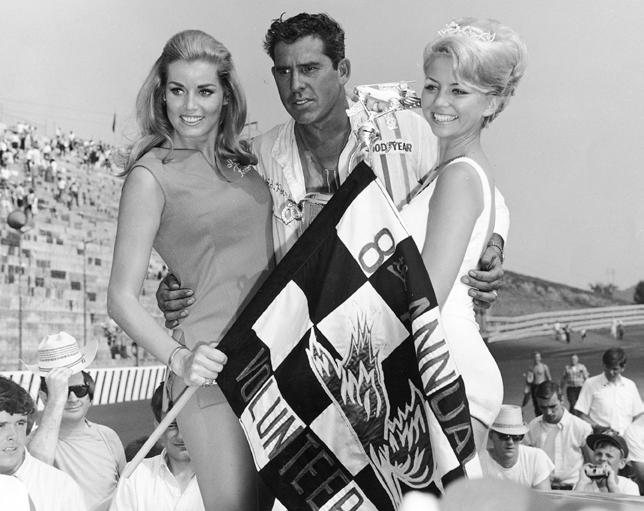
The end of the decade marked Pearson’s 10th season of racing in the NASCAR premier series and the 34-year-old native of Spartanburg, South Carolina, was on top of his game.
John Holman and Ralph Moody formed the Holman Moody race car factory in 1956 with Ford Motor Co. supplying cars, parts and engineering. In order to showcase the team’s craftsmanship, the powerhouse organization fielded top drivers in NASCAR with Pearson as the primary wheelman. He had joined the operation the previous year after scoring championships with team owner Cotton Owens in 1966 and 1967.
Pearson was victorious in one of the 50-mile qualifying events at Daytona International Speedway early in 1969. He also scored superspeedway victories at Rockingham Speedway, Michigan International Speedway, Trenton Speedway and the State Fairgrounds in Raleigh, North Carolina. He notched short-track victories at Augusta Speedway, Richmond Raceway, Langley Speedway, Thompson Speedway, Bristol Motor Speedway and North Wilkesboro Speedway.
With so many wins, Pearson remained a strong championship contender throughout the year and found Richard Petty to be his toughest rival for the title.
ON MONDAY, Sept. 1, 1969, the Southern 500 at Darlington Raceway came down to LeeRoy Yarbrough in the Junior Johnson and Associates Ford and Pearson’s Holman Moody Ford. In a race shortened from 367 to 230 laps by rain, Yarbrough pitted for hard tires while Pearson took soft tires. On lap 220, Pearson raced past Yarbrough but lost traction in the third turn on the final lap, opening the door for Yarbrough to win.
July 26 Fairgrounds Speedway Nashville Richard Petty
July 27 Smoky Mountain Speedway Richard Petty
August 10 Atlanta Motor Speedway LeeRoy Yarbrough
August 17 Michigan International Speedway David Pearson
August 21 South Boston Speedway Bobby Isaac
August 22 Bowman Gray Stadium Richard Petty
August 24 Asheville-Weaverville Speedway Bobby Isaac
September 1 Darlington Raceway LeeRoy Yarbrough
September 5 Hickory Motor Speedway Bobby Isaac
September 7 Richmond Raceway Bobby Allison
September 14 Talladega Superspeedway Richard Brickhouse
September 18 Columbia Speedway Bobby Isaac
September 28 Martinsville Speedway Richard Petty
October 5 North Wilkesboro Speedway David Pearson
October 12 Charlotte Motor Speedway Donnie Allison
October 17 Savannah Speedway Bobby Isaac
October 19 Augusta Speedway Bobby Isaac
October 26 Rockingham Speedway LeeRoy Yarbrough
November 2 Jeffco Speedway Bobby Isaac
November 9 Middle Georgia Raceway Bobby Allison
December 7 Texas World Speedway Bobby Isaac
PRESIDENT Richard Nixon
NO. 1 AT THE BOX OFFICE Butch Cassidy and the Sundance Kid
NO. 1 SONG
“Sugar, Sugar” by The Archies
POP CULTURE Woodstock Music Festival attracts more than 350,000 people
GALLON OF GAS
35 Cents
1969
73 69
BEST RACE
THROUGH THE YEARS
Isaac Shines on Short Tracks
SEASON RECAP
DATE LOCATION WINNER
Jan. 18 Riverside International Raceway A.J. Foyt
Feb. 19 Daytona International Speedway Cale Yarborough
Feb. 19 Daytona International Speedway Charlies Glotzbach
Feb. 22 Daytona International Speedway Pete Hamilton
Mar. 1 Richmond Raceway James Hylton
Mar. 8 Rockingham Speedway Richard Petty
Mar. 15 Savannah Speedway Richard Petty
Mar. 29 Atlanta Motor Speedway Bobby Allison
April 5 Bristol Motor Speedway Donnie Allison
April 12 Talladega Superspeedway Pete Hamilton
April 18 North Wilkesboro Speedway Richard Petty
April 30 Columbia Speedway Richard Petty
May 9 Darlington Speedway David Pearson
May 15 Beltsville Speedway Bobby Isaac
May 18 Langley Speedway Bobby Isaac
May 24 Charlotte Motor Speedway Donnie Allison
May 28 Smoky Mountain Raceway Bobby Isaac
May 31 Martinsville Speedway Bobby Isaac
June 7 Michigan International Speedway Cale Yarborough
June 14 Riverside International Raceway Richard Petty
June 20 Hickory Motor Speedway Bobby Isaac
June 26 Kingsport Speedway Richard Petty
June 27 Greenville-Pickens Speedway Bobby Isaac
July 4 Daytona International Speedway Donnie Allison
July 7 Albany-Saratoga Speedway Richard Petty
July 9 Thompson Speedway Bobby Isaac
July 12 Trenton Speedway Richard Petty
July 19 Bristol Motor Speedway Bobby Allison
July 24 Smoky Mountain Raceway Richard Petty
July 25 Nashville Fairgrounds Speedway Bobby Isaac
Aug. 2 Atlanta Motor Speedway Richard Petty
Aug. 6 Columbia Speedway Bobby Isaac
After years of success as a short-track racer around his home state of North Carolina, Isaac entered NASCAR’s top division in 1961. In his ninth Cup Series season, Isaac finally found success with a championship-caliber team owned by Nord Krauskopf.
Isaac placed the No. 71 K&K Insurance Dodges on the pole 13 times with the help of such mechanical stars as Hall of Fame crew chiefs Harry Hyde and Buddy Parrott. Chrysler’s winged Dodges and Plymouths were in their second year of competition, but Isaac and Hyde discovered some of their greatest tricks in the square-nosed Dodge used on short tracks.
Amazingly, Isaac won his lone championship by notching all 11 of his victories that season on short tracks. The native of Catawba, North Carolina, native logged 32 top-five finishes in 47 starts.
By season’s end, Isaac accumulated 51 more points than Allison to claim the title.
Aug. 11 International Raceway Park Richard Petty
Aug. 16 Michigan International Speedway Charlie Glotzbach
Aug. 23 Talladega Superspeedway Pete Hamilton
Aug. 28 Bowman Gray Stadium Richard Petty

Aug. 29 South Boston Speedway Richard Petty
Sept. 7 Darlington Raceway Buddy Baker
Sept. 11 Hickory Motor Speedway Bobby Isaac
Sept. 13 Richmond Raceway Richard Petty
Sept. 20 Dover International Speedway Richard Petty
Sept. 30 State Fairgrounds Speedway Richard Petty
Oct. 4 North Wilkesboro Speedway Bobby Isaac
Oct. 11 Charlotte Motor Speedway LeeRoy Yarbrough
Oct. 18 Martinsville Speedway Richard Petty
Nov. 8 Middle Georgia Raceway Richard Petty
Nov. 15 Rockingham Speedway Cale Yarborough
Nov. 22 Langley Speedway Bobby Allison
PRESIDENT: RICHARD NIXON GALLON OF GAS: 36¢
NO. 1 AT THE BOX OFFICE: LOVE STORY
POP CULTURE: MONDAY NIGHT FOOTBALL DEBUTS ON ABC
BEST DRIVER
RICHARD PETTY, DRIVING THE NO. 43 Petty Enterprises Plymouth, enjoyed one of his best seasons in 1970 with 18 NASCAR Cup Series victories. The native of Level Cross, North Carolina, led 5,007 of 10,536 laps completed during his 40-race schedule. However, 10 DNFs relegated Petty to fourth in the final standings.
BEST RACE
ON SEPT. 7, 1970, BUDDY BAKER WHEELED a winged Dodge Charger to victory in the Southern 500 at Darlington Raceway. The son of NASCAR champion Buck Baker led 88 of 367 laps for his third of 19-career victories in a car owned by former driver Cotton Owens.
TOP CARS

BOBBY ISAAC, DRIVING THE NO. 71 K&K
Insurance Dodge owned by Nord Krauskopf, won 11 short-track races en route to claiming the 1970 NASCAR Cup Series championship. Bobby Allison’s No. 22 Coca-Cola Dodge owned by Mario Rossi was a three-time Cup Series winner that year.
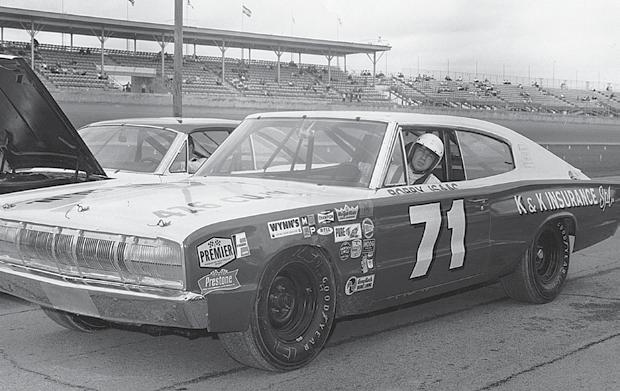
74
Bobby Isaac and Bobby Allison proved to be the top championship contenders of the 1970 NASCAR Cup Series season, collecting a combined 14 victories during the 48-race schedule.
1970
Petty’s Plymouth Dominates
Richard Petty, driver of the No. 43 Petty Enterprises Plymouth, accumulated 21 victories, 41 top-10 finishes and nine pole positions en route to his third NASCAR Cup Series championship..
The 1971 season featured the most significant change in NASCAR history. With the addition of a major series sponsor, the sanctioning body was free from the uncertainty of auto manufacturers that were often not happy with rule changes.
With cigarette advertising now banned from television and radio in the United States, R.J. Reynolds Tobacco Co. began its sponsorship of NASCAR with the Winston 500 at Talladega Superspeedway. Winston also added $100,000 to the point fund, a huge amount of money in those days.
RJR officials would eventually work with NASCAR cut the schedule from more than 55 races to 30 races in an effort do reduce costs and legitimize racing as a professional sport. Further, they began upgrading the tracks with paint, new grandstands, press boxes and media centers, dressing up facilities very much in need of repair.
It was the beginning of a 33-year relationship that brought hundreds of millions of dollars into the sport.
On the competition side in 1971, Petty simply dominated, no matter the type of track. He started the year by winning the Daytona 500 for the third time and took command of the points after winning the eighth race of the year in Hickory, North Carolina. With 21 victories, Petty was just shy of winning half the races on his 46race schedule.
Bobby Allison won 11 races, including five in a row, but suffered nine DNFs. By season’s end, Petty had accumulated 365 more points than James Hylton to claim his third NASCAR Cup Series crown..
SEASON RECAP
DATE LOCATION WINNER
Jan. 10 Riverside International Raceway Ray Elder
Feb. 11 Daytona International Speedway Pete Hamilton
Feb. 11 Daytona International Speedway David Pearson
Feb 14 Daytona International Speedway Richard Petty
Feb. 28 Ontario Motor Speedway A.J. Foyt
March 7 Richmond Raceway Richard Petty
March 14 Rockingham Speedway Richard Petty
March 21 Hickory Speedway Richard Petty
March 28 Bristol Motor Speedway David Pearson
April 4 Atlanta Motor Speedway A.J. Foyt
April 8 Columbia Speedway Richard Petty
April 10 Greenville-Pickens Speedway Bobby Isaac
April 15 Smoky Mountain Raceway Richard Petty
April 18 North Wilkesboro, Speedway Richard Petty
April 25 Martinsville Speedway Richard Petty
May 2 Darlington Raceway Buddy Baker
May 9 South Boston Speedway Benny Parsons
May 16 Talladega Superspeedway Donnie Allison
May 21 New Asheville Speedway Richard Petty
May 23 Kingsport Speedway Bobby Isaac
May 30 Charlotte Motor Speedway Bobby Allison
June 6 Dover Motor Speedway Bobby Allison
June 13 Michigan International Speedway Bobby Allison
June 20 Riverside International Raceway Bobby Allison
June 23 Meyer Speedway Bobby Allison
June 26 Greenville-Pickens Speedway Richard Petty
July 4 Daytona International Speedway Bobby Isaac
July 11 Bristol Motor Speedway Charlie Glotzbach
July 14 Albany-Saratoga Speedway Richard Petty
July 15 Islip Speedway Richard Petty
July 18 Trenton Speedway Richard Petty
July 24 Fairgrounds Speedway Nashville Richard Petty
Aug. 1 Atlanta Motor Speedway Richard Petty
Aug. 6 Bowman Gray Stadium Bobby Allison
Aug. 8 International Raceway Park Richard Petty
Aug. 15 Michigan International Speedway Bobby Allison
Aug. 22 Talladega Superspeedway Bobby Allison
Aug. 27 Columbia Speedway Richard Petty
Aug. 28 Hickory Speedway Tiny Lund
Sep. 6 Darlington Raceway Bobby Allison
Sep. 26 Martinsville Speedway Bobby Isaac
Oct. 10 Charlotte Motor Speedway Bobby Allison
Oct. 17 Dover Motor Speedway Richard Petty
Oct. 24 Rockingham Speedway Richard Petty
Nov. 7 Middle Georgia Raceway Bobby Allison
Nov. 14 Richmond Raceway Richard Petty
Nov. 21 North Wilkesboro Speedway Tiny Lund
Dec. 12 Texas World Speedway Richard Petty
PRESIDENT: RICHARD M. NIXON NO. 1 AT THE BOX OFFICE: A CLOCKWORK ORANGE
MOVIES TO WATCH: WILLY WONKA AND THE CHOCOLATE FACTORY AND FIDDLER ON THE ROOF NO. 1 SONG: “MY SWEET LORD” BY GEORGE HARRISON GALLON OF GAS: 36 CENTS
BEST DRIVER
DRIVING THE NO. 43 PETTY ENTERPRISES
Plymouth, Richard Petty enjoyed one of his best seasons in 1971, winning 21 NASCAR Cup Series races. The Level Cross, North Carolina, native led 2,932 of 14,295 laps completed during his 46-race schedule. His average start was 3.8 and average finish was 4.2. He endured five races where he did not finish due to engine failure or crashes. It was Petty’s third championship in 13 seasons.

BEST RACE
CHARLIE GLOTZBACH HELPED FILL THE stands for the Coca-Cola 600 in May at Charlotte Motor Speedway by driving a new No. 3 Chevrolet Monte Carlo fielded by team owner Richard Howard and team manager Junior Johnson. It was the first time in nearly a decade a Chevrolet was capable of winning. Glotzbach had the race well in hand until Speedy Thompson pulled in front of him and crashed them both on lap 234 of 400.
TOP CARS
RICHARD PETTY’S NO. 43 PETTY Enterprises Plymouth went to Victory Lane 21 times, posting 41 top-10 finishes in 46 starts.
Bobby Allison’s No. 12 Holman
Moody Ford won 11 times with 31 top-10 results in 42 NASCAR Cup Series races.
75 1971 71
Petty Fends Off Allison for No. 4
Richard Petty and Bobby Allison emerged as the top championship contenders during the 1972 NASCAR Cup Series season, collecting a combined 18 victories throughout the 31-race premier series schedule.
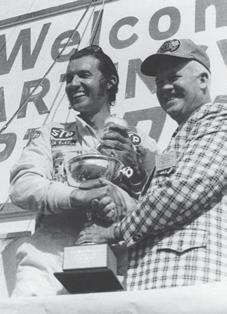
After running a Dodge fielded by his own team and making a handful of starts in a Ford owned by the powerhouse Holman Moody operation during the previous season, Allison joined forces with team owner Richard Howard, whose No. 12 Howard Racing Chevrolet was prepared by former driver Junior Johnson.
It was a relatively new team that debuted in 1971 with driver Charlie Glotzbach entering 14 Cup Series races and winning once at Bristol Motor Speedway. Allison was a proven winner with 29 career victories and brought much-needed sponsorship from Coca-Cola.
Going into the 1972 season, Petty had already accumulated 140 Cup Series victories and three championships with family-owned Petty Enterprises of Level Cross, North Carolina. After his 1967 season in which he won 27 races in 48 starts, including 10 consecutively, Petty was dubbed “The King,” a moniker that still stands today.
Allison and Petty dominated the headlines during 1972 for their on-track performances as well as their intense rivalry. Allison’s 10 victories to Petty’s eight came on short tracks and superspeedways around the country.
When Petty would gain ground in points, Allison was there to counter his advances. When Allison would gain ground, Petty would win and erase any advantage.
When the season ended on Nov. 12 at Texas World Speedway, Petty was 128 points ahead to collect his fourth series championship. Even though their season was considered magical by most standards, Allison left Howard’s operation and once again fielded his own car in 1973, citing communication issues.
SEASON RECAP
DATE LOCATION WINNER
Jan. 23 Riverside International Raceway Richard Petty
Feb. 20 Daytona International Speedway A.J. Foyt
Feb. 27 Richmond Raceway Richard Petty
March 5 Ontario Motor Speedway A.J. Foyt
March 12 Rockingham Speedway Bobby Isaac
March 26 Atlanta Motor Speedway Bobby Allison
April 9 Bristol Motor Speedway Bobby Allison
April 16 Darlington Raceway David Pearson
April 23 North Wilkesboro Speedway Richard Petty
April 30 Martinsville Speedway Richard Petty
May 7 Talladega Superspeedway David Pearson
May 28 Charlotte Motor Speedway Buddy Baker
June 4 Dover International Speedway Bobby Allison
June 11 Michigan International Speedway David Pearson
June 18 Riverside International Raceway Ray Elder
June 25 Texas World Speedway Richard Petty
July 4 Daytona International Speedway David Pearson
July 9 Bristol Motor Speedway Bobby Allison
July 16 Trenton Speedway Bobby Allison
July 23 Atlanta Motor Speedway Bobby Allison
Aug. 6 Talladega Superspeedway James Hylton
Aug. 20 Michigan International Speedway David Pearson
Aug. 26 Fairgrounds Speedway Nashville Bobby Allison
Sept. 4 Darlington Raceway Bobby Allison
Sept. 10 Richmond Raceway Richard Petty
Sept. 17 Dover International Speedway David Pearson
Sept. 24 Martinsville Speedway Richard Petty
Oct. 1 North Wilkesboro Speedway Richard Petty
Oct. 8 Charlotte Motor Speedway Bobby Allison
Oct. 22 Rockingham Speedway Bobby Allison
Nov. 12 Texas World Speedway Buddy Baker
PRESIDENT: RICHARD NIXON GALLON OF GAS: 36¢ NO. 1 AT THE BOX OFFICE: THE GODFATHER POP CULTURE: INTEL INVENTED THE SINGLE CHIP MICROPROCESSOR
BEST DRIVER
BOBBY ALLISON, DRIVING THE NO. 12 Chevrolet fielded by Howard Racing, collected 10 victories during the 1972 season with seven coming on superspeedways and three on short tracks. The Miami native amassed 25 top-five finishes, 27 top-10 results and 12 pole positions in 31 starts. Even though he finished second in points, it was the best season of Allison’s 25-year NASCAR Cup Series career. His average start was 4.0 and his average finish was 5.3.
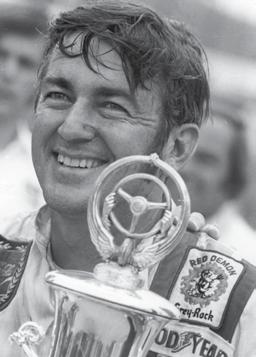
BEST RACE

ON OCT. 1, 1972, AT NORTH Wilkesboro Speedway, Bobby Allison and Richard Petty engaged in a fender-crushing battle that left their cars smoking inside and out during the final seven laps. In the end, Petty went to Victory Lane, but several of Allison’s fans stood outside the winner’s circle and boldly expressed their displeasure of the outcome. It was Petty’s eighth and final win of the season. With two races remaining, he claimed the 1972 championship.
TOP CARS

BOBBY ALLISON’S No.12 Richard Howard-owned Chevrolet won 10 NASCAR Cup Series races in 1972.
Richard Petty drove his No. 43 Petty Enterprises Dodge to victory eight times during the 1972 season.
76 THROUGH THE YEARS 72
1972
Underdog Parsons Wins
In 1973, Benny Parsons overcame difficult odds to become NASCAR’s premier series champion. The native of North Wilkesboro, North Carolina, won only one race that year but relied on a game plan of consistency.
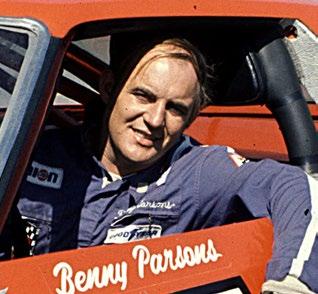
Parsons was in his third full season as the driver of L.G. Dewitt’s No. 72 Cup Series car in 1973. The Ellerbe, North Carolina-based team was considered an underdog against the highly funded operations of the day. But with crew chief Travis Carter guiding the team, there was reason to expect a strong season.
Cale Yarborough, driving Richard Howard’s No. 11 Chevrolet, famously returned to NASCAR that year after racing Indy cars for two seasons. With retired driving legend Junior Johnson managing the team, Yarborough felt he had a good chance to win his first NASCAR Cup Series championship.
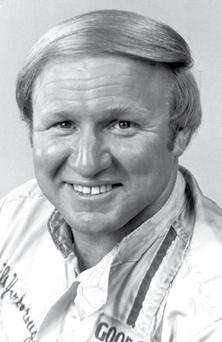
Under NASCAR rules used in 1973, laps completed throughout the season served as the foundation for being crowned champion. In addition, points were awarded for the number of laps completed in a race along with finishes within the top-10.
Even though Yarborough logged four victories, 16 top-five finishes and 19 top-10 results, crashes at Talladega, Daytona, Bristol and Dover curtailed his title hopes.
Parsons nearly lost the title in the season finale at North Carolina’s Rockingham Speedway after being caught up in a multi-car crash on lap 13 of the 492-lap race. He was left with a badly damaged car that looked to be out of the race.
Instead, crew members from several teams helped rebuild his car in the garage area. Parsons returned to the race, finished 28th and ended up 67 points ahead of Yarborough in the championship standings. It was the only Cup Series title of Parsons’ 21-year career.
SEASON RECAP
DATE LOCATION WINNER
Jan.21 Riverside International Raceway Mark Donahue
Feb. 18 Daytona International Speedway Richard Petty
Feb. 25 Richmond Raceway Richard Petty
March 18 Rockingham Speedway David Pearson
March 25 Bristol Motor Speedway Cale Yarborough
April 1 Atlanta Motor Speedway David Pearson
April 8 North Wilkesboro Speedway Richard Petty
April 15 Darlington Raceway David Pearson
April 29 Martinsville Speedway David Pearson
May 6 Talladega Superspeedway David Pearson
May 12 Fairgrounds Speedway – Nashville Cale Yarborough
May 27 Charlotte Motor Speedway Buddy Baker
June 3 Dover International Speedway David Pearson
June 10 Texas World Speedway Richard Petty
June 17 Riverside International Raceway Bobby Allison
June 24 Michigan International Speedway David Pearson
July 4 Daytona International Speedway David Pearson
July 8 Bristol Motor Speedway Benny Parsons
July 22 Atlanta Motor Speedway David Pearson
Aug. 12 Talladega Superspeedway Dick Brooks
Aug. 25 Fairgrounds Speedway – Nashville Buddy Baker
Sept. 3 Darlington Raceway Cale Yarborough
Sept. 9 Richmond Raceway Richard Petty
Sept. 16 Dover International Speedway David Pearson
Sept. 23 North Wilkesboro Speedway Bobby Allison
Sept.30 Martinsville Speedway Richard Petty
Oct. 7 Charlotte Motor Speedway Cale Yarborough
Oct.21 Rockingham Speedway David Pearson
PRESIDENT: RICHARD NIXON NO. 1 BOX OFFICE: THE EXORCIST NO. 1 SONG: “TIE A YELLOW RIBBON ROUND THE OLE OAK TREE” BY TONY ORLANDO AND DAWN
BEST DRIVER
DAVID PEARSON, WHEELING THE NO. 21 Wood Brothers Racing Mercury, won 11 of 18 races entered in 1973. The Spartanburg, South Carolina, driver logged all but one of those wins on superspeedways with his biggest triumph coming in the Firecracker 400 at Daytona International Speedway. His season-ending record featured 14 finishes in the top 10 with eight pole positions. Pearson showcased his talents on a number of track configurations to produce a remarkable season.
BEST RACE
ON MAY 27, 1973, BUDDY BAKER, driving Nord Krauskopf’s No. 71 Dodge, led 229 of 400 laps to win the World 600 at Charlotte Motor Speedway. The Charlotte native held off challenges from Richard Petty, who led 134 laps, as well as Cale Yarborough and David Pearson, who led 29 and 15 laps, respectively. Crew chief Harry Hyde orchestrated flawless pit stops throughout the 600mile race that kept Baker in position to claim the victory.
TOP CARS
BENNY PARSONS drove L.G. DeWitt’s No. 72 Chevrolet to 21 top-10 finishes on his way to the NASCAR Cup Series title. The No. 11 Chevrolet driven by Cale Yarborough and owned by Richard Howard won four times during the 1973 season.
77 1973 73
Petty and Yarborough
The energy crisis prompted Bill France Jr., president of NASCAR, to mandate race distances for the first 15 of 30 Cup Series races be reduced by 10 percent. Major team owners such as Cotton Owens, Ray Nichels, Banjo Matthews and Ray Fox elected to curtail or end their racing operations due to rising costs and limited sponsorship.
Still, some of the very best on-track competition was evident with every race on the circuit. Week after week, drivers Richard Petty and Cale Yarborough consistently made headlines as race winners, while David Pearson’s limited schedule with Wood Brothers Racing produced seven victories. Bobby Allison won on the short track in Richmond, Va., driving his own Chevrolet, and again in the season finale at California’s Ontario Motor Speedway in an AMC Matador owned by Roger Penske.
Further, the Cup Series points system was overhauled in 1974 and was the fourth procedure used to determine the series champion since NASCAR was formed in February 1948. It was determined by money winnings, multiplied by the number of races started, multiplied by 1,000, giving the number of points earned. As a result, Petty and Yarborough ran away with the championship. At year’s end, the point system was changed again amid controversy and confusion.
Also, rookie Earl Ross, a Canadian, was a surprise winner at Martinsville Speedway in a Chevrolet fielded by Junior Johnson. Ross took the lead from Buddy Baker with 79 laps remaining and went on to collect his only Cup Series victory.
SEASON RECAP
DATE LOCATION WINNER
Jan. 26 Riverside International Raceway Cale Yarborough
Feb. 17 Daytona International Speedway Richard Petty
Feb. 24 Richmond International Raceway Bobby Allison
March 3 North Carolina Speedway Richard Petty
March 17 Bristol Motor Speedway Cale Yarborough
March 24 Atlanta Motor Speedway Cale Yarborough
April 7 Darlington Raceway David Pearson
April 21 North Wilkesboro Speedway Richard Petty
April 28 Martinsville Speedway Cale Yarborough
May 5 Talladega Superspeedway David Pearson
May 12 Nashville Fairgrounds Speedway Richard Petty
May 19 Dover International Speedway Cale Yarborough
May 26 Charlotte Motor Speedway David Pearson
June 9 Riverside International Raceway Cale Yarborough
June 16 Michigan International Speedway Richard Petty
July 4 Daytona International Speedway David Pearson
July 14 Bristol Motor Speedway Cale Yarborough
July 20 Nashville Fairgrounds Speedway Cale Yarborough
July 28 Atlanta Motor Speedway Richard Petty
Aug. 4 Pocono Raceway Richard Petty
Aug. 11 Talladega Superspeedway Richard Petty
Aug. 25 Michigan International Speedway David Pearson
Sept. 2 Darlington Raceway Cale Yarborough
Sept. 8 Richmond International Raceway Richard Petty
Sept. 15 Dover International Speedway Richard Petty
Sept. 22 North Wilkesboro Speedway Cale Yarborough
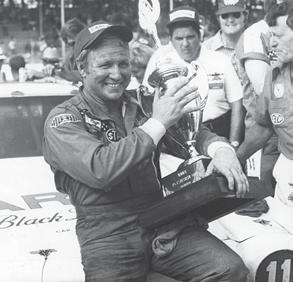
Sept. 29 Martinsville Speedway Earl Ross
Oct. 6 Charlotte Motor Speedway David Pearson
Oct. 20 North Carolina Speedway David Pearson
Nov. 24 Ontario Motor Speedway Bobby Allison
BEST DRIVER
RICHARD PETTY DEFENDED HIS 1973 Daytona 500 victory and went on to establish himself as the driver to beat for 1974. The Randleman, N.C., native mastered the superspeedways and short tracks, winning one-third of the Cup Series races on the 30-race schedule. His famed fluorescent red and Petty blue Dodge rolled down pit road to Victory Lane 10 times under the direction of crew chief Dale Inman. Petty collected his fifth of seven championships that season.
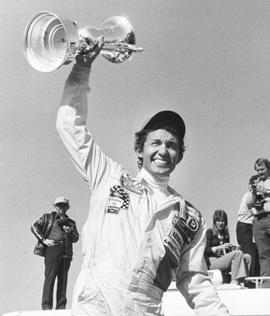
BEST RACE

IN JULY’S FIRECRACKER 400 AT Daytona International Speedway, David Pearson hit the brakes during the final lap, allowing Richard Petty to take the lead. As the two drivers came off of turn four, Pearson dropped low and drafted past Petty at the stripe to take the win by a mere car length. The lead changed 45 times, a race record that stood until 2010. Cale Yarborough and Buddy Baker officially tied for third.
TOP CARS

RICHARD PETTY’S
No. 43 Dodge Charger collected 10 victories, 23 top-10 finishes and the series championship.
Cale Yarborough’s Chevrolet Chevelle had one less top-five finish than Petty, and Yarborough ended up second.
78 THROUGH THE YEARS 1974 74
PRESIDENT: RICHARD NIXON NO. 1 SONG: “THE WAY WE WERE,” BY BARBARA STREISAND TOP HEADLINES: PRESIDENT NIXON RESIGNS OVER WATERGATE SCANDAL; OIL EMBARGO CREATES LONG LINES AT GAS PUMPS
The 1974 NASCAR Sprint Cup Series season was tested heavily by inflation, high interest rates, the Arab oil embargo and the ever-rising cost of auto racing. Each created difficult challenges for competitors and fans to overcome.
Petty Wins a Baker’s Dozen
Wheeling his familiar No. 43 Dodge, Richard Petty was clearly the class of the NASCAR Cup Series field in 1975 as he recorded 13 wins and 24 top-10 finishes in 30 races.
The 1975 Cup Series season was a year in which car owners were starting to feel the financial pinch of fielding professional racing teams. Top name owners, such as Junior Johnson, Bud Moore, Petty Enterprises and Roger Penske, had made money in the sport but were not willing to sink all of their hard-earned profits back into their teams.
To offset the ever-increasing costs of racing, NASCAR addressed the problem with what was called the Awards and Achievements Plan.
NASCAR founder “Big” Bill France introduced a program where additional money, aside from prize money, would be paid to those who fielded cars in a set number of races. In other words, it was the rebirth of appearance money – but on a larger scale and it was paid to the top teams, those the fans paid to see. In some cases, track promoters would help with the costs.
Also, the points system was changed for the fifth time in series history. Each race now carried equal point value with bonus points paid – a NASCAR first. Five points were awarded for leading the most laps in each race and five bonus points were also paid for leading at least one lap.
Petty accumulated 722 more points than Dave Marcis to claim his sixth series championship.
Petty was questioned about retirement, having won so much in the sport but his answer ended all speculation, saying in part, “As long as you’re winning, you’re afraid to even think about quitting.”
SEASON RECAP
DATE LOCATION WINNER
Jan. 19 Riverside International Raceway Bobby Allison
Feb. 16 Daytona International Speedway Benny Parsons
Feb. 23 Richmond Raceway Richard Petty
March 2 Rockingham Speedway Cale Yarborough
March 16 Bristol Motor Speedway Richard Petty
March 23 Atlanta Motor Speedway Richard Petty
April 6 North Wilkesboro Speedway Richard Petty
April 13 Darlington Raceway Bobby Allison
April 27 Martinsville Speedway Richard Petty
May 4 Talladega Superspeedway Buddy Baker
May 10 Fairgrounds Speedway Nashville Darrell Waltrip
May 19 Dover Motor Speedway David Pearson
May 25 Charlotte Motor Speedway Richard Petty
June 8 Riverside International Raceway Richard Petty
June 15 Michigan International Speedway David Pearson
July 4 Daytona International Speedway Richard Petty
July 20 Fairgrounds Speedway Nashville Cale Yarborough
Aug. 3 Pocono Raceway David Pearson
Aug. 17 Talladega Superspeedway Buddy Baker
Aug. 24 Michigan International Speedway Richard Petty
Sept. 1 Darlington Raceway Bobby Allison
Sept. 14 Dover Motor Speedway Richard Petty
Sept. 21 North Wilkesboro Speedway Richard Petty
Sep. 28 Martinsville Speedway Dave Marcis
Oct. 5 Charlotte Motor Speedway Richard Petty
Oct. 12 Richmond Raceway Darrell Waltrip
Oct. 19 Rockingham Speedway Cale Yarborough
Nov. 2 Bristol Motor Speedway Richard Petty
Nov. 9 Atlanta Motor Speedway Buddy Baker
Nov. 23 Ontario Motor Speedway Buddy Baker
PRESIDENT: GERALD FORD NO. 1 AT THE BOX OFFICE: ONE FLEW OVER THE CUCKOO’S NEST NO. 1 SONG: “LOVE WILL KEEP US TOGETHER” BY CAPTAIN AND TENNILLE GALLON OF GAS: 57 CENTS POP CULTURE: IN APRIL, CHILDHOOD FRIENDS BILL GATES AND PAUL ALLEN FOUNDED MICROSOFT, WITH GATES AS THE CEO.
BEST DRIVER
RICHARD PETTY, DRIVER OF THE NO. 43
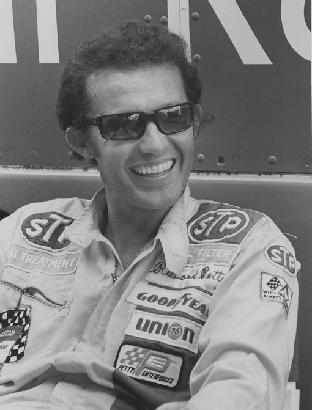
Petty Enterprises Dodge, collected 13 Cup Series victories, including the Coca-Cola 600 at Charlotte Motor Speedway. Petty was quite successful at other NASCAR tracks but not so much at Charlotte, winning there only five times during his career. All other drivers that season could only win in low single digits throughout the 30-race schedule. Buddy Baker was the next highest in the win column with four.
BEST RACE
DURING THE CLOSING LAPS OF THE Daytona 500, David Pearson looked to have the race won when he spun on the backstretch while trying to avoid a slower car. As a result, second-place Benny Parsons inherited the lead and pulled off the Cinderella victory of the season while driving for team owner L.G. Dewitt. The 1973 Cup Series champion was a true fan favorite, having pulled off a miraculous win in NASCAR’s biggest race.
BEST RACE
RICHARD PETTY’S NO. 43 Petty Enterprises Dodge won 13 times and had 24-top 10 finishes in that season’s 30 races.
Driving the No 15 Bud Moore Engineering Ford, Buddy Baker accumulated four wins and 13 top-10 results in 23 starts.
79 75 1975
Yarborough’s First Title


Cale Yarborough and Richard Petty proved they were the top championship contenders of the 1976 NASCAR Cup Series season as the superstars combined to win 12 of the 30 series races.
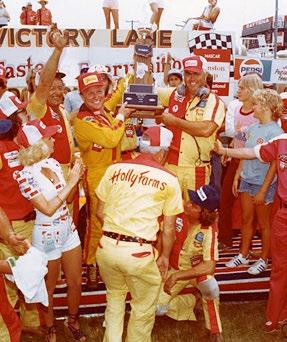
Heading into his fourth season with team owner Junior Johnson, Yarborough was poised to finally collect his first NASCAR Cup Series championship in his 18th year of competition at stock car racing’s highest level.
The Timmonsville, South Carolina, resident had built a strong relationship with Johnson, a former driver with 50 NASCAR Cup Series victories of his own. The two motorsports icons joined forces prior to the 1973 season.
Yarborough won 14 times during the team’s first two seasons, but he faced many disappointments through engine failures and crashes during the 1975 campaign. The championship chemistry finally came together in 1976, however, producing nine victories, 22 top-five finishes and 23 top-10 result along with two pole positions.
Yarborough’s biggest triumph that year came at Daytona International Speedway on July 4, 1976, as he beat David Pearson to the checkered flag by eight seconds. Another of his superspeedway victories came on Sept. 16 at Dover International Speedway when he outran Petty after starting from the pole.

With legendary crew chief Herb Nab at his side, Yarborough finished 195 points ahead of Petty in the season’s official point standings. Yarborough’s Chevrolets were equipped with engines built by Robert Yates, a future championship Cup Series team owner and Hall of Fame inductee.
Yarborough added Cup Series championships in 1977 and 1978 and scored 55 of his 83 career victories with Johnson’s operation before leaving at the end of the 1980 season to run select events.
SEASON RECAP
DATE LOCATION WINNER
Jan. 18
Riverside International Raceway David Pearson
Feb. 15 Daytona International Speedway David Pearson
Feb. 29 Rockingham Speedway Richard Petty
March 7 Richmond Raceway Dave Marcis
March 14 Bristol Motor Speedway Cale Yarborough
March 21 Atlanta Motor Speedway David Pearson
April 4 North Wilkesboro Speedway Cale Yarborough
April 11 Darlington Raceway David Pearson
April 25 Martinsville Speedway Darrell Waltrip
May 2 Talladega Superspeedway Buddy Baker
May 8 Fairgrounds Speedway Nashville Cale Yarborough
May 16 Dover International Speedway Benny Parsons
May 30 Charlotte Motor Speedway David Pearson
June 13 Riverside International Raceway David Pearson
June 20 Michigan International Speedway David Pearson
July 4 Daytona International Speedway Cale Yarborough
July 17 Fairgrounds Speedway Nashville Benny Parsons
August 1 Pocono Raceway Richard Petty
August 8 Talladega Superspeedway Dave Marcis
August 22 Michigan International Speedway David Pearson
August 29 Bristol Motor Speedway Cale Yarborough
Sept. 6 Darlington Raceway David Pearson
Sept. 12 Richmond Raceway Cale Yarborough
Sept. 19 Dover International Speedway Cale Yarborough
Sept. 26 Martinsville Speedway Cale Yarborough
Oct. 3 North Wilkesboro Speedway Cale Yarbrough
Oct.10 Charlotte Motor Speedway Donnie Allison
Oct. 24 Rockingham Speedway Richard Petty
Nov. 7 Atlanta Motor Speedway Dave Marcis
Nov. 21 Ontario Motor Speedway David Pearson
BEST DRIVER
CALE YARBOROUGH, DRIVING THE NO. 11 CHEVROlet owned by Junior Johnson, logged nine victories and secured his first NASCAR Cup Series championship. Yarborough’s win total included consecutive victories at Richmond, Dover, Martinsville and North Wilkesboro. His average start of fifth and average finish of eighth proved he was a consistent frontrunner. David Pearson actually won more races, 10, but was not a title threat as he only ran 22 of the series’ 30 events.
80 THROUGH THE YEARS 76
PRESIDENT: GERALD FORD NO. 1 AT THE BOX OFFICE: ROCKY NO. 1 SONG: “SILLY LOVE SONGS” BY WINGS GALLON OF GAS: 59¢ POP CULTURE: APPLE COMPUTER CO. IS FOUNDED BY STEVE JOBS AND STEVE WOZNIAK
1976
Two in a Row for Yarborough
Cale Yarborough and his Junior Johnson and Associates crew claimed the NASCAR Cup Series championship for the second consecutive season in 1977, as the driver from Timmonsville, South Carolina, visited Victory Lane nine times that year.
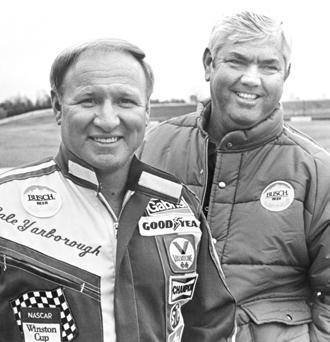
After enjoying an impressive 1976 Cup Series season that required only firing his engine to secure the Cup Series title in the final race of the year at Ontario Motor Speedway, Yarborough was ready to repeat as champion for 1977.
The hard-nosed racer joined Johnson’s team in 1973. He immediately began winning races and established himself as a solid title contender. However, in 1974 and ’75, mechanical issues arose that translated to too many losses in Cup Series points, dashing the team’s championship aspirations.
But the magic eventually came together and in 1977 veteran crew chief Herb Nab helped orchestrate the team’s second consecutive championship run.
Yarborough scored a total of 5,000 championship points over 30 races, besting Richard Petty by 386 points at season’s end. Amazingly, the No. 11 Chevrolet was running at the checkered flag in every race. Yarborough was virtually unstoppable with his worst finish of the year being a 24th-place result in May at Charlotte Motor Speedway.
Yarborough’s nine wins included the Daytona 500 with six of the triumphs coming on short tracks. His reputation as a tenacious driver shined through, as he completed 9,269 of the 10,010 scheduled laps while leading 3,198 of them. His 427-cubic-inch engines were built by Robert Yates, a future championship team owner.
Yarborough’s on-track performance and off-track persona made him a fan favorite.
SEASON RECAP
DATE LOCATION WINNER
Jan. 16 Riverside International Raceway David Pearson
Feb. 20 Daytona International Speedway Cale Yarborough
Feb. 27 Richmond Raceway Cale Yarborough
Mar. 13 Rockingham Speedway Richard Petty
Mar. 20 Atlanta Motor Speedway Richard Petty
Mar. 27 North Wilkesboro Speedway Cale Yarborough
April 3 Darlington Raceway Darrell Waltrip
April 17 Bristol Motor Speedway Cale Yarborough
April 24 Martinsville Speedway Cale Yarborough
May 1 Talladega Superspeedway Darrell Waltrip
May 7 Fairgrounds Speedway Nashville Benny Parsons
May 15 Dover Motor Speedway Cale Yarborough
May 29 Charlotte Motor Speedway Richard Petty
June 12 Riverside International Raceway Richard Petty
June 19 Michigan International Speedway Cale Yarborough
July 4 Daytona International Speedway Richard Petty
July 16 Fairground Speedway Nashville Darrell Waltrip
July 31 Pocono Raceway Benny Parsons
Aug. 7 Talladega Superspeedway Donnie Allison
Aug. 22 Michigan International Speedway Darrell Waltrip
Aug. 28 Bristol Motor Speedway Cale Yarborough
Sept. 5 Darlington Raceway David Pearson
Sept. 11 Richmond Raceway Neil Bonnett
Sept. 18 Dover Motor Speedway Benny Parsons
Sept. 25 Martinsville Speedway Cale Yarborough
Oct. 2 North Wilkesboro Speedway Darrell Waltrip
Oct. 9 Charlotte Motor Speedway Benny Parsons
Oct. 23 Rockingham Speedway Donnie Allison
Nov. 6 Atlanta Motor Speedway Darrell Waltrip
Nov. 20 Ontario Motor Speedway Neil Bonnett
BEST DRIVER
CALE YARBOROUGH, DRIVER OF THE NO.

11 Junior Johnson and Associates Chevrolet, dominated the 1977 season by visiting Victory Lane nine times. The team’s season came together in stellar fashion with nearly flawless execution on the race track and guidance from team owner Junior Johnson, a former driver with 50 wins of his own. With Johnson and Yarborough’s aggressive driving styles closely matched, their personal chemistry was also close. Minimal communication was needed to find success.
BEST RACE
ON AUG. 7, 1977 AT TALLADEGA Superspeedway, Donnie Allison vacated his Hoss Ellington Racing Chevrolet after becoming sick. Darrell Waltrip, who had fallen out of the race with engine issues in his DiGard Racing Chevrolet, was asked to relief drive for Allison with 23 laps remaining. Waltrip won the race but Allison got credit for the victory. It was the last time in NASCAR history that a driver won a race for another driver.
81 1977 77
PRESIDENT: JIMMY CARTER NO. 1 AT THE BOX OFFICE: STAR WARS EP. IV: A NEW HOPE NO. 1 SONG:“TONIGHT’S THE NIGHT” BY ROD STEWART GALLON OF GAS: 62 CENTS
POP CULTURE: ELVIS PRESLEY DIES AT GRACELAND, HIS MEMPHIS, TENNESSEE, HOME. HE WAS 42.
Hat Trick for Cale
Drivers Cale Yarborough and Bobby Allison proved they were the top championship contenders during the 1978 NASCAR Cup Series campaign, winning a combined 15 of 29 races throughout the season.
With back-to-back championship efforts behind him at the start of 1978, Cale Yarborough was poised to become the first driver in NASCAR’s then 29-year history to win three consecutive Cup Series titles.
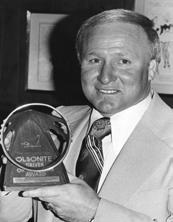
The Timmonsville, South Carolina, resident was in his sixth season with team owner Junior Johnson and had built a strong, winning relationship with the team from Ingle Hollow, North Carolina.
Fellow drivers had a difficult time keeping Yarborough out of Victory Lane, as he won 10 times on short tracks, road courses and superspeedways. His closest rival, 1978 Daytona 500 winner Bobby Allison, only scored half as many victories before finishing second in the point standings. Allison, driving a Ford owned by Bud Moore, logged 14 top-five finishes but couldn’t find the consistency to go headto-head with Yarborough.
Yarborough’s biggest triumph of the season came on Sept. 4 in the prestigious Southern 500 at his home track, Darlington Raceway. It was his fourth of five-career victories in the Labor Day classic at the legendary egg-shaped South Carolina track.
Darrel Waltrip won six times for DiGard Racing but failed to finish nine races. David Pearson and Wood Brothers Racing found the win column only four times, while Richard Petty went winless with a newly designed Dodge Magnum that he eventually parked and fielded Chevrolets for the first time in his career.
Yarborough held the record for consecutive championships until seven-time Cup Series
titlist Jimmie Johnson logged his fourth championship in a row with Hendrick Motorsports in 2009.
SEASON RECAP
DATE LOCATION WINNER
Jan. 22 Riverside International Raceway Cale Yarborough
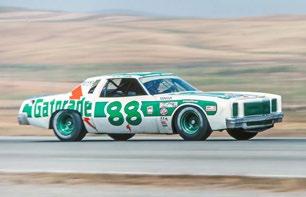
Feb.19 Daytona International Speedway Bobby Allison
Feb. 26 Richmond Raceway Benny Parsons
March 5 Rockingham Speedway David Pearson
March 19 Atlanta Motor Speedway Bobby Allison
April 2 Bristol Motor Speedway Darrell Waltrip
April 9 Darlington Raceway Benny Parsons
April 16 North Wilkesboro Speedway Darrell Waltrip
April 23 Martinsville Speedway Darrell Waltrip
May 14 Talladega Superspeedway Cale Yarborough
May 21 Dover International Speedway David Pearson
May 28 Charlotte Motor Speedway Darrell Waltrip
June 3 Fairgrounds Speedway – Nashville Cale Yarborough
June 11 Riverside International Raceway Benny Parsons
June 18 Michigan International Speedway Cale Yarborough
July 4 Daytona International Speedway David Pearson
July 15 Fairgrounds Speedway – Nashville Cale Yarborough
July 30 Pocono Raceway Darrell Waltrip
Aug. 6 Talladega Superspeedway Lennie Pond
Aug. 20 Michigan International Speedway David Pearson
Aug. 26 Bristol Motor Speedway Cale Yarborough
Sept. 4 Darlington Raceway Cale Yarborough
Sept. 10 Richmond Raceway Darrell Waltrip
Sept. 17 Dover International Speedway Bobby Allison
Sept. 24 Martinsville Speedway Cale Yarborough
Oct. 1 North Wilkesboro Speedway Cale Yarborough
Oct. 8 Charlotte Motor Speedway Bobby Allison
Oct. 22 Rockingham Speedway Cale Yarborough
Nov. 5 Atlanta Motor Speedway Donnie Allison
Nov. 19 Ontario Motor Speedway Bobby Allison
PRESIDENT: JIMMY CARTER NO. 1 SONG: “SHADOW DANCING” BY ANDY GIBB NO. 1 BOX OFFICE: GREASE


BEST DRIVER
CALE YARBOROUGH, DRIVING JUNIOR Johnson’s potent Chevrolet, logged 10 victories and secured his third consecutive NASCAR Cup Series championship. His consistent 23 top-five finishes throughout the 30-race season paved the way for an incredible season of success. Yarborough’s talent, coupled with cars provided by crew chief Tim Brewer and the No. 11 crew, meant only needing to start the season finale at California’s Ontario Motor Speedway to earn the title.
BEST RACE
AT THE 2.66-MILE TALLADEGA Superspeedway in Alabama, Lennie Pond drove car owner Harry Ranier’s No. 54 Oldsmobile to the surprise victory of the season. A crowd of 60,000 strong enjoyed 67 lead changes among eight drivers. Pond, of Ettrick, Virginia, was ahead of second-place Donnie Allison by a mere two car lengths as they crossed under the checkered flag. Pond led a total of 22 laps in the 188-lap event, including the final four.

TOP CARS
CALE YARBORough’s No. 11 Chevrolet Monte Carlo owned by Junior Johnson won 10 Cup Series races and claimed the 1978 championship.
Darrell Waltrip’s No. 88 DiGard Racing Chevrolet Monte Carlo topped six premier series races and finished third in the point standings.
82 THROUGH THE YEARS 78
Petty Edges Waltrip for No. 7
Switching between an Oldsmobile and a Chevrolet, Richard Petty added a seventh NASCAR Cup Series championship trophy to his collection. Petty won five times and had 27-top-10 finishes in 31 starts.
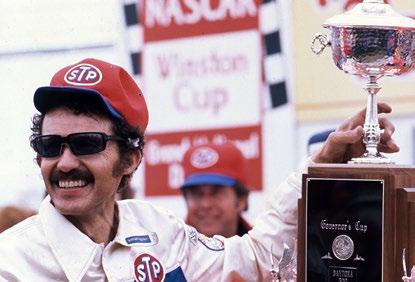
The 1979 Cup Series season proved to be one of NASCAR’s most exciting, even though officials of the sport didn’t anticipate such a fate prior to the start of the Daytona 500 on Sunday, Feb. 18.
That race, however, ended with a fight between Donnie Allison and Cale Yarborough after they crashed out while battling for the lead on the final lap. Allison’s older brother, Bobby, joined the fray and a national TV audience, many trapped in their homes by a massive east coast snowstorm, was introduced to the world of NASCAR.
Petty won his sixth of seven Daytona 500s in storybook fashion over Darrell Waltrip and A.J. Foyt. Petty had just undergone major stomach surgery two weeks earlier and was told by his doctors not to race.
Also during the season, rookie-of-the-year Dale Earnhardt made his presence known and David Pearson split from Wood Brothers Racing following an unceremonious miscue on pit road at Darlington Raceway in the spring. Subbing for the injured Earnhardt in Rod Osterlund’s No. 2 Chevrolet during the Southern 500 at Darlington in September, Pearson claimed his third victory in the prestigious race.
Petty emerged with a record seventh NASCAR Cup Series championship, besting Waltrip and DiGard Racing in the final race of the season at Ontario Motor Speedway by a mere 13 points. Petty’s fifth-place finish in the final race to Waltrip’s eighth-place run secured the title.
SEASON RECAP
DATE LOCATION WINNER
Jan. 14 Riverside International Raceway Darrell Waltrip
Feb. 18 Daytona International Speedway Richard Petty
March 4 Rockingham Speedway Bobby Allison
March 11 Richmond Raceway Cale Yarborough
March 18 Atlanta Motor Speedway Buddy Baker
March 25 North Wilkesboro Speedway Bobby Allison
April 1 Bristol Motor Speedway Dale Earnhardt
April 8 Darlington Raceway Darrell Waltrip
April 22 Martinsville Speedway Richard Petty
May 6 Talladega Superspeedway Bobby Allison
May 12 Fairgrounds Speedway Nashville Cale Yarborough
May 20 Dover Motor Speedway Neil Bonnett
May 27 Charlotte Motor Speedway Darrell Waltrip
June 3 Texas World Speedway Darrell Waltrip
June 10 Riverside International Raceway Bobby Allison
June 17 Michigan International Speedway Buddy Baker
July 4 Daytona International Speedway Neil Bonnett
July 14 Fairgrounds Speedway Nashville Darrell Waltrip
July 30 Pocono Raceway Cale Yarborough
Aug. 5 Talladega Superspeedway Darrell Waltrip
Aug. 19 Michigan International Speedway Richard Petty
Aug. 25 Bristol Motor Speedway Darrell Waltrip
Sept. 3 Darlington Raceway David Pearson
Sept. 9 Richmond Raceway Bobby Allison
Sep. 16 Dover Motor Speedway Richard Petty
Sept. 23 Martinsville Speedway Richard Petty
Oct. 7 Charlotte Motor Speedway Cale Yarborough
Oct.14 North Wilkesboro Speedway Benny Parsons
Oct. 21 Rockingham Speedway Richard Petty
Nov. 4 Atlanta Motor Speedway Neil Bonnett
Nov. 18 Ontario Motor Speedway Benny Parsons
BEST DRIVER
DRIVING THE NO. 43 PETTY ENTERPRISES entry, Richard Petty logged five NASCAR Cup Series victories and 27- top-10 results en route to his seventh series championship. At age 42, Petty was still at the top of his game, winning races and contending for NASCAR’s top prize. He and crew chief Dale Inman placed the famed Petty blue and fluorescent red machine at the front to lead 1,149 laps during the 1979 season.
BEST RACE
NO QUESTION, THE 1979 DAYTONA 500 introduced NASCAR racing to millions of first-time viewers who watched the flag-to-flag coverage on CBS. A massive east coast snowstorm and the outcome of the race combined to expose the sport to a sizeable new audience. Initially considered a blackeye for NASCAR, the fight among Cale Yarborough, Donnie Allison and Bobby Allison at the end of the race was a milestone moment for the sport.
TOP CARS
RICHARD PETTY’S NO. 43
Petty Enterprises Oldsmobile/Chevrolet won five races and notched 27 top-10 results in 31 starts. Darrell Waltrip’s No. 88 DiGard Racing Oldsmobile/ Chevrolet went to Victory Lane seven times and had 22 top-10 finishes.
83 1979 79
PRESIDENT: JIMMY CARTER NO. 1 AT THE BOX OFFICE: APOCALYPSE NOW GALLON OF GAS: 90 CENTS MOVIES TO WATCH: 10 AND ALIEN NO. 1 SONG: “MY SARONA” BY THE KNACK POP CULTURE: THE DUKES OF HAZARD FIRST AIRED ON CBS
Newcomer Dale Earnhardt Surprises
During 1980, Dale Earnhardt showed tremendous talent by becoming NASCAR’s Cup Series champion in only his second full season. The native of Kannapolis, North Carolina, won five races on short tracks and superspeedways.

After earning NASCAR’s rookie-of-theyear award in 1979, second-generation driver Dale Earnhardt enjoyed one of his best seasons the following year. His No. 2 Rod Osterlund-owned entries were being tuned by veteran crew chief Jake Elder and running strong. Earnhardt and Elder were contenders at every event that season and they went to Victory Lane at Atlanta Motor Speedway, Bristol Motor Speedway, Nashville Fairgrounds Speedway, Martinsville Speedway and Charlotte Motor Speedway.
Cale Yarborough, driving for legendary car owner Junior Johnson, had won consecutive championships in 1976, ’77 and ’78 and he wanted a fourth title on his résumé. It was Earnhardt, however, who prevailed, leading the point standings throughout the 29-race season other than being second following the season-opening Daytona 500.
Yarborough logged six victories with 22 top-10 results, but crashes and engine issues in four of the 31 events kept him behind Earnhardt throughout the year with no real opportunities to close the gap. From the beginning of the season, Earnhardt faced criticism from other drivers for racing too aggressively. Many of the top stars of the era had discussions with him about toning down his often rough style of driving. Still, he won races and held his own, especially when the win was in sight.
Earnhardt capped his first of seven NASCAR Cup Series titles by finishing fifth in the season finale at California’s Ontario Motor Speedway. His consistent 19 topfive finishes and 24 top-10 results were enough to keep Yarborough’s effort’s solidly at bay.
BEST DRIVER
CALE YARBOROUGH, switching between an Oldsmobile and a Chevrolet owned by Junior Johnson, put together a strong season under the direction of crew chief Tim Brewer. The No. 11 team was either running up front or dealing with mechanical issues. Yarborough won six times and was in the title hunt for most of the season, but too many DNFs, including a cylinderhead issue at Richmond Raceway in the fall, ended his hopes of a fourth championship.
BEST RACE

ON APRIL 13, DAVID Pearson joined forces with team owner Hoss Ellington and won the Rebel 500 at Darlington Raceway, a track where he enjoyed so much success while driving for Wood Brothers Racing. The native of Spartanburg, South Carolina, led 99 of 367 laps on the tricky 1.366-mile oval as he held off Benny Parsons in the M.C. Anderson Racing Chevrolet by 3.3 seconds to seal his 10th-career victory at the track.
TOP CARS

SWITCHING BETWEEN an Oldsmobile and a Chevrolet, Cale Yarborough won six races for team owner and former driver Junior Johnson.
Dale Earnhardt wheeled the No. 2 entries owned by Rod Osterlund to five victories, 19 top-five finishes and 24 top-10 results.
SEASON RECAP
DATE LOCATION WINNER
Jan. 13 Riverside International Raceway Darrell Waltrip
Feb. 17 Daytona International Speedway Buddy Baker
Feb. 24 Richmond Raceway Darrell Waltrip
March 9 Rockingham Speedway Cale Yarborough
March 16 Atlanta Motor Speedway Dale Earnhardt
March 30 Bristol Motor Speedway Dale Earnhardt
April 13 Darlington Raceway David Pearson
April 20 North Wilkesboro Speedway Richard Petty
April 27 Martinsville Speedway Darrell Waltrip
May 4 Talladega Superspeedway Buddy Baker
May 10 Nashville Fairgrounds Speedway Richard Petty
May 18 Dover International Speedway Bobby Allison
May 25 Charlotte Motor Speedway Benny Parsons

June 1 Texas World Speedway Cale Yarbrough

June 8 Riverside International Raceway Darrell Waltrip
June 15 Michigan International Speedway Benny Parsons
July 4 Daytona International Speedway Bobby Allison
July 12 Nashville Fairgrounds Speedway Dale Earnhardt
July 27 Pocono Raceway Neil Bonnett
Aug. 3 Talladega Superspeedway Neil Bonnett
Aug. 17 Michigan International Speedway Cale Yarborough
Aug. 23 Bristol Motor Speedway Cale Yarborough
Sept. 1 Darlington Raceway Terry Labonte
Sept. 7 Richmond Raceway Bobby Allison
Sept. 14 Dover International Speedway Darrell Waltrip
Sept. 21 North Wilkesboro Speedway Bobby Allison
Sept. 28 Martinsville Speedway Dale Earnhardt
Oct. 5 Charlotte Motor Speedway Dale Earnhardt
Oct. 19 Rockingham Speedway Cale Yarborough
Nov. 2 Atlanta Motor Speedway Cale Yarborough
Nov. 15 Ontario Motor Speedway Benny Parsons
84 THROUGH THE YEARS 80
1980 PRESIDENT Jimmy Carter NO. 1 AT THE BOX OFFICE The Empire Strikes Back NO. 1 SONG “Call Me” By Blondie POP CULTURE Cable News Network begins broadcasting on June 1
OF GAS $1.19
GALLON
Waltrip & Johnson a Potent Combo
Darrell Waltrip, wheeling the No. 11 Junior Johnson and Associates Buick, notched 12 wins and 25 top-10 finishes in 1981 as he dominated during his first season of driving for the powerhouse operation from Ronda, North Carolina.
BEST DRIVER DRIVING JUNIOR
Johnson’s No. 11 Buick, Darrell Waltrip recorded 12 NASCAR Cup Series victories and 25 top-10 finishes in 31 races. The native of Owensboro, Kentucky, enjoyed one of his best seasons in his first year with Johnson, who won 50 races before hanging up his helmet. Waltrip’s expertise as a driver coupled with Johnson’s experience both on and off the track made for a nearly unstoppable combination.
BEST RACE
SEASON RECAP
DATE LOCATION WINNER
Jan. 11 Riverside International Raceway
Feb. 15 Daytona International Speedway
Allison
Petty
Feb. 22 Richmond Raceway Darrell Waltrip
March 1 Rockingham Speedway Darrell Waltrip
March 15 Atlanta Motor Speedway
March 29 Bristol Motor Speedway
April 5 North Wilkesboro Speedway
April 12 Darlington Raceway
Yarborough
Waltrip
Petty
Waltrip
April 26 Martinsville Speedway Morgan Shepherd
May 3 Talladega Superspeedway Bobby Allison
May 9 Fairgrounds Speedway Nashville Benny Parsons
May 17 Dover Motor Speedway Jody Ridley
May 24 Charlotte Motor Speedway
June 7 Texas World Speedway
Allison
Parsons
June 14 Riverside International Raceway Darrell Waltrip
June 21 Michigan International Speedway Bobby Allison
July 4 Daytona International Speedway Cale Yarborough
July 11 Fairgrounds Speedway Nashville Darrell Waltrip
July 26 Pocono Raceway Darrell Waltrip
Aug. 2 Talladega Superspeedway Ron Bouchard
Aug. 16 Michigan International Speedway Richard Petty
Aug. 22 Bristol Motor Speedway
Waltrip
Sept. 7 Darlington Raceway Neil Bonnett
Sept. 13 Richmond Raceway
Parsons
On Sept, 9, 1980, three-time NASCAR Cup Series champion Cale Yarborough announced he would be cutting back to a limited schedule. That meant moving from Junior Johnson’s team to a part-time Cup Series schedule with team owner M.C. Anderson.

Darrell Waltrip had already won 27 Cup Series races since joining the circuit in 1972, two in his own car and 25 in the No. 88 entry fielded by DiGard Racing, which was co-owned by Bill Gardner and Mike Di Prospero. Yarborough went to Waltrip and suggested he contact Johnson about the ride, even though the two drivers were bitter rivals.
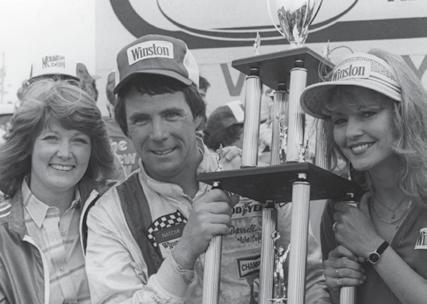
In order to make the move, Waltrip had to buy out the contract he signed with DiGard Racing. After several months of back-and-forth battles via the media, the issue was finally resolved with Waltrip reportedly paying DiGard $350,000, which opened the door for him to drive for Johnson. Ricky Rudd was hired to replace Waltrip at DiGard.
Waltrip felt as if he had been freed of a difficult situation and was a new man with a championship-caliber team. He and crew chief Tim Brewer quickly developed solid chemistry and were the team to beat throughout the 31-race Cup Series schedule.
Waltrip won six short track races, five superspeedway events and one road course race. The team’s Buick was strong everywhere it competed and was one step ahead of the Harry Ranier-owned Buick driven by Bobby Allison. At the end of the season, Waltrip bested Allison by 53 points for the Cup Series championship.
ON AUG. 2, 1981, RON Bouchard, driver of the No. 47 Race Hill Farms Buick, was running third behind Darrell Waltrip and Terry Labonte on the final lap of the Talladega 500 at Talladega Superspeedway. While in Turn 3, Bouchard dropped low as Waltrip and Labonte battled for the victory. Bouchard ultimately stole the win by two feet as the trio reached the start-finish line. It was Bouchard’s lone victory of his sevenyear Cup Series career.
TOP CARS
DARRELL WALTRIP’S No. 11 Junior Johnson and Associates Buick won 12 times and posted 25 top-10 results in 31 starts.
Driving the No. 28 Buick for Harry Ranier Racing, Bobby Allison visited Victory Lane five times with 26 top-10 finishes.
Sept. 20 Dover Motor Speedway
Sept. 27 Martinsville Speedway
Oct. 4 North Wilkesboro Speedway
Oct. 11 Charlotte Motor Speedway
Nov. 1 Rockingham Speedway
Nov. 8 Atlanta Motor Speedway
Bonnett
Waltrip
Waltrip
Waltrip
Waltrip
Bonnett
Nov. 22 Riverside International Raceway Bobby Allison
PRESIDENT
Ronald Reagan
NO. 1 AT THE BOX OFFICE
Absence of Malice
NO. 1 SONG
“Bette Davis Eyes” by Kim Carnes
POP CULTURE
Sandra Day O’Connor became the first female appointed to serve on the U.S. Supreme Court.
GALLON OF GAS
$1.31
1981
85 81
Bobby
Richard
Cale
Darrell
Richard
Darrell
Bobby
Benny
Darrell
Benny
Neil
Darrell
Darrell
Darrell
Darrell
Neil
An Even Dozen for Waltrip
SEASON RECAP
DATE LOCATION WINNER
Feb. 14 Daytona International Speedway Bobby Allison
BEST DRIVER
DARRELL WALTRIP notched 12 victories with six coming on short tracks and six on superspeedways. He claimed his second series championship and it was his second year of winning 12 races. Waltrip led 3,028 of 9,455 laps completed. His average finish of 9.8 was hampered by eight DNFs in 30 starts.
BEST RACE

ON MAY 30, 1982, Neil Bonnett, driving the Wood Brothers Racing Ford, led 67 of 400 laps to win the World 600 at Charlotte Motor Speedway.
Feb. 21 Richmond Raceway Dave Marcis
March 14 Bristol Motor Speedway Darrell Waltrip
March 21 Atlanta Motor Speedway Darrell Waltrip
March 28 Rockingham Speedway Cale Yarborough
April 4 Darlington Raceway Dale Earnhardt
April 18 North Wilkesboro Speedway Darrell Waltrip
April 25 Martinsville Speedway Harry Gant
May 2 Talladega Superspeedway Darrell Waltrip
May 8 Fairgrounds Speedway Nashville Darrell Waltrip
May 16 Dover International Speedway Bobby Allison
May 30 Charlotte Motor speedway Neil Bonnett
June 6 Pocono Raceway Bobby Allison
June 13 Riverside International Raceway Tim Richmond
June 20 Michigan International Speedway Cale Yarborough
July 4 Daytona International Speedway Bobby Allison
July 10 Fairgrounds Speedway Nashville Darrell Waltrip
July 25 Pocono Raceway Bobby Allison
Aug. 1 Talladega Superspeedway Darrell Waltrip
Aug. 22 Michigan International Speedway Bobby Allison
Aug. 28 Bristol Motor Speedway Darrell Waltrip
Sept. 6 Darlington Raceway Cale Yarborough
Sept. 12 Richmond Raceway Bobby Allison
Sept. 19 Dover International Speedway Darrell Waltrip
Oct. 3 North Wilkesboro Speedway Darrell Waltrip
Oct. 10 Charlotte Motor Speedway Harry Gant
Oct. 17 Martinsville Speedway Darrell Waltrip
Oct. 31 Rockingham Speedway Darrell Waltrip
Nov. 7 Atlanta Motor Speedway Bobby Allison
Nov. 21 Riverside International Raceway Tim Richmond
PRESIDENT Ronld Reagan
Darrell Waltrip and Bobby Allison were the top contenders for the 1982 NASCAR Cup Series championship, collecting a combined 20 victories during the 30-race schedule.

Waltrip was in the second year of a three-year contract with former driver and team owner Junior Johnson. It was undoubtedly the best ride of his career as Waltrip claimed the 1981 championship with Johnson and carried strong momentum into the 1982 season.
Under the direction of crew chief Jeff Hammond, Junior Johnson and Associates was at the top of its game as Waltrip won 12 races and claimed seven poles.
Ironically, Allison had seen Waltrip defeat him for 1981 championship and wanted desperately to change the outcome. With Gary Nelson calling the shots from his pit box, Allison and the DiGard Racing team managed to log eight victories.
When Waltrip faltered, Allison prevailed and the same held true when Allison fell to the wayside. However, Waltrip won four of the final seven races and beat Allison by 72 points to captured his second consecutive series title.
The Alabama native wheeled the No. 21 Thunderbird around Bill Elliott with 13 laps remaining to collect the 11th of his 18 Cup Series victories.
TOP CARS
DRIVING THE NO. 11 Mt. Dew Buick fielded by Junior Johnson and Associates, Darrell Waltrip visited Victory Lane 12 times during the 1982 season.
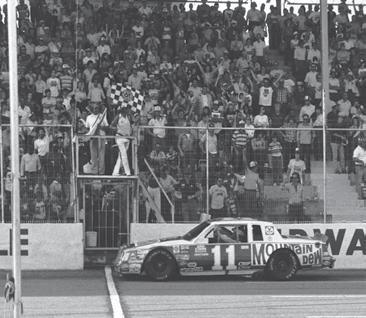
Bobby Allison, wheeling the No. 88 DiGard Racing Buick, won eight of the 30 NASCAR Cup Series races that season, including the prestigious Daytona 500.
NO. 1 AT THE BOX OFFICE
E.T. The Extra-Terrestrial
NO. 1 SONG “Physical”
By Olivia Newton John
POP CULTURE
Michael Jackson’s “Thriller” album is released

GALLON OF GAS
$1.22
86 THROUGH THE YEARS 82
1982
Finally, Allison’s a Champion
Driving the No. 22 car fielded by DiGard Racing, Bobby Allison posted six victories and 25 top-10 finishes in 30 races, as he finally edged rival Darrell Waltrip to claim the NASCAR Cup Series championship.
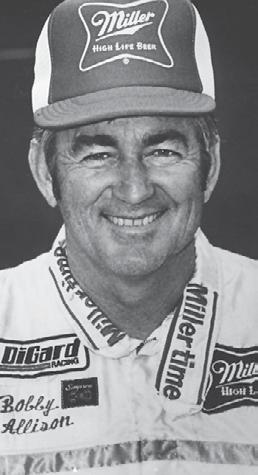

Heading into the 1983 Cup Series campaign, most everyone expected a repeat of the two previous seasons in which Allison and Waltrip dominated the championship headlines. Their extremely competitive battles for points and positions were the top story right down to the final race of both seasons, as a volley of verbal accusations kept the motorsports media busy churning out the respective sides of the story.
The year was new and Allison had a new look, new sponsor and a new car number. Even though his year began by destroying three cars during Speedweeks at Daytona and a 10th-place finish in the season-opening Daytona 500, Allison and the DiGard Racing team rebounded to win at Richmond Raceway the next week.
All told, Allison’s six wins offset his 25th-place finish at Atlanta, 34th-place result at Michigan and 22nd-place effort at Riverside, all due to mechanical issues. He had only two engine failures during the 30-race season.
Waltrip also logged six wins and had 25 top-10 finishes in a close statistical battle with Allison but suffered four DNFs during the year, which made the difference in the final points tally.
Allison had a 47-point advantage over Waltrip following the season finale at California’s Riverside International Raceway. In that race, Waltrip spun during the closing laps while battling Tim Richmond for the win and ended up sixth. Allison finished eighth in a conservative effort to secure the only Cup Series championship of his 25-year career.
BEST DRIVER
DRIVING THE NO. 22 DiGard Racing Buick/ Chevrolet, Bobby Allison collected six victories and 25 top-10 results during the 1983 Cup Series season. Allison was finally able to celebrate a series title after coming close in points on multiple occasions. He battled Darrell Waltrip the two previous seasons, as well as Richard Petty in 1972, and fallen short each time. With crew chief Gary Nelson calling the shots and engines built by Robert Yates, the title was finally his.
BEST RACE
RICHARD PETTY, driver of the No. 43 Petty Enterprises Pontiac, ended a 43race winless drought with a popular half-car length victory over Bill Elliott at Rockingham Speedway on March 18. It was the first Cup Series win for the seven-time champion since Aug. 16, 1981, at Michigan International Speedway. Petty took the lead from Elliott with 29 laps remaining and drove defensively to hold off the popular Georgia driver for the victory.
TOP CARS
BOBBY ALLISON’S NO.
22 DiGard Racing Buick/ Chevrolet won six races and had 25 top-10 finishes in 30 starts. The No. 11 Junior Johnson and Associates Buick/Chevrolet driven by Darrell Waltrip also won six times with 25 top-10 results.
SEASON RECAP
Sept.
Sept.
Oct.
Oct.
Nov.
PRESIDENT Ronald Reagan
NO. 1 AT THE BOX OFFICE Star Wars: Episode VIReturn of the Jedi
NO. 1 SONG
“Every Breath You Take” by The Police
POP CULTURE
Mario Bros. was first released as an arcade gam ein Japan.
GALLON OF GAS $1.23
1983
87 83
DATE LOCATION WINNER Feb. 20 Daytona International Speedway Cale Yarborough
27 Richmond Raceway Bobby Allison March 13 Rockingham Speedway Richard Petty March 27 Atlanta Motor Speedway Cale Yarborough
10 Darlington Raceway Harry Gant
17 North Wilkesboro Speedway Darrell Waltrip
24 Martinsville Superspeedway Darrell Waltrip
1 Talladega Superspeedway Richard Petty
7 Fairgrounds Speedway Nashville Darrell Waltrip
15 Dover Motor Speedway Bobby Allison
21 Bristol Motor Speedway Darrell Waltrip May 29 Charlotte Motor Speedway Neil Bonnett June 5 Riverside International Raceway Ricky Rudd June 12 Pocono Raceway Bobby Allison June 19 Michigan International Speedway Cale Yarborough July 4 Daytona International Speedway Buddy Baker July 16 Fairgrounds Speedway Nashville Dale Earnhardt July 24 Pocono Raceway Tim Richmond July 31 Talladega Superspeedway Dale Earnhardt
21 Michigan International Speedway Cale Yarborough
27 Bristol Motor Speedway Darrell Waltrip
5 Darlington Raceway Bobby Allison
11 Richmond Raceway Bobby Allison
Feb.
April
April
April
May
May
May
May
Aug.
Aug.
Sept.
Sept.
18 Dover Motor Speedway Bobby Allison
25 Martinsville Speedway Ricky Rudd
2 North Wilkesboro Speedway Darrell Waltrip
9 Charlotte Motor Speedway Richard Petty
30 Rockingham Speedway Terry Labonte
Oct.
6 Atlanta Motor Speedway Neil Bonnett
20 Riverside International Raceway Bill Elliott
Nov.
Labonte Nets Title
The 1984 NASCAR Cup Series season featured two very popular drivers battling for their first series championship, as two relatively small teams bested the larger powerhouse organizations throughout the 30-race schedule.
BEST DRIVER
DARRELL WALTRIP, driver of the Junior Johnson and Associates No. 11 Chevrolet, collected seven of his 84-career victories during the 30race schedule. Victories at Bristol, Darlington, Nashville, Michigan, Richmond, Martinsville and North Wilkesboro offered promise toward claiming a third Cup Series title. However, Waltrip suffered through several poor finishes due to blown engines and mechanical issues that erased hopes of unseating Labonte’s title run. Waltrip returned to win his third-career NASCAR Cup Series championship in 1985.
BEST RACE
SEASON RECAP
DATE LOCATION WINNER
Feb. 19 Daytona International Speedway Cale Yarborough
Feb. 26 Richmond International Raceway Ricky Rudd
March 4 Rockingham Speedway Bobby Allison
March 18 Atlanta Motor Speedway Benny Parsons
April 1 Bristol Motor Speedway Darrell Waltrip
April 8 North Wilkesboro Speedway Tim Richmond
April 15 Darlington Raceway Darrell Waltrip
April 29 Martinsville Speedway Geoff Bodine
May 6 Talladega Superspeedway Cale Yarborough
May 12 Fairgrounds Speedway Nashville Darrell Waltrip
May 20 Dover International Speedway Richard Petty
May 27 Charlotte Motor Speedway Bobby Allison
June 3 Riverside International Raceway Terry Labonte
June 10 Pocono Raceway Cale Yarborough
June 17 Michigan International Speedway Bill Elliott
July 4 Daytona International Speedway Richard Petty
July 14 Fairgrounds Speedway Nashville Geoff Bodine
July 22 Pocono Raceway Harry Gant
July 29 Talladega Superspeedway Dale Earnhardt
Aug. 12 Michigan International Speedway Darrell Waltrip
Aug. 25 Bristol Motor Speedway Terry Labonte
Sept. 2 Darlington Raceway Harry Gant

Sept. 9 Richmond International Raceway Darrell Waltrip
Sept. 16 Dover International Speedway Harry Gant
Sept. 23 Martinsville Speedway Darrell Waltrip
Oct. 7 Charlotte Motor Speedway Bill Elliott
Oct. 14 North Wilkesboro Speedway Darrell Waltrip
Oct. 21 Rockingham Speedway Bill Elliott
The season began at Daytona International Speedway and ended on the road course in Riverside, California.
The quiet, yet popular Terry Labonte, a native of Corpus Christi, Texas, relied on the expertise of Dale Inman, NASCAR’s only eight-time Cup Series championshipwinning crew chief.
Chevrolet drivers led the win column at 13 with Labonte, Harry Gant, Dale Earnhardt, Darrell Waltrip, Bobby Allison and Benny Parsons going to Victory Lane. Among them, Waltrip won the most races with seven but finished sixth in points after suffering various problems throughput the season.
Cale Yarborough took Ford Motor Co. to Victory Lane three times with Tim Richmond giving Pontiac its lone win on the season.
Even though Labonte only collected victories at Riverside International Raceway on June 3 and Bristol Motor Speedway on Aug. 25, consistency in the form of 24 top-10 finishes placed him at the top of the point standings by season’s end.
The championship came down to Labonte and Gant, driver of Mach One Racing Chevrolet owned by actor Burt Reynolds and stuntman Hal Needham. Aside from finishing 29th at Riverside in June and 26th in the next to last race at Atlanta, Gant put together a string of 17 top10 finishes that included wins at Pocono, Darlington and Dover to climb within striking distance of Labonte. Gant’s eighth-place finish in the season finale was well back of Labonte’s third-place effort, however, sending the title in the Texan’s direction.
ON JULY 29, 1984, DALE Earnhardt, driver of the Richard Childress Racing Chevrolet, led a pack of cars 10 strong in a close finish at Talladega Superspeedway. In a race that featured 68 lead changes among 17 drivers, Earnhardt mastered the 2.66-mile track and held the lead on the final lap when Terry Labonte and Buddy Baker engaged in a fierce battle for second. It was Earnhardt’s first win of 1984 and the 10th of his career.
TOP CARS
TERRY LABONTE, driver of the No. 44 Chevrolet owned by Billy Hagan, was crowned champion with two wins and 24 top-10 finishes. Harry Gant, driver of the No. 33 Mach One Racing Chevrolet, finished second in points on the strength of three victories.
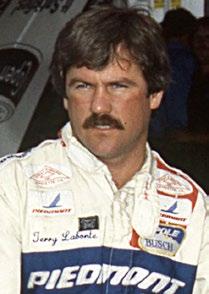


Nov. 11 Atlanta Motor Speedway Dale Earnhardt
Nov. 18 Riverside International Raceway Geoff Bodine
PRESIDENT Ronald Reagan
NO. 1 AT THE BOX OFFICE
Ghostbusters
NO. 1 SONG
“When Doves Cry” By Prince
POP CULTURE
Alex Trebek assumes his role as host of “Jeopardy!”


GALLON OF GAS $1.21
1984
88 THROUGH THE YEARS 84
Elliott Becomes
‘Million Dollar Bill’
The 1985 season was often described as intriguing and curious. Thanks to one particular racer from a small, north Georgia community, stock car racing was quickly gaining acceptance among fans of mainstream professional sports.
BEST DRIVER
BILL ELLIOTT ARRIVED at Daytona International Speedway in February 1985 determined to dominate the superspeedways. In the process, he and his brothers, Ernie Elliott (crew chief) and Dan Elliott (mechanic), won nearly half of the races on the 28race schedule. His famous red, white and gold No. 9 Ford rolled into Victory Lane 11 times, producing one of the most successful years in NASCAR’s modern era with 16 top-five finishes, 18 top-10 results and 11 pole positions.
BEST RACE
SEASON RECAP
Feb.
Feb.
March
March
April
April
April
May
May
May
June
June
June
July
July
July
Aug.
Aug.
Sept.
Sept.
Sept.
Sept.
Sept.
Oct.
Oct.
Nov.
As the season began, drivers and teams were eyeing an unprecedented bonus. R.J. Reynolds Tobacco Co., the sponsor of NASCAR’s premier series through its Winston brand, was offering a $1 million bonus to any driver who could win three of stock car racing’s four marquee events – the Daytona 500 at Daytona International Speedway, the Coca-Cola 600 at Charlotte Motor Speedway, the Winston 500 at Talladega Superspeedway and the Southern 500 at Darlington Raceway.
It seemed an impossible task given the series’ level of competition and, certainly, no one expected a small team from Dawsonville, Georgia, to meet the lofty challenge.
But Bill Elliott answered the call by winning the Daytona 500 in convincing fashion behind the wheel of a sleek and powerful No. 9 Ford Thunderbird owned by Michigan businessman Harry Melling. Elliott then fell short of the Coca-Cola 600 victory due to brake problems while Darrell Waltrip, in Junior Johnson’s No. 11 Chevrolet, won NASCAR’s longest race.
Round three was the Winston 500 and Elliott earned the pole starting position with a record qualifying lap of more than 205 mph. Brake problems early in the race saw him fall two laps behind, but he came roaring back to the claim the victory.
The finale of the four special events was the legendary Southern 500 in September. After holding off a hard-charging Cale Yarborough during the closing laps, Elliott claimed the victory and banked the $1 million bonus..

ELLIOTT’S VICTORY IN the Southern 500 was the greatest of the season and possibly the decade. He set up the springs and shocks on the team’s Ford himself, making sure it could handle the tricky and narrow track configuration for which Darlington Raceway is so famous. The Georgia native led 100 of the 367 laps and garnered international headlines after crossing under the checkered flag to collect a $1 million bonus for winning three of NASCAR’s most prestigious events in the same season.
TOP CARS
ELLIOTT’S 1985 No. 9 Ford set records and sparked interest in NASCAR around the world. Dale Earnhardt’s No. 3 Richard Childress Racing Chevrolet was the second-winningest car of 1985 with four wins and 16 top-10 finishes.
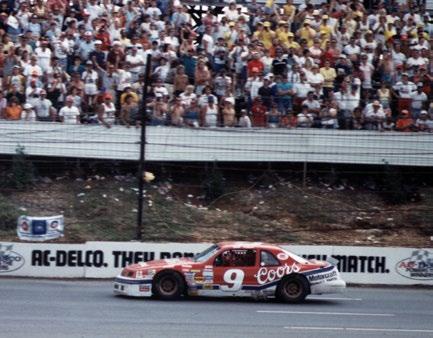
Nov.
PRESIDENT
Ronald Reagan
NO. 1 AT THE BOX OFFICE Beverly Hills Cop II
NO. 1 SONG
“We Are The World” by Michael Jackson and Lionel Richie
POP CULTURE
The first “The Simpsons” cartoon short was shown on the Tracey Ullman Show.
GALLON OF GAS $1.87
1985
89 85
DATE LOCATION WINNER
17 Daytona International Speedway Bill Elliott
24 Richmond International Raceway Dale Earnhardt
3 North Carolina Speedway Neil Bonnett
17 Atlanta
Bill Elliott
Motor Speedway
6 Bristol Motor Speedway Dale Earnhardt
Darlington
Bill Elliott
April 14
Raceway
Neil Bonnett
21 North Wilkesboro Speedway
Harry Gant
28 Martinsville Speedway
Bill Elliott
5 Talladega Superspeedway
Bill Elliott
19 Dover International Speedway
26 Charlotte
Darrell Waltrip
Motor Speedway
2 Riverside
Terry Labonte
International Raceway
9 Pocono
Bill Elliott
Raceway
16 Michigan International Speedway Bill Elliott
4 Daytona International Speedway Greg Sacks
21 Pocono Raceway Bill Elliott
28 Talladega Superspeedway Cale Yarborough
11 Michigan International Speedway Bill Elliott
Bristol
Dale Earnhardt
24
Motor Speedway
Bill Elliott
1 Darlington Raceway
Darrell Waltrip
8 Richmond International Raceway
Harry
15 Dover International Speedway
Gant
Dale Earnhardt
22 Martinsville Speedway
Harry Gant
29 North Wilkesboro Speedway
Cale Yarborough
6 Charlotte Motor Speedway
Darrell Waltrip
20 North Carolina Speedway
Bill Elliott
3 Atlanta Motor Speedway
Ricky Rudd
17 Riverside International Raceway
Title No. 2 for Earnhardt
Second-generation driver Dale Earnhardt wheeled the No. 3 Richard Childress Racing Chevrolet to victory five times during the 1986 season en route to his second NASCAR Cup Series championship.
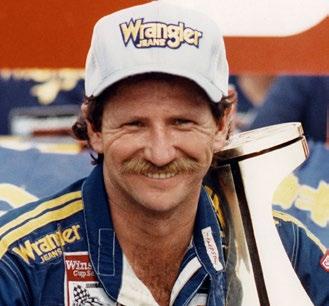
BEST DRIVER
TIM RICHMOND, driving the No. 25 Hendrick Motorsports Chevrolet, recorded seven victories, 13 top-five finishes, 17 top-10 results and eight poles in 29 starts during 1986. His biggest victory came in the prestigious Southern 500 at Darlington Raceway. He also scored race wins that year at Pocono, Daytona, Richmond, Watkins Glen and twice on the road course in Riverside, California. The driver from Ashland, Ohio, ended up sharing Driver of the Year honors with Dale Earnhardt.
BEST RACE

SEASON RECAP
DATE LOCATION WINNER
Feb. 16 Daytona International Speedway Geoff Bodine
Feb. 23 Richmond Raceway Kyle Petty
March 2 Rockingham Speedway Terry Labonte
March 16 Atlanta Motor Speedway Morgan Shepherd
April 6 Bristol Motor Speedway Rusty Wallace
April 13 Darlington Raceway Dale Earnhardt
April 20 North Wilkesboro Speedway Dale Earnhardt
April 27 Martinsville Speedway Ricky Rudd
May 4 Talladega Superspeedway Bobby Allison
May 18 Dover International Speedway Geoff Bodine
May 25 Charlotte Motor Speedway Dale Earnhardt
June 1 Riverside Raceway Darrell Waltrip
June 8 Pocono Raceway Tim Richmond
June 15 Michigan International Speedway Bill Elliott

July 4 Daytona International Speedway Tim Richmond
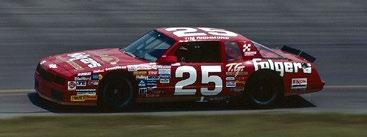
July 20 Pocono Raceway Tim Richmond
July 27 Talladega Superspeedway Bobby Hillin Jr.
Aug. 10 Watkins Glen International Tim Richmond
Aug. 17 Michigan International Speedway Bill Elliott
Aug. 23 Bristol Motor Speedway Darrell Waltrip
Aug. 31 Darlington Raceway Tim Richmond
Sept. 7 Richmond Raceway Tim Richmond
Sept. 14 Dover International Speedway Ricky Rudd
Sept. 21 Martinsville Speedway Rusty Wallace
Sept. 28 North Wilkesboro Speedway Darrell Waltrip
Oct. 5 Charlotte Motor Speedway Dale Earnhardt
Oct. 19 Rockingham Speedway Neil Bonnett
Earnhardt made his NASCAR Cup series debut during the 1975 Coca-Cola 600 at Charlotte Motor Speedway, but he did not become a series regular until 1979 when he was named rookie of the year. Driving for car owner Rod Osterlund, Earnhardt then shocked the racing world the following year when he won five races and captured the series championship. But midway through the 1981 season, Earnhardt suddenly found himself without a ride after Osterlund sold his race team.
Owner/driver Richard Childress elected to step out of the cockpit with 11 races remaining on the 1981 schedule. The decision opened the door for Earnhardt to finish the season and begin rebuilding his career. From there, Earnhardt joined team owner Bud Moore for two seasons in 1982 and 1983 before returning to Childress’ No. 3 Chevrolet the following year. Entering the 1986 season, Earnhardt had earned six victories and 36 top10 finishes since returning to RCR and was among the favorites to claim the series title.
Capitalizing on a new sloped rear window design that improved the aerodynamics of the Chevrolet Monte Carlo, Earnhardt won at Darlington, North Wilkesboro, Charlotte, Rockingham and Atlanta. With 16 top-five finishes and 23 top-10 results in 29 races, Earnhardt’s numbers proved good enough to claim his second title by 288 points over Darrell Waltrip, who was chasing his fourth championship in Junior Johnson’s No. 11 Chevrolet.
Earnhardt, who grew up in Kannapolis, North Carolina, went on to claim additional championships with RCR in 1987, 1990, 1991, 1993 and 1994.
ON FEB. 23, 1986, AT Virginia’s Richmond Raceway, Kyle Petty, driving the No. 7 Wood Brothers Racing Ford, scored his first career victory when race leaders Dale Earnhardt and Darrell Waltrip crashed on the last lap while battling for the win. As Waltrip attempted to pass to the inside down the backstretch, the two cars made contact, sending both hard into the outside guardrail. Petty avoided the carnage to emerge as a surprise winner.
TOP CARS

TIM RICHMOND’S Hendrick Motorsports Chevrolet recorded seven wins, 13 top-five finishes, 17 top-10 results and eight poles in 29 starts.
Dale Earnhardt’s Richard Childress Racing Chevrolet posted five victories, 16 top-five finishes, 23 top10 results and one pole position.
Nov. 2 Atlanta Motor Speedway Dale Earnhardt
Nov. 16 Riverside Raceway Tim Richmond
PRESIDENT
Ronald Reagan
NO. 1 AT THE BOX OFFICE
Top Gun
NO. 1 SONG
“That’s What Friends Are For”
1986
POP CULTURE
90 THROUGH THE YEARS 86
By Dionne & Friends
“The Oprah Winfrey Show” Debuts GALLON OF GAS 86 Cents
Earnhardt
Romps to No. 3
Dale Earnhardt posted 11 wins and 24 top-10 finishes as he dominated the 1987 season en route to his third NASCAR Cup Series championship and his second straight behind the wheel of the No. 3 Richard Childress Racing Chevrolet.
BEST DRIVER
DALE EARNHARDT, driving the No.3 Richard Childress Racing Chevrolet, recorded 11 NASCAR Cup Series victories and 24 top-10 finishes. Earnhardt enjoyed a solid season from the opener at Daytona, finishing fifth. From there, he established himself as a winner and championship contender in all 29 events on the schedule. He held the point lead from the second race of the year at Rockingham Speedway and topped Bill Elliott in the final standings.
BEST RACE
SEASON RECAP
After a very successful 1986 season that included Earnhardt claiming his second NASCAR Cup Series crown, the aggressive, second-generation racer from Kannapolis, North Carolina, was poised to repeat his effort as the 1987 season dawned.
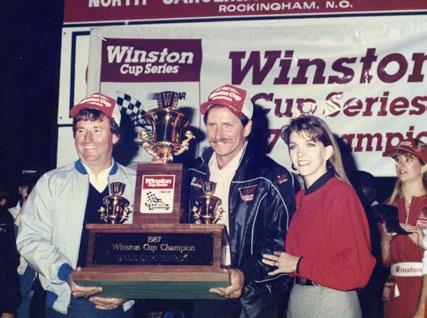
Earnhardt and team owner Richard Childress were building a union that most everyone envied. Both driver and team owner were very much alike. They had driven against each other in the Cup Series before Childress’ retirement in 1981 to make way for Earnhardt to drive his cars, and they came from similar personal backgrounds. Now, they were winning races and championships together and showing their closest competition how it was done.
Together, they were laying the groundwork for an incredible dynasty that would be strong well into the 1990s.
Earnhardt was successful on short tracks and superspeedways alike. He was on top of his game behind the wheel and he had a lightning-fast pit crew led by crew chief Kirk Shelmerdine. Their chemistry was magical, especially on the toughest tracks where Earnhardt shined brightest.
Bill Elliott, driver of the No. 9 Melling Racing Ford, proved to be Earnhardt’s closest rival but could not keep up with the championship pace of the RCR organization. Elliott’s six victories and 16 top-five finishes simply weren’t enough to mount a solid title challenge.
In the end, Earnhardt finished 489 points ahead of the popular driver from Dawsonville, Georgia.
DARRELL WALTRIP, driver of the No. 17 Hendrick Motorsports Chevrolet, went from third to first in the final turn and scored an upset victory in the Sept. 27 race at Virginia’s Martinsville Speedway.
Dale Earnhardt, Terry Labonte and Waltrip were running 1-2-3 when they tangled entering Turn 3 on the final lap. Earnhardt and Labonte both crashed while Waltrip cruised to the checkered flag for his only win of the season.
TOP CARS
DALE EARNHARDT’S No. 3 Richard Childress Racing Chevrolet claimed 11 wins and had 24 top10 results in 29 starts.
Driving the No. 9 Melling Racing Ford, Bill Elliott won six times and posted 20 top-10 finishes in 29 races.

Sept.
PRESIDENT Ronald Reagan
NO. 1 AT THE BOX OFFICE Beverly Hills Cop II
NO. 1 SONG
“Walk Like An Egyptian” by The Bangles
POP CULTURE
The first “The Simpsons” cartoon short was shown on the Tracey Ullman Show.
GALLON OF GAS $1.87
1987
91 87
DATE LOCATION WINNER Feb. 15 Daytona International Speedway Bill Elliott March 1 Rockingham Speedway Dale Earnhardt March 8 Richmond Raceway Dale Earnhardt March 15 Atlanta Motor Speedway Ricky Rudd
29 Darlington Raceway Dale Earnhardt
5 North Wilkesboro Speedway Dale Earnhardt
12 Bristol Motor Speedway Dale Earnhardt
26 Martinsville Speedway Dale Earnhardt
3 Talladega Superspeedway Davey Allison
24 Charlotte Motor Speedway Kyle Petty May 31 Dover Motor Speedway Davey Allison June 14 Pocono Raceway Tim Richmond June 21 Riverside International Raceway Tim Richmond June 28 Michigan International Speedway Dale Earnhardt July 4 Daytona International Speedway Bobby Allison July 19 Pocono Raceway Dale Earnhardt July 26 Talladega Superspeedway Bill Elliott
10 Watkins Glen International Rusty Wallace
16 Michigan International Speedway Bill Elliott
22 Bristol Motor Speedway Dale Earnhardt Sept. 6 Darlington Raceway Dale Earnhardt
13 Richmond Raceway Dale Earnhardt
20 Dover Motor Speedway Ricky Rudd
March
April
Apr.
Apr.
May
May
Aug.
Aug.
Aug.
Sept.
Sept.
27 Martinsville Speedway Darrell Waltrip
4 North Wilkesboro Speedway Terry Labonte
11 Charlotte Motor Speedway Bill Elliott
25 Rockingham Speedway Bill Elliott
8 Riverside International Raceway Rusty Wallace
22 Atlanta Motor Speedway Bill Elliott
Oct.
Oct.
Oct.
Nov.
Nov.
Bill Elliott Edges Rusty Wallace
Driving of the No. 9 Melling Racing Ford, Bill Elliott recorded six victories and 22 top-10 finishes en route to the 1988 NASCAR Cup Series championship, beating Rusty Wallace by only 24 points.
BEST DRIVER
DRIVING THE NO. 9 Melling Racing Ford, Bill Elliott recorded six NASCAR Cup Series victories and 22 top-10 finishes during the 1988 season. Elliott struggled in points to start the year but was third by the July race at Daytona International Speedway. He assumed the points lead following the August event at Bristol Motor Speedway and held it for the remainder of the year, withstanding a late-season challenge from Rusty Wallace.
BEST RACE
SEASON RECAP
DATE LOCATION WINNER
Feb. 14 Daytona International Speedway Bobby Allison
Feb. 21 Richmond Raceway Neil Bonnett
March 6 Rockingham Speedway Neil Bonnett
March 20 Atlanta Motor Speedway Dale Earnhardt
March 27 Darlington Raceway Lake Speed

April 10 Bristol Motor Speedway Bill Elliott
April 17 North Wilkesboro Speedway Terry Labonte
April 24 Martinsville Speedway Dale Earnhardt
May 1 Talladega Superspeedway Phil Parsons
May 29 Charlotte Motor Speedway Darrell Waltrip
June 5 Dover Motor Speedway Bill Elliott
June 12 Riverside International Raceway Rusty Wallace
June 19 Pocono Raceway Geoff Bodine
June 26 Michigan International Speedway Rusty Wallace
July 2 Daytona International Speedway Bill Elliott
July 24 Pocono Raceway Bill Elliott
July 31 Talladega Superspeedway Ken Schrader
Aug. 14 Watkins Glen International Ricky Rudd
Aug. 21 Michigan International Speedway Davey Allison
Aug. 27 Bristol Motor Speedway Dale Earnhardt
Sept. 4 Darlington Raceway Bill Elliott
Sept.11 Richmond Raceway Davey Allison
Sept. 18 Dover Motor Speedway Bill Elliott
Sept. 25 Martinsville Speedway Darrell Waltrip
Oct. 9 Charlotte Motor Speedway Rusty Wallace
Oct. 16 North Wilkesboro Speedway Rusty Wallace
Oct. 23 Rockingham Speedway Rusty Wallace
Since making their NASCAR Cup Series debut in 1975, Bill Elliott, his father, George Elliott, and brothers, Dan and Ernie Elliott, had worked hard to build a family legacy in the sport. It all began in George Elliott’s junkyard where Bill excelled as the driver of the three boys when they built their own jalopies and raced around cars that were stacked and ready for crushing.
From the local short tracks to NASCAR’s premier series, Bill Elliott made his mark as one of Georgia’s best drivers. He won his first Cup Series race in 1983 and in 1985 claimed the prestigious Winston Million bonus posted by R.J. Reynolds Tobacco Co. for any driver who could win three of NASCAR’s big four superspeedway events.

Elliott finished a distant second to Dale Earnhardt in points in 1987 but came back to secure NASCAR’s Cup Series championship the following year. He won six races but consistency was the key, as Wallace, driving the Blue Max Racing Pontiac, provided a potent challenge.
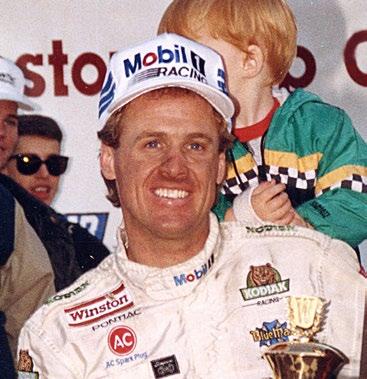
Elliott struggled in the first half of the year but was determined to prove he and his team could seriously battle for a title.
With their statistical numbers almost mirroring one another at season’s end, Elliott’s advantage when the checkered flag fell at Atlanta was 24 points. Wallace earned the pole, led the most laps and won the race but could not overcome Elliott’s advantage. Elliott started 29th, ran a conservative race and finished 11th to claim the title.
BOBBY ALLISON, driving the No. 12 Stavola Brothers Racing Buick, held off son Davey Allison, wheeling the No. 28 Robert Yates Racing Ford, to win his third Daytona 500. The season-opening race was a very popular win and marked the only time a father-and-son 1-2 finish has taken place in NASCAR’s most prestigious event. The younger Allison tried to pass his father in the final turn to no avail. It was Bobby Allison’s 84th and final victory.
TOP CARS
BILL ELLIOTT’S NO. 9 Melling Racing Ford went to Victory Lane six times with 22 top-10 finishes in 29 starts.
Rusty Wallace’s No. 27 Blue Max Racing Pontiac won six times and notched 23 top-10 results in 29 races.
Nov. 6 Phoenix Raceway Alan Kulwicki
Nov. 20 Atlanta Motor Speedway Rusty Wallace
PRESIDENT Ronald Reagan
NO. 1 AT THE BOX OFFICE Who Framed Roger Rabbit
NO. 1 SONG
“Faith” By George Michael

GALLON OF GAS 90 Cents
1988
92 THROUGH THE YEARS 88
Driving the No. 27 Blue Max Racing
Pontiac owned by drag racer Raymond Beadle, short-track sensation Rusty Wallace claimed six victories as he edged Dale Earnhardt to claim his lone Cup Series crown.
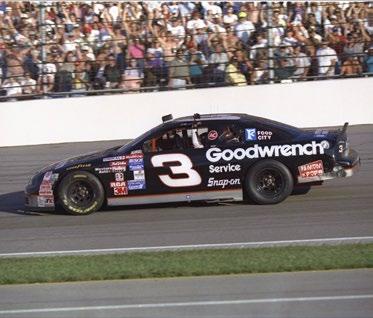
BEST DRIVER
RUSTY WALLACE, driver of the No. 27 Blue Max Racing Pontiac, won six races en route to securing the lone Cup Series championship of his 26-year career. Wallace was second in points in June at Pocono Raceway. He took the lead with five races remaining and held it for the remainder of the season. After his final victory of the year at Richmond Raceway in September, Wallace logged eight top-10 finishes in the final eight races.
BEST RACE
SEASON RECAP
Feb.
Wallace came to NASCAR’s top series determined to make a name for himself as he had done on the short tracks near his home in Missouri and with promoter Rex Robbins’ American Speed Association.
Wallace’s first venture into NASCAR’s premier series came in 1980 when he finished second to Earnhardt at Atlanta Motor Speedway while driving for auto racing icon Roger Penske. Even though unknown and untested, Wallace’s performance that day resulted in him be recognized as a possible future star.
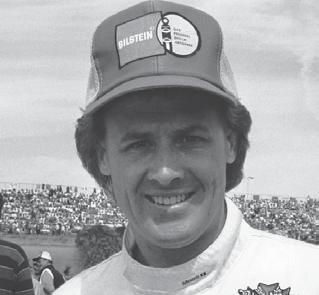
After earning Cup Series rookie-of-the-year honors with team owner Cliff Stewart in 1984, Wallace continued with Stewart in 1985 with little success. Then, in 1986, NASCAR team owner and drag racing legend Raymond Beadle called.
Race wins began to accumulate and in 1988, Wallace made a strong challenge for the Cup Series championship. Come 1989, Wallace and crew chief Barry Dodson were cocked and ready to win the coveted title.
Wallace was challenged throughout the year by three-time champion Earnhardt. Both drivers amassed virtually identical numbers when it came to success on the track. They were close on wins, top-five finishes and top-10 results, so much so that only 12 points separated them when the checkered flag fell over the final race of the season at Atlanta Motor Speedway.
Wallace entered the finale with a 78-point lead but problems dropped that lead to 12 at the checkered flag. Earnhardt won the race but it wasn’t enough to overcome the deficit.
DRIVING THE NO. 28 Robert Yates Racing Ford, second-generation wheelman Davey Allison took the lead from Morgan Shepherd with nine laps remaining and beat Terry Labonte to the stripe by threecar lengths to win the May 7 Winston 500 at Talladega Superspeedway. Revised carburetor specifications for this race resulted in slower speeds and tight racing. Mark Martin’s pole speed was nearly 20 mph off the track record.
TOP CARS
RUSTY WALLACE drove Raymond Beadle’s No. 27 Blue Max Racing Pontiac to six victories and 20 top-10 finishes in 29 races.
The familiar No 3 Richard Childress Racing Chevrolet driven by Dale Earnhardt had five wins and 19 top-10 results.
PRESIDENT
George H.W. Bush
NO. 1 AT THE BOX OFFICE
Batman
NO. 1 SONG
“Look Away” by Chicago
POP CULTURE
ABC’s coverage of Game 3 of the World Series was interrupted when an Earthquake struck San Francisco.
GALLON OF GAS
$1.02
Wallace Secures Lone Title 1989
93 89
DATE LOCATION WINNER
15 Daytona International Speedway Bill Elliott March 1 Rockingham Speedway Dale Earnhardt March 8 Richmond Raceway Dale Earnhardt March 15 Atlanta Motor Speedway Ricky Rudd March 29 Darlington Raceway Dale Earnhardt April 5 North Wilkesboro Speedway Dale Earnhardt
12 Bristol Motor Speedway Dale Earnhardt
26 Martinsville Speedway Dale Earnhardt
3 Talladega Superspeedway Davey Allison May 24 Charlotte Motor Speedway Kyle Petty May 31 Dover Motor Speedway Davey Allison June 14 Pocono Raceway Tim Richmond June 21 Riverside International Raceway Tim Richmond June 28 Michigan International Speedway Dale Earnhardt July 4 Daytona International Speedway Bobby Allison July 19 Pocono Raceway Dale Earnhardt July 26 Talladega Superspeedway Bill Elliott Aug. 10 Watkins Glen International Rusty Wallace Aug. 16 Michigan International Speedway Bill Elliott Aug. 22 Bristol Motor Speedway Dale Earnhardt Sept. 6 Darlington Raceway Dale Earnhardt Sept. 13 Richmond Raceway Dale Earnhardt
20 Dover Motor Speedway Ricky Rudd
27 Martinsville Speedway Darrell Waltrip
4 North Wilkesboro Speedway Terry Labonte
11 Charlotte Motor Speedway Bill Elliott
25 Rockingham Speedway Bill Elliott
8 Riverside International Raceway Rusty Wallace
22 Atlanta Motor Speedway Bill Elliott
Apr.
Apr.
May
Sept.
Sept.
Oct.
Oct.
Oct.
Nov.
Nov.
Earnhardt and Martin Dominate

Having fallen short to Rusty Wallace for the 1989 NASCAR Cup Series title, Dale Earnhardt started the 1990 season at Daytona International Speedway on a mission. A Daytona 500 victory had eluded Earnhardt since 1978. The Kannapolis, North Carolina, native had come extremely close to winning NASCAR’s most prestigious race but had fallen just short of collecting the missing jewel year after year. Earnhardt and his No. 3 Richard Childress Racing Chevrolet were once again strong throughout Daytona’s Speedweeks. In the 500, a cut tire on the final lap sent him skating high in the third turn, leaving the door open for relative unknown Derrike Cope, of Spanaway, Washington, to come out of nowhere to steal the victory.
Earnhardt regained his footing and the point lead with his first victory of the season at Atlanta Motor Speedway. He remained on top for nine events through Charlotte in May, but blew an engine at Dover the next week and fell to fifth in the standings over the next four races. A win at Daytona in July moved him back to second in points for 14 of the remaining 16 races. He regained the point lead at Phoenix with his ninth victory of the season.
Mark Martin, driver of the No. 6 Roush Racing Ford, was Earnhardt’s closest nemesis throughout the year. Wins at Richmond, Michigan and North Wilkesboro were his biggest highlights. But an illegal engine part discovered by NASCAR officials at Richmond cost Martin 46 points and $40,000 in fines.
Earnhardt finished third in the final race of 1990 at Atlanta and won the NASCAR Cup Series championship by 24 points.
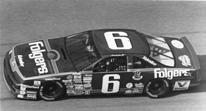

SEASON RECAP
DATE LOCATION WINNER
Feb 18 Daytona International Speedway Derrike Cope
Feb 25 Richmond International Raceway Mark Martin
March 4 North Carolina Speedway Kyle Petty
March 18 Atlanta Motor Speedway Dale Earnhardt
April 1 Darlington Raceway Dale Earnhardt
April 8 Bristol Motor Speedway Davey Allison
April 22 North Wilkesboro Speedway Brett Bodine
April 29 Martinsville Speedway Geoffrey Bodine
May 6 Talladega Superspeedway Dale Earnhardt
May 27 Charlotte Motor Speedway Rusty Wallace
June 3 Dover International Speedway Derrike Cope
June 10 Sonoma Raceway Rusty Wallace
June 17 Pocono Raceway Harry Gant
June 24 Michigan International Speedway Dale Earnhardt
July 7 Daytona International Speedway Dale Earnhardt
July 22 Pocono Raceway Geoffrey Bodine
July 29 Talladega Superspeedway Dale Earnhardt
Aug. 12 Watkins Glen International Ricky Rudd
Aug. 19 Michigan International Speedway Mark Martin
Aug. 25 Bristol Motor Speedway Ernie Irvan
Sept. 2 Darlington Raceway Dale Earnhardt
Sept. 9 Richmond International Raceway Dale Earnhardt
Sept. 16 Dover International Speedway Bill Elliott
Sept. 23 Martinsville Speedway Geoffrey Bodine
Sept. 30 North Wilkesboro Speedway Mark Martin
Oct. 7 Charlotte Motor Speedway Davey Allison
Oct. 21 North Carolina Speedway Alan Kulwicki
Nov. 4 Phoenix International Raceway Dale Earnhardt
Nov. 18 Atlanta Motor Speedway Morgan Shepherd
BEST DRIVER
AMAZINGLY, DALE EARNHARDT failed to finish only one race, the June 3 event in Dover, Delaware. His average start of 5.8 and average finish of 8.0 proved enough to log his third of seven-career NASCAR Cup Series titles. Confident of his ability to win the 1990 crown, Earnhardt ran less than 15 practice laps in the season finale at Atlanta and covered his car, playing mind games while sending a message to Mark Martin’s team.
BEST RACE

ON THE FINAL LAP, EARNHARDT appeared certain to collect his elusive Daytona 500 victory after 12 straight losses. However, a cut tire in turn three erased his chances. The surprise victory by Derrike Cope, a driver who hadn’t finished in the top-five at any point in his career, generated headlines around the world. Interestingly, Cope’s secondcareer triumph came on June 3, 1990, the day Earnhardt suffered his lone DNF of the season.
TOP CARS

DALE EARNHARDT’S No. 3 Richard Childress Racing Chevrolet was the best car of 1990 with nine wins, 18 top-five finishes, 23 top-10 results and four pole positions.
Mark Martin, driver of the No. 6 Roush Racing Ford, collected three wins, 16 top-five results, 23 top-10 finishes and three pole positions.
94 THROUGH THE YEARS 1990
The 1990 Monster Energy NASCAR Cup Series season began with hope that a longstanding mystery would finally be solved as one popular hero became the true definition of determination over the course of the 29-race schedule.
PRESIDENT: GEORGE H.W. BUSH NO. 1 SONG: “JEALOUS AGAIN,” THE BLACK CROWES APRIL 28: THE BROADWAY PLAY “A CHORUS LINE” CLOSES AFTER 6,137 PERFORMANCES
OCT. 25: EVANDER HOLYFIELD DEFEATS BUSTER DOUGLAS FOR THE HEAVYWEIGHT TITLE
Dale Earnhardt Claims 5th Championship
Earnhardt was in his eighth season behind the wheel of the No. 3 Chevrolet owned by Richard Childress and fielded by Richard Childress Racing. The two had joined forces for the second time in 1984, after having shown promise during 10 races together in 1981.

Since reuniting, Earnhardt and Childress had become a force in NASCAR Cup Series racing, winning championships in 1986, 1987 and 1990, and they looked to add a fourth title in 1991. Earnhardt claimed his first championship with team owner Rod Osterlund in 1980 for a career total of four when the season began.
Rudd, a former driver for Childress in 1982 and 1983 when Earnhardt raced for Bud Moore, was driving for team owner Rick Hendrick in 1991 and showing championship promise. He was in his second season at Hendrick Motorsports. With master crew chief and engine builder Waddell Wilson at his side, the No. 5 Chevrolet was strong every time it rolled out of the garage area.
Both Earnhardt and Rudd managed to show consistency throughout the schedule. Rudd collected a victory at Darlington Raceway in April, along with 17 top-10 finishes. Even though Rudd had a good season, it was Earnhardt’s wins at Martinsville, Richmond, Talladega and North Wilkesboro, along with 21 top10 results, that made the difference in the championship standings.
At season’s end, Earnhardt was 195 points ahead of Rudd to claim his fifth NASCAR Cup Series championship.
SEASON RECAP
DATE LOCATION WINNER
Feb. 17 Daytona International Speedway Ernie Irvan
Feb. 24 Richmond Raceway Dale Earnhardt
March 3 Rockingham Speedway Kyle Petty
March 18 Atlanta Motor Speedway Ken Schrader
April 7 Darlington Raceway Ricky Rudd
April 14 Bristol Motor Speedway Rusty Wallace
April 21 North Wilkesboro Speedway Darrell Waltrip
April 28 Martinsville Speedway Dale Earnhardt
May 6 Talladega Superspeedway Harry Gant
May 26 Charlotte Motor Speedway Davey Allison
June 2 Dover International Speedway Ken Schrader
June 9 Sonoma Raceway Davey Allison
June 16 Pocono Raceway Darrell Waltrip
June 23 Michigan International Speedway Davey Allison
July 6 Daytona International Speedway Bill Elliott
July 21 Pocono Raceway Rusty Wallace
July 28 Talladega Superspeedway Dale Earnhardt
Aug. 11 Watkins Glen International Ernie Irvan
Aug. 18 Michigan International Speedway Dale Jarrett
Aug. 24 Bristol Motor Speedway Alan Kulwicki
Sept. 1 Darlington Raceway Harry Gant
Sept. 7 Richmond Raceway Harry Gant
Sept. 15 Dover International Speedway Harry Gant
Sept. 22 Martinsville Speedway Harry Gant
Sept. 29 North Wilkesboro Speedway Dale Earnhardt
Oct. 6 Charlotte Motor Speedway Geoff Bodine
Oct. 20 Rockingham Speedway Davey Allison
Nov. 3 Phoenix Raceway Davey Allison
Nov. 17 Atlanta Motor Speedway Mark Martin
BEST DRIVER
HARRY GANT, DRIVING THE NO. 33
Skoal Bandit Oldsmobile for Leo Jackson Racing, recorded five wins and 17 top-10 finishes in 29 starts during the 1991 season. Four of the victories came consecutively at Darlington, Richmond, Martinsville and North Wilkesboro, prompting the media to dub him “Mr. September.” Gant went on to finish fourth in points behind Dale Earnhardt, Ricky Rudd and Davey Allison. Gant retired from driving three years later with 18-career victories.
BEST RACE
ON AUG. 18, 1991, DALE JARRETT, driving the No. 21 Wood Brothers Racing Ford, logged his first-career Cup Series victory at Michigan International Speedway as he beat Davey Allison’s Robert Yates Racing Ford to the checkered flag by a mere eight inches. Jarrett got the advantage coming off turn four and edged ahead of Allison by less than a bumper’s width. Jarrett went on to win 31 additional Cup Series races before his retirement in 2005.
TOP CARS
DALE EARNHARDT’S No. 3 Richard Childress Racing Chevrolet, winner of four NASCAR Cup Series races in 1991.
Ricky Rudd’s No. 5 Hendrick Motorsports Chevrolet, winner of the spring race at Darlington that season.
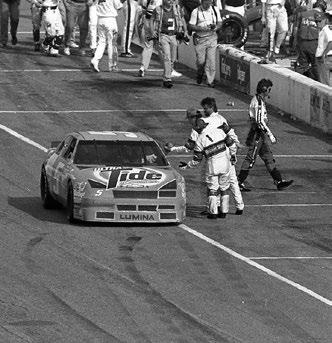
95
91
PRESIDENT: GEORGE H.W. BUSH NO. 1 AT THE BOX OFFICE: TERMINATOR 2: JUDGMENT DAY NO. 1 SONG: “(EVERYTHING I DO) I DO IT FOR YOU” BY BRYAN ADAMS GALLON OF GAS: $1.20 POP CULTURE: ON AUG. 6, THE WORLD WIDE WEB’S FIRST PAGE WENT LIVE ON THE INTERNET.
1991
Dale Earnhardt and Ricky Rudd proved to be the top championship contenders of the 1991 NASCAR Cup Series season, collecting a combined five victories during the 29-race premier series schedule.
Kulwicki Scores Come-from-Behind Upset 92
No one could have imagined at the beginning of the 1992 season that it would be one of the most exciting in NASCAR’s 43-year history. Aside from intense on-track competition, headlines included Richard Petty, NASCAR’s most popular and successful driver with 200 victories and seven series championships, retiring after 32 years. Also, a young Jeff Gordon made his first Cup Series start in the Nov. 15 race at Atlanta Motor Speedway after two seasons in the NASCAR XFINITY Series. With 28 races completed, the championship battle narrowed to Kulwicki, Elliott, Davey Allison, Harry Gant, Mark Martin and Kyle Petty, all mathematically within striking distance of the title entering the final race. To win the title, Allison needed to finish sixth or better, but he fell short after being involved in an accident. The race and the championship came down to two men – Elliott and Kulwicki. Elliott won the race in Junior Johnson’s Ford, while Kulwicki finished second in his own Ford. Kulwicki led 103 laps to Elliott’s 102, clinching five bonus points for leading the most laps and that was the deciding factor in the championship.
Billed as an underdog driver against the highly financed teams, the Wisconsin native received NASCAR’s highest honor in New York City in December 1992. On April 1, 1993, Kulwicki, along with three others, were killed in a private plane crash while en route to Bristol, Tennessee, for a race at Bristol Motor Speedway
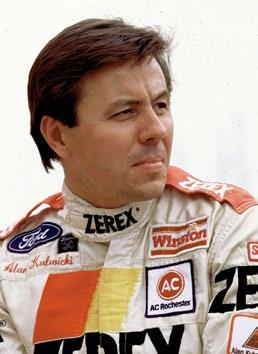
SEASON RECAP
DATE LOCATION WINNER
Feb. 16 Daytona International Speedway Davey Allison
March 1 Rockingham Speedway Bill Elliott
March 8 Richmond International Raceway Bill Elliott
March 15 Atlanta Motor Speedway Bill Elliott
March 29 Darlington Raceway Bill Elliott
April 5 Bristol Motor Speedway Alan Kulwicki
April 12 North Wilkesboro Speedway Davey Allison
April 26 Martinsville Speedway Mark Martin
May 3 Talladega Superspeedway Davey Allison
May 24 Charlotte Motor Speedway Dale Earnhardt
May 31 Dover International Speedway Harry Gant
June 7 Sonoma Raceway Ernie Irvan
June 14 Pocono Raceway Alan Kulwicki
June 21 Michigan International Speedway Davey Allison
July 4 Daytona International Speedway Ernie Irvan
July 19 Pocono Raceway Darrell Waltrip
July 26 Talladega Superspeedway Ernie Irvan
Aug. 9 Watkins Glen International Kyle Petty
Aug. 16 Michigan International Speedway Harry Gant
Aug. 29 Bristol Motor Speedway Darrell Waltrip
Sept. 6 Darlington Raceway Darrell Waltrip
Sept. 12 Richmond International Raceway Rusty Wallace
Sept. 20 Dover International Speedway Ricky Rudd
Sept. 28 Martinsville Speedway Geoff Bodine
Oct. 5 North Wilkesboro Speedway Geoff Bodine
Oct. 11 Charlotte Motor Speedway Mark Martin
Oct. 25 Rockingham Speedway Kyle Petty
Nov. 1 Phoenix International Raceway Davey Allison
Nov. 15 Atlanta Motor Speedway Bill Elliott
BEST DRIVER
BILL ELLIOTT ENTERED THE 1992 NASCAR Sprint Cup Series season as the new driver of Junior Johnson’s Ford Thunderbird. Elliott left the Dawsonville, Georgia, team founded by his family and eventually purchased by businessman Harry Melling. Elliott scored five victories and finished a very close second in the Cup Series point standings to champion Alan Kulwicki. He dominated the month of March with wins at Rockingham, Richmond, Atlanta and Darlington and topped the Atlanta finale.
BEST RACE

THE HOOTERS 500 AT ATLANTA MOTOR Speedway on Nov. 15 was by far the greatest race of the 1992 NASCAR season. At no other time during the 29-race schedule did any other race feature as many interesting story lines. That event had an intense championship battle among six drivers; it was the final race for seven-time champion Richard Petty; and it marked the series debut of future NASCAR champion Jeff Gordon. Books and television documentaries have spotlighted the race as one of NASCAR’s greatest events.
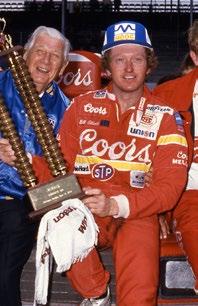
TOP CARS
BILL ELLIOTT’S No. 11 Junior Johnson Ford scored five victories and 17 top-10 finishes, while Davey Allison drove Robert Yates’ Ford to similar results, posting five victories and 17 top-10 finishes.

96 THROUGH THE YEARS 1992
The 1992 NASCAR Sprint Cup Series season featured an intense championship battle that saw six drivers still in contention entering the finale at Atlanta Motor Speedway. Alan Kulwicki won the title by a mere 10 points over Bill Elliott.
PRESIDENT: GEORGE H.W. BUSH NO. 1 SONG: “END OF THE ROAD” BY BOYS II MEN MAJOR NEWS STORIES: TORONTO DEFEATS ATLANTA IN THE WORLD SERIES;
Earnhardt Regains the Magic
Driving the No. 3 Richard Childress Racing Chevrolet, Dale Earnhardt won six races
sixth series
Earnhardt returned to championship form after seeing Alan Kulwicki and his AK Racing team surprise the NASCAR world with their championship run in 1992. The No. 3 team found the magic as the Andy Petree-led operation was back in form.
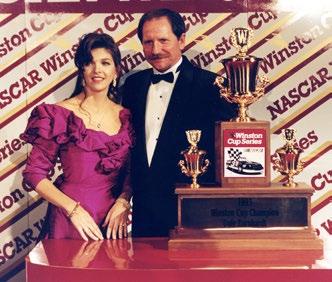
Earnhardt was still unable to score an elusive victory in the Daytona 500, however, finishing second to Dale Jarrett and Joe Gibbs Racing in NASCAR’s most prestigious race. Still, Earnhardt’s second-place finish in the season opener set the stage for a solid start to the season.
It wasn’t until Darlington on March 28 that Earnhardt went to Victory Lane. Just three days later on April 1, Kulwicki perished in a plane crash en route to Bristol Motor Speedway. His death was a terrible loss to the sport. Then in July, Davey Allison died as a result of a helicopter crash at Talladega Superspeedway.
Rusty Wallace, Earnhardt’s closest championship rival, won 10 races throughout the year and knocked his rival back to second in points early. Wallace shaved 273 points off Earnhardt’s lead and finished ahead of him in seven consecutive races by late summer.
A third-place effort at Sonoma Raceway put Earnhardt back in the lead and a win in the Coca-Cola 600 at Charlotte Motor Speedway kept him there the rest of the season. Four wins followed at Dover, Daytona, Pocono and Talladega over the next six months and the title was his.
By season’s end at Atlanta on Nov. 14, Earnhardt was 80 points ahead of Wallace.
SEASON RECAP
DATE LOCATION WINNER
Feb. 14 Daytona International Speedway Dale Jarrett
Feb. 28 Rockingham Speedway Rusty Wallace
March 7 Richmond Raceway Davey Allison
March 20 Atlanta Motor Speedway Morgan Shepherd
March 28 Darlington Raceway Dale Earnhardt
April 4 Bristol Motor Speedway Rusty Wallace
April 18 North Wilkesboro Speedway Rusty Wallace
April 25 Martinsville Speedway Rusty Wallace
May 2 Talladega Superspeedway Ernie Irvan
May 16 Sonoma Raceway Geoff Bodine
May 30 Charlotte Motor Speedway Dale Earnhardt
June 6 Dover Motor Speedway Dale Earnhardt
June 13 Pocono Raceway Kyle Petty
June 20 Michigan International Speedway Ricky Rudd
July 3 Daytona International Speedway Dale Earnhardt
July 11 New Hampshire Motor Speedway Rusty Wallace
July 18 Pocono Raceway Dale Earnhardt
July 20 Talladega Superspeedway Dale Earnhardt
Aug. 8 Watkins Glen International Mark Martin
Aug. 15 Michigan International Speedway Mark Martin
Aug. 28 Bristol Motor Speedway Mark Martin
Sept. 5 Darlington Raceway Mark Martin
Sept. 11 Richmond Raceway Rusty Wallace
Sept. 19 Dover Motor Speedway Rusty Wallace
Sept. 26 Martinsville Speedway Ernie Irvan
Oct. 3 North Wilkesboro Speedway Rusty Wallace
Oct. 10 Charlotte Motor Speedway Ernie Irvan
Oct. 24 Rockingham Speedway Rusty Wallace
Oct. 31 Phoenix Raceway Mark Martin
Nov. 14 Atlanta Motor Speedway Rusty Wallace
BEST DRIVER
RUSTY WALLACE WON ONE-THIRD of the NASCAR Cup Series races in 1993 as he drove the No. 2 Penske Racing Pontiac to 10 victories. Even though he finished second in points to Earnhardt, his performance on the track was better than any other driver. The fact that Wallace suffered five DNFs resulted in lost points, but his 11.9 average start and 9.4 average finish kept him within striking distance of the title throughout the year.
BEST RACE
ON AUG. 28, MARK MARTIN overcame a two-lap deficit and roared past Rusty Wallace with 13 laps remaining at Bristol Motor Speedway to grab his third consecutive win on the Tennessee short track. Driving the No. 6 Roush Racing Ford, Martin held the lead during the final three frantic laps, but Wallace was closing as Martin worked through lapped traffic. The victory was also Martin’s fourth consecutive win of the season.
TOP CARS
DALE EARNHARDT’S NO. 3 RICHARD
Childress Racing Chevrolet recorded six wins and 21 top-10 results during the season’s 30 races.
The stats line for Rusty Wallace’s No. 2 Penske Racing Pontiac included 10 victories and 21 top-10 finishes.
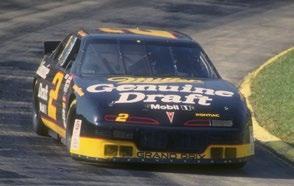
97
93
PRESIDENT: BILL CLINTON NO. 1 AT THE BOX OFFICE: JURASSIC PARK NO. 1 SONG: “I WILL ALWAYS LOVE YOU” BY WHITNEY HOUSTON GALLON OF GAS: $1.11 POP CULTURE: INTEL INTRODUCED THE PENTIUM MICROPROCESSOR, USHERING IN A NEW ERA OF SPEEDY COMPUTERS. IN ADDITION, MICROSOFT RELEASED THE WINDOWS NT 3.1 VERSION.
1993
and scored 21 top-10 finishes en route to claiming his
title, one shy of Richard Petty’s record of seven.
Earnhardt Gets Title No. 7 94
In 1994, Dale Earnhardt and Richard Childress Racing of Welcome, North Carolina, emerged triumphant and collected the coveted NASCAR Cup Series championship after logging four wins, 25 top-10 finishes and two pole positions in 31 starts.

The season began with Earnhardt singing the same Daytona 500 song he had been singing since first coming to the 2.5-mile Daytona International Speedway in 1979. Once again, he finished the 500 without a win. He ended up seventh behind winner Sterling Marlin.
Still, the Kannapolis, North Carolina, native was determined to make it a great season, and why not? He was NASCAR’s defending Cup Series champion with the same team owner in Richard Childress, the same team in RCR and the same pit crew led by crew chief Andy Petree.
Earnhardt scored his first victory of the season in the fifth race at Darlington Raceway and followed that with a win the next week at Bristol Motor Speedway. His season felt like a carbon copy of 1993 and had that championship feel. He took the point with the win at Bristol and the season looked promising.
Earnhardt was second in points for eight weeks through the 400-mile race at Daytona but returned to the lead and stayed there the remainder of the year.

At Michigan International Speedway in August, Earnhardt was involved in a twocar crash with Todd Bodine. Ironically, it was the first time since July 1986 at Daytona that he hadn’t finished a Cup Series race due to a crash on the track.
A final victory at Rockingham Speedway in October iced Earnhardt’s seventhcareer championship. Mark Martin, driver of the Roush Racing Ford, finished second in points to Earnhardt for the second time.
SEASON RECAP
DATE LOCATION WINNER
Feb 18 Daytona International Speedway Derrike Cope
Feb 25 Richmond International Raceway Mark Martin
March 4 North Carolina Speedway Kyle Petty
March 18 Atlanta Motor Speedway Dale Earnhardt
April 1 Darlington Raceway Dale Earnhardt
April 8 Bristol Motor Speedway Davey Allison
April 22 North Wilkesboro Speedway Brett Bodine
April 29 Martinsville Speedway Geoffrey Bodine
May 6 Talladega Superspeedway Dale Earnhardt
May 27 Charlotte Motor Speedway Rusty Wallace
June 3 Dover International Speedway Derrike Cope
June 10 Sonoma Raceway Rusty Wallace
June 17 Pocono Raceway Harry Gant
June 24 Michigan International Speedway Dale Earnhardt
July 7 Daytona International Speedway Dale Earnhardt
July 22 Pocono Raceway Geoffrey Bodine
July 29 Talladega Superspeedway Dale Earnhardt
Aug. 12 Watkins Glen International Ricky Rudd
Aug. 19 Michigan International Speedway Mark Martin
Aug. 25 Bristol Motor Speedway Ernie Irvan
Sept. 2 Darlington Raceway Dale Earnhardt
Sept. 9 Richmond International Raceway Dale Earnhardt
Sept. 16 Dover International Speedway Bill Elliott
Sept. 23 Martinsville Speedway Geoffrey Bodine
Sept. 30 North Wilkesboro Speedway Mark Martin
Oct. 7 Charlotte Motor Speedway Davey Allison
Oct. 21 North Carolina Speedway Alan Kulwicki
Nov. 4 Phoenix International Raceway Dale Earnhardt
Nov. 18 Atlanta Motor Speedway Morgan Shepherd
BEST DRIVER
RUSTY WALLACE, DRIVER OF THE NO. 2 Ford for Team Penske, won eight Cup Series races, logging 17 top-five finishes and 20 top-10 results in 31 starts. However, the Fenton, Missouri, native suffered three engine failures and major crashes at Daytona and Talladega further hampered his title hopes, but miraculously resulted in relatively minor injuries. The only championship of Wallace’s 26-year Cup Series career came in 1989 with team owner Raymond Beadle.
BEST RACE

ON AUG. 6, JEFF GORDON, DRIVING the No. 24 Hendrick Motorsports Chevrolet, won the inaugural Brickyard 400 at Indianapolis Motor Speedway after starting third in the 43-car field. The native of Vallejo, California, and longtime Indiana resident led 93 of the race’s 160 laps en route to the second NASCAR Cup Series victory of his career. Gordon went on to win five times at the famed Brickyard, his last victory there coming in 2014.
TOP CARS

DALE EARNHARDT’S 1994 NO. 3 RICHARD Childress Racing Chevrolet with four wins, 20 top-five finishes, 25 top-10 results and two pole positions.
Driving the No. 6 Roush Racing Ford, Mark Martin had two wins, 15 top-five results, 20 top-10 showings and one pole position.
98 THROUGH THE YEARS
1994
PRESIDENT: BILL CLINTON NO. 1 AT THE BOX OFFICE: THE LION KING NO. 1 SONG: “THE SIGN” BY ACE OF BASE GALLON OF GAS: $1.11 POP CULTURE: THE POLICE CHASE OF A WHITE FORD BRONCO CARRYING O.J. SIMPSON CAPTIVATED A NATIONWIDE TELEVISION AUDIENCE.
Gordon Beats Earnhardt
After arriving on the scene in 1992, Gordon, a former USAC open-wheel racer, steadily found his place in the NASCAR Cup Series, winning his first race in the 1994 Coca-Cola 600 at Charlotte Motor Speedway. He also topped the inaugural Brickyard 400 that year, establishing himself as an up-and-coming star.
In 1995, it was as if a switch had been flipped. Gordon and crew chief Ray Evernham had found the magic, and they made winning look commonplace. Gordon had finally found the consistency he needed to contend on a weekly basis, not just during the select big events in which he excelled the previous season.
Gordon began the schedule 22nd in points after finishing outside the top 20 in the Daytona 500. A win at Rockingham Speedway the next week moved him to seventh, followed by a drop to 13th after a fuel pump failed at Richmond.
From there, Gordon was able to maintain his place among the top 10 in points. He assumed command in the championship battle after winning at New Hampshire Motor Speedway on July 9 and never looked back.
Dale Earnhardt, driving the No. 3 Richard Childress Racing Chevrolet, led a portion of the season in points but ultimately finished second, 34 markers behind Gordon. Earnhardt logged five wins with 23 top-10 finishes. DNFs at both Michigan races severely impacted his title hopes.
SEASON RECAP
DATE LOCATION WINNER
Feb. 19 Daytona International Speedway Sterling Marlin
Feb. 26 Rockingham Speedway Jeff Gordon
March 5 Richmond Raceway Terry Labonte
March 12 Atlanta Motor Speedway Jeff Gordon
March 26 Darlington Raceway Sterling Marlin
April 2 Bristol Motor Speedway Jeff Gordon
April 9 North Wilkesboro Speedway Dale Earnhardt
April 23 Martinsville Speedway Rusty Wallace
April 30 Talladega Superspeedway Mark Martin
May 7 Sonoma Raceway Dale Earnhardt
May 28 Charlotte Motor Speedway Bobby Labonte
June 4 Dover Motor Speedway Kyle Petty
June 11 Pocono Raceway Terry Labonte
June 18 Michigan International Speedway Bobby Labonte
July 1 Daytona International Speedway Jeff Gordon
July 9 New Hampshire Motor Speedway Jeff Gordon
July 16 Pocono Raceway Dale Jarrett
July 23 Talladega Superspeedway Sterling Marlin
Aug. 5 Indianapolis Motor Speedway Dale Earnhardt
Aug. 13 Watkins Glen International Mark Martin
Aug. 20 Michigan International Speedway Bobby Labonte
Aug. 26 Bristol Motor Speedway Terry Labonte
Sept. 3 Darlington Raceway Jeff Gordon
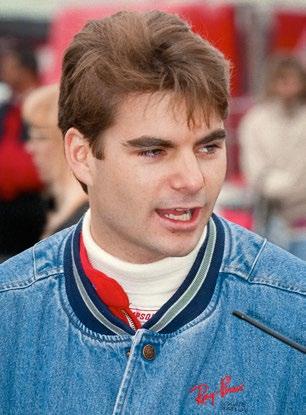
Sept. 9 Richmond Raceway Rusty Wallace
Sept. 17 Dover Motor Speedway Jeff Gordon
Sept. 24 Martinsville Speedway Dale Earnhardt
Oct. 1 North Wilkesboro Speedway Mark Martin
Oct. 8 Charlotte Motor Speedway Mark Martin
Oct. 22 Rockingham Speedway Ward Burton
Oct. 29 Phoenix Raceway Ricky Rudd
Nov. 12 Atlanta Motor Speedway Dale Earnhardt
PRESIDENT: BILL CLINTON NO. 1 AT THE BOX OFFICE: BATMAN FOREVER
NO. 1 SONG: “GANGSTA’S PARADISE” BY COOLIO FEATURING L.V. GALLON OF GAS: $1.21 HISTORY: ON APRIL 19, A TRUCK RIGGED WITH A DIESEL FUEL/FERTILIZER-DERIVED BOMB EXPLODED OUTSIDE THE ALFRED P. MURRAH FEDERAL BUILDING IN OKLAHOMA CITY, KILLING 168 PEOPLE.
BEST DRIVER
JEFF GORDON, DRIVER OF THE NO. 24 Hendrick Motorsports Chevrolet, won seven NASCAR Cup Series races with six coming on superspeedways and one on a short track. His Concord, North Carolinabased team owned by Rick Hendrick and led by crew chief Ray Evernham was strong both on the track and in the pit area. Gordon’s 5.0 average start and 9.5 average finish were enough for the native of Vallejo, California, to secure his first Cup Series championship.
BEST RACE
DRIVING THE NO. 5 HENDRICK
Motorsports Chevrolet, Terry Labonte won the Goody’s 500 at Bristol Motor Speedway by crashing across the startfinish line after being punted by Dale Earnhardt in the No. 3 RCR Chevrolet. Labonte crashed into the wall but was able to drive his badly damaged car into Victory Lane. Seeing that he wasn’t going to win, Earnhardt tagged Labonte’s rear bumper and sent him spinning under the checkered flag.
TOP CARS
JEFF GORDON’S NO. 24
Hendrick Motorsports Chevrolet notched seven wins with 23 top-10 finishes in 31 series starts.
The No. 3 RCR Chevrolet driven by Dale Earnhardt went to Victory Lane five times and had 23 top-10 results.
99
95
1995
Driving the No. 24 Hendrick Motorsports Chevrolet, Jeff Gordon recorded seven victories, 23 top-10 finishes and eight pole positions en route to the first NASCAR Cup Series titles for himself and Hendrick Motorsports.
Labonte’s Second Title 96
NASCAR’s premier series schedule consisted of 31 races that began in Daytona Beach, Florida, and ended in Hampton, Georgia. The sport’s popularity was strong, prompting a non-points special event to be run at season’s end on the road course in Suzuka, Japan. It was the first of four annual visits to Japan, two of which were held on the oval at Twin Ring Motegi.
Chevrolet drivers led the win column with 17, followed by Ford with 13. Pontiac’s lone 1996 victory came in November at Phoenix International Raceway with Bobby Hamilton driving the Petty Enterprises entry.
Terry Labonte, Jeff Gordon, Dale Earnhardt and Sterling Marlin were best in the Chevrolet camp, while Dale Jarrett, Rusty Wallace, Geoff Bodine and Ernie Irvan enjoyed victories for Ford Motor Co.

Labonte, a native of Corpus Christi, Texas, won the series championship in 1984 while driving for car owner Billy Hagan, and he suffered a long dry spell before a second championship came his way. Consistency was the key to his second title as Labonte only won two races but logged 24 top-10 finishes.
The championship came down to Labonte and Hendrick Motorsports teammate Gordon. Labonte took the point lead with a third-place finish at North Carolina’s Rockingham Speedway in late October. Then, top-five finishes in the final two events were enough for Labonte to secure the crown by 37 points over Gordon. Gordon won 10 races, while Labonte only won twice. Both collected 21 topfive finishes and 24 top-10 efforts, but Labonte had an average finish of 8.2 to Gordon’s 9.5.
SEASON RECAP
DATE LOCATION WINNER
Feb. 18
Daytona International Speedway Dale Jarrett
Feb. 25 Rockingham Speedway Dale Earnhardt
March 3 Richmond International Raceway Jeff Gordon
March 10 Atlanta Motor Speedway Dale Earnhardt
March 24 Darlington Raceway Jeff Gordon
March 31 Bristol Motor Speedway Jeff Gordon
April 14 North Wilkesboro Speedway Terry Labonte
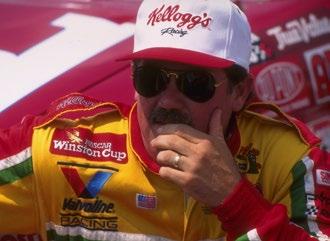
April 21 Martinsville Speedway Rusty Wallace
April 28 Talladega Superspeedway Sterling Marlin
May 5 Sonoma Raceway Rusty Wallace
May 26 Charlotte Motor Speedway Dale Jarrett
June 2 Dover International Speedway Jeff Gordon
June 16 Pocono Raceway Jeff Gordon
Jun 23 Michigan International Speedway Rusty Wallace
July 6 Daytona International Speedway Sterling Marlin
July 14 New Hampshire Motor Speedway Ernie Irvan
July 21 Pocono Raceway Rusty Wallace
July 28 Talladega Superspeedway Jeff Gordon
Aug. 3 Indianapolis Motor Speedway Dale Jarrett
Aug. 11 Watkins Glen International Geoffrey Bodine
Aug. 18 Michigan International Speedway Dale Jarrett
Aug. 24 Bristol Motor Speedway Rusty Wallace
Sept.1 Darlington Raceway Jeff Gordon
Sept.7 Richmond International Raceway Ernie Irvan
Sept.15 Dover International Speedway Jeff Gordon
Sept. 22 Martinsville Speedway Jeff Gordon
Sept. 29 North Wilkesboro Speedway Jeff Gordon
Oct. 6 Charlotte Motor Speedway Terry Labonte
Oct. 20 Rockingham Speedway Ricky Rudd
Oct. 27 Phoenix International Raceway Bobby Hamilton
Nov. 10 Atlanta Motor Speedway Bobby Labonte
BEST DRIVER
JEFF GORDON, DRIVER OF THE NO. 24
Hendrick Motorsports Chevrolet, won 10 races under the direction of crew chief Ray Evernham. There were six superspeedway victories and four on short tracks, including the final NASCAR Cup Series race at North Wilkesboro Speedway on Sept. 29, 1996. That victory marked the end of 47 years of NASCAR racing at the storied North Carolina track. Mechanical issues and crashes at Daytona, Rockingham, Talladega, New Hampshire and Indianapolis doomed Gordon’s title hopes.
BEST RACE

DALE JARRETT, DRIVING THE NO. 88 Robert Yates Racing Ford, collected his first of two Brickyard 400 victories at Indianapolis Motor Speedway over teammate Ernie Irvan. Jarrett took the race lead seven laps from the finish after a hard-fought battle with Irvan. The 160-lap race ultimately ended under the caution flag, giving Jarrett his seventh of 32-career victories. Jarrett retired from driving after five races in the 2008 season.
TOP CARS

TERRY LABONTE, DRIVING THE NO. 5 Hendrick Motorsports Chevrolet, earned the series championship. He won two races, had 21 top-five finishes and earned four poles during the season.
Jeff Gordon, driver of the No. 24 Hendrick Motorsports Chevrolet, finished second in the standings with 10 wins, 21 top-five finishes and five pole positions.
100 THROUGH THE YEARS 1996
The 1996 Monster Energy NASCAR Cup Series season featured a rare scenario where two drivers from the same team battled for the championship, as the success of Hendrick Motorsports helped stock car racing enjoy one of its most exciting seasons.
PRESIDENT: BILL CLINTON NO. 1 SONG: “MACARENA,” BAYSIDE BOYS
TOP NEWS: JAN. 5: MIAMI DOLPHINS COACH DON SHULA RETIRES MAY 21: BLACKOUTS
ACROSS QUEENS, NEW YORK AUG. 9: BORIS YELTSIN SWORN IN AS PRESIDENT OF RUSSIA
Title No. 2 for Jeff Gordon
Even though Gordon was unable to defend his title in 1996, the Cup Series championship remained with Hendrick Motorsports as teammate Terry Labonte claimed the top prize.
Gordon returned as Cup Series champion in 1997 following an impressive double-digit series of victories. His famed No. 24 rainbow-colored Chevrolet went to Victory Lane in the season-opening Daytona 500, the perfect start to a promising year. A second win during Week 2 at Rockingham Speedway solidified the team as one of the strongest contenders in the Cup Series garage area.
Other drivers and teams began to emerge as early season winners, such as Rusty Wallace of Penske Racing, Dale Jarrett of Robert Yates Racing and Jeff Burton of Roush Racing.
But Gordon was able to fend them off atop the win column as the California native won at Bristol, Martinsville, Charlotte and Pocono.
No matter where the Cup Series circuit went, Gordon enjoyed success even though Burton, Jarrett and Ricky Rudd scored wins of their own at New Hampshire, Pocono and Indianapolis. Mark Martin has also tamed Sonoma and Michigan, while Jarrett picked up a summer victory at Bristol.
With a Southern 500 triumph at Darlington in September, Gordon was firmly in command. He was victorious once more at New Hampshire, as a tire problem at Phoenix and a lackluster performance in the Atlanta finale narrowed the winning margin over Jarrett to a mere 14 points. Jarrett finished second in the finale while Gordon collected the championship trophy following a 17th-place effort.
SEASON RECAP
DATE LOCATION WINNER
Feb. 16 Daytona International Speedway Jeff Gordon
Feb. 23 Rockingham Speedway Jeff Gordon
March 2 Richmond Raceway Rusty Wallace
March 9 Atlanta Motor Speedway Dale Jarrett
March 23 Darlington Raceway Dale Jarrett
April 6 Texas Motor Speedway Jeff Burton
April 13 Bristol Motor Speedway Jeff Gordon
April 20 Martinsville Speedway Jeff Gordon
May 4 Sonoma Raceway Mark Martin
May 10 Talladega Superspeedway Mark Martin
May 25 Charlotte Motor Speedway Jeff Gordon
June 1 Dover Motor Speedway Ricky Rudd
June 8 Pocono Raceway Jeff Gordon
June 15 Michigan Speedway Ernie Irvan
June 22 Auto Club Speedway Jeff Gordon
July 5 Daytona International Speedway John Andretti
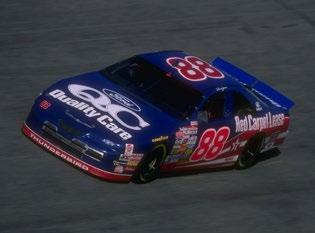
July 13 New Hampshire Motor Speedway Jeff Burton
July 20 Pocono Raceway Dale Jarrett
Aug. 2 Indianapolis Motor Speedway Ricky Rudd
Aug. 10 Watkins Glen International Jeff Gordon
Aug. 17 Michigan International Speedway Mark Martin
Aug. 23 Bristol Motor Speedway Dale Jarrett
Sept.1 Darlington Raceway Jeff Gordon
Sept. 6 Richmond Raceway Dale Jarrett
Sept. 14 New Hampshire Motor Speedway Jeff Gordon
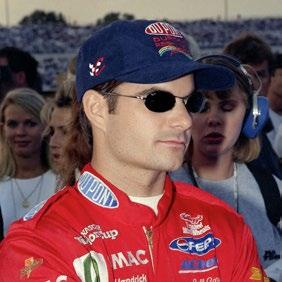
Sept. 21 Dover Motor Speedway Mark Martin
Sept. 29 Martinsville Speedway Jeff Burton
Oct. 5 Charlotte Motor Speedway Dale Jarrett
Oct. 12 Talladega Superspeedway Terry Labonte
Oct. 27 Rockingham Speedway Bobby Labonte
Nov. 2 Phoenix Raceway Dale Jarrett
Nov. 16 Atlanta Motor Speedway Bobby Labonte
BEST DRIVER
JEFF GORDON, DRIVER OF THE NO. 24
Hendrick Motorsports Chevrolet, won 10 Cup Series races with eight coming on superspeedways and two on short tracks. He won his first Daytona 500 to open the schedule and followed it with a victory at Rockingham Speedway. Even though the season went well, Gordon’s championship hopes were nearly dashed when lateseason problems threatened his second title. A dose of luck and perseverance are credited with saving his year.
PRESIDENT:
CLINTON NO. 1 AT THE BOX OFFICE: MEN IN BLACK NO. 1 SONG: “CANDLE IN THE WIND 1997” BY ELTON JOHN GALLON OF GAS: $1.22 POP CULTURE: J.K. ROWLING’S FIRST HARRY POTTER
BEST RACE
DRIVING HIS OWN NO. 10 RUDD Performance Motorsports Ford, Ricky Rudd held off Bobby Labonte, in the No. 18 Joe Gibbs Racing Chevrolet, to win the fourth annual Brickyard 400 at Indianapolis Motor Speedway. Rudd held a .183-second advantage at the end and became the race’s fourth different winner, joining Jeff Gordon, Dale Earnhardt and Dale Jarrett in visiting Victory Lane at the legendary track. Gordon led the majority of the 160-lap race.
TOP CARS
JEFF GORDON’S NO. 24 HENDRICK Motorsports Chevrolet scored 10 wins with 23 top-10 finishes during the 32-race Cup Series season. With secondgeneration star Dale Jarrett behind the wheel, the No. 88 Robert Yates Racing Ford made seven visits to Victory Lane.
101
97
BILL
NOVEL, “THE PHILOSOPHER’S STONE,” DEBUTED.
1997
Jeff Gordon, driver of the No. 24 Hendrick Motorsports Chevrolet, recorded 10 victories, 23 top-10 finishes and one pole position in 1997, as the California driver claimed his second NASCAR Cup Series championship in three years.
Jeff Gordon Wins 13 Races 98
Jeff Gordon, driver of the No. 24 Hendrick Motorsports Chevrolet, recorded 13 victories, 28 top-10 finishes and seven pole positions en route to his third Cup Series championship and the fourth straight for Hendrick Motorsports.
If the 1997 NASCAR Cup Series season was magical and a bit lucky for Jeff Gordon and the Ray Evernham-led No. 24 Hendrick Motorsports team, the 1998 campaign was nothing short of phenomenal.
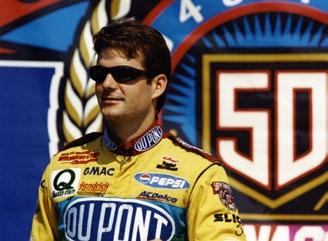
The chemistry between Gordon and Evernham was at an alltime high and their 13 victories throughout the season forced the motorsports media to scramble for new and creative things to say in headlines and news stories about how well they were performing.
Fans began showing up at tracks with signs and T-shirts that read, “Anybody But Gordon.” They were tired of seeing his Rainbow-colored Chevrolet roll into Victory Lane virtually everywhere it raced.
Gordon’s 13 wins in a single season were third best behind Richard Petty’s incredible season when he won 27 of 48 races. including 10 consecutively, and Tim Flock’s 1955 effort in which he won 18 of 39 races.
Mark Martin, driver of the No. 6 Roush Racing Ford, was Gordon’s closest rival in points but notched only seven wins during the season and was 364 markers back when the schedule ended at Atlanta Motor Speedway in November.
Only two DNFs – at Texas in April for handling issues and a crash at Richmond in June – were the No. 24 team’s only blemishes. With his convincing victory at California’s Sonoma Raceway on June 28, Gordon took the points lead and never relinquished it for the remaining 17 races.
It was truly the best season of Gordon’s NASCAR Cup Series career, which began in 1992 and ended in 2016.
SEASON RECAP
DATE LOCATION WINNER
Feb. 15 Daytona International Speedway Dale Earnhardt
Feb. 22 Rockingham Speedway Jeff Gordon
March 1 Las Vegas Motor Speedway Mark Martin
March 9 Atlanta Motor Speedway Bobby Labonte
March 22 Darlington Raceway Dale Jarrett
March 29 Bristol Motor Speedway Jeff Gordon
April 5 Texas Motor Speedway Mark Martin
April 20 Martinsville Speedway Bobby Hamilton
April 26 Talladega Superspeedway Bobby Labonte
May 3 Auto Club Speedway Mark Martin
May 24

Charlotte Motor Speedway Jeff Gordon
May 31 Dover Motor Speedway Dale Jarrett
June 6 Richmond Raceway Terry Labonte
June 14 Michigan International Speedway Mark Martin
June 21 Pocono Raceway Jeremy Mayfield
June 28 Sonoma Raceway Jeff Gordon
July 12 New Hampshire Motor Speedway Jeff Burton
July 26 Pocono Raceway Jeff Gordon
Aug. 1 Indianapolis Motor Speedway Jeff Gordon
Aug. 9 Watkins Glen International Jeff Gordon
Aug. 16 Michigan International Speedway Jeff Gordon
Aug. 22 Bristol Motor Speedway Mark Martin
Aug. 30 New Hampshire Motor Speedway Jeff Gordon
Sept. 6 Darlington Raceway Jeff Gordon
Sept.12 Richmond Raceway Jeff Burton
Sept. 20 Dover Motor Speedway Mark Martin
Sept. 27 Martinsville Speedway Ricky Rudd
Oct. 4 Charlotte Motor Speedway Mark Martin
Oct. 11 Talladega Superspeedway Dale Jarrett
Oct. 17 Daytona International Speedway Jeff Gordon
Oct. 25 Phoenix Raceway Rusty Wallace
Nov. 1 Rockingham Speedway Jeff Gordon
Nov. 8 Atlanta Motor Speedway Jeff Gordon
PRESIDENT: BILL CLINTON NO. 1 SONG: “TOO CLOSE” BY NEXT NO. 1 AT THE BOX OFFICE: TITANIC GALLON OF GAS: $1.06 POP CULTURE: INTERNET SEARCH ENGINE GOOGLE WAS FOUNDED ON SEPT. 4, 1998. TODAY, IT STANDS AMONG THE TOP-FIVE COMPANIES OF THE WORLD.

BEST DRIVER
DRIVING THE NO. 24 HENDRICK Motorsports Chevrolet, Jeff Gordon won 13 NASCAR Cup Series races in 1998 and amazingly, all of them were on superspeedways or road courses. His biggest wins of the season came with six in a seven-week stretch at Pocono, Indianapolis, Watkins Glen, Michigan, New Hampshire and Darlington. The one race in that stretch that he did not win was at Bristol, where he finished fifth. Gordon’s average finish that season was 5.7.
BEST RACE
IN THE SEASON-OPENING DAYTONA 500, Dale Earnhardt, driving the No. 3 Richard Childress Racing Chevrolet, finally won NASCAR’s most prestigious race. The second-generation driver from Kannapolis, North Carolina, had come close to winning the Daytona 500 on many occasions over the previous 19 years but couldn’t seal the deal. After leading 107 of 200 laps, the race was finally his. It is known as one of the most memorable races in NASCAR’s storied history.
TOP CARS
JEFF GORDON’S NO. 24
Hendrick Motorsports Chevrolet won 13 times and recorded 28 top-10 finishes in 33 Cup Series starts.
Mark Martin drove the No. 6 Roush Racing Ford to seven victories and 26 top-10 results during the 1998 season.
102 THROUGH THE YEARS 1998
Like Father, Like Son
Jarrett, the son of two-time NASCAR champion Ned Jarrett, completed his 15th NASCAR Cup Series season with one of the sport’s most powerful teams.
Robert Yates Racing was considered a strong title contender dating back to 1989 when the late Davey Allison began winning in the team’s No. 28 Ford.
Jarrett joined RYR four years earlier as part of an ongoing transition after Allison’s death on July 13, 1993, as the result of a helicopter crash one day earlier. Under the direction of crew chiefs Larry McReynolds and later Todd Parrott, the team had returned to championship form after Allison came within reach of the title during the 1992 Cup Series season finale at Atlanta.
Victories at Richmond, Michigan, Daytona and Indianapolis served as the foundation for a championship effort that included 24 top-five finishes and 29 top-10 results in 34 starts.
Jarrett began the year 36th in points after an early crash during the seasonopening Daytona 500, but by the spring event at Bristol Motor Speedway, he had recovered to second in points through a string of top-10 finishes. When the Cup Series visited Richmond on May 15, Jarrett left Virginia with a victory and the lead in the Cup Series standings. Jarrett, Parrott, Robert Yates and their crew put together an effort that kept the No. 88 Ford on top throughout the remainder of the season.
Jarrett, of Conover, North Carolina, clinched the championship one week early at Homestead-Miami Speedway and enjoyed the champion’s celebration the next week at Atlanta.
SEASON RECAP
DATE LOCATION WINNER
Feb. 14 Daytona International Speedway Jeff Gordon
Feb. 21 Rockingham Speedway Mark Martin
March 7 Las Vegas Motor Speedway Jeff Burton
March 14 Atlanta Motor Speedway Jeff Gordon
March 21 Darlington Speedway Jeff Burton
March 28 Texas Motor Speedway Terry Labonte
April 11 Bristol Motor Speedway Rusty Wallace
April 18 Martinsville Speedway John Andretti
April 25 Talladega Superspeedway Dale Earnhardt
May 2 California Speedway Jeff Gordon
May 15 Richmond Raceway Dale Jarett
May 30 Charlotte Motor Speedway Jeff Burton
June 6 Dover International Speedway Bobby Labonte
June 13 Michigan International Speedway Dale Jarrett
June 20 Pocono Raceway Bobby Labonte
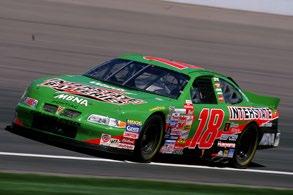
June 27 Sonoma Raceway Jeff Gordon
July 3 Daytona International Speedway Dale Jarett
July 11 New Hampshire Motor Speedway Jeff Burton
July 25 Pocono Raceway Bobby Labonte
Aug. 7 Indianapolis Motor Speedway Dale Jarrett
Aug. 15 Watkins Glen International Jeff Gordon
Aug. 22 Michigan International Speedway Bobby Labonte
Aug. 28 Bristol Motor Speedway Dale Earnhardt
Sept. 5 Darlington Raceway Jeff Burton
Sept. 11 Richmond Raceway Tony Stewart
Sept. 19 New Hampshire Motor Speedway Joe Nemechek
Sept. 26 Dover International Speedway Mark Martin
Oct. 3 Martinsville Speedway Jeff Gordon
Oct. 11 Charlotte Motor Speedway Jeff Gordon
Oct. 17 Talladega Superspeedway Dale Earnhardt
Oct. 24 Rockingham Speedway Jeff Burton
Nov. 7 Phoenix International Raceway Tony Stewart
Nov. 14 Homestead-Miami Speedway Tony Stewart
Nov. 21 Atlanta Motor Speedway Bobby Labonte
PRESIDENT: BILL CLINTON NO. 1 SONG: “BELIEVE,” BY CHER NO. 1 BOX OFFICE: STAR WARS: EPISODE I – THE PHANTOM MENACE GALLON OF GAS: $1.30 POP CULTURE: SPONGEBOB
BEST DRIVER
JEFF GORDON, DRIVER OF THE NO. 24 Hendrick Motorsports Chevrolet, scored seven victories, 18 top-five finishes, 21 top-10 results and seven pole positions in 34 starts during the 1999 season. His biggest victories came in the season-opening Daytona 500 during February and the fall race at Charlotte Motor Speedway. Gordon also scored race wins that year at Atlanta, California and Martinsville in addition to sweeping the two road course races.
BEST RACE
ON AUG. 28, 1999 AT BRISTOL MOTOR Speedway, Dale Earnhardt, driving the No. 3 Richard Childress Racing Chevrolet, stayed close on the rear bumper of Terry Labonte’s No. 5 Hendrick Motorsports Chevrolet until spinning Labonte off Turn 2 on the final lap. Earnhardt said was wanted to “rattle his cage” but heard a chorus of boos from the grandstands. Ninth-place finisher Labonte was not happy with Earnhardt while addressing the media after the race.
TOP CARS
DALE JARRETT’S No. 88 Robert Yates Racing Ford recorded four victories and 29 top-10 finishes in 34 Cup Series starts. Bobby Labonte’s No. 18 Joe Gibbs Racing Pontiac scored five wins with 26 top-10 results and five poles in 34 races.
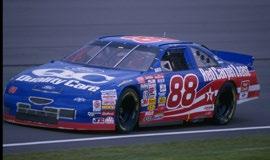

103
99
PREMIERES
1999
Dale Jarrett held steady in his Robert Yates Racing Ford during the 1999 season to claim the lone NASCAR Cup Series championship of his career on the strength of four victories.
Bobby Labonte Wins for JGR
Bobby Labonte, driving the No. 18 Joe Gibbs Racing Pontiac, earned four victories, 24 top-10 finishes and two poles en route to his lone NASCAR Cup Series championship and the first series title for JGR.
BEST DRIVER
BOBBY LABONTE, driving the No. 18 Joe Gibbs Racing Pontiac, recorded four NASCAR Cup Series victories with 24 top-10 finishes. His best results came at his favorite tracks, the 1.5-mile ovals, along with Indianapolis Motor Speedway, which is 2.5 miles per lap. Jeff Burton and Rusty Wallace also won four races each, but Labonte notched more top-five efforts, translating into additional championship points and the lone Cup Series title of his career.
BEST RACE

SEASON RECAP
DATE LOCATION WINNER
Feb. 20 Daytona International Speedway Dale Jarrett
Feb. 27 Rockingham Speedway Bobby Labonte
March 5 Las Vegas Motor Speedway Jeff Burton
March 12 Atlanta Motor Speedway Dale Earnhardt
March 19 Darlington Raceway Ward Burton
March. 26 Bristol Motor Speedway Rusty Wallace
April 2 Texas Motor Speedway Dale Earnhardt Jr.
April 9 Martinsville Speedway Mark Martin
April 16 Talladega Superspeedway Jeff Gordon
April 30 Auto Club Speedway Jeremy Mayfield
May 6 Richmond Raceway Dale Earnhardt Jr.
May 28 Charlotte Motor Speedway Matt Kenseth
June 4 Dover Motor Speedway Tony Stewart
June 11 Michigan International Speedway Tony Stewart
June 19 Pocono Raceway Jeremy Mayfield
June 25 Sonoma Raceway Jeff Gordon
July 1 Daytona International Speedway Jeff Burton
July 9 New Hampshire Motor Speedway Tony Stewart
July 23 Pocono Raceway Rusty Wallace
Aug. 5 Indianapolis Motor Speedway Bobby Labonte
Aug. 13 Watkins Glen International Steve Park
Aug. 20 Michigan International Speedway Rusty Wallace
Aug. 26 Bristol Motor Speedway Rusty Wallace
Sept. 3 Darlington Raceway Bobby Labonte
Sept. 9 Richmond Raceway Jeff Gordon
Sept.17 New Hampshire Motor Speedway Jeff Burton
Sept.24 Dover Motor Speedway Tony Stewart
Oct. 1 Martinsville Speedway Tony Stewart
Oct. 8 Charlotte Motor Speedway Bobby Labonte
Oct. 15 Talladega Superspeedway Dale Earnhardt
Labonte, a native of Corpus Christi, Texas, followed his older brother, Terry, into the Cup Series. The younger Labonte won the Xfinity Series title in 1991 driving a Chevrolet fielded by his father, Bob. He drove in the two Cup Series races for his father that season as well.
Eventually, Labonte joined team owner Bill Davis for the 1993 season and won Cup Series rookie-of-the-year honors. The rising star remained with Davis’ team until joining team owner Joe Gibbs in 1995. Over the next five seasons, Labonte posted 12 victories with the help of crew chief Jimmy Makar.
During the 2000 season, the No. 18 team only logged wins at Rockingham Speedway, Indianapolis Motor Speedway, Darlington Raceway and Charlotte Motor Speedway throughout the 34-race schedule. It was their work in the shop and consistency at the tracks that made up for the lack of winning.
Their closest rival, Dale Earnhardt, was back on his championship game with two wins and 24 top-10 finishes in the No. 3 Richard Childress Racing Chevrolet. Even though neither diver came close to dominating the win column, their up-front finishes continuously placed them within striking distance of the ultimate prize.
Labonte finished the season 265 points ahead of Earnhardt. Labonte finished fifth behind race winner Jerry Nadeau in the season finale at Atlanta while Earnhardt was second.
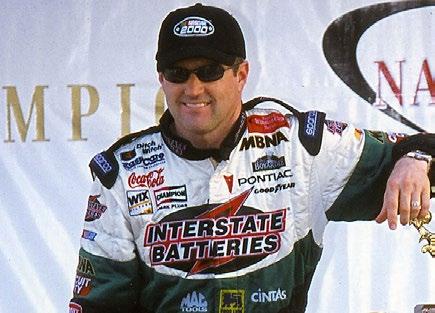
Still, Labonte’s season was of championship caliber from start to finish.
ON OCT. 15 AT Talladega Superspeedway, Dale Earnhardt came from 22nd to first in the final 10 laps to win the Winston 500. Earnhardt used the draft and his spectacular driving ability to snake between cars. With six laps to go he was 16th, and by the time the checkered flag waved, he had scored his 10th Cup Series victory at the 2.66-mile Alabama track. It was the final victory for the seven-time Cup Series champion.
TOP CARS

BOBBY LABONTE’S
No. 18 Interstate Batteries Pontiac had four wins, 24 top-10 finishes and two pole positions in 34 starts.
Dale Earnhardt’s GM Goodwrench Chevrolet went to Victory Lane twice and had 24 top-10 results in the 34-race season.

Oct. 22 Rockingham Speedway Dale Jarrett
Nov. 5 Phoenix Raceway Jeff Burton
Nov. 12 Homestead-Miami Speedway Tony Stewart
Nov. 20 Atlanta Motor Speedway Jerry Nadeau
104 THROUGH THE YEARS
2000 PRESIDENT Bill Clinton NO. 1 AT THE BOX OFFICE How the Grinch Stole Christmas NO. 1 SONG “Breathe” by Faith Hill POP CULTURE Sony Entertainment launches Playstation 2
OF GAS $1.51
GALLON
Veteran Gordon Dominates Title Hunt
The 2001 NASCAR Sprint Cup Series season was one of triumph and tragedy, as stock car racing lost is brightest star while a popular champion visited Victory Lane six times en route to his fourth series title.
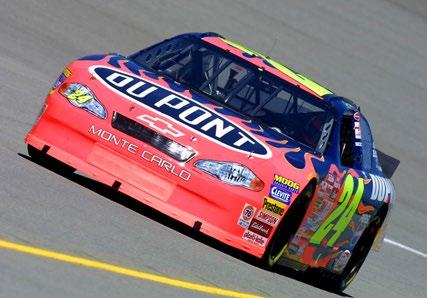
BEST DRIVER
KEVIN HARVICK, driver of the No. 29 Richard Childress Racing Chevrolet, won at Atlanta and Chicago during his rookie Cup Series season. Even though he had ARCA, NASCAR K&N Pro Series East and West, NASCAR Camping World Truck Series and NASCAR XFINITY Series experience, Harvick had spent little time in the highly competitive NASCAR Sprint Cup Series cars. Driving in place of the late Earnhardt, the pressure subsided enough to finish ninth in NASCAR Sprint Cup Series points.
BEST RACE
SEASON RECAP
DATE LOCATION
Feb. 18 Daytona International Speedway Michael Waltrip
Feb. 26 North Carolina Motor Speedway Steve Park
March 4 Las Vegas Motor Speedway
March 11
March 18 Darlington Raceway
March 25 Bristol Motor Speedway
April 1 Texas Motor Speedway
April 8 Martinsville Speedway
April 22 Talladega Superspeedway
April 29 California Speedway
May 5 Richmond International Raceway
May 26 Charlotte Motor Speedway
June 3 Dover International Speedway
June 10 Michigan International Speedway
The season-opening Daytona 500 transformed into an afternoon of tremendous excitement and deep sadness at the conclusion of the 200-lap race. Michael Waltrip, a longtime driver with no victories in 463 NASCAR Sprint Cup Series starts, pulled off the biggest upset in the history of Daytona International Speedway.
As he celebrated in Victory Lane following NASCAR’s most prestigious event, word spread that his team owner, Dale Earnhardt, had lost his life during a multi-car crash in Turn 4 of the final lap. Waltrip and Dale Earnhardt Jr., both drivers for Dale Earnhardt Inc., were just ahead of Earnhardt’s No. 3 Chevrolet coming to the checkered flag. Each looked forward to Earnhardt’s presence when trophies were awarded as word quietly spread that the crash had taken his life.
In the weeks that followed, Steve Park, a third DEI driver, won at North Carolina Motor Speedway and helped ease the incredible pain everyone was experiencing. Then relative newcomer Kevin Harvick was hired by Richard Childress Racing to replace Earnhardt in the renumbered 29 Chevy and he won the Atlanta race by a fender over Jeff Gordon.

Gordon’s 40th-place finish in the Daytona 500 threatened to curtail his championship hopes. But his first win came just weeks later at Las Vegas Motor Speedway and from there the native of Vallejo, California, used strong, consistent finishes to climb to the top of the standings. Additional victories at Dover, Michigan, Indianapolis, Watkins Glen and Kansas paved the way for Gordon’s fourth NASCAR Sprint Cup Series title.
THE SPRING EVENT AT Bristol Motor Speedway on March 25, 2001, saw Elliott Sadler and John Andretti battle for the win with Sadler going to Victory Lane. Sadler and Andretti were driving a Ford and Pontiac, respectively, for Wood Brothers Racing and Petty Enterprises. The two revered NASCAR Sprint Cup Series teams finished first and second to each other 63 times with David Pearson winning 33 and Richard Petty winning 30 while with those teams.
TOP CARS
JEFF GORDON collected five wins in 36 starts driving the No. 24 DuPont Chevrolet.
Dale Jarrett won races at Darlington, Martinsville, Texas and New Hampshire in the No. 88 UPS Ford.
June 17 Pocono Raceway
June 24 Sonoma Raceway
July 7 Daytona International Speedway
July 15 Chicagoland Speedway
July 22 New Hampshire Motor Speedway
July 29 Pocono Raceway
Aug. 5 Indianapolis Motor Speedway
Aug. 12 Watkins Glen International
Aug. 19 Michigan International Speedway
Aug. 25 Bristol Motor Speedway
Sept. 2 Darlington Raceway
Sept. 8 Richmond International Raceway
Sept. 23 Dover International Speedway
Sept. 30 Kansas Speedway
Oct. 7 Charlotte Motor Speedway
Oct. 15 Martinsville Speedway
Oct. 21 Talladega Superspeedway
Oct. 28 Phoenix International Raceway
Nov. 4 North Carolina Motor Speedway
Nov. 11 Homestead-Miami Speedway
Nov. 18 Atlanta Motor Speedway
Nov. 23 New Hampshire Motor Speedway
“All
Harvick
Sadler
Jarrett
Wallace
Stewart
Burton
Gordon
Gordon
Rudd
Stewart
Earnhardt Jr.
Harvick
Jarrett
Labonte
Jackson
Rudd
Earnhardt Jr.
Gordon
Marlin
Craven
Earnhardt Jr.
Burton
Nemechek
Gordon
105
2001 PRESIDENT George W. Bush NO. 1 AT THE BOX OFFICE Beverly Hills Cop II NO. 1 SONG
Center
on Sept. 11.
Of You” by Janet
HISTORY World Trade
and Pentagon attacked
WINNER
Jeff
Gordon
Kevin
Atlanta Motor Speedway
Dale
Jarrett
Elliott
Dale
Dale
Jarrett
Bobby
Hamilton
Rusty
Tony
Jeff
Jeff
Jeff
Ricky
Tony
Dale
Kevin
Dale
Bobby
Jeff
Gordon
Jeff
Gordon
Sterling
Marlin
Tony
Stewart
Ward
Burton
Ricky
Dale
Jeff
Sterling
Ricky
Dale
Jeff
Joe
Bill
Elliott
Bobby
Labonte
Robby
01
Stewart Becomes a NASCAR Champ
Driving the No. 20 Joe Gibbs Racing Pontiac, former open-wheel sensation Tony Stewart, from Columbus, Ind., recorded three wins and had 21 top-10 finishes en route to his first NASCAR Cup Series championship.
Stewart came to NASCAR in 1995 through the Xfinity Series after a very successful open-wheel career that included championships in midget, sprint car and Indy car competition. His next quest was NASCAR and thanks to an opportunity provided by legendary NFL coach turned race team owner Joe Gibbs, Stewart would try his hand at the heavier stock cars of the NASCAR Cup Series circuit.
Stewart warmed up with the Xfinity Series cars from 1995 through 1998 in select events before tackling the Cup Series full time in 1999. The results were impressive, as he won three times that season at Richmond, Phoenix and Homestead
Three more victories came in each of the 2000 and 2001 seasons, setting the stage for a possible championship run in 2002. Stewart and crew Greg Zipadelli felt they were ready for the daunting challenge as long as their equipment held together. That wasn’t the case, however, during the season-opening Daytona 500 as Stewart’s engine expired, leaving him with a 42ndplace finish.
Steadily, Stewart and his team dug themselves out of the hole with wins at Atlanta in March, Richmond in May and Watkins Glen in August. With his second-place finish at Talladega Superspeedway on Oct. 6, Stewart gained the points lead and held it for the remaining six races.

His eighth-place finish at Phoenix and 16th at Homestead in the final two races helped to ice the title with a 63-point advantage over Mark Martin.
BEST DRIVER
TONY STEWART, driver of the No. 20 Joe Gibbs Racing Home Depot Pontiac, won three NASCAR Cup Series races and had 21 top-10 finishes in 36 races. Getting off to a slow start, Stewart and his JGR crew worked race by race to improve their performance and managed to build their way into the championship hunt. With less than 10 races remaining, they took the points lead and held it until the final checkered flag.
BEST RACE

ON OCT. 13, JAMIE McMurray, a relative unknown in Cup Series circles, filled in for the injured Sterling Marlin and drove the No. 40 Chip Ganassi Racing Dodge to Victory Lane at Charlotte Motor Speedway. It was only McMurray’s second series start but he drove like a seasoned veteran, leading 96 of 334 laps. McMurray went on to win Cup Series races at Daytona, Talladega, Indianapolis and again at Charlotte during his career.
TOP CARS

TONY STEWART’S NO. 20 Joe Gibbs Racing Home Depot Pontiac recorded three Cup Series wins and had 21 top-10 finishes in 36 starts. The No. 6 Roush Racing Viagra Ford driven by Mark Martin posted one win and 22 top-10 results during the 2002 season.

SEASON RECAP
DATE LOCATION WINNER
Feb. 17 Daytona International Speedway Ward Burton
Feb. 24 Rockingham Speedway Matt Kenseth
March 3 Las Vegas Motor Speedway Sterling Marlin
March 10 Atlanta Motor Speedway Tony Stewart
March 17 Darlington Raceway Sterling Marlin
March 24 Bristol Motor Speedway Kurt Busch
April 7 Texas Motor Speedway Matt Kenseth
April 14 Martinsville Speedway Bobby Labonte
April 21 Talladega Superspeedway Dale Earnhardt Jr.
April 28 Auto Club Speedway Jimmie Johnson
May 5 Richmond Raceway Tony Stewart
May 26 Charlotte Motor Speedway Mark Martin
June 2 Dover Motor Speedway Jimmie Johnson
June 9 Pocono Raceway Dale Jarrett
June 16 Michigan International Speedway Matt Kenseth
June 23 Sonoma Raceway Ricky Rudd
July 6 Daytona International Speedway Michael Waltrip
July 14 Chicagoland Speedway Kevin Harvick
July 21 New Hampshire Motor Speedway Ward Burton
July 28 Pocono Raceway Bill Elliott
Aug. 4 Indianapolis Motor Speedway Bill Elliott
Aug. 11 Watkins Glen International Tony Stewart
Aug. 18 Michigan Int’l Speedway Dale Jarrett
Aug. 24 Bristol Motor Speedway Jeff Gordon
Sept. 1 Darlington Raceway Jeff Gordon
Sept. 7 Richmond Raceway Matt Kenseth
Sept. 15 New Hampshire Motor Speedway Ryan Newman
Sept. 22 Dover Motor Speedway Jimmie Johnson
Sept. 29 Kansas Speedway Jeff Gordon
Oct. 6 Talladega Superspeedway Dale Earnhardt Jr.
Oct. 13 Charlotte Motor Speedway Jamie McMurray
Oct. 20 Martinsville Speedway Kurt Busch
Oct. 27 Atlanta Motor Speedway Kurt Busch
Nov. 3 Rockingham Speedway Johnny Benson
Nov. 10 Phoenix Raceway Matt Kenseth
Nov. 17 Homestead-Miami Speedway Kurt Busch
The 19TH Winter Olympics were held in Salt Lake City in February.
106 THROUGH THE YEARS 02
2002 PRESIDENT George W. Bush
1 AT THE BOX OFFICE Spider-Man
1 SONG
Remind Me”
POP CULTURE
NO.
NO.
“How You
by Nickelback
GALLON OF GAS $1.65
Consistency Carries Kenseth
Matt Kenseth, driver of the No. 17 Roush Racing Ford, collected one win and 25 top-10 finishes to secure his lone NASCAR Cup Series championship and the first series title for team owner and automotive businessman Jack Roush.
BEST DRIVER
WISCONSIN SHORTtrack graduate Matt Kenseth, driving the No. 17 Roush Racing DeWalt Tools Ford, enjoyed a smooth and consistent season as he led the standings for a majority of the 36-race schedule. Kenseth won only one race – Las Vegas in March – but was able to keep his car in contention on a weekly basis. Consistency was his gameplan and it proved simple, yet effective in securing his lone NASCAR Cup Series championship.
BEST RACE
SEASON RECAP
Feb.
Feb.
March
March
March
March
March.
April
April
April
May
May
June
July
July
July
Aug.
Aug.
Aug.
Aug.
Aug.
Sept.
Sept.
Sept.
Sept.
Oct.
Oct.
While racing on the short tracks in his home state of Wisconsin, Kenseth made winning look easy. He dreamed of one day taking his talents to a new level, hoping to eventually travel south and try his hand in NASCAR.
After finding success in the NASCAR Xfinity Series, Kenseth’s big day finally arrived in September 1998 when he was called to drive Bill Elliott’s car at Dover while Elliott attended his father’s funeral. Kenseth finished a very impressive sixth.
In 1999, Kenseth competed in five Cup Series races for team owner Jack Roush, scoring one top-10 finish. The following year, Kenseth began driving for Roush full time and won his first Cup Series race in the 2000 CocaCola 600 at Charlotte Motor Speedway.
There were no wins in 2001 but five wins came in 2002. Then in 2003, Kenseth and crew chief Robbie Reiser put together a phenomenal season that kept them at the top of the points chart for 32 of the 35 races on the schedule.
Kenseth began the year in 19th in the standings after the season-opening Daytona 500. The next week, he finished third at Rockingham Speedway and then collected his only win of the year at Las Vegas. A fourth-place effort at Atlanta put him on top of the points.
No one could touch him as he continued to record top10 finishes race after race.
All told, Kenseth finished 90 points ahead of Jimmie Johnson, driver of the No. 48 Hendrick Motorsports Chevrolet.
DURING THE FINAL laps of the Carolina Dodge Dealers 400 at Darlington Raceway on March 16, Kurt Busch and Ricky Craven battled hard for the win, swapping the lead multiple times. As the two drivers crossed under the checkered flag, their cars tangled and locked together in a heap of smoke and bent sheet metal. Craven won the race by a mere bumper width in the most dramatic finish at the legendary track.
TOP CARS
MATT KENSETH’S NO. 17 Roush Racing DeWalt Tools Ford won one Cup Series race and had 25 top-10 finishes after 36 starts.
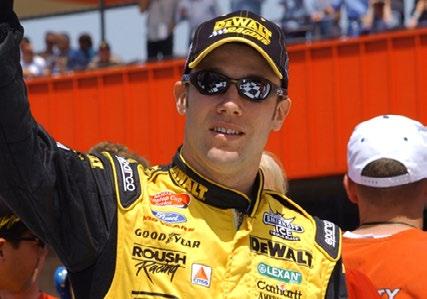
The No. 48 Hendrick Motorsports Lowe’s Chevrolet, driven by Jimmie Johnson, topped three races with 20 top10 results.

Oct.
Oct.
Nov.
Nov.
Nov.
PRESIDENT George W. Bush
NO. 1 AT THE BOX OFFICE Finding Nemo
NO. 1 SONG
“In Da Club” by 50 Cent
HISTORY
The Space Shuttle Columbia disintegrated over Texas upon reentry, killing all seven astronauts on board.
GALLON OF GAS
$1.75
107
2003
DATE LOCATION WINNER
16 Daytona International Speedway Michael Waltrip
23 Rockingham Speedway Dale Jarrett
2 Las Vegas Motor Speedway Matt Kenseth
Atlanta Motor
Bobby Labonte
9
Speedway
Darlington
Ricky Craven
16
Raceway
Kurt Busch
23 Bristol Motor Speedway
Ryan Newman
30 Texas Motor Speedway
Dale
6 Talladega Superspeedway
Earnhardt Jr.
Jeff Gordon
13 Martinsville Speedway
Kurt
27 Auto Club Speedway
Busch
Joe Nemechek
3 Richmond Raceway
Jimmie
25 Charlotte Motor Speedway
Johnson
Ryan Newman
June 1 Dover Motor Speedway
Tony Stewart
June 8 Pocono Raceway
Michigan
Kurt Busch
June 15
International Speedway
Sonoma
Robby Gordon
22
Raceway
Daytona
Greg Biffle
5
International Speedway
Chicagoland
Ryan Newman
13
Speedway
New
Jimmie Johnson
Pocono Raceway Ryan Newman
20
Hampshire Motor Speedway
July 27
Kevin Harvick
3 Indianapolis Motor Speedway
Robby Gordon
10 Watkins Glen International
Ryan Newman
17 Michigan International Speedway
Kurt Busch
23 Bristol Motor Speedway
Terry Labonte
31 Darlington Raceway
Ryan Newman
6 Richmond Raceway
Jimmie Johnson
14 New Hampshire Motor Speedway
Dover
Ryan Newman
21
Motor Speedway
Talladega Superspeedway Michael Waltrip
28
Kansas Speedway Ryan Newman
5
11 Charlotte Motor Speedway Tony Stewart
19 Martinsville Speedway Jeff Gordon
27 Atlanta Motor Speedway Jeff Gordon
Phoenix
Dale Earnhardt Jr.
2
Raceway
Rockingham
Bill Elliott
9
Speedway
Bobby Labonte 03
16 Homestead-Miami Speedway
Kurt Busch Peerless in Playoff
Utilizing a new format known as the Chase for the NASCAR NEXTEL Cup, champ Kurt Busch was the only driver to score top-10 finishes in nine of the 10 races during the season-ending playoff.
BEST DRIVER
DALE EARNHARDT JR., driver of the No. 8 Dale Earnhardt Inc. Chevrolet, won six races during the 2004 Cup Series season, logging 21 top10 finishes. The native of Kannapolis, North Carolina, finished fifth in points after suffering DNFs at Las Vegas, California, Martinsville and Atlanta. His average start was 10.9 and he had an average finish of 12.1 during the 36-race Cup Series season. What he gained in wins was erased by the quartet of DNFs.
BEST RACE
SEASON RECAP
DATE LOCATION WINNER
Feb.15 Daytona International Speedway Dale Earnhardt Jr.
Feb. 22 Rockingham Speedway Matt Kenseth
March 7 Las Vegas Motor Speedway Matt Kenseth
March 14 Atlanta Motor Speedway Dale Earnhardt Jr.
March 21 Darlington Raceway Jimmie Johnson
March 28 Bristol Motor Speedway Kurt Busch
April 4 Texas Motor Speedway Elliott Sadler
April 18 Martinsville Speedway Rusty Wallace
April 25 Talladega Superspeedway Jeff Gordon
May 2 Auto Club Speedway Jeff Gordon
May 15 Richmond Raceway Dale Earnhardt Jr.
May 30 Charlotte Motor Speedway Jimmie Johnson
June 6 Dover Motor Speedway Mark Martin
June 13 Pocono Raceway Jimmie Johnson
June 20 Michigan International Speedway Ryan Newman
June 27 Sonoma Raceway Jeff Gordon
July 3 Daytona International Speedway Jeff Gordon
July 11 Chicagoland Speedway Tony Stewart
July 25 New Hampshire Motor Speedway Kurt Busch
Aug. 1 Pocono Raceway Jimmie Johnson
Aug. 8 Indianapolis Motor Speedway Jeff Gordon
Aug. 15 Watkins Glen International Tony Stewart
Aug. 22 Michigan International Speedway Greg Biffle
Aug. 28 Bristol Motor Speedway Dale Earnhardt Jr.
Sept. 5 Auto Club Speedway Elliott Sadler
Sept. 11 Richmond Raceway Jeremy Mayfield
Sept. 19 New Hampshire Motor Speedway Kurt Busch
Sept. 26 Dover Motor Speedway Ryan Newman
Oct. 3 Talladega Superspeedway Dale Earnhardt Jr.
Oct. 10 Kansas Speedway Joe Nemechek
Oct. 16 Charlotte Motor Speedway Jimmie Johnson
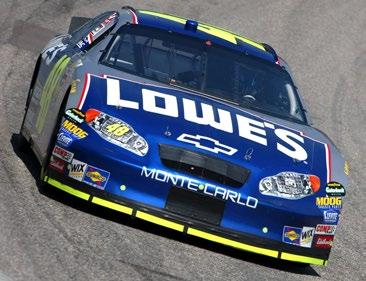
Busch was the 1998 rookie of the year in the NASCAR Southwest Series and earned the series title the following year. That led to a tryout in a Roush Racing “Gong Show,” which he won and earned a Craftsman Truck Series ride.
The Las Vegas native began his tenure in NASCAR’s Cup Series with Roush Racing by making seven starts in 2000. Under the guidance of longtime crew chief Jeff Hammond, his best finish of 19th came at Florida’s Homestead-Miami Speedway.
Busch went winless in 2001 but visited Victory Lane four times in both 2002 and 2003. He had found something special with veteran crew chief Jimmy Fennig, a winner of 24 Cup Series races with drivers Bobby Allison and Mark Martin before joining forces with Busch in 2002
Busch was in the best position to challenge for the Cup Series championship in 2003. He had a winning crew chief who provided great chemistry when it came to preparing their No. 97 Roush Racing Ford as Busch had proven he could win anywhere.
The Chase produced the closest points battle in NASCAR Cup Series history with Busch beating Jimmie Johnson by eight points to claim his first series championship.
Busch was seventh of the 10 drivers entering the Chase and jumped to second in the standings following his victory in the opener at New Hampshire Motor Speedway. He took command of the standings following race No. 3 of 10 and held off Johnson’s late-season charge that included four wins in the final six races.

DRIVING THE NO. 19 Evernham Motorsports Dodge, Jeremy Mayfield led 151 of 400 laps to win the Chevy Rock N’ Roll 400 at Richmond Raceway. Mayfield was in a must-win situation to advance into the playoffs and seemingly had all the odds against him. Mayfield took the lead for the final time on lap 393 from Kurt Busch. The celebration in Victory Lane was extra special because of the opportunity to compete for the championship.
TOP CARS
KURT BUSCH’S NO. 97 Roush Racing
Rubbermaid Ford won three times and had 21 top-10 finishes in 36 Cup Series starts.
Dominating the win column, Jimmie Johnson wheeled the No. 48 Hendrick Motorsports Lowe’s Chevrolet to eight Cup Series victories.
Oct. 24 Martinsville Speedway Jimmie Johnson
Oct. 31 Atlanta Motor Speedway Jimmie Johnson
Nov. 7 Phoenix Raceway Dale Earnhardt Jr.
Nov. 14 Darlington Raceway Jimmie Johnson
Nov. 21 Homestead-Miami Speedway Greg Biffle
PRESIDENT George W. Bush
NO. 1 AT THE BOX OFFICE
Shrek 2
NO. 1 SONG “YEAH!” By Usher with Lil Jon and Ludicris

POP CULTURE
Mark Zuckerberg launched THEFACEBOOK on February 4.

GALLON OF GAS
$1.88
2004
108 THROUGH THE YEARS 04
Indy Win Highlights
Stewart’s Year
Driving the No. 20 Joe Gibbs Racing Chevrolet, Tony Stewart recorded five wins, 25 top-10 finishes and three pole positions en route to his second Cup Series championship and the third series title for team owner Joe Gibbs.

BEST DRIVER
GREG BIFFLE, DRIVER of the No. 16 Roush Racing Ford, led the win column with six NASCAR Cup Series victories in 2005. The native of Vancouver, Washington, enjoyed wins at California, Texas, Darlington, Dover, Michigan and Homestead. All told, Biffle logged 21 top-10 finishes in 36 starts and finished second in points. He only suffered one DNF but still fell short to Stewart at season’s end. It was as close as Biffle came to winning the title.
BEST RACE
DRIVING THE NO. 20
SEASON RECAP
Tony Stewart’s most successful NASCAR Cup Series season ended with the Indiana native claiming his second NASCAR Cup Series championship. His five victories came at Sonoma, Daytona, New Hampshire, Watkins Glen and Indianapolis, his home track. Following his Brickyard 400 victory at Indianapolis Motor Speedway, Stewart said, “It was a track we tried to win at in openwheel Indy cars and came close but couldn’t close the deal.”
Stewart began the season with a seventh-place finish in the season-opening Daytona 500. That translated into a sixth-place spot in the Cup Series point standings behind leader Jeff Gordon. By the seventh and eighth races of the season, he had finished 21st and 33rd for his worst results of the season.
Stewart remained in the top-10 in points until the biggest victory of his career in the Brickyard 400. The win elevated him into the points lead for seven weeks until finishing 18th at Dover Motor Speedway on Sept. 25th. His second-place finish at Talladega Superspeedway the next week moved him back to the points lead, which he held the remainder of the season.
On Nov. 20, Stewart secured his second Cup Series championship, joining Jeff Gordon as the only active, full-time drivers to have won multiple titles.
With his second series crown, Stewart elevated himself to a new level of respect among his fellow competitors in the garage area.
Joe Gibbs Racing Chevrolet, Tony Stewart led 44 of 160 laps to win the Allstate Brickyard 400 at Indianapolis Motor Speedway. Stewart, of Columbus, Indiana, took the lead from Kasey Kahne with 10 laps remaining and never looked back. The estimated 280,000 fans in attendance, as well as millions watching on television, enjoyed the incredible post-race celebration. Stewart stopped at his family’s suite and then climbed the fence with his crew.
TOP CARS
THE NO. 20 JOE GIBBS Racing Home Depot Chevrolet driven by Tony Stewart won five times and had 25 top-10 finishes.
Greg Biffle’s No. 16 Roush Racing National Guard Ford topped six races and recorded 21 top-10 results in 36 starts.
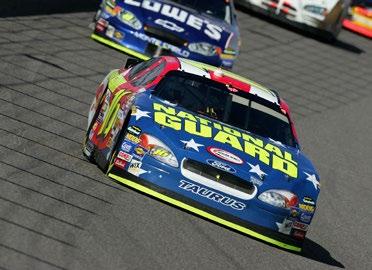
PRESIDENT George W.
Bush
NO. 1 AT THE BOX OFFICE Star Wars Episode III: Revenge of the Sith
NO. 1 SONG
“We Belong Together”
by Mariah Carey
POP CULTURE
On April 23, “Me at the Zoo” became the first video uploaded to YouTube GALLON OF GAS $2.30
109
2005
DATE LOCATION WINNER Feb. 20 Daytona International Speedway Jeff Gordon Feb. 27 Rockingham Speedway Greg Biffle March 13 Las Vegas Motor Speedway Jimmie Johnson March 20 Atlanta Motor Speedway Carl Edwards April 3 Bristol Motor Speedway Kevin Harvick April 10 Martinsville Speedway Jeff Gordon April 17 Texas Motor Speedway Greg Biffle
23 Phoenix Raceway Kurt Busch
1 Talladega Superspeedway Jeff Gordon May 7 Darlington Raceway Greg Biffle May 14 Richmond Raceway Kasey Kahne May 29 Charlotte Motor Speedway Jimmie Johnson
5 Dover Motor Speedway Greg Biffle June 12 Pocono Raceway Carl Edwards
19 Michigan International Speedway Greg Biffle
26 Sonoma Raceway Jeff Gordon July 2 Daytona International Speedway Tony Stewart July 10 Chicagoland Speedway Dale Earnhardt Jr. July 17 New Hampshire Motor Speedway Tony Stewart July 24 Pocono Raceway Kurt Busch
7 Indianapolis Motor Speedway Tony Stewart
14 Watkins Glen International Tony Stewart
21 Michigan International Speedway Jeremy Mayfield
27 Bristol Motor Speedway Matt Kenseth
4 Auto Club Speedway Kyle Busch
10 Richmond Raceway Kurt Busch
18 New Hampshire Motor Speedway Ryan Newman
25 Dover Motor Speedway Jimmie Johnson
2 Talladega Superspeedway Dale Jarrett
9 Kansas Speedway Mark Martin
15 Charlotte Motor Speedway Jimmie Johnson
23 Martinsville Speedway Jeff Gordon
30 Atlanta Motor Speedway Carl Edwards
6 Texas Motor Speedway Carl Edwards
13 Phoenix Raceway Kyle Busch
20 Homestead-Miami Speedway Greg Biffle 05
April
May
June
June
June
Aug.
Aug.
Aug.
Aug.
Sept.
Sept.
Sept.
Sept.
Oct.
Oct.
Oct.
Oct.
Oct.
Nov.
Nov.
Nov.
Johnson’s First Title
BEST DRIVER
JIMMIE JOHNSON, driving the No. 48 Hendrick Motorsports Chevrolet, ranked as the best driver of the 2006 NASCAR Cup Series season by way of consistent finishes during the 36race campaign. Tied with Kevin Harvick and Tony Stewart with five victories each, Johnson’s number of top-10 finishes (24) was slightly better than those of his rivals. Johnson showcased his ability by winning NASCAR’s most prestigious races, while also collecting a victory at Martinsville Speedway.
SEASON RECAP
DATE LOCATION WINNER
Feb. 19 Daytona International Speedway Jimmie Johnson
Feb. 26 Auto Club Speedway Matt Kenseth
March 12 Las Vegas Motor Speedway Jimmie Johnson
March 20 Atlanta Motor Speedway Kasey Kahne
March 26 Bristol Motor Speedway Kurt Busch
April 2 Martinsville Speedway Tony Stewart
April 9 Texas Motor Speedway Kasey Kahne
April 22 Phoenix Raceway Kevin Harvick
May 1 Talladega Superspeedway Jimmie Johnson
May 6 Richmond Raceway Dale Earnhardt Jr.
May 13 Darlington Raceway Greg Biffle
May 28 Charlotte Motor Speedway Kasey Kahne
June 4 Dover International Speedway Matt Kenseth
June 11 Pocono Raceway Denny Hamlin
June 18 Michigan International Speedway Kasey Kahne
June 25 Sonoma Raceway Jeff Gordon
July 1 Daytona International Speedway Tony Stewart
July 9 Chicagoland Speedway Jeff Gordon
July 16 New Hampshire Motor Speedway Kyle Busch
July 23 Pocono Raceway Denny Hamlin
Aug. 6 Indianapolis Motor Speedway Jimmie Johnson
Aug. 13 Watkins Glen International Kevin Harvick

Aug. 20 Michigan International Speedway Matt Kenseth
Aug. 26 Bristol Motor Speedway Matt Kenseth
Sept. 3 Auto Club Speedway Kasey Kahne
Sept. 9 Richmond Raceway Kevin Harvick
Sept. 17 New Hampshire Motor Speedway Kevin Harvick
Sept. 24 Dover International Speedway Jeff Burton
Jimmie Johnson and Matt Kenseth proved they were the top championship contenders during the 2006 NASCAR Cup Series season as they combined to win a quarter of the 36 races.
In his fifth full season with Hendrick Motorsports, Johnson showed he and his Chad Knaus-led team had matured into championship material. The fact he was driving the powerful No. 48 Chevrolet produced a feeling that the young, up-and-coming superstar was set to strike NASCAR Cup Series gold.
Kenseth, driving the No. 17 Roush-Fenway Racing Ford, won the Cup Series championship in 2002 and felt the organization was poised for another title. He and crew chief Robbie Reiser had worked together on the short tracks in their native Wisconsin and the two formed a potent combination.
Through the tutelage of four-time Cup Series champion and Hendrick Motorsports teammate Jeff Gordon, Johnson had become a force and was on the verge of greatness. The native of El Cajon, California, was identified by Gordon years earlier as possessing the talent to became a NASCAR Cup Series champion.
During the 2006 season, Johnson recorded five victories, 13 top-five finishes, 24 top-10s results and earned one pole position to best Kenseth in the final standings by 56 points.
Kenseth ended the year with four victories, 15 top-five finishes and 21 top-10 results. Johnson would go on to collect six additional championships, including five in a row through 2010.
Johnson’s biggest victory of 2006 came in the seasonopening Daytona 500. He also won the Brickyard 400 at Indianapolis Motor Speedway. Additional wins at Las Vegas, Talladega and Martinsville had the No. 48 team atop the Cup Series standings at season’s end.
BEST RACE

HIS BRICKYARD 400 victory at the legendary Indianapolis Motor Speedway gave Jimmie Johnson a pair of crown jewel wins on the season. He charged forward from the 38th starting position to become only the second driver (Dale Jarrett in 1996) to win both the Brickyard 400 and the Daytona 500 in the same season. Matt Kenseth and Kevin Harvick challenged during the closing laps, but they could not match the horsepower under the hood of Johnson’s Chevrolet.
TOP CARS

JIMMIE JOHNSON’S NO. 48 Hendrick Motorsports Chevrolet visited Victory Lane five times during the 2006 NASCAR Cup Series season.

Kasey Kahne was the season’s top winner with six victories in the No. 9 Dodge owned by former crew chief Ray Evernham.
Oct. 1 Kansas Speedway Tony Stewart
Oct. 8 Talladega Superspeedway Brian Vickers
Oct. 14 Charlotte Motor Speedway Kasey Kahne
Oct. 22 Martinsville Speedway Jimmie Johnson
Oct. 29 Atlanta Motor Speedway Tony Stewart
Nov. 5 Texas Motor Speedway Tony Stewart
Nov. 12 Phoenix Raceway Kevin Harvick
Nov. 19 Homestead-Miami Speedway Greg Biffle
PRESIDENT George W. Bush
NO.
NO. 1 SONG
$2.57
110
06
THROUGH THE YEARS
2006
the Carribbean
1 AT THE BOX OFFICE Pirates of
“Bad Day” by Daniel Powter
POP CULTURE Google buys YouTube for $1.65 billion
GALLON OF GAS
Driving the No. 48 Hendrick Motorsports Chevrolet,
Jimmie Johnson posted 10 wins and 24 top-10 finishes on the way to securing his second consecutive NASCAR Cup Series championship and seventh title for team owner Rick Hendrick.
BEST DRIVER
JIMMIE JOHNSON, driver of the No. 48 Hendrick Motorsports Chevrolet, recorded 10 wins, 24 top-10 finishes and four pole positions. Johnson suffered through ebbs and flows during the 2007 schedule but was able to edge teammate Jeff Gordon by 77 points for his second consecutive NASCAR Cup Series championship. Johnson’s ability to communicate with crew chief Chad Knaus made them a force to be reckoned with throughout the 36-race season.
BEST RACE
SEASON RECAP
DATE
Feb. 18
Feb. 25 Auto Club Speedway
March 11
From 2002 until 2006, Johnson and crew chief Chad Knaus amassed 24 victories, finished second in points in 2003 and 2004 and claimed their first championship in 2006. The dynamic duo felt they had the strongest team and could successfully defend their crown.

Johnson began the season by suffering a crash in the season-opening Daytona 500. The El Cajon, California, native finished 39th in the 43-car field and knew he had his work cut out for him to get his title hopes back on track. He rebounded with a victory at Las Vegas Motor Speedway two weeks later and returned to fourth in points.
Johnson remained in the top-five in points through the July 4 event at Daytona International Speedway but fell to seventh at Chicagoland Speedway with a crash and a 37th-place finish.
A second crash at Indianapolis a week later and a 39th-place finish dropped him even further back to ninth. The path toward defending the title wasn’t looking promising.
Then, three top-5 finishes and wins at California and Richmond returned Johnson to the points lead. He was among the top three in points for the remainder of the season.
Consecutive wins at Martinsville, Atlanta, Texas and Phoenix during the Chase iced the championship.
In the final points tally, Johnson bested teammate Jeff Gordon by 77 points.
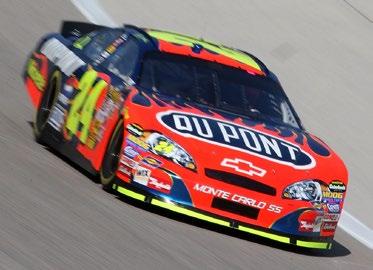
ON JUNE 4, MARTIN Truex Jr., driving the No. 1 Dale Earnhardt Inc. Chevrolet, led 216 of 400 laps at Dover Motor Speedway to claim his first Cup Series victory. Ryan Newman, Carl Edwards and Denny Hamlin chased him under the checkered flag. The race featured 18 lead changes and seven caution periods spanning 35 laps. A second-generation driver from nearby Mayetta, New Jersey, the one-mile Dover oval is Truex’s home track.
TOP CARS
JIMMIE JOHNSON’S NO. 48 Hendrick Motorsports Lowe’s Chevrolet went to Victory Lane 10 times and had 24 top-10 finishes. The No. 24 Hendrick Motorsports DuPont Chevrolet, driven by Jeff Gordon, recorded six wins and 30 top-10 results.
May
June
June
Aug.
Sept.
Sept.
Sept.
Sept.
Sept.
Oct.
Oct.
Oct.
Oct.
Nov.
Nov.
Nov.
PRESIDENT
George W. Bush
NO. 1 AT THE BOX OFFICE Spider-Man 3
NO. 1 SONG
“Irreplaceable” by Beyonce
POP
CULTURE
Shows such as “Dancing with the Stars” and “American Idol” enjoyed unparalleled ratings.
GALLON OF GAS $2.80
Two in a Row for Johnson 2007
111
LOCATION WINNER
Kevin
Daytona International Speedway
Harvick
Matt
Kenseth
Las
Motor Speedway Jimmie Johnson
18 Atlanta Motor Speedway Jimmie Johnson
25 Bristol Motor Speedway Kyle Busch
1 Martinsville Speedway Jimmie Johnson
15 Texas Motor Speedway Jeff Burton
21 Phoenix Raceway Jeff Gordon
29 Talladega Superspeedway Jeff Gordon
6 Richmond Raceway Jimmie Johnson
13 Darlington Raceway Jeff Gordon
Vegas
March
March
April
April
April
April
May
May
27 Charlotte Motor Speedway Casey Mears
4 Dover Motor Speedway Martin Truex Jr.
10 Pocono Raceway Jeff Gordon
June
17 Michigan International Speedway Carl Edwards
24 Sonoma Raceway Juan Pablo Montoya
1 New Hampshire Motor Speedway Denny Hamlin
7 Daytona International Speedway Jamie McMurray
15 Chicagoland Speedway Tony Stewart
29 Indianapolis Motor Speedway Tony Stewart
5 Pocono Raceway Kurt Busch
12 Watkins Glen International Tony Stewart
21 Michigan International Speedway Kurt Busch
June
July
July
July
July
Aug.
Aug.
Aug.
25 Bristol Motor Speedway Carl Edwards
2 Auto Club Speedway Jimmie Johnson
8 Richmond Raceway Jimmie Johnson
16 New Hampshire Motor Speedway Clint Bowyer
23 Dover Motor Speedway Carl Edwards
30 Kansas Speedway Greg Biffle
7 Talladega Superspeedway Jeff Gordon
13 Charlotte Motor Speedway Jeff Gordon
21 Martinsville Speedway Jimmie Johnson
28 Atlanta Motor Speedway Jimmie Johnson
4 Texas Motor Speedway Jimmie Johnson
11 Phoenix Raceway Jimmie Johnson
18 Homestead-Miami Speedway Matt Kenseth 07
Three in a Row for Johnson
Driving the No. 48 Hendrick Motorsports Chevrolet, Jimmie
Johnson won seven races in 2008 on his way to joining Cale Yarborough as the only drivers to claim three consecutive NASCAR Cup Series championships.
BEST DRIVER
CARL EDWARDS, driver of the No. 99 Roush Racing Ford, logged nine wins, 27 top-10 finishes and one pole position in 36 starts. Edwards notched seven superspeedway wins and two short tracks victories during the 2008 NASCAR Cup Series season and enjoyed performing his signature backflip after each. Led by crew chief Bob Osborne, the team was a contender each time the Columbia, Mo. native strapped in. It was the best season of his 13-year career.
BEST RACE
KYLE BUSCH, DRIVING
SEASON RECAP
DATE LOCATION WINNER
Feb. 17 Daytona International Speedway Ryan Newman
Feb. 25 Auto Club Speedway Carl Edwards
March 2 Las Vegas Motor Speedway Carl Edwards
March 9 Atlanta Motor Speedway Kyle Busch
March 16 Bristol Motor Speedway Jeff Burton
March 30 Martinsville Speedway Denny Hamlin
April 6 Texas Motor Speedway Carl Edwards
April 12 Phoenix Raceway Jimmie Johnson
April 27 Talladega Superspeedway Kyle Busch
May 3 Richmond Raceway Clint Bowyer
May 10 Darlington Raceway Kyle Busch
May 25 Charlotte Motor Speedway Kasey Kahne
June 1 Dover Motor Speedway Kyle Busch
June 8 Pocono Raceway Kasey Kahne
June 15 Michigan International Speedway Dale Earnhardt Jr.
June 22 Sonoma Raceway Kyle Busch
June 29 New Hampshire Motor Speedway Kurt Busch
July 5 Daytona International Speedway Kyle Busch
July 12 Chicagoland Speedway Kyle Busch
July 27 Indianapolis Motor Speedway Jimmie Johnson
Aug. 3 Pocono Raceway Carl Edwards
Aug. 10 Watkins Glen International Kyle Busch
Aug. 17 Michigan International Speedway Carl Edwards
Aug. 23 Bristol Motor Speedway Carl Edwards
Aug. 31 Auto Club Speedway Jimmie Johnson
Sept. 7 Richmond Raceway Jimmie Johnson
Sept. 14 New Hampshire Motor Speedway Greg Biffle
Sept. 21 Dover Motor Speedway Greg Biffle
Sept. 28 Kansas Speedway Jimmie Johnson
Oct. 5 Talladega Superspeedway Tony Stewart
Oct. 11 Charlotte Motor Speedway Jeff Burton
Oct. 19 Martinsville Speedway Jimmie Johnson
Johnson and crew chief Chad Knaus were on top of their game and were the team to beat heading into the 36-race NASCAR Cup Series schedule.
Then, reality set in and dealt them some difficult cards.
For a second straight season, Johnson had a slow start at Daytona with a 27th-place finish, even though he was running at the end. He rebounded with a second-place finish at Auto Club Speedway the next week and rose to eighth in points. Another bad showing at Las Vegas and not so desirable outings at Atlanta and Bristol meant things were not going to plan.
A top-5 effort at Texas led to a win at Phoenix. Over the next 11 weeks, Johnson’s average finish was 13.6, numbers that weren’t good enough for a championship. A win in the Brickyard 400 at Indianapolis Motor Speedway, however, put him back in fourth position in the point standings.
The roller-coaster season continued with a third at Pocono, seventh at Watkins Glen, 17th at Michigan and 35th at Bristol before a win came at Auto Club Speedway in his home state of California, followed by another at Richmond. Twin top-5 results led to a win at Kansas. Johnson then added victories at Martinsville and Phoenix down the stretch to secure the title.
Carl Edwards, driver of the No. 99 Roush Racing Ford, won nine times and had 27 top-10 finishes. However, Edwards fell short of Johnson by 69 points in the final points tally.
the No. 18 Joe Gibbs Racing Toyota, led 61 of 160 laps to win the Coke Zero 400 at Daytona International Speedway on July 5. The race ended under a green, white, checker scenario when Joey Logano, Travis Kvapil, Michael Waltrip, Sam Hornish Jr. and several others crashed in Turn 1 on the final lap. Busch was in front of the carnage and won his sixth of eight races that season.
TOP CARS
JIMMIE JOHNSON’S NO. 48 Hendrick Motorsports Lowe’s Chevrolet won seven times and recorded 22 top-10 results in 36 starts.
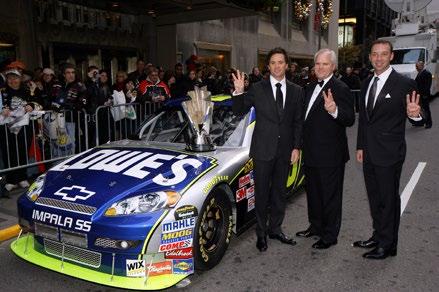
Driving the No. 99 Roush Racing Ford, Carl Edwards notched nine victories and 27 top-10 finishes during the 2008 season.
Oct. 26 Atlanta Motor Speedway Carl Edwards
Nov. 2 Texas Motor Speedway Carl Edwards
Nov. 9 Phoenix Raceway Jimmie Johnson
Nov. 19 Homestead-Miami Speedway Carl Edwards
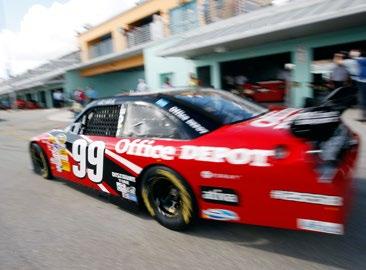
PRESIDENT
George W. Bush
NO. 1 AT THE BOX OFFICE
The Dark Knight
NO. 1 SONG
“Low” by Flo Rida

POP CULTURE
Britney Spears climbed to the top of the charts with “Womanizer”.

GALLON OF GAS
$3.27
2008
112 THROUGH THE YEARS 08
Johnson Finds Rare
Air with No. 4
On the strength of seven victories and 24 top-10 finishes in the No. 48 Hendrick Motorsports Chevrolet, California native Jimmie Johnson made history in 2009 by winning his fourth consecutive NASCAR Cup Series championship.

BEST DRIVER
DRIVING THE NO. 48 Hendrick Motorsports Chevrolet, Jimmie Johnson posted seven wins, 24 top-10 results and four pole positions in 36 starts. Six wins came on superspeedways while the other was on a short track. Johnson had a way of making the art of winning races and championships look commonplace. His style of driving placed him in a league of his own, as he steadily closed on the record of seven titles.
BEST RACE
ON MAY 11, MARK
SEASON RECAP
DATE
Feb.
Johnson and crew chief Chad Knaus had found the magic, putting together four straight NASCAR Cup Series titles.
Cale Yarborough won three championships in a row starting in 1976 and Johnson joined the elite club following his 2008 crown. Now, Johnson’s titles set him on a pedestal of his own as the only driver to win four in row.
Richard Petty and Dale Earnhardt collected seven championships each but none came in more than twoyear intervals.
Surprisingly, Johnson seemed to have a system of starting slow at the beginning of the season and steadily working his way to the points lead. For the third time, a poor finish in the Daytona 500 began his year but a victory in the sixth race at Martinsville moved him to fourth in the standings.
Aside from falling to sixth in points on May 2 at Richmond after a 36th-place effort, Johnson remained among the top 5 in points for the remainder of the season. Victories at Indianapolis, California, Charlotte, Phoenix and twice at Dover helped him to bounce back from a dozen finishes outside the top 10.

Mark Martin, driver of the No. 6 Roush Racing Ford, notched five wins, 21 top-10 results and seven pole positions but could not hold off Johnson’s championship charge. Martin ended up 12th in the season finale at Homestead to Johnson’s fifth-place run and was 141 points back in the final standings.
Martin, wheeling the No. 5 Hendrick Motorsports Chevrolet, led 46 of 367 laps to win the prestigious Southern 500 at Darlington Raceway. Martin and crew chief Alan Gustafson used a perfect tire and fuel strategy to hold off Jimmie Johnson, Ryan Newman and Tony Stewart for his second of five victories that season. It was also the second victory of his 31-year Cup Series career at the 1.336-mile South Carolina track.
TOP CARS
JIMMIE JOHNSON’S NO. 48 Hendrick Motorsports Lowe’s Chevrolet had seven wins, four 24 top10 finishes and four pole positions in 36 starts. The No. 5 Hendrick Motorsports Kellogg’s Chevrolet, with Mark Martin driving, won five times and had 21 top-10 results.
June
July
July
July
Aug.
Aug.
Aug.
Aug.
Sept.
Sept.12
Sept.
Sept.
Oct.
Oct.
Oct.
Oct.
Nov.
Nov.
Nov.
Nov.
113
2009 PRESIDENT Barack Obama NO. 1 AT THE BOX OFFICE Transformers: Revenge of the Fallen NO. 1 SONG “Boom Boom Pow” by The Black Eyed Peas POP CULTURE Music fans mourn the passing of pop icon Michael Jackson. GALLON OF GAS $2.39
LOCATION WINNER
Matt Kenseth Feb. 22 Auto Club Speedway Matt Kenseth March 1 Las Vegas Motor Speedway Kyle Busch March 8 Atlanta Motor Speedway Kurt Busch March 22 Bristol Motor Speedway Kyle Busch March 29 Martinsville Speedway Jimmie Johnson April 5 Texas Motor Speedway Jeff Gordon April 18 Phoenix Raceway Mark Martin April 26 Talladega Superspeedway Brad Keselowski May 2 Richmond Raceway Kyle Busch May 9 Darlington Raceway Mark Martin May 25 Charlotte Motor Speedway David Reutimann May 31 Dover Motor Speedway Jimmie Johnson June 7 Pocono Raceway Tony Stewart June 14 Michigan International Speedway Mark Martin June 21 Sonoma Raceway Kasey Kahne
15 Daytona International Speedway
28 New Hampshire Motor Speedway Joey Logano
4 Daytona International Speedway Tony Stewart
11 Chicagoland Speedway Mark Martin
26 Indianapolis Motor Speedway Jimmie Johnson
3 Pocono Raceway Denny Hamlin
10 Watkins Glen International Tony Stewart
16 Michigan International Speedway Brian Vickers
22 Bristol Motor Speedway Kyle Busch
6 Atlanta Motor Speedway Kasey Kahne
Richmond Raceway Denny Hamlin
20 New Hampshire Motor Speedway Mark Martin
27 Dover Motor Speedway Jimmie Johnson
4 Kansas Speedway Tony Stewart
11 Auto Club Speedway Jimmie Johnson
17 Charlotte Motor Speedway Jimmie Johnson
25 Martinsville Speedway Denny Hamlin
1 Talladega Superspeedway Jamie McMurray
8 Texas Motor Speedway Kurt Busch
15 Phoenix Raceway Jimmie Johnson
22 Homestead-Miami Speedway Denny Hamlin 09
Make It 5 Straight for Jimmie
Jimmie Johnson, of El Cajon, California, added six more victories and 23 top-10 finishes to his résumé en route to a fifth consecutive NASCAR Cup Series title and the 10th for team owner Rick Hendrick.
Johnson and crew chief Chad Knaus were simply amazing in 2010, as they were virtually unstoppable, no matter what was thrown at them. They were on top of their game and were the top combination, no matter where they raced on the 36-race Cup Series schedule.
For a fifth straight season, Johnson was the driver to beat, as was the No. 48 Cup Series team that is based only a half mile from Charlotte Motor Speedway.
Team owner Rick Hendrick and four-time Cup Series champion Jeff Gordon have an eye for spotting very talented drivers and when they identified Johnson in the Xfinity Series in 1998, they knew they had a winner.
When the 2010 season began, all eyes were on Johnson to see if he could pull off another title. Again, the Daytona curse continued with a 35th-place finish due to a broken rear axle. Wins at California and Las Vegas over the next two weeks and a triumph at Bristol in mid-March put him third in points. Johnson fell as far back as ninth following the August event at Bristol but as he had done before, Johnson made up lost ground by celebrating three more victories.
Johnson regained the points lead in the final race of the year at HomesteadMiami. The winning margin was 39 points over Denny Hamlin, driver of the No. 11 Joe Gibbs Racing Toyota.

SEASON RECAP
DATE LOCATION WINNER
Feb. 14 Daytona International Speedway Jamie McMurray
Feb. 21 Auto Club Speedway Jimmie Johnson
Feb. 28 Las Vegas Speedway Jimmie Johnson
March 7 Atlanta Motor Speedway Kurt Busch
March 21 Bristol Motor Speedway Jimmie Johnson
March 29 Martinsville Speedway Denny Hamlin
April 10 Phoenix Raceway Ryan Newman
April 19 Texas Motor Speedway Denny Hamlin
April 25 Talladega Superspeedway Kevin Harvick
May 1 Richmond Raceway Kyle Busch
May 8 Darlington Raceway Denny Hamlin
May 16 Dover Motor Speedway Kyle Busch
May 30 Charlotte Motor Speedway Kurt Busch
June 6 Pocono Raceway Denny Hamlin
June 13 Michigan International Speedway Denny Hamlin
June 20 Sonoma Raceway Jimmie Johnson
June 27 New Hampshire Motor Speedway Jimmie Johnson
July 3 Daytona International Speedway Kevin Harvick
July 10 Chicagoland Speedway David Reutimann
July 25 Indianapolis Motor Speedway Jamie McMurray
Aug. 1 Pocono Raceway Greg Biffle
Aug. 8 Watkins Glen International Juan Pablo Montoya
Aug.15 Michigan International Speedway Kevin Harvick
Aug. 21 Bristol Motor Speedway Kyle Busch
Sept. 5 Atlanta Motor Speedway Tony Stewart
Sept. 11 Richmond Raceway Denny Hamlin
Sept. 19 New Hampshire Motor Speedway Clint Bowyer
Sept. 26 Dover Motor Speedway Jimmie Johnson
Oct. 3 Kansas Speedway Greg Biffle
Oct. 10 Auto Club Speedway Tony Stewart
Oct. 16 Charlotte Motor Speedway Jamie McMurray
Oct. 24 Martinsville Speedway Denny Hamlin
Oct. 31 Talladega Superspeedway Clint Bowyer
Nov. 7 Texas Motor Speedway Denny Hamlin
Nov. 14 Phoenix Raceway Carl Edwards
Nov 21 Homestead-Miami Speedway Carl Edwards
BEST DRIVER
JIMMIE JOHNSON, DRIVER OF THE NO. 48 Hendrick Motorsports Chevrolet, logged six wins, 23 top-10 results and two pole positions in 36 starts. Johnson’s stat line included six superspeedway wins and one short-track victory, paving the way for his fifth consecutive Cup Series title. No other driver in NASCAR history has ever been able to accomplish such a feat. The only driver to get close was Cale Yarborough with three straight championships starting in 1976.

BEST RACE

DRIVING THE NO. 1 GANASSI Racing Chevrolet, Jamie McMurray held off Dale Earnhardt Jr. as well as a multitude of cars on the final lap of the Daytona 500 to win NASCAR’s biggest and most prestigious event. McMurray only led the final five miles of the 200lap event but was in the right place at the right time to pull off the upset victory. He also won at Indianapolis and Charlotte.
TOP CARS

THE NO. 48 HENDRICK MOTORSPORTS
Lowe’s Chevrolet went to Victory Lane six times and had 23 top-10 results in 36 races.
Denny Hamlin, driver of the No. 11 Joe Gibbs Racing Toyota, recorded eight wins and 18 top-10 finishes during the 2010 season.
114 THROUGH THE YEARS 2010
PRESIDENT: BARACK OBAMA NO. 1 AT THE BOX OFFICE: AVATAR NO. 1 SONG: “TIK TOK” BY KESHA GALLON OF GAS: $2.79 POP CULTURE: INSTAGRAM DEBUTED IN OCTOBER AND THE SOCIAL MEDIA APP BECAME AN INSTANT HIT.
Stewart Pulls Off a Miracle
Driving the No. 14 Chevrolet for Stewart-Haas Racing, Stewart earned his third NASCAR Cup Series title in 2011, becoming the first driver-owner to secure the championship since Alan Kulwicki in 1992. The stellar performance came in Stewart’s third year as a NASCAR team owner alongside business partner Gene Haas.
Steadily, Stewart continued to build his team by hiring many of the people who helped him find success in NASCAR circles after moving to stock car racing from the world of open-wheel Indy car racing.
Stewart entered NASCAR Cup Series competition with Joe Gibbs Racing in 1999, winning three races that season. While with JGR, he captured Cup Series championships in 2002 and 2005 before deciding to form Stewart-Haas Racing in 2009. In 2011, the Hoosier racer won five of the 10 playoff races, including the final event at Homestead-Miami Speedway. Ending the season tied in points with Edwards, driver of the No. 99 Roush Fenway Racing Ford, the title went to Stewart by virtue of logging more victories during the season.
Edwards enjoyed a consistent campaign that included a victory at Las Vegas Motor Speedway. Edwards ended up with 26 top-10 finishes and four poles during the 36-race season. Seven finishes of 20th or worse hampered the Columbia, Missouri, native, but he was still able to challenge Stewart week to week down the stretch.
Their 2011 battle is still the only championship in NASCAR’s storied history to be decided by a tiebreaker. .

SEASON RECAP
DATE
LOCATION
WINNER
Feb. 20 Daytona International Speedway Trevor Bayne
Feb. 27 Phoenix Raceway Jeff Gordon
March 6 Las Vegas Motor Speedway Carl Edwards
March 20 Bristol Motor Speedway Kyle Busch
March 27 Auto Club Speedway Kevin Harvick
April 3 Martinsville Speedway Kevin Harvick
April 9 Texas Motor Speedway Matt Kenseth
April 17 Talladega Superspeedway Jimmie Johnson
April 30 Richmond Raceway Kyle Busch
May 7 Darlington Raceway Regan Smith
May 15 Dover International Speedway Matt Kenseth
May 29 Charlotte Motor Speedway Kevin Harvick
June 5 Kansas Speedway Brad Keselowski
June 12 Pocono Raceway Jeff Gordon
June 19 Michigan International Speedway Denny Hamlin
June 26 Sonoma Raceway Kurt Busch
July 2 Daytona International Speedway David Ragan
July 9 Kentucky Speedway Kyle Busch

July 17 New Hampshire Motor Speedway Ryan Newman
July 31 Indianapolis Motor Speedway Paul Menard
Aug. 7 Pocono Raceway Brad Keselowski
Aug. 15 Watkins Glen International Marcos Ambrose
Aug. 21 Michigan International Speedway Kyle Busch
Aug. 27 Bristol Motor Speedway Brad Keselowski
Sept. 6 Atlanta Motor Speedway Jeff Gordon
Sept. 10 Richmond Raceway Kevin Harvick
Sept. 19 Chicagoland Speedway Tony Stewart
Sept. 25 New Hampshire Motor Speedway Tony Stewart
Oct. 2 Dover International Speedway Kurt Busch
Oct. 9 Kansas Speedway Jimmie Johnson
Oct. 15 Charlotte Motor Speedway Matt Kenseth
Oct. 23 Talladega Superspeedway Clint Bowyer
Oct. 30 Martinsville Speedway Tony Stewart
Nov. 6 Texas Motor Speedway Tony Stewart
Nov. 13 Phoenix Raceway Kasey Kahne
Nov. 20 Homestead-Miami Speedway Tony Stewart
BEST DRIVER
DRIVING THE NO. 14 STEWART-HAAS
Racing Chevrolet, Tony Stewart logged five victories during the final 10 races and secured his third NASCAR Cup Series championship as the resident of Columbus, Indiana, proved he could still get the job done when needed. In miraculous fashion, Stewart overcame all obstacles to secure the title by dominating the NASCAR playoffs. With near perfect cars and engines at his disposal, Stewart clicked off victories when they mattered most.
BEST RACE
NASCAR FANS ENJOYED A Cinderella-style victory when Trevor Bayne, driving the No. 21 Wood Brothers Racing Ford, held off Carl Edwards, David Gilliland and Bobby Labonte to win the season-opening Daytona 500. NASCAR’s longest-tenured team celebrated its 98th victory after the 20-year-old rookie led the final six laps of the 200-lap race. The Knoxville, Tennessee, native held off a trio of strong cars behind him in only his second NASCAR Cup Series start.
TOP CARS
TONY STEWART’S NO. 14 STEWART-HAAS
Racing Chevrolet recorded five NASCAR Cup Series victories and claimed the 2011 series championship.
Carl Edwards’ No. 99
Roush Fenway Racing Ford scored a single victory during the 2011 NASCAR Cup Series season.
115 11
PRESIDENT: BARACK OBAMA NO. 1 SONG: “ROLLING IN THE DEEP” BY ADELE NO. 1 AT THE BOX OFFICE: HARRY POTTER & THE DEATHLY HALLOWS PART 2 GALLON OF GAS: $3.52 POP CULTURE: BRITAIN’S PRINCE WILLIAM MARRIED KATE MIDDLETON
2011
Tony Stewart and Carl Edwards proved to be the top championship contenders of the 2011 NASCAR Cup Series season as they combined to win six of the 36 races.
Keselowski Wears the Crown
Driving
A second-generation racer, Keselowski began driving on the short tracks near his hometown of Rochester Hills, Michigan. He then followed his father, Bob, into the NASCAR Craftsman Truck Series in 2004.
Keselowski made his Xfinity Series debut in 2006 and his first Cup Series start came two years later. Following stints with JR Motorsports and Hendrick Motorsports, he joined Team Penske for the 2010 season.
The combination of team owner Penske, crew chief Paul Wolfe and Keselowski produced three wins during the 2011 season.
The 2012 campaign got off to a rocky start, however, as Keselowski fought through a difficult stretch of double-digit finishes before getting his championship quest on track.A March 18 win at Bristol helped heal the wounds generated by 32nd-place finishes at Daytona and Las Vegas, but a 36th-place effort at Texas left him deep in the standings.
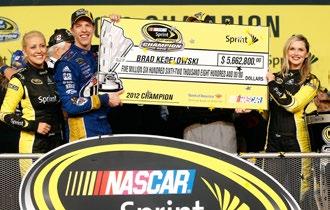
Morale was fading and Keselowski had to rally his No. 2 team back to winning form. A win on May 6 at Talladega Superspeedway and top-10 finishes over the next six weeks kept Keselowski in the top 10. A June 30 victory at Kentucky and eight more top-10 results through the Sept. 8 race at Richmond elevated him to second in the title chase.
With his win at Chicago the next week, Keselowski moved into the points lead. A final win at Dover two weeks later and five top-10 efforts during the final seven races placed Keselowski 39 points ahead of Clint Bowyer in the final standings.
SEASON RECAP
DATE LOCATION WINNER
Feb. 27 Daytona International Speedway Matt Kenseth
March4 Phoenix Raceway Denny Hamlin
March 11 Las Vegas Motor Speedway Tony Stewart
March 18 Bristol Motor Speedway Brad Keselowski
March 25 Auto Club Speedway Tony Stewart
April 1
Martinsville Speedway Ryan Newman
April 14 Texas Motor Speedway Greg Biffle
April 22 Kansas Speedway Denny Hamlin
April 28 Richmond Raceway Kyle Busch
May 6 Talladega Superspeedway Brad Keselowski
May 12 Darlington Raceway Jimmie Johnson
May 27 Charlotte Motor Speedway Kasey Kahne
June 3 Dover Motor Speedway Jimmie Johnson
June 10 Pocono Raceway Joey Logano
June 17 Michigan International Speedway Dale Earnhardt, Jr.
June 24 Sonoma Raceway Clint Bowyer
June 30 Kentucky Motor Speedway Brad Keselowski
July 7 Daytona International Speedway Tony Stewart
July 15 New Hampshire Motor Speedway Kasey Kahne
July 29 Indianapolis Motor Speedway Jimmie Johnson
Aug. 5 Pocono Raceway Jeff Gordon
Aug. 12 Watkins Glen International Marcos Ambrose
Aug. 19 Michigan International Speedway Greg Biffle
Aug. 25 Bristol Motor Speedway Denny Hamlin
Sept. 2 Atlanta Motor Speedway Denny Hamlin
Sept. 8 Richmond Raceway Clint Bowyer
Sept. 16 Chicagoland Speedway Brad Keselowski
Sept. 23 New Hampshire Motor Speedway Denny Hamlin
Sept. 30 Dover Motor Speedway Brad Keselowski
Oct. 7 Talladega Superspeedway Matt Kenseth
Oct. 13 Charlotte Motor Speedway Clint Bowyer
Oct. 21 Kansas Speedway Matt Kenseth
Oct. 28 Martinsville Speedway Jimmie Johnson
Nov. 4 Texas Motor Speedway Jimmie Johnson
Nov. 11 Phoenix Raceway Kevin Harvick
Nov. 18 Homestead-Miami Speedway Jeff Gordon
BEST DRIVER
CALIFORNIA NATIVE JIMMIE JOHNSON, driving the No. 48 Hendrick Motorsports Chevrolet, recorded five wins, 24 top-10 finishes and two pole positions in 36 starts during the 2012 season. Johnson’s statistics were very similar to those accumulated by champion Brad Keselowski, but six DNFs derailed Johnson’s hopes for a sixth title. He ended up third, one point behind runnerup Clint Bowyer. Keselowski, Johnson and Denny Hamlin each went to Victory Lane five times.
BEST RACE

ON AUG. 12, AUSTRALIAN MARCOS Ambrose, driver of the No. 9 Richard Petty Motorsports Ford, led only eight laps on his way to victory at Watkins Glen International, holding off Brad Keselowski to win by .571 seconds.
Kyle Busch had the lead at the white flag but was running out of gas. He spun after being tapped by Keselowski, and Ambrose then passed Keselowski after he had a problem with two corners remaining.
TOP CARS

BRAD KESELOWSKI’S NO. 2 TEAM PENSKE MILLER Dodge won five times while posting 23 top-10 results in 36 starts.
Clint Bowyer’s No. 15 Michael Waltrip Racing 5-Hour Energy Toyota notched three victories with 23 top-10 finishes.

116 THROUGH THE YEARS 12 2012
the No. 2 Team Penske Dodge, Brad Keselowski recorded five wins and 23 top-10 finishes in 36 races to secure the first NASCAR Cup Series title for himself and iconic team owner Roger Penske.
PRESIDENT: BARACK OBAMA NO. 1 AT THE BOX OFFICE: THE AVENGERS GALLON OF GAS: $3.60 NO. 1 SONG: “SOMEBODY THAT I USED TO KNOW” BY GOTYE FEATURING KIMBRA POP CULTURE: “THE WALKING DEAD” BECOMES THE MOST-WATCHED DRAMA-SERIES IN BASIC CABLE HISTORY.
Johnson Returns to Form
After two seasons that ended with points finishes of sixth (2011) and third (2012), Johnson and crew chief Chad Knaus were able to put together another championship run in NASCAR’s premier series.
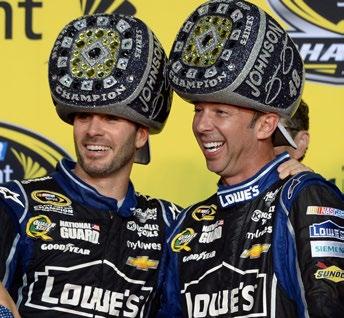
Opening the season on a high note, Johnson beat his Daytona 500 jinx and held off a last-lap charge from Dale Earnhardt Jr. and Mark Martin to win his second Daytona 500. It was the first time he had finished better than 27th in The Great American Race since winning the prestigious race for the first time in 2006.
Five races later, Johnson led 346 of 500 laps at Martinsville en route to winning his eighth race at the Virginia short track, and he assumed the points lead, which he held for the remainder of the regular season.
Johnson’s consistency was such that there were periods during the summer where he was more than two-race wins worth of points ahead of Carl Edwards or Clint Bowyer.
Three top-5 finishes over a span of seven races led to a win at Pocono, which increased Jonson’s points lead to 51 over Edwards. This also snapped a nineyear winless streak for Johnson at Pocono. A fourth win of the year came at Daytona on July 6.
Victories at Dover and Texas sealed Johnson’s championship hopes by 19 points over Matt Kenseth, driver of the No. 20 Joe Gibbs Racing Toyota.
2013
BEST DRIVER
MATT KENSETH, DRIVER OF THE NO. 20 Joe Gibbs Racing Toyota, collected seven wins and 20 top-10 finishes in 36 starts. Victories at Las Vegas, Kansas, Darlington, Kentucky, Bristol, Chicago and New Hampshire rewarded the Cambridge, Wisconsin, native with an awesome season. However, three DNFs served as the foundation for him ending up second in the championship. Kenseth’s average finish of 12.7 kept him in the hunt, but he simply couldn’t overcome Johnson’s lead.
SEASON RECAP
DATE LOCATION WINNER
Feb. 24 Daytona International Speedway Jimmie Johnson
March 3 Phoenix Raceway Carl Edwards
March 10 Las Vegas Motor Speedway Matt Kenseth
March 17 Bristol Motor Speedway Kasey Kahne
March 24 Auto Club Speedway Kyle Busch
April 7 Martinsville Speedway Jimmie Johnson
April 13 Texas Motor Speedway Kyle Busch
April 21 Kansas Speedway Matt Kenseth
April 27 Richmond Raceway Kevin Harvick
May 5 Talladega Superspeedway David Ragan
May 11 Darlington Raceway Matt Kenseth
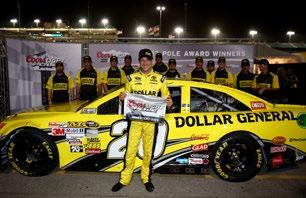
May 26 Charlotte Motor Speedway Kevin Harvick
June 2 Dover Motor Speedway Tony Stewart
June 9 Pocono Raceway Jimmie Johnson
June 16 Michigan International Speedway Greg Biffle
June 23 Sonoma Raceway Martin Truex Jr.
June 30 Kentucky Speedway Matt Kenseth
July 6 Daytona International Speedway Jimmie Johnson
July 14 New Hampshire Motor Speedway Brian Vickers
July 28 Indianapolis Motor Speedway Ryan Newman
Aug. 4 Pocono Raceway Kasey Kahne
Aug. 11 Watkins Glen International Kyle Busch
Aug. 18 Michigan International Speedway Joey Logano
Aug. 24 Bristol Motor Speedway Matt Kenseth
Sept. 1 Atlanta Motor Speedway Kyle Busch
Sept. 7 Richmond Raceway Carl Edwards
Sept. 15 Chicagoland Speedway Matt Kenseth
Sept. 22 New Hampshire Motor Speedway Matt Kenseth
Sept. 29 Dover Motor Speedway Jimmie Johnson
Oct. 6 Kansas Speedway Kevin Harvick
Oct. 12 Charlotte Motor Speedway Brad Keselowski
Oct. 20 Talladega Superspeedway Jamie McMurray
Oct. 27 Martinsville Speedway Jeff Gordon
Nov. 3 Texas Motor Speedway Jimmie Johnson
Nov. 10 Phoenix Raceway Kevin Harvick
Nov. 17 Homestead-Miami Speedway Denny Hamlin
PRESIDENT: BARACK OBAMA NO. 1 AT THE BOX OFFICE: IRON MAN 3 GALLON OF GAS: $3.49 NO. 1 SONG: “THRIFT SHOP” BY MACKLEMORE & RYAN LEWIS FEATURING WANZ
HISTORY: ON APRIL 15, TWO PRESSURE COOKER BOMBS EXPLODED NEAR THE FINISH LINE DURING THE BOSTON MARATHON. THREE PEOPLE WERE KILLED AND ANOTHER 264 WERE INJURED.
BEST RACE
ON MAY 5, DAVID RAGAN, DRIVING the No. 34 Front Row Motorsports Ford, led four of 192 laps en route to victory in the Aaron’s 499 at Talladega Superspeedway. Ragan led at various times, placing himself within the top 10 throughout the 3 hour and 26 minute battle. The Unadilla, Georgia, native made it through a 12-car crash with two laps remaining and held off teammate David Gilliland at the finish by .212 seconds.
TOP CARS
JIMMIE JOHNSON’S NO. 48 HENDRICK Motorsports Lowe’s Chevrolet earned six wins, 24 top-10 finishes and three pole positions in 36 starts.
The No. 20 Joe Gibbs Racing
DeWalt Tools
Toyota driven by Matt Kenseth won seven times with 20 top-10 results.
117 13
Driving the familiar No. 48 Chevrolet fielded by Hendrick Motorsports, California native Jimmie Johnson won six times and posted 24 top-10 finishes on the way to his sixth NASCAR Cup Series title in 2013.
Harvick’s Wish Comes True
Kevin Harvick, driving the No. 4 Stewart-Haas Racing Chevrolet, collected five wins, 20 top-10 finishes and eight pole positions to secure his first NASCAR Cup Series championship in his 14th season.
A star in the NASCAR Xfinity Series for Richard Childress Racing, Harvick was promoted to the NASCAR Cup Series in 2001 to fill the void created by the death of seven-time champion Dale Earnhardt during the final lap of the Daytona 500.

Harvick departed RCR at the end of the 2013 schedule with 22 victories and his best points finishes being third-place efforts in 2010, 2011 and 2013.
Harvick joined Stewart-Haas Racing and team owners Tony Stewart and Gene Hass in 2014 with hopes of finally claiming a Cup Series championship. By season’s end, his wish had come true.
Harvick and new crew chief Rodney Childers could easily relate to one another and had great chemistry that showed on the race track.
Early season wins at Phoenix and Darlington foreshadowed the season to come as Harvick became a regular among the top 5 in the points.
The native of Bakersfield, California, ended a 23-race drought at Charlotte when he finally won there during the playoffs. He followed that with a secondplace run at Texas Motor Speedway and a victory at Phoenix Raceway to earn a spot among NASCAR’s new winner-take-all, Championship 4 format at the final race in Homestead, Florida.
Harvick won the race at Homestead-Miami Speedway, giving him the title over Ryan Newman, driver of the No. 31 Chevrolet, by a single point. It was the second closest point margin in Cup Series history. In 2011, Stewart and Carl Edwards tied in points with Stewart being crowned champion by virtue of having more wins.
SEASON RECAP
DATE LOCATION WINNER
Feb. 23 Daytona International Speedway Dale Earnhardt Jr.
March 2 Phoenix Raceway Kevin Harvick
March 9 Las Vegas Motor Speedway Brad Keselowski
March 16 Bristol Motor Speedway Carl Edwards
March 23 Auto Club Speedway Kyle Busch
March 30 Martinsville Speedway Kurt Busch
April 7 Texas Motor Speedway Joey Logano
April 12 Darlington Raceway Kevin Harvick
April 26 Richmond Raceway Joey Logano
May 4 Talladega Superspeedway Denny Hamlin
May 10 Kansas Speedway Jeff Gordon
May 25 Charlotte Motor Speedway Jimmie Johnson
June 1 Dover Motor Speedway Jimmie Johnson
June 8 Pocono Raceway Dale Earnhardt Jr.
June 15 Michigan International Speedway Jimmie Johnson
June 22 Sonoma Raceway Carl Edwards
June 28 Kentucky Speedway Brad Keselowski
July 6 Daytona International Speedway Aric Almirola
July 13 New Hampshire Motor Speedway Brad Keselowski
July 27 Indianapolis Motor Speedway Jeff Gordon
Aug. 3 Pocono Raceway Dale Earnhardt Jr.
Aug. 10 Watkins Glen International A.J. Allmendinger
Aug. 17 Michigan International Speedway Jeff Gordon
Aug. 23 Bristol Motor Speedway Joey Logano
Aug. 31 Atlanta Motor Speedway Kasey Kahne
Sept. 6 Richmond Raceway Brad Keselowski
Sept. 14 Chicagoland Speedway Brad Keselowski
Sept. 21 New Hampshire Motor Speedway Joey Logano
Sept. 28 Dover Motor Speedway Jeff Gordon
Oct. 5 Kansas Speedway Joey Logano
Oct. 11 Charlotte Motor Speedway Kevin Harvick
Oct. 19 Talladega Superspeedway Brad Keselowski
Oct. 26 Martinsville Speedway Dale Earnhardt Jr.
Nov. 2 Texas Motor Speedway Jimmie Johnson
Nov. 9 Phoenix Raceway Kevin Harvick
Nov. 16 Homestead-Miami Speedway Kevin Harvick
PRESIDENT: BARACK OBAMA NO. 1 AT THE BOX OFFICE: GUARDIANS OF THE GALAXY NO. 1 SONG: “HAPPY” BY PHARRELL WILLIAMS GALLON OF GAS: $3.62
POP CULTURE: AFTER MORE THAN 2,500 EPISODES, DAVID LETTERMAN ANNOUNCED HE WOULD RETIRE AS HOST OF “THE LATE SHOW” ON MAY 20, 2015.
BEST DRIVER
BRAD KESELOWSKI, DRIVING THE NO. 2 Team Penske Dodge, won six races and notched 20 top-10 results in 36 races. The Rochester Hills, Michigan, racer headed all other drivers in the win column with five victories – superspeedway wins at Las Vegas, Kentucky, New Hampshire, Chicago and Talladega and one shorttrack triumph at Richmond Raceway. His hopes of a second title were derailed, however, when he failed to earn a spot in the Championship 4.
BEST RACE

THE INTENSITY AMONG THE Championship 4 drivers – Kevin Harvick, Ryan Newman, Denny Hamlin and Joey Logano – during the season finale on Nov. 16 at Homestead-Miami Speedway was off the charts. When the dust settled, Harvick had won both the battle and the war, as Newman was unable to mount a late-race challenge and came up one position short of the title. Harvick started fifth and led 54 of the 267 laps.
TOP CARS

KEVIN HARVICK’S NO. 4 STEWART-HAAS RACING Chevrolet visited Victory Lane five times and had 20 top-10 finishes in 36 starts.
Ryan Newman’s No. 31 Richard Childress Racing Chevrolet went winless during the season but notched 16 top10 results.
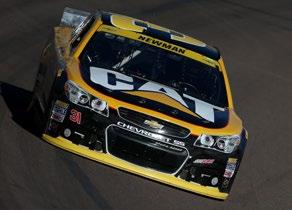
118 THROUGH THE YEARS 14
2014
Kyle Busch Breaks Through
The younger of the racing Busch brothers grew up in Las Vegas where he won more than 65 Legend Car races and two track titles before graduating to Late Model competition. At the age of 16, Busch began competing in the NASCAR Craftsman Truck Series, driving for Roush Racing.
He made his Cup Series debut in 2004 with team owner Rick Hendrick and Hendrick Motorsports. At the time, Busch was tabbed by many industry insiders as NASCAR’s next superstar. However, of his six starts that year, all were superspeedway events and all produced finishes outside the top 25.
The next season, Busch won both Cup Series races at Auto Club Speedway. All told through 2007, he claimed four wins with the Hendrick organization
Busch joined Joe Gibbs Racing in 2008 and began a long tenure of success, winning 25 Cup Series races leading up to the 2015 season.
After being sidelined for the first 11 races of 2015, Busch rebounded to score four victories in the regular season.
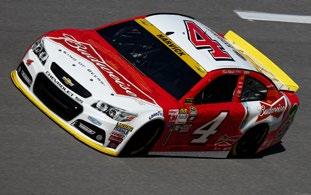
During the final race of the Chase at Homestead-Miami Speedway, Denny Hamlin started on the pole, while Busch lined up third, Jeff Gordon fifth, Martin Truex Jr. 11th, and Kevin Harvick 13th.
Busch led the other championship contenders as Brad Keselowski dominated the lap count. A debris caution late in the race shuffled the running order, giving Busch the lead. Busch held off Harvick to win both the race and the championship.
SEASON RECAP
DATE LOCATION WINNER
Feb. 22 Daytona International Speedway Joey Logano
March 1 Atlanta Motor Speedway Jimmie Johnson
March 8 Las Vegas Motor Speedway Kevin Harvick
March 15 Phoenix Raceway Kevin Harvick
March 22 Auto Club Speedway Brad Keselowski
March 29 Martinsville Speedway Denny Hamlin
April 11 Texas Motor Speedway Jimmie Johnson
April 19 Bristol Motor Speedway Matt Kenseth
April 26 Richmond Raceway Kurt Busch
May 3 Talladega Superspeedway Dale Earnhardt Jr.
May 9 Kansas Speedway Jimmie Johnson
May 24 Charlotte Motor Speedway Carl Edwards
May 31 Dover Motor Speedway Jimmie Johnson
June 7 Pocono Raceway Martin Truex Jr.
June 14 Michigan International Speedway Kurt Busch
June 28 Sonoma Raceway Kyle Busch
July 5 Daytona International Speedway Dale Earnhardt Jr.
July 11 Kentucky Speedway Kyle Busch
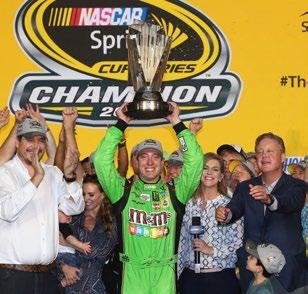
July 19 New Hampshire Motor Speedway Kyle Busch
July 26 Indianapolis Motor Speedway Kyle Busch
Aug. 2 Pocono Raceway Matt Kenseth
Aug. 9 Watkins Glen International Joey Logano
Aug. 16 Michigan International Speedway Matt Kenseth
Aug. 22 Bristol Motor Speedway Joey Logano
Sept. 6 Darlington Raceway Carl Edwards
Sept. 12 Richmond Raceway Matt Kenseth
Sept. 20 Chicagoland Speedway Denny Hamlin
Sept. 27 New Hampshire Motor Speedway Matt Kenseth
Oct. 4 Dover Motor Speedway Kevin Harvick
Oct. 11 Charlotte Motor Speedway Joey Logano
Oct. 18 Kansas Speedway Joey Logano
Oct. 25 Talladega Superspeedway Joey Logano
Nov. 1 Martinsville Speedway Jeff Gordon
Nov. 8 Texas Motor Speedway Jimmie Johnson
Nov. 15 Phoenix Raceway Dale Earnhardt Jr.
Nov. 22 Homestead-Miami Speedway Kyle Busch
POP
BEST DRIVER
JOEY LOGANO, DRIVER OF THE NO. 22 Team Penske Ford, won six races and had 28 top-10 finishes. Logano’s triumph in the Daytona 500 started the year, and he followed it with victories at Watkins Glen, Bristol, Charlotte, Kansas and Talladega during the second half of the schedule. His average start of 6.9 and average finish of 9.2 set the stage for a respectable season, but four finishes outside the top 35 derailed his title hopes.
BEST RACE
THE SOUTHERN 500 AT legendary Darlington Raceway featured a record 18 caution flags along with several outstanding arguments over racing real estate. Carl Edwards came back from two laps down to battle Brad Keselowski and Kevin Harvick for the lead. After a late caution, Edwards got the lead on pit road and went on to win his second race of the season. It was Edwards’ only victory at the 1.336-mile track.
TOP CARS
KYLE BUSCH, DRIVING THE NO. 18 JOE Gibbs Racing Toyota, won five times and had 16 top-10 finishes in 25 starts.
Kevin Harvick’s No. 4 StewartHaas Racing Chevrolet recorded 28 top-10 finishes, including three Cup Series wins in 36 races.
119 15
PRESIDENT: BARACK OBAMA NO. 1 AT THE BOX OFFICE: JURASSIC WORLD GALLON OF GAS: $2.30 NO. 1 SONG: “UPTOWN FUNK” BY MARK RONSON FEATURING BRUNO MARS
CULTURE: AMC’S HIT TV SERIES “MAD MEN,” A PERIOD DRAMA BASED ON THE ADVERTISING INDUSTRY OF THE 1960S, AIRED ITS 92ND AND FINAL EPISODE ON MAY 17.
2015
Despite missing 11 races due to leg injuries suffered in the season-opening NASCAR Xfinity Series race, Kyle Buch advanced through the Cup Series playoffs and claimed his first premier series title by winning the season finale.
Johnson Ties Petty & Earnhardt
Jimmie Johnson, driver of the No. 48 Hendrick Motorsports Chevrolet, accumulated five wins and 16 top-10 finishes en route to joining Richard Petty and Dale Earnhardt as the only drivers with seven NASCAR Cup Series championships.
When the 2016 Cup Series season began, no one had any idea a major historical achievement would be accomplished come November. For decades, no one expected another driver would equal the seven championships Petty earned from 1964 through 1979 with Petty Enterprises. But then Dale Earnhardt tied that mark between 1980 and 1994 with team owner Richard Childress and Richard Childress Racing.
Johnson’s previous Cup Series crowns with team owner Rick Hendrick and Hendrick Motorsports came during a record-setting run of five straight starting in 2006 and again in 2013 to reach six championships.
There was one more to come, however, producing great excitement among Johnson’s loyal fans that the seemingly impossible could be reached.
Introduced in 2004 as The Chase, NASCAR’s method for determining its Cup Series champion underwent multiple format revisions through the years. Six times, Johnson answered the challenge and emerged as the best of the best.
In 2016, Johnson had his usual mediocre result in the season-opening Daytona 500, followed by wins at Atlanta in February, Auto Club Speedway in March, Charlotte in May, Martinsville in October and Homestead during the season finale in November, giving him his seventh championship since 2006.
Joey Logano’s wins at Michigan, Talladega and Phoenix helped his championship cause, but he finished fourth in the Homestead race and settled for second in the title fight.
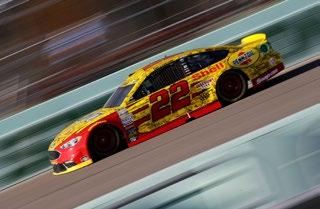
SEASON RECAP
DATE LOCATION WINNER
Feb. 21 Daytona International Speedway Denny Hamlin
Feb. 28 Atlanta Motor Speedway Jimmie Johnson
March 6 Las Vegas Motor Speedway Brad Keselowski
March 13 Phoenix Raceway Kevin Harvick
March 20 Auto Club Speedway Jimmie Johnson
April 3 Martinsville Speedway Kyle Busch
April 9 Texas Motor Speedway Kyle Busch
April 17 Bristol Motor Speedway Carl Edwards
April 24 Richmond Raceway Carl Edwards
May 1 Talladega Superspeedway Brad Keselowski
May 7 Kansas Speedway Kyle Busch
May 15 Dover Motor Speedway Matt Kenseth
May 29 Charlotte Motor Speedway Martin Truex Jr.
June 6 Pocono Raceway Kurt Busch
June 12 Michigan International Speedway Joey Logano
June 26 Sonoma Raceway Tony Stewart
July 2 Daytona International Speedway Brad Keselowski
July 9 Kentucky Speedway Brad Keselowski
July 17 New Hampshire Motor Speedway Matt Kenseth
July 24 Indianapolis Motor Speedway Kyle Busch
Aug. 1 Pocono Raceway Chris Buescher
Aug. 7 Watkins Glen International Denny Hamlin
Aug. 20 Bristol Motor Speedway Kevin Harvick
Aug. 28 Michigan International Speedway Kyle Larson
Sept. 4 Darlington Raceway Martin Truex Jr.
Sept. 10 Richmond Raceway Denny Hamlin
Sept. 18 Chicagoland Speedway Martin Truex Jr.
Sept. 25 New Hampshire Motor Speedway Kevin Harvick
Oct. 2 Dover Motor Speedway Martin Truex Jr.
Oct. 9 Charlotte Motor Speedway Jimmie Johnson
Oct. 16 Kansas Speedway Kevin Harvick
Oct. 23 Talladega Superspeedway Joey Logano
Oct. 30 Martinsville Speedway Jimmie Johnson
Nov. 6 Texas Motor Speedway Carl Edwards
Nov. 13 Phoenix Raceway Joey Logano
Nov. 20 Homestead-Miami Speedway Jimmie Johnson
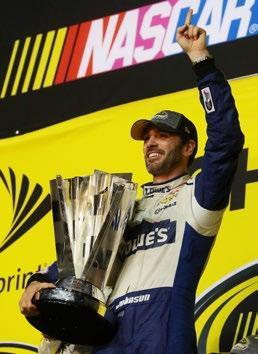
PRESIDENT: BARACK OBAMA NO. 1 AT THE BOX OFFICE: FINDING DORY NO. 1 SONG: “LOVE YOURSELF” BY JUSTIN BIEBER GALLON OF GAS: $1.99 POP CULTURE: THE CHICAGO CUBS DEFEATED THE CLEVELAND INDIANS 4–3 TO CAPTURE THEIR FIRST WORLD SERIES CHAMPIONSHIP SINCE 1908.
BEST DRIVER
JIMMIE JOHNSON, DRIVING THE NO. 48
Lowe’s Chevrolet for Hendrick Motorsports, visited Victory Lane five times during the 2016 NASCAR Cup Series season. Even though the El Cajon, California, native had only 16 top-10 finishes, he used the win column as his biggest asset in earning a spot among the Championship 4 drivers. Then, a victory in the season finale at Homestead-Miami Speedway sealed the deal with Johnson’s record-tying seventh championship.
BEST RACE

DENNY HAMLIN, DRIVING THE NO.
11 Joe Gibbs Racing Toyota, beat Martin Truex Jr.’s Furniture Row Racing Toyota by inches to win the seasonopening Daytona 500 at Daytona International Speedway. On the final lap, Hamlin was running third as he, Matt Kenseth and Truex, as well as the tightly bunched field reached Turn 3. Kenseth went high and got loose as Truex drove low. Hamlin won his first 500 in a photo finish.
TOP CARS

JIMMIE JOHNSON’S NO. 48 HENDRICK Motorsports Chevrolet topped five races, while recording 16 top-10 finishes and one pole in 36 starts
Joey Logano’s No. 22 Team Penske Ford won three times, had 26 top-10 results and earned three poles.
120 THROUGH THE YEARS 16 2016
Truex Caps His Best Season
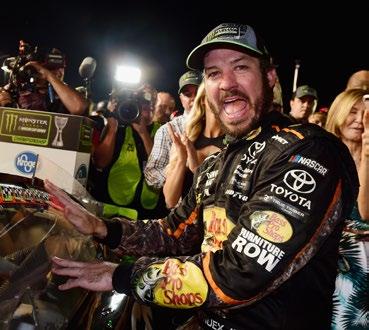
In his 14th Cup Series season dating back to 2004, Martin Truex Jr. put Barney Visser’s Furniture Row Racing Toyota in position to secure his first NASCAR Cup Series championship. The fact he was driving sleek and powerful No. 78 machines prepared in Denver, Colorado, far away from the North Carolina hub of stock car racing, spoke volumes of how well organized the team had become.
Driving the No. 18 Joe Gibbs Racing Toyota, Kyle Busch won the Cup Series title in 2015 and came within five points of a repeat championship. In 2017, he consistently ran upfront and visited Victory Lane at Pocono, New Hampshire, Dover, Bristol and Martinsville in his quest for a second title.
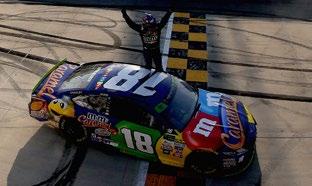
After years of gaining experience with such teams as Dale Earnhardt Inc. and Michael Waltrip Racing, Truex Jr. joined Visser’s operation and began to build a winning organization under team manager Joe Garone and crew chief Todd Berrier. A year later, Cole Pern was placed in the crew chief position and began to form a relationship that would eventually result in 23 of Truex’s 27-career wins.
Truex enjoyed his best season to date with eight victories, 26 top-10 finishes and three pole positions.
The second-generation driver dominated the second half of the Championship 4 finale at Homestead-Miami Speedway, beating Busch to the checkered flag by .681 seconds and by five points in the battle for the championship.
SEASON RECAP
DATE LOCATION WINNER
Feb. 26 Daytona International Speedway Kurt Busch
March 5 Atlanta Motor Speedway Brad Keselowski
March 12 Las Vegas Motor Speedway Martin Truex Jr.
March 19 Phoenix Raceway Ryan Newman
March 26 Auto Club Speedway Kyle Larson
April 2 Martinsville Speedway Brad Keselowski
April 9 Texas Motor Speedway Jimmie Johnson
April 24 Bristol Motor Speedway Jimmie Johnson
April 30 Richmond Raceway Joey Logano
May 7 Talladega Superspeedway Ricky Stenhouse Jr.
May 13 Kansas Speedway Martin Truex Jr.
May 28 Charlotte Motor Speedway Austin Dillon
June 4 Dover Motor Speedway Jimmie Johnson
June 11 Pocono Raceway Ryan Blaney
June 18 Michigan International Speedway Kyle Larson
June 25 Sonoma Raceway Kevin Harvick
July 1 Daytona International Speedway Ricky Stenhouse Jr.
July 8 Kentucky Speedway Martin Truex Jr.
July 16 New Hampshire Motor Speedway Denny Hamlin
July 23 Indianapolis Motor Speedway Kasey Kahne
July 30 Pocono Raceway Kyle Busch
Aug. 6 Watkins Glen International Martin Truex Jr.
Aug. 13 Michigan International Speedway Kyle Larson
Aug. 19 Bristol Motor Speedway Kyle Busch
Sept. 3 Darlington Raceway Denny Hamlin
Sept. 9 Richmond Raceway Kyle Larson
Sept. 17 Chicagoland Speedway Martin Truex Jr.
Sept. 24 New Hampshire Motor Speedway Kyle Busch
Oct. 1 Dover Motor Speedway Kyle Busch
Oct. 8 Charlotte Motor Speedway Martin Truex Jr.
Oct. 15 Talladega Superspeedway Brad Keselowski
Oct. 22 Kansas Speedway Martin Truex Jr.
Oct. 29 Martinsville Speedway Kyle Busch
Nov. 5 Texas Motor Speedway Kevin Harvick
Nov. 12 Phoenix Raceway Matt Kenseth
Nov. 19 Homestead-Miami Speedway Martin Truex Jr.
BEST DRIVER
MARTIN TRUEX JR., DRIVER OF THE Furniture Row Racing Toyota, enjoyed his best season in 2017 with eight Cup Series victories. The Mayetta, New Jersey, native led 2,253 laps of 10,368 completed during the 36-race schedule. His average start was 6.8 and average finish was 9.4. He suffered only five crashes and one engine failure throughout the year. Truex Jr. was never below second in points following the ninth race of the season at Richmond Raceway.
BEST RACE
AFTER SIX YEARS OF SEARCHING for Victory Lane, Wood Brothers Racing scored its 99th NASCAR win at Pocono Raceway with Ryan Blaney wheeling the team’s No. 21 Ford. The secondgeneration driver from High Point, North Carolina, led only 10 of 200 laps but held off Kevin Harvick to score his first Cup Series victory. The most recent win for the famed Wood Brothers Racing team came in the 2011 Daytona 500 with driver Trevor Bayne.
TOP CARS
MARTIN TRUEX’S NO. 78 FURNITURE
Row Racing/Bass Pro Shops Toyota won eight NASCAR Cup Series events during the 2017 season.
Kyle Busch’s No. 18 Joe Gibbs
Racing/M&M’s Toyota posted five wins with 22 top-10 finishes in 36 series starts.
121 17
PRESIDENT: DONALD TRUMP NO. 1 AT THE BOX OFFICE: STAR WARS: EPISODE VIII – THE LAST JEDI NO. 1 SONG: “SHAPE OF YOU” BY ED SHEERAN GALLON OF GAS: $2.41 POP CULTURE: THE NFL’S OAKLAND RAIDERS AND SAN DIEGO CHARGERS MOVE TO LOS ANGELES.
2017
Toyota drivers Martin Truex Jr. and Kyle Busch proved to be the top championship contenders during the 2017 NASCAR Cup Series season, winning a combined 13 of 36 races over the course of the season.
Logano Now a Cup Series Champ
Driving the No. 22 Team Penske Ford, Joey Logano, of Middletown, Connecticut, collected three wins
Logano was quiet but productive throughout the 2018 season. He finished fourth behind Austin Dillon in the season-opening Daytona 500 and put together a steady string of top-10 finishes, with the exception of a 19th-place effort at Phoenix in the fourth race of the year. His first win of the season came April 29 at Talladega, securing his spot in the playoffs.
Logano was running at the end of every race up until he was involved in a multi-car crash during the July event at Daytona International Speedway. Weeks later he finished last at Watkins Glen due to a cracked radiator. The rest of the regular season was filled with top-10 finishes as he ended up sixth in the regular-season standings.
In the playoffs, Logano finished fourth at Las Vegas, 14th at Richmond, 10th at Charlotte, third at Dover and fifth at Talladega. After the Kansas playoff race, he became the sole Penske driver in the Round of 8 after teammates Brad Keselowski and Ryan Blaney were eliminated.
Entering the Round of 8, Logano won the Martinsville race after a battle with Martin Truex Jr. at the finish line, claiming a spot in the Championship 4. He dominated the event, leading 309 of 500 laps, and took home his first grandfather clock trophy.

Logano was third at Texas and 37th at Phoenix. He then won at Homestead after passing Truex with 12 laps remaining and was crowned Cup Series champion.
SEASON RECAP
DATE LOCATION WINNER
Feb. 18 Daytona International Speedway Austin Dillon
Feb. 25 Atlanta Motor Speedway Kevin Harvick
March 4 Las Vegas Motor Speedway Kevin Harvick
March 11 Phoenix Raceway Kevin Harvick
March 18 Auto Club Speedway Martin Truex Jr.
March 26 Martinsville Speedway Clint Bowyer
April 8 Texas Motor Speedway Kyle Busch
April 16 Bristol Motor Speedway Kyle Busch
April 21 Richmond Raceway Kyle Busch
April 29 Talladega Superspeedway Joey Logano
May 6 Dover Motor Speedway Kevin Harvick
May 12 Kansas Speedway Kevin Harvick
May 27 Charlotte Motor Speedway Kyle Busch
June 3 Pocono Raceway Martin Truex Jr.
June10 Michigan International Speedway Clint Bowyer
June 24 Sonoma Raceway Martin Truex Jr.
July 1 Chicagoland Speedway Kyle Busch
July 7 Daytona International Speedway Erik Jones
July 14 Kentucky Speedway Martin Truex Jr.
July 22 New Hampshire Motor Speedway Kevin Harvick
July 29 Pocono Raceway Kyle Busch
Aug. 5 Watkins Glen International Chase Elliott
Aug. 12 Michigan International Speedway Kevin Harvick
Aug. 18 Bristol Motor Speedway Kurt Busch
Sept. 2 Darlington Raceway Brad Keselowski
Sept. 10 Indianapolis Motor Speedway Brad Keselowski
Sept. 16 Las Vegas Motor Speedway Brad Keselowski
Sept. 22 Richmond Raceway Kyle Busch
Sept. 30 Charlotte Motor Speedway ROVAL Ryan Blaney
Oct. 7 Dover Motor Speedway Chase Elliott
Oct. 14 Talladega Superspeedway Aric Almirola

Oct. 21 Kansas Speedway Chase Elliott
Oct. 28 Martinsville Speedway Joey Logano
Nov. 4 Texas Motor Speedway Kevin Harvick
Nov. 11 Phoenix Raceway Kyle Busch
Nov. 18 Homestead-Miami Speedway Joey Logano
POP
BEST DRIVER
KEVIN HARVICK, DRIVING THE NO. 4 Stewart-Haas Racing Ford, amassed eight wins, 29 top-10 finishes and four pole positions while enjoying one of his best seasons in the NASCAR Cup Series standings. Harvick ended up third behind Joey Logano and Martin Truex Jr. after seeing his championship hopes evaporate simply through track position at the end of the Homestead finale. Otherwise, the Bakersfield, California, native enjoyed an impressive season as one of the sport’s top drivers.
BEST RACE

ERIK JONES, DRIVER OF THE NO. 20 Joe Gibbs Racing Toyota, was in position during the closing laps to win the Coke Zero 400 at Daytona International Speedway. In overtime, Kevin Harvick took the lead from Kasey Kahne, but Clint Bowyer spun and collected Harvick, Brendan Gaughan and others.
On the second restart of overtime, Jones drove past Martin Truex Jr. to score his first career victory as the seventh different winner of the season.
TOP CARS

JOEY LOGANO’S NO. 22 TEAM PENSKE Shell-Pennzoil Ford visited Victory Lane three times and had 26 top-10 finishes in 36 races.
The No. 4 Stewart-Haas Racing Busch Beer Ford driven by veteran Kevin Harvick won eight times with 29 top-10 results.
122 THROUGH THE YEARS 18 2018
and 26 top-10 results on the way to capturing his first NASCAR Cup Series championship.
PRESIDENT: DONALD TRUMP NO. 1 AT THE BOX OFFICE: BLACK PANTHER NO. 1 SONG: “GOD’S PLAN” BY DRAKE GALLON OF GAS: $2.57
CULTURE: THE BRITISH ROYAL FAMILY CELEBRATED THE WEDDING OF PRINCE HARRY AND AMERICAN ACTRESS MEGHAN MARKLE ON MAY 19.
Title No. 2 for Kyle Busch
Busch’s season got off to a strong start. He finished second in the Daytona 500, sixth at Atlanta and third at Las Vegas before finding Victory Lane at Phoenix. He followed that with a second consecutive win at Auto Club Speedway before finishing 10th at Texas and winning again at Bristol to maintain his stranglehold on the points. A disappointing 30thplace finish at Kansas three races later dropped him to second in the standings, but the setback was far from insurmountable.
A third at Charlotte and a win at Pocono sent the message that Busch had the championship on his mind. He car was being prepared by crew chief Adam Stevens and their union was producing some very strong results, including winning the regular-season championship.
Aside from a 22nd-place finish at Chicago and 14th in the July race at Daytona, Busch knocked off finishes no worse than 11th over the next seven races through Richmond. Then, suspension issues surfaced at Charlotte’s ROVAL, producing a 37th-place finish.
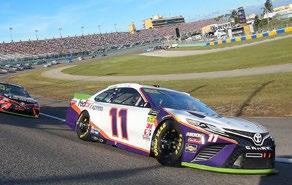
In the final six races, Busch finished 19th at Talladega and 14th at Martinsville but a third at Kansas, seventh at Texas and a second at Phoenix earned him a spot in the Championship 4 at Homestead along with Martin Truex Jr. Kevin Harvick and Denny Hamlin.
Busch won the Homestead race after leading 40 of the 267 laps and by doing so, claimed the 2019 Cup Series championship. Truex Jr. ended up second in the title fight with Harvick third and Hamlin fourth.
2019
BEST DRIVER
DRIVING THE NO. 11 JOE GIBBS
Racing Toyota, Denny Hamlin logged six wins, 24 top-10 finishes and three pole positions in 36 starts for the season’s best stats line. In the closing laps of the championship race at Homestead-Miami Speedway, it was discovered that too much tape had been placed on the front of Hamlin’s Fed-Ex-sponsored ride, making the engine overheat. He fell from third to 10th in the final running order.
SEASON RECAP
DATE LOCATION WINNER
Feb. 17 Daytona International Speedway Denny Hamlin
Feb. 24 Atlanta Motor Speedway Brad Keselowski
March 3 Las Vegas Motor Speedway Joey Logano
March 10 Phoenix Raceway Kyle Busch
March 17 Auto Club Speedway Kyle Busch
March 24 Martinsville Speedway Brad Keselowski
March 31 Texas Motor Speedway Denny Hamlin
April 7 Bristol Motor Speedway Kyle Busch
April 13 Richmond Raceway Martin Truex Jr.
April 28 Talladega Superspeedway Chase Elliott
May 6 Dover Motor Speedway Martin Truex Jr.
May 11 Kansas Speedway Brad Keselowski
May 26 Charlotte Motor Speedway Martin Truex Jr.
June 2 Pocono Raceway Kyle Busch
June 10 Michigan International Speedway Joey Logano
June 23 Sonoma Raceway Martin Truex Jr.
June 30 Chicagoland Speedway Alex Bowman
July 7 Daytona International Speedway Justin Haley
July 13 Kentucky Speedway Kurt Busch
July 21 New Hampshire Motor Speedway Kevin Harvick
July 28 Pocono Raceway Denny Hamlin
Aug. 4 Watkins Glen International Chase Elliott
Aug. 11 Michigan International Speedway Kevin Harvick
Aug. 17 Bristol Motor Speedway Denny Hamlin
Sept. 1 Darlington Raceway Erik Jones
Sept. 8 Indianapolis Motor Speedway Kevin Harvick
Sept. 15 Las Vegas Motor Speedway Martin Truex Jr.
Sept. 21 Richmond Raceway Martin Truex Jr.
Sept. 29 Charlotte Motor Speedway ROVAL Chase Elliott
Oct. 6 Dover Motor Speedway Kyle Larson
Oct. 14 Talladega Superspeedway Ryan Blaney
Oct. 20 Kansas Speedway Denny Hamlin
Oct. 27 Martinsville Speedway Martin Truex Jr.
Nov. 3 Texas Motor Speedway Kevin Harvick
Nov. 10 Phoenix Raceway Denny Hamlin
Nov. 17 Homestead-Miami Speedway Kyle Busch
PRESIDENT: DONALD TRUMP NO. 1 AT THE BOX OFFICE: AVENGERS: ENDGAME NO. 1 SONG: “OLD TOWN ROAD” BY LIL NAS X FEATURING BILLY RAY CYRUS GALLON OF GAS: $2.60 POP CULTURE: OVERCOMING INJURIES AND PERSONAL ISSUES, 43-YEAR-OLD TIGER WOODS RETURNED TO THE PINNACLE OF GOLF, WINNING THE MASTERS FOR THE FIFTH TIME IN HIS STORIED CAREER.
BEST RACE
IN THE WRECK-FILLED 1000BULBS. com 500 at Talladega Superspeedway on Oct. 14, three major crashes occurred before Ryan Blaney of Team Penske could claim victory. The third “big one” happened with seven laps remaining. Kyle Busch hit Brad Keselowski and collected Kevin Harvick, Brendan Gaughan and many others. On the last lap, Blaney made the winning move, bumping Newman’s car. Blaney won by .007 seconds, the sixthclosest finish in NASCAR history.
TOP CARS
KYLE BUSCH’S NO. 18 JOE GIBBS

Racing M&M’s Toyota had five wins, 27 top-10 finishes and one pole in 36 starts.
Denny Hamlin’s No. 11 Joe Gibbs
Racing Fed-Ex Toyota recorded six wins, 24 top10 results and started from the pole three times.
123 19
Driving the No. 18 Joe Gibbs Racing Toyota, Kyle Busch posted five victories and 27 top-10 finishes during the 2019 season as the Las Vegas native earned his second NASCAR Cup Series championship.
Elliott: Like Father, Like Son
Chase Elliott, driver of the No. 9 Hendrick Motorsports Chevrolet, won five times and captured his first NASCAR Cup Series championship during an unprecedented season in which COVID-19 had a tremendous impact on the racing industry.
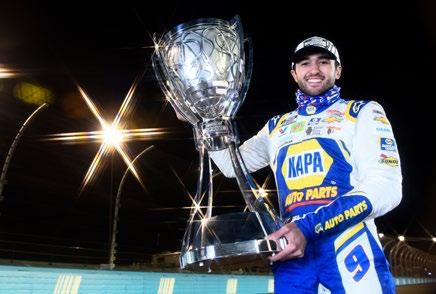
BEST DRIVER
KEVIN HARVICK, driver of the No. 4 Stewart-Haas Racing Ford, collected nine NASCAR Cup Series wins and 27 top-10 results in 36 starts. It was Harvick’s best season in the win column and the native of Bakersfield, California, captured the regular-season championship. However, he was eliminated from title contention after finishing 17th at Martinsville and could do no better than fifth the final series standings.
BEST RACE
LATE IN THE AUG. 29
SEASON RECAP
DATE
Feb.
Feb.
March
May
May
May
May
June 7 Atlanta Motor Speedway Kevin Harvick
June 10 Martinsville Speedway Martin Truex Jr.
June 14 Homestead-Miami Speedway Denny Hamlin
June 22 Talladega Superspeedway Ryan Blaney
June 27 Pocono Raceway Kevin Harvick
June 28 Pocono Raceway Denny Hamlin
July 5 Indianapolis Motor Speedway Kevin Harvick
July 12 Kentucky Speedway Cole Custer
July 19 Texas Motor Speedway Austin Dillon
July 23 Kansas Speedway Denny Hamlin
Aug. 2 New Hampshire Motor Speedway Brad Keselowski
Aug. 8 Michigan International Speedway Kevin Harvick
Aug. 9 Michigan International Speedway Kevin Harvick
Aug. 16 Daytona International Speedway RC Chase Elliott
Aug. 22 Dover Motor Speedway Denny Hamlin
Aug. 23 Dover Motor Speedway Kevin Harvick
Aug. 29 Daytona International Speedway William Byron
Sept. 6 Darlington Raceway Kevin Harvick
Sept. 12 Richmond Raceway Brad Keselowski
Sept. 19 Bristol Motor Speedway Kevin Harvick
Sept. 27 Las Vegas Motor Speedway Kurt Busch
Oct. 4 Talladega Superspeedway Denny Hamlin
The son of 1988 NASCAR Cup Series champion Bill Elliott began racing in the mid-2000s, and he signed a driver development contract with Hendrick Motorsports in 2011.
Elliott won in Legend Cars, Late Models and the NASCAR Truck and Xfinity Series before making his Cup Series debut in 2015. He earned rookie-of-the-year honors in 2016 and claimed his first two Cup Series wins in 2017.
Elliott felt he was ready to contend for a championship in 2020 but misfortunes plagued the first half of his season in a schedule greatly altered by COVID-19 protocols.
Elliott rebounded by winning at Charlotte, in a 208lap, 312-mile race, after passing Kevin Harvick for the lead with 27 laps remaining. He was on the verge of a second consecutive race win at Bristol when he and Joey Logano tangled with three laps remaining, relegating Elliott to 22nd and sparking a heated post-race discussion between the two.
In August on the Daytona road course, Elliott won his second points-paying event of the season. He also won on the Charlotte ROVAL in October to earn a spot among the Championship 4.
The five-time Most Popular Driver started last in the season finale at Homestead after failing pre-race inspection twice, but led a race-high 153 laps to win the race and the championship.
The Elliotts became the third father-son duo to win titles following the Pettys (Lee and Richard) and the Jarretts (Ned and Dale). The 24-year-old Elliott was the third youngest driver to win the championship behind Jeff Gordon and Bill Rexford.
Coke Zero 400 at Daytona, Tyler Reddick took the lead and then crashed with Kyle Busch, Kurt Busch, Ryan Newman, Erik Jones, Ryan Preece and Ricky Stenhouse Jr. On the restart, Denny Hamlin crashed with Joey Logano, Reddick, Matt Kenseth, Daniel Suarez, Cole Custer and Jimmie Johnson, ending Johnson’s chance of making the playoffs in his final full-time season. In overtime, William Byron held off Chase Elliott for his first career victory.
TOP CARS
CHASE ELLIOTT’S NO. 9
Hendrick Motorsports
NAPA Auto Parts Chevrolet won five times and had 22 top-10 finishes.
Wheeling the No. 4 Stewart-Haas Racing Busch Beer Ford, Kevin Harvick notched nine wins with 27 top-10 results.
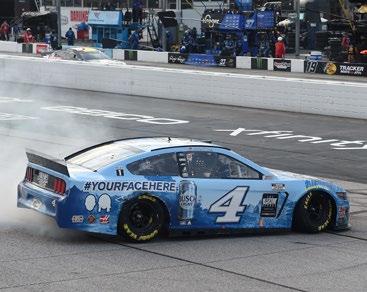
Oct. 11 Charlotte Motor Speedway ROVAL Chase Elliott
Oct. 18 Kansas Speedway Joey Logano
Oct. 28 Texas Motor Speedway Kyle Busch
Nov. 1 Martinsville Speedway Chase Elliott
Nov. 8 Phoenix Raceway Chase Elliott
PRESIDENT
Donald Trump
NO. 1 AT THE BOX OFFICE
Bad Boys for Life
NO. 1 SONG
“Blinding Lights” by The Weeknd

POP CULTURE
COVID-19 dominated the news and wreaked havoc around the world.

GALLON OF GAS
$2.87
2020
124 THROUGH THE YEARS 20
LOCATION WINNER
17 Daytona International Speedway Denny Hamlin
23 Las Vegas Motor Speedway Joey Logano
1 Auto Club Speedway Alex Bowman
March
8 Phoenix Raceway Joey Logano
Darlington Raceway Kevin Harvick
17
20 Darlington Raceway Denny Hamlin
24 Charlotte Motor
Brad Keselowski
Speedway
28 Charlotte Motor
Chase Elliott
31 Bristol Motor Speedway Brad Keselowski
Speedway
May
Driving the No. 5 Hendrick Motorsports Chevrolet, Kyle Larson notched 10 wins and 26 top-10 results en route to claiming the NASCAR Cup Series championship during his second season with team owner Rick Hendrick.
BEST DRIVER
KYLE LARSON, wheeling the No. 5 Hendrick Motorsports Chevrolet, emerged as the driver who seemingly could do no wrong throughout the 2021 season. There were times when races looked lost only to see Larson and his Cliff Daniels-led crew emerge victorious in the closing laps. Their momentum was unmistakable, especially when it was needed most. He is the only driver to take the flagship No. 5 Hendrick Motorsports team to a NASCAR Cup Series championship.
BEST RACE
SEASON RECAP
Feb.
Feb.
Feb.
March
March.
March.
April
Superspeedway
May 2 Kansas Speedway
May 9 Darlington Raceway
May 16 Dover Motor Speedway
May 23 Circuit of The Americas
May 30 Charlotte Motor Speedway
June 6 Sonoma Raceway
June 20 Nashville Superspeedway
June 26 Pocono Raceway
June 27 Pocono Raceway
July 4 Road America
July 11 Atlanta Motor Speedway
July 18 New Hampshire Motor Speedway
Aug. 8 Watkins Glen International
Aug. 15 Indianapolis Motor Speedway RC
Aug. 22 Michigan International Speedway
Aug. 28 Daytona International Speedway
Sept. 5 Darlington Raceway
Sept. 11 Richmond Raceway
Sept. 18 Bristol Motor Speedway
Sept. 26 Las Vegas Motor Speedway
Keselowski
Busch
Elliott
Larson
Bowman
Busch
Busch
Blaney
Blaney
Truex Jr.
After spending six Cup Series seasons with Chip Ganassi Racing dating back to 2013, Larson and team owner Chip Ganassi parted ways after Larson was suspended by NASCAR four races into the 2020 season for using a racial slur.
Larson joined Hendrick Motorsports for the 2021 season and logged only three top-10 results amid a very disappointing season.
At the start of 2021, the light switch was seemingly flipped as the success began coming in waves.
Larson finished 10th in the season-opening Daytona 500, 30th on the Daytona road course and fourth at Homestead before logging his first win of the season at Las Vegas. It was feast or famine for the Elk Grove, California, driver over the next 10 weeks as he posted five top-5 finishes before winning again at Charlotte on May 30.
Two additional wins came consecutively at Sonoma and Nashville, and three more top-10 finishes followed, two at Pocono and one at Loudon, to offset a 16th-place finish at Road America and an 18th -place effort at Atlanta. Victory No. 5 on the season came at Watkins Glen and was followed by another string of top-5 finishes at Indianapolis, Michigan and Darlington.
A win at Bristol and three more consecutively at the Charlotte ROVAL, Texas and Kansas placed Larson in perfect position to battle Martin Truex Jr., Denny Hamlin and Chase Elliott in the Championship 4 showdown at Phoenix.
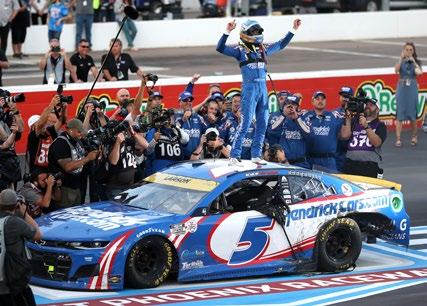
Larson won the finale to claim his first title. It was the perfect ending to his Cinderella season.
ON THE LAST LAP OF the Daytona 500, Brad Keselowski attempted to pass teammate Joey Logano on the backstretch with an assist from Michael McDowell, but the push spun Keselowski into Logano’s left-rear quarter panel. Keselowski crashed into Bubba Wallace as the massive wreck also collected Austin Cindric, Kyle Larson, Kyle Busch, Ryan Preece and Ross Chastain. McDowell slipped through to win his first NASCAR Cup Series race in the sport’s most prestigious event.
TOP CARS
KYLE LARSON’S NO. 5
Hendrick Motorsports HendrickCars.com
Chevrolet recorded 10 wins and 26 top-10 finishes in the season’s 36 races.
Driving the No. 19 Joe Gibbs Racing Bass Pro Shops Toyota, Martin Truex Jr. notched four wins and 20 top-10 results.
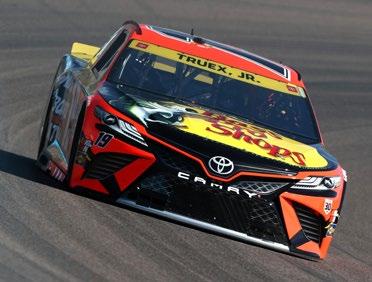
Oct. 4 Talladega Superspeedway
Oct. 10 Charlotte Motor Speedway ROVAL
Oct. 17 Texas Motor Speedway
Oct. 24 Kansas Speedway
Oct. 31 Martinsville Speedway
Nov. 7 Phoenix Raceway
PRESIDENT
Joe Biden
NO. 1 AT THE BOX OFFICE
Wallace
Larson
Larson
Spider-Man: No Way Home
NO. 1 SONG
“Levitating” by Dua Lipa
POP CULTURE
Postponed due to the COVID-19 pandemic, the 2020 edition of the Summer Olympics took place in Tokyo.
GALLON OF GAS
$3.26
Larson Lights Up the Scoreboard 2021
125
LOCATION WINNER
DATE
14 Daytona International Speedway Michael McDowell
21 Daytona International Speedway RC Christopher Bell
28 Homestead-Miami Speedway William Byron
7 Las Vegas Motor Speedway Kyle Larson
March
14 Phoenix Raceway Martin Truex Jr.
21 Atlanta Motor Speedway Ryan Blaney
29 Bristol Motor Speedway (dirt) Joey Logano
11 Martinsville Speedway Martin Truex Jr.
18 Richmond Raceway Alex Bowman
25 Talladega
Brad
April
April
Kyle
Martin Truex Jr.
Alex
Bowman
Chase
Kyle
Larson
Kyle
Larson
Kyle
Alex
Kyle
Chase Elliott
Kurt
Aric Almirola
Kyle
Larson
A.J. Allmendinger
Ryan
Ryan
Denny
Hamlin
Martin
Kyle
Larson
Denny
Hamlin
Bubba
Kyle Larson
Kyle
Kyle
Alex
Bowman
Kyle
21
Larson
Title No. 2 for Driver No. 22
During the inaugural season for NASCAR’s Next Gen race
car, Connecticut native Joey Logano accumulated four wins and 17 top-10 finishes as the Team Penske driver claimed his second NASCAR Cup Series championship.

BEST DRIVER
CHASE ELLIOTT, driver of the No. 9 Hendrick Motorsports Chevrolet, logged five wins and 20 top-10 finishes during the 36-race schedule.
On a restart with 113 laps remaining in the Championship Race, Ross Chastain made a move to Elliott’s left. Elliott went down to defend as Chastain was just to his inside. Chastain didn’t lift and Elliott’s car went spinning into the inside wall, ending his chances of securing his second Cup Series championship.
BEST RACE
SEASON RECAP
DATE LOCATION WINNER
Feb. 20 Daytona International Speedway Austin Cindric
Feb. 27 Auto Club Speedway Kyle Larson
March 6 Las Vegas Motor Speedway Alex Bowman
March 13 Phoenix Raceway Chase Briscoe
March 20 Atlanta Motor Speedway William Byron
March 27 Circuit of The Americas Ross Chastain
April 3 Richmond Raceway Denny Hamlin
April 9 Martinsville Speedway William Byron
April 17 Bristol Motor Speedway (dirt) Kyle Busch
April 24 Talladega Superspeedway Ross Chastain
May 2 Dover Motor Speedway Chase Elliott
May 8 Darlington Raceway Joey Logano
May 15 Kansas Speedway Kurt Busch
May 29 Charlotte Motor Speedway Denny Hamlin
June 5 World Wide Technology Raceway Joey Logano
June 12 Sonoma Raceway Daniel Suarez
June 26 Nashville Superspeedway Chase Elliott
July 3 Road America Tyler Reddick
July 10 Atlanta Motor Speedway Chase Elliott
July 17 New Hampshire Motor Speedway Christopher Bell
July 24 Pocono Raceway Chase Elliott
July 31 Indianapolis Motor Speedway RC Tyler Reddick
Aug. 7 Michigan International Speedway Kevin Harvick
Aug. 14 Richmond Raceway Kevin Harvick
Aug. 21 Watkins Glen International Kyle Larson
Aug. 27 Daytona International Speedway Austin Dillon
Sept. 4 Darlington Raceway Erik Jones
Sept. 11 Kansas Speedway Bubba Wallace
Sept. 17 Bristol Motor Speedway Chris Buescher
Sept. 25 Texas Motor Speedway Tyler Reddick
Oct. 2 Talladega Superspeedway Chase Elliott
Oct. 9 Charlotte Motor Speedway ROVAL Christopher Bell
Oct. 16 Las Vegas Motor Speedway Joey Logano
Oct. 23 Homestead-Miami Speedway Kyle Larson
Logano began the season by winning the inaugural Busch Light Clash at the L.A. Memorial Coliseum. Even though it was a non-points exhibition race, he and crew chief Paul Wolfe hoped visiting Victory Lane at the historic sports venue would set the stage for a strong season throughout the 36-race schedule.
However, the early months seemed long and hard.

Logano had only five top-10 finishes in the first 11 races before winning at Darlington Raceway, which moved him from ninth to fourth in points. A win at World Wide Technology Raceway in Madison, Illinois, two weeks later over Kyle and Kurt Busch further helped his title efforts.
A string of not so desirable finishes during the next six weeks, highlighted by only one top-10 result at Nashville, was beginning to spell doom for Logano and his No. 22 team. Then, there was a sixth at Indianapolis, a fourth at Michigan, a sixth at Richmond and a third at Watkins Glen that bolstered their championship cause. The seven races that followed more resembled a roller-coaster ride of top-5 finishes and results outside the top 15, the worst being 27th-place showings at Bristol and Talladega.
A victory at Las Vegas put Logano in the Championship 4 alongside Christopher Bell, Ross Chastain and Chase Elliott. Logano’s victory at Phoenix Raceway on Nov. 6 after starting from the pole marked his second championship with iconic team owner Roger Penske. Bell finished second in the final standings, followed by Chastain and Elliott.
AT MARTINSVILLE ON Oct. 30, Christopher Bell needed to win to join Joey Logano in the Championship 4 at Phoenix – and the Toyota driver from Norman, Oklahoma, did just that. Chase Elliott advanced on points as did Ross Chastain, who rode the wall in a videogame-style move to go from 10th to fifth in the final corner of the last lap, eliminating eliminate Denny Hamlin from the playoffs.
TOP CARS
JOEY LOGANO’S NO. 22 Team Penske ShellPennzoil Ford visited Victory Lane four times and had 17 top-10 finishes.
The No. 9 Hendrick Motorsports NAPA Auto Parts Chevrolet driven by Chase Elliott won five times with 20 top-10 results.

Oct. 30 Martinsville Speedway Christopher Bell
Nov. 6 Phoenix Raceway Joey Logano
PRESIDENT
Joe Biden
NO. 1 AT THE BOX OFFICE
Top Gun: Maverick
NO. 1 SONG
“Anti-Hero” by Taylor Swift

POP CULTURE
Forty days after announcing his retirement, legendary NFL quarterback Tom Brady revealed he was returnign for a 22nd season
GALLON OF GAS
$4.03
126 THROUGH THE YEARS 22
2022
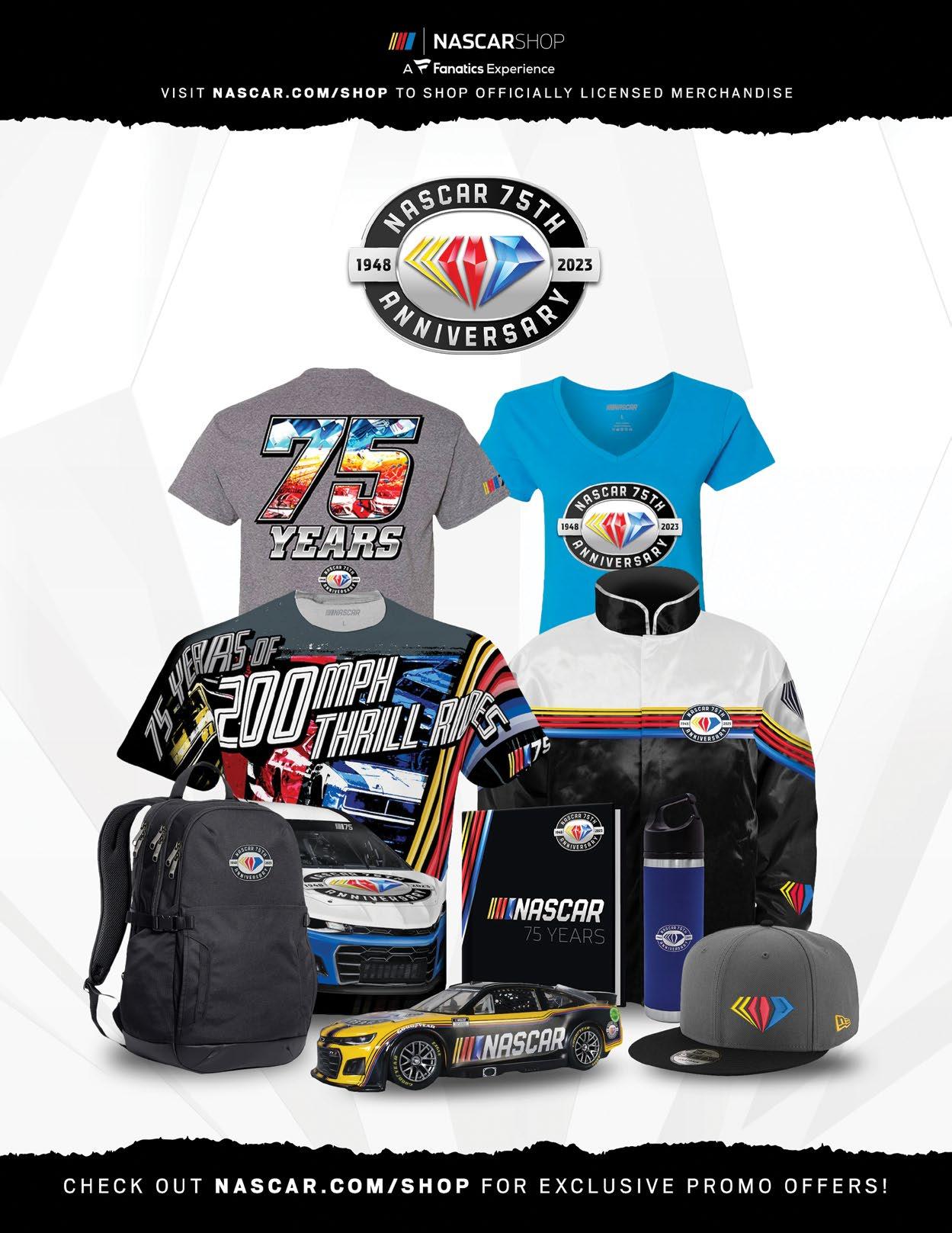
The Evolution of NASCAR Cup Series Cars
SOURCE: NASCAR.COM
Examine the vast changes NASCAR’s Cup Series race cars have seen over the years, starting prior to the introduction of the series all the way to the current Next Gen car.




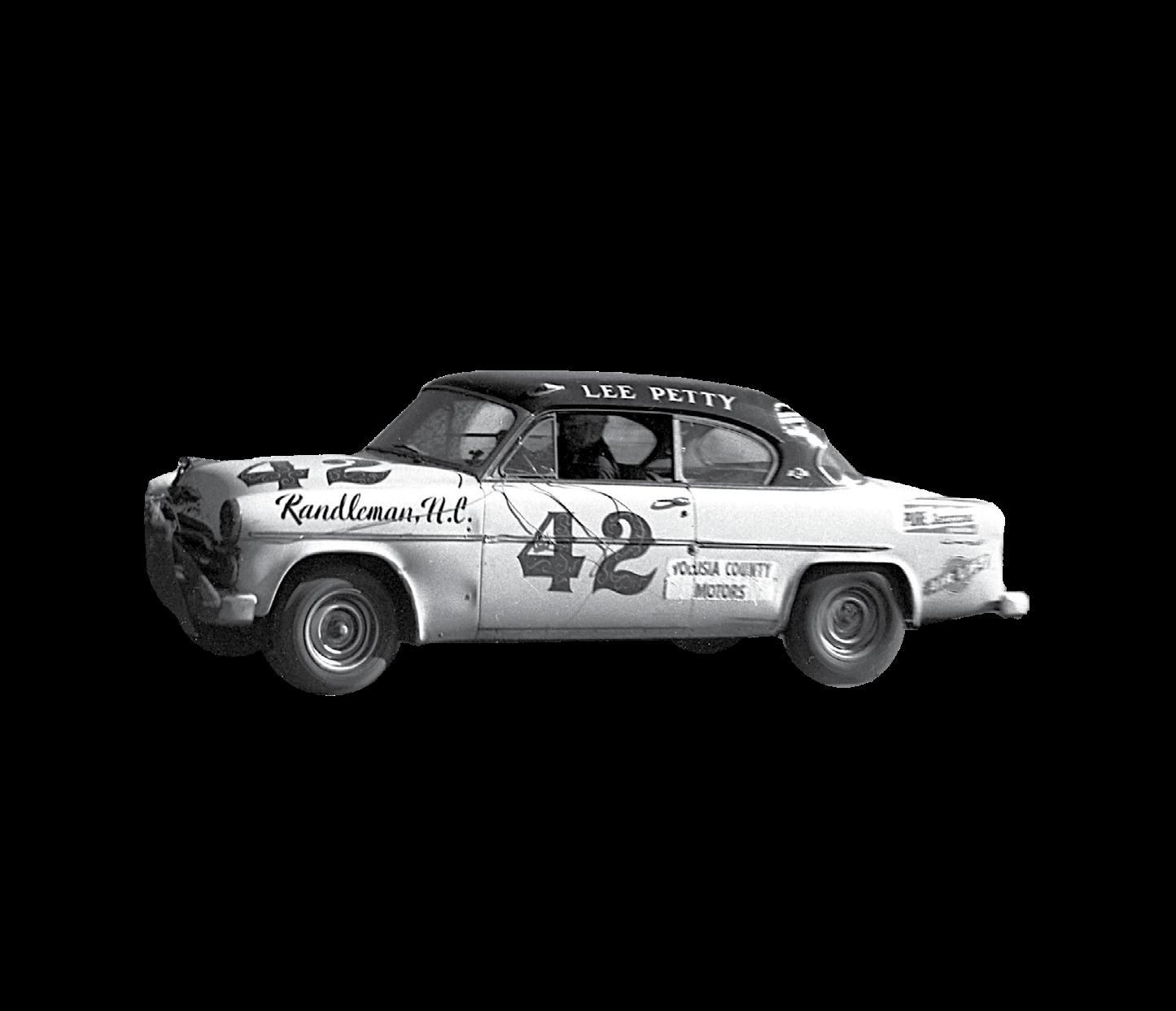
GENERATION 1
1949-1966
Strictly stock frame and body. Doors strapped shut, seat belts required. Heavy-duty rear axle mandatory to keep cars from flipping during the race.

PHOTOGRAPHY: GETTY IMAGES 128 STOCK CAR EVOLUTION
GENERATION 3: 1981-1991

Wheelbase reduced to 110 inches. NASCAR downsizes cars to better resemble cars on the showroom floor. Body panels still purchased through manufacturers.

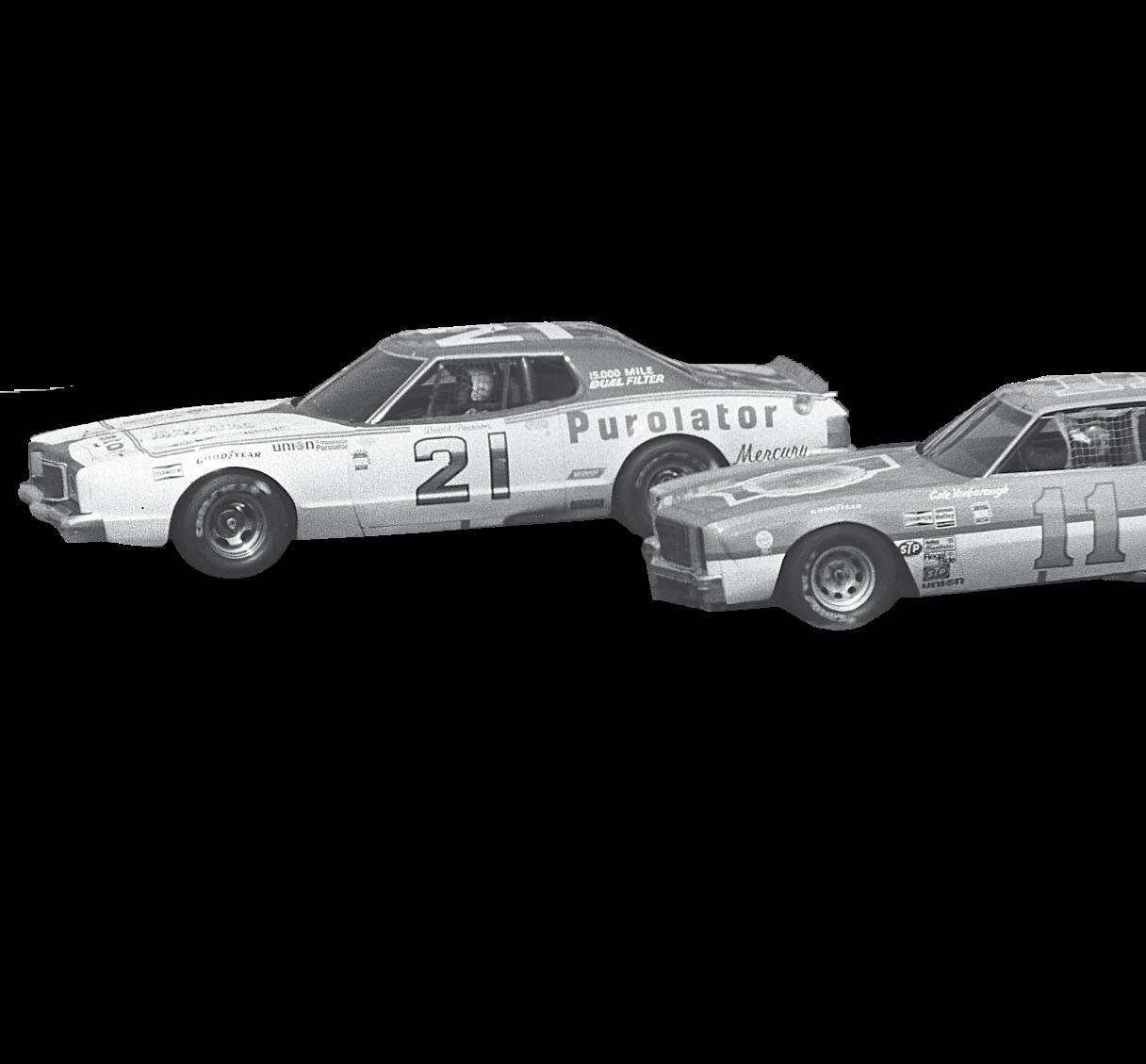
129 PHOTOGRAPHY: GETTY IMAGES
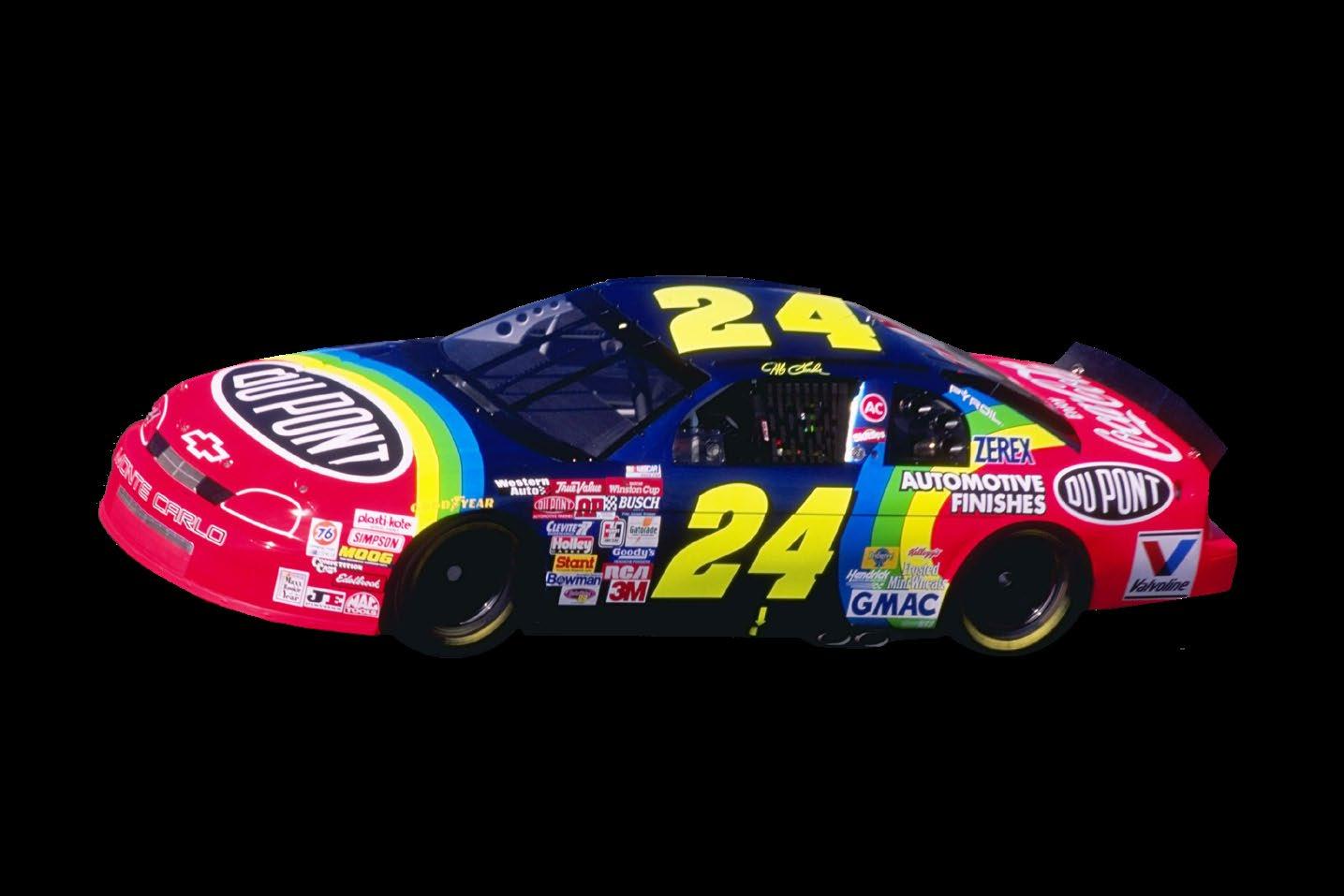
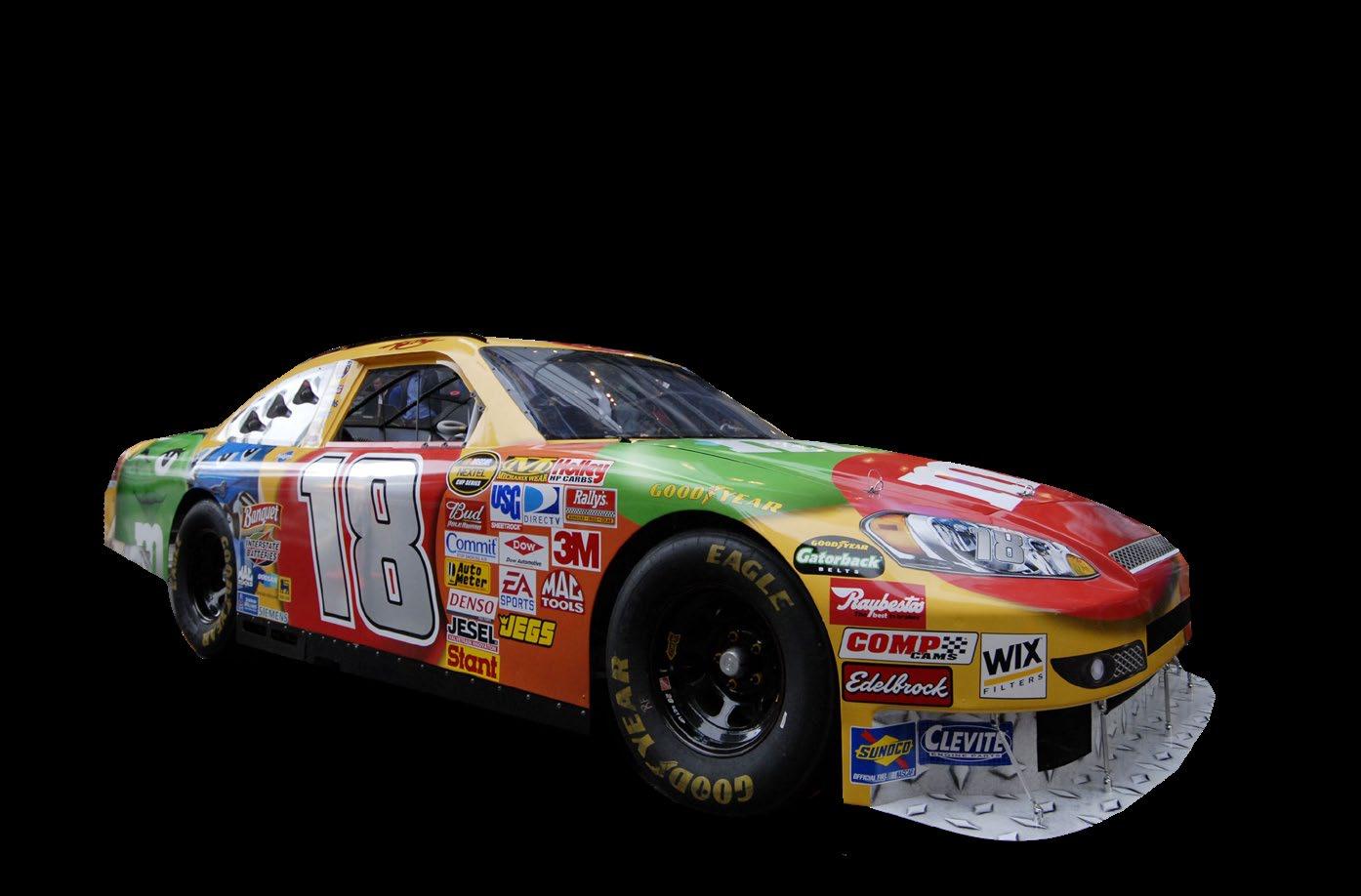


PHOTOGRAPHY: GETTY IMAGES 130 STOCK CAR EVOLUTION

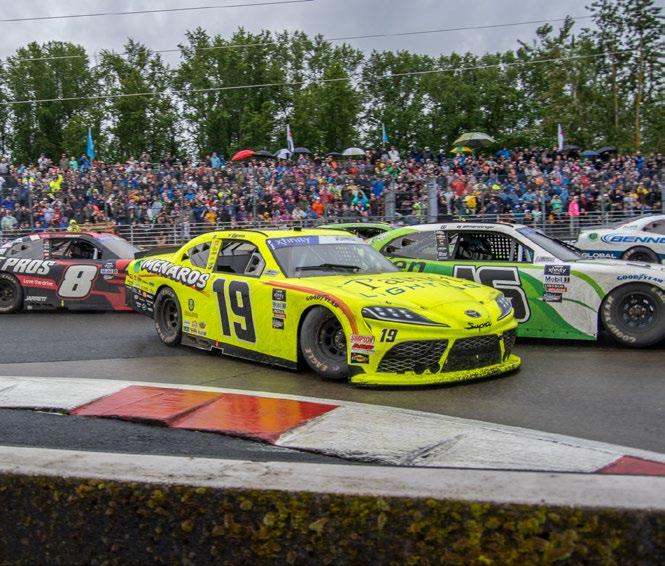
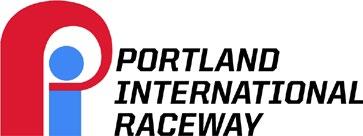


Two legendary tracks nascar racing returns to CONGRATULATES NASCAR ON ITS 75TH ANNIVERSARY. WE’RE HONORED TO BE A PART OF IT. June 2-3, 2023 PORTLAND INTERNATIONAL RACEWAY NASCARPORTLAND.COM July 7-8, 2023 MID-OHIO SPORTS CAR COURSE MIDOHIO.COM




PHOTOGRAPHY: GETTY IMAGES 132 STOCK CAR EVOLUTION
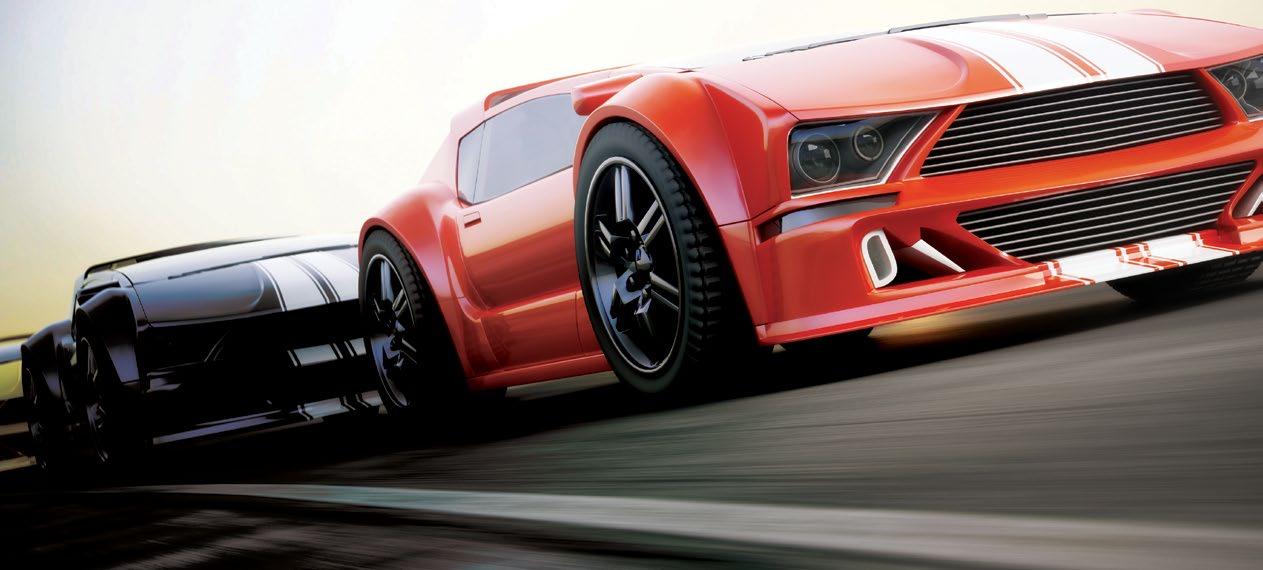











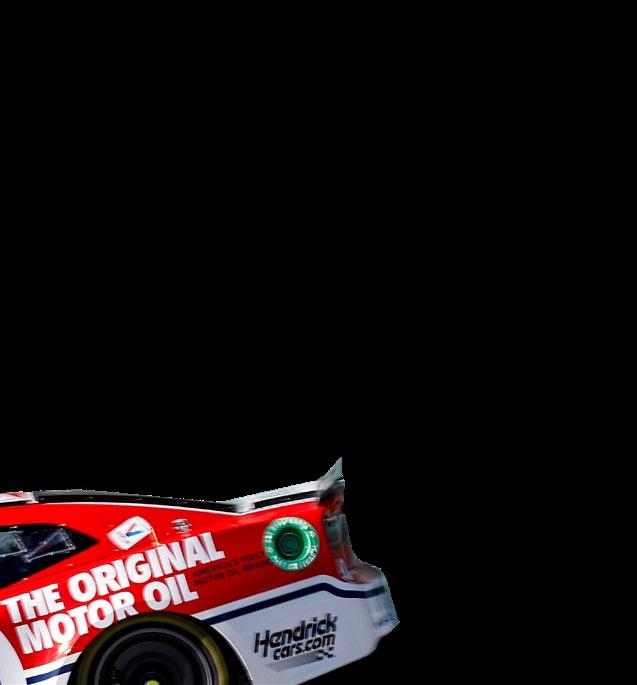
Train to become an Automotive Technician in 14 Months with our hands-on program! TRAIN IN: • Automotive Engines • Electricity • Brakes • Chassis • Automotive Heating and Air Conditioning • Clutch, Drive Train, Transmissions • Engine Performance 1 • Engine Performance 2 ELECTIVES IN: • Automotive and Light Duty Diesel Technology • Hybrid/Alternative Fuels and Advanced Engine Performance/L1 Preparation TRAINING INCLUDES: • Preparation for ASE Certification Tests • EPA (609 MVAC) Test • 1G Smog Prep LOVE CARS? LOVE WORKING WITH YOUR HANDS? GET ON THE FAST TRACK WITH ATI! ADVANCED TRAINING INSTITUTE Call: 702.658.7900 5150 S. Decatur Blvd. Las Vegas, NV 89118 Advanced Training Institute is an accredited member of the Accrediting Council For Continuing Education & Training (ACCET). High School Diploma or recognized equivalent required. Employment referral assistance provided. Employment cannot be guaranteed. LOVE CARS? LOVE WORKING WITH YOUR HANDS? www.atitraining.edu
DON’T CALL IT
aRED BYRON , NASCAR’s first Cup Series champion, was sponsored by his team owner, Raymond Parks. Parks’ company sold and serviced novelty machines, such as gambling machines, prize machines, cigarette machines, gumball machines, and was based out of Atlanta. Parks, like so many in the North Georgia mountains, once ran moonshine and used the money to get his business started. Byron (right) is standing alongside his Ford with engine builder and crew chief Red Vogt.
BBILLY WADE (1), BOBBY ISAAC (26) and MARVIN PANCH race at Bristol Motor Speedway in 1963. Wade’s car features Bristol Lincoln Mercury on its quarter panels while Isaac has backing from Dodge and Panch carries support from English Motors. During the early 1960s, cars would arrive at the track and be met by a sign painter. Many cars arrived without a sponsorship deal in place and would be lettered in the garage.
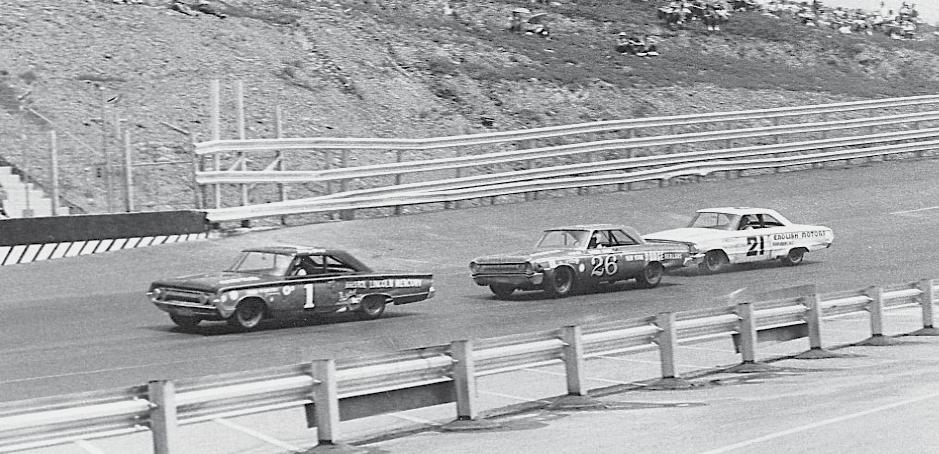
DRIVER: RED BYRON
SPONSOR: PARK’S NOVELTY MACHINE CO.
DRIVERS: BILLY WADE, BOBBY ISAAC, MARVIN PANCH




SPONSORS: BRISTOL LINCOLN MERCURY, DODGE, ENGLISH MOTORS

134 PHOTOGRAPHY: GETTY IMAGES SPONSORS OF THE PAST
A THROWBACK
JOE
lead the way
and

in pursuit. Their cars are sponsored by a local dealership in the Daytona Beach, Florida, area; Air Lift shocks, a nationally known company in the late 1950s; Pure Gasoline, widely known in the South; and Rupert Belts, manufacturer of fan belts and hoses. The sponsors featured were the first automotive companies to support NASCAR racing.
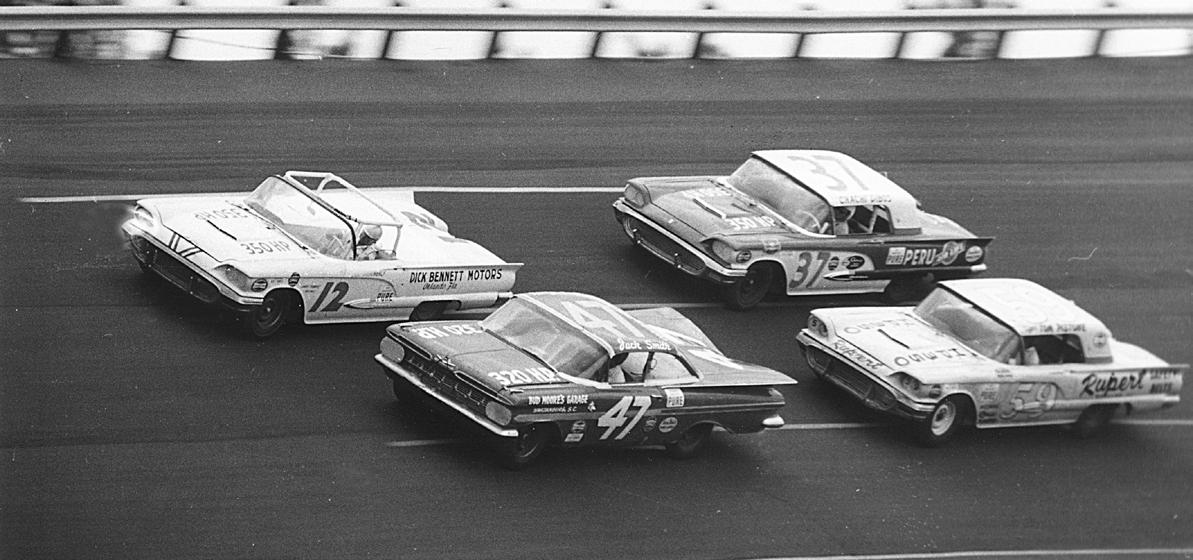
DIn 1968, BOBBY ISAAC sat on pit road at Daytona International Speedway during a break from driving the Nord Krauskopf-owned Dodge, with sponsorship from Krauskopf’s K&K Insurance Co. The insurance business was one of the very first companies to come to NASCAR that was not of an automotive nature. Most sponsorships from the beginning in 1948 consisted of oils, fuels, tires, wiper blades and wheels – items that would service the automotive industry.
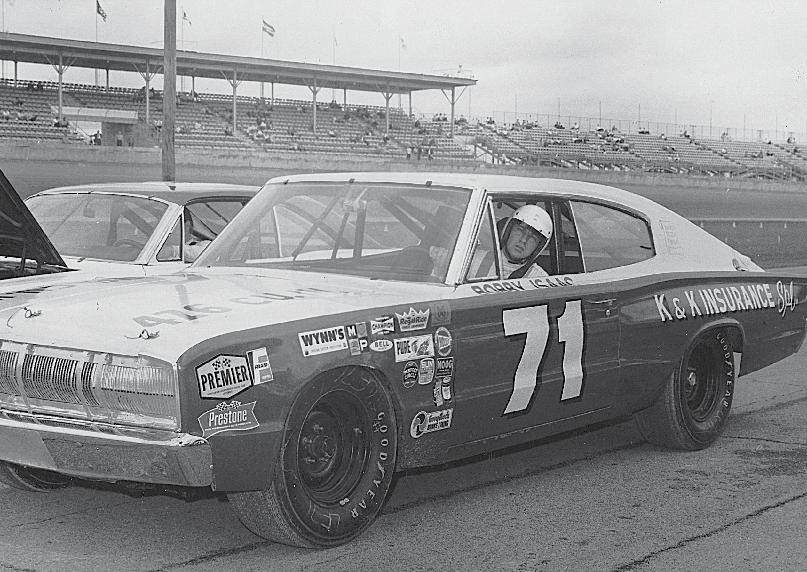 CWEATHERLY (12) and JACK SMITH (47)
with EDUARDO DIBOS (37)
TOM PISTONE (59)
DRIVERS: JOE WEATHERLY, JACK SMITH, EDUARDO DIBOS, TOM PISTONE
SPONSORS: AIR LIFT SHOCKS, PURE GASOLINE, RUPERT BELTS
CWEATHERLY (12) and JACK SMITH (47)
with EDUARDO DIBOS (37)
TOM PISTONE (59)
DRIVERS: JOE WEATHERLY, JACK SMITH, EDUARDO DIBOS, TOM PISTONE
SPONSORS: AIR LIFT SHOCKS, PURE GASOLINE, RUPERT BELTS
135 PHOTOGRAPHY: GETTY IMAGES
DRIVER: BOBBY ISAAC SPONSOR: K&K INSURANCE
SPONSORS OF THE PAST
ECURTIS TURNER’S No. 133 modified entry for beach racing was sponsored by Pure Gasoline as the decal indicates. Turner won 17 Cup Series races during his career. His modified, as well as other cars that raced on the beach, often carried the name of a fuel or lubricant brand that was given to the team in exchange for advertisement on their cars. Hardly ever was money exchanged during the late 1940s and early 1950s.
fTERRY LABONTE wheeled Stratagraph-sponsored cars owned by Billy Hagan from 1978 through 1993. Stratagraph specialized in underwater oil exploration and Hagan used his company to help fund his racing operation, including Labonte’s short-track program that eventually became his early NASCAR Cup Series efforts. The smaller sponsorship led to the 1984 Cup Series championship as well as bigger sponsorships in their later years together. Labonte won a second championship with Rick Hendrick in 1996.
gWENDELL SCOTT, driving his own No. 34 Chevrolet, carries sponsorship for the 1972 Coca-Cola 600 at Charlotte Motor Speedway. The sponsorship came from local businessman Richard Howard, who was also president of the 1.5-mile track in Concord, North Carolina. Not only did Howard own various businesses, he also fielded the No. 12 Chevrolet driven that season by Bobby Allison. Scott, a native of Danville, Virginia, finished 22nd in the 40-car field.


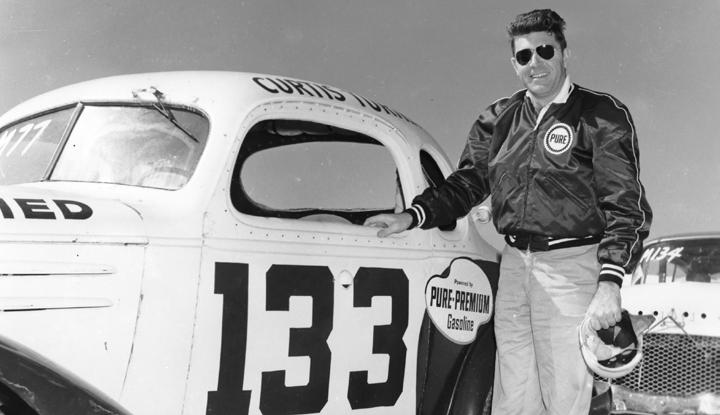
DRIVER: CURTIS TURNER
SPONSOR: PURE GASOLINE
DRIVER: WENDELL SCOTT SPONSOR: HOWARD FURNITURE

DRIVER: TERRY LABONTE
SPONSOR: STRATAGRAPH



136
hD uring a NASCAR modified event in the late 1950s, FIREBALL ROBERTS stands alongside engine builder Ray Fox. Fish Carburetors sponsored the driver and team in both the modified and NASCAR Cup Series divisions that season. Roberts also drove the M-1 Fish Carburetor Buick on the Beach and Road Course at Daytona in 1958, starting seventh and finishing ninth. The carburetor company was very prominent among all racing divisions during that era.
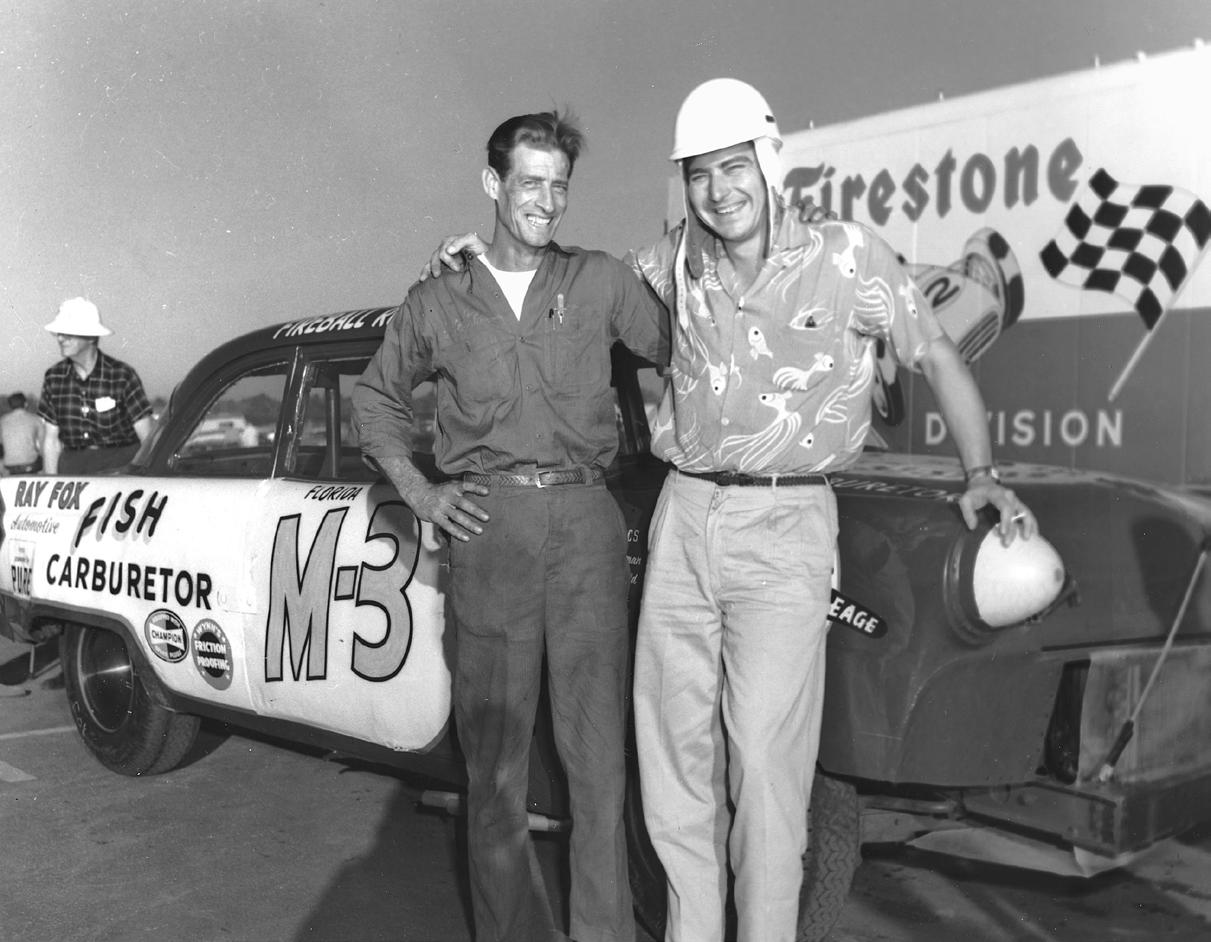
RICHARD PETTY carried sponsorship from Patterson Motors in many of the races during the 1964 NASCAR Cup Series season before major sponsorship came to Petty Enterprises through STP in 1971. Just as many teams did during the early 1960s, major car manufacturers would select dealerships and place their names on the quarter panels of prominent cars when the NASCAR Cup Series drivers would visit various regions of the country.


i
DRIVER: FIREBALL ROBERTS SPONSOR: FISH CARBURETORS
137 PHOTOGRAPHY: GETTY IMAGES
DRIVER: RICHARD PETTY SPONSOR: PATTERSON MOTORS
GONE BUT NOT FORGOTTEN




REMEMBERING SOME OF THE TRACKS THAT HELPED PUT NASCAR ON THE MAP BYKEITHWALTZ


138 GONE BUT NOT
FORGOTTEN
Columbia Speedway


Located just minutes from the South Carolina state capitol, Columbia Speedway was one of NASCAR’s most popular venues during the formative years of professional stock car racing.
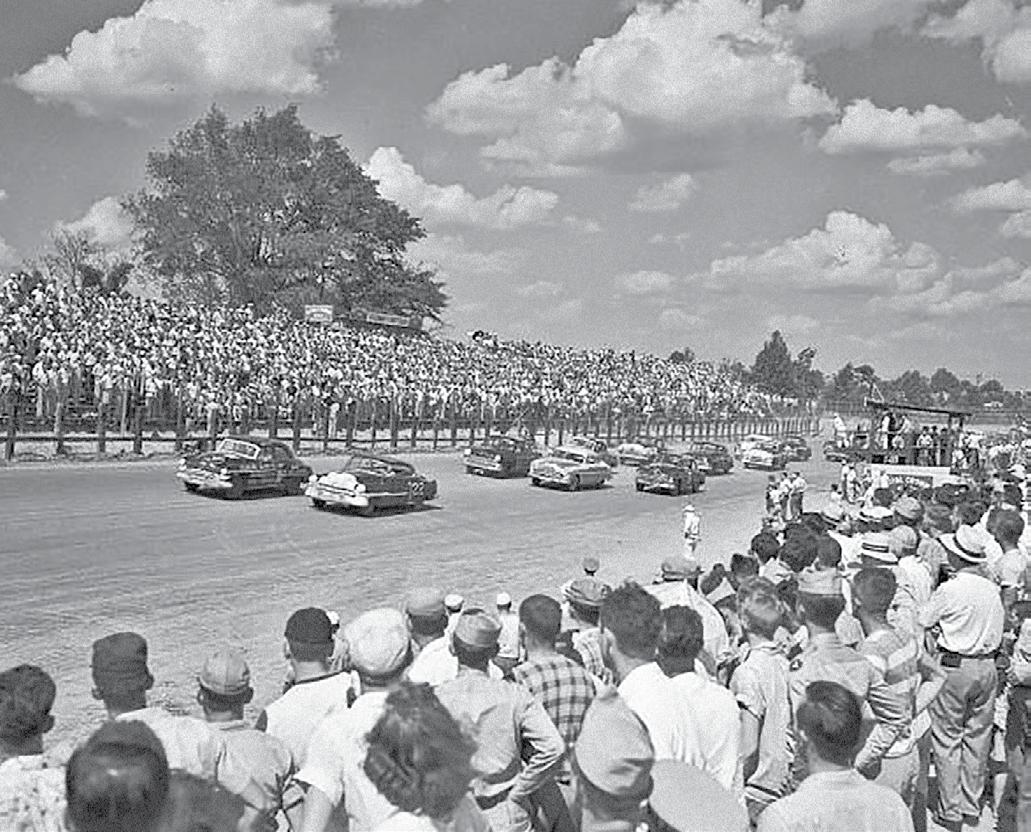
The half-mile dirt track in Cayce, South Carolina, opened in 1948 and hosted the first of its 43 NASCAR Cup Series events on June 16, 1951.

That 200-lap race was dominated by Frank Mundy, who gave Studebaker its first victory in NASCAR’s premier series. In front of 7,750 fans, Mundy started from the pole and led the first 144 laps. He
momentarily lost the point to Jim Paschal, but Mundy retook command on lap 178 and never looked back.
Bill Blair finished second with Marshal Teague third in the 34-car field.
The track was a regular stop for Bill France’s band of traveling racers throughout the 1950s and 1960s. But as NASCAR slowly transitioned to larger paved race tracks, Columbia was left behind even though the racing surface was converted to asphalt prior to the 1971 season.

Richard Petty won the final NASCAR Cup Series race at Columbia Speedway on
Aug. 27, 1971. Driving his familiar No. 43 Plymouth, Petty passed Tiny Lund with 13 laps remaining in the 200-lap race and he beat Lund to the checkered flag by 10car lengths.
Petty tops the list of NASCAR Cup Series winners at Columbia Speedway with seven victories. David Pearson recorded five wins while Buck Baker and Bobby Isaac were four-time winners.
The track was shut down in 1975 and the facility sat idle for more than 30 years before being repurposed into an events and entertainment venue.
139
Lakewood Speedway
Originally known as the “Indianapolis of the South,” Georgia’s Lakewood Speedway hosted its first automobile competition, a match race between Barney Oldfield and Ralph DePalma, in the latter part of 1917.
The treacherous one-mile dirt track was located in the Lakewood area south of Atlanta and was unique in that it was constructed around a lake on the Lakewood Fairgrounds. The track was a hotbed for open-wheel racing for many years before becoming a regular stop on the NASCAR Cup Series schedule during the 1950s.
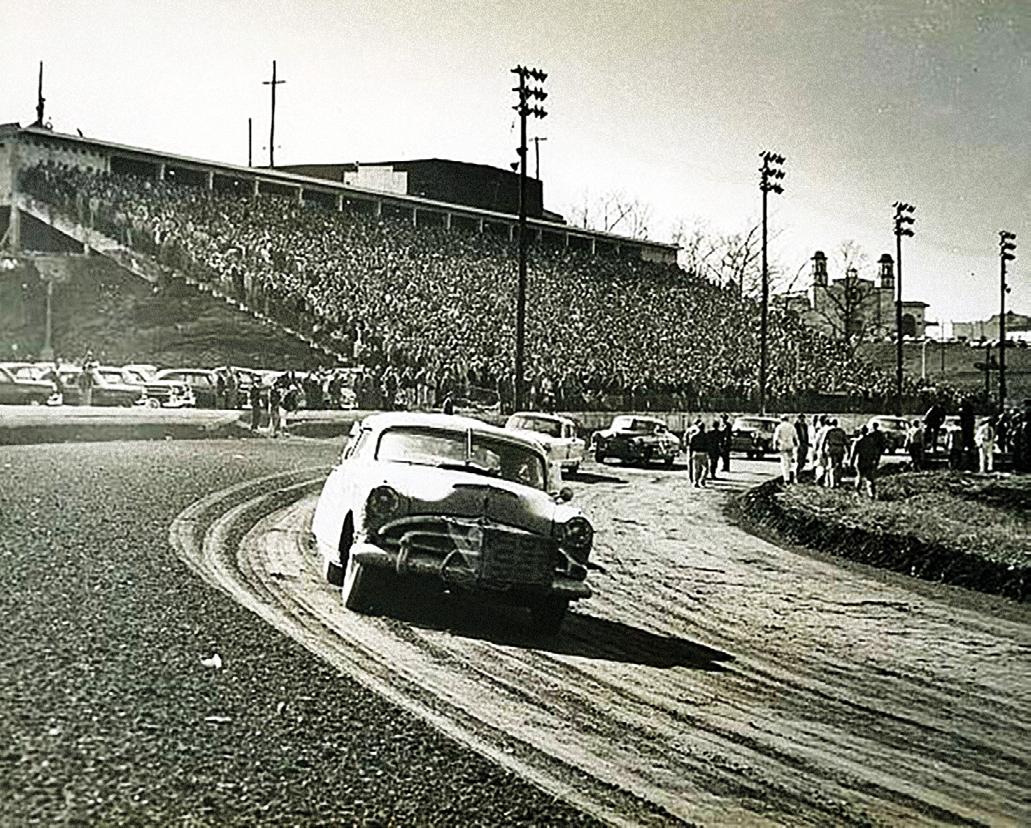
A reported crowd of 26,000 saw Tim Flock
win the inaugural NASCAR Cup Series race at Lakewood Speedway on Nov. 11, 1951. Driving Ted Chester’s 1951 Hudson Hornet, Flock took the lead from his brother, Bob Flock, on lap 14 and led the remainder of the 100-lap race. Bob Flock finished second with Jack Smith third.
The NASCAR Cup Series made a total of 11 visits to the Lakewood track.
The finale on June 14, 1959, featured a strange twist as 21-year-old Richard Petty appeared to have won his first major race. However, the runner-up finisher protested and asked that the score cards



be checked. The runner-up was Petty’s father and teammate, Lee.

Eventually, Lee Petty was declared the winner over his son with Buck Baker settling for third-place money.
Baker and Herb Thomas top the NASCAR win list at Lakewood Speedway with two victories each.
The opening of Atlanta Motor Speedway in 1960 resulted in Lakewood losing its NASCAR dates. The track continued to operate for several years, but fell into disrepair during the 1970s and it closed on Sept. 3, 1979.

140 GONE BUT NOT
FORGOTTEN
TIRE TABLE: When every inch of space in your rig matters, the Tire Table is a must. Great for overlanding, 4-wheeling, camping, going to the beach, hunting, fishing, side-by-sides, or working on your vehicles, It’s endless...

ALL OF THE PERKS OF OWNING A TIRE TABLE:
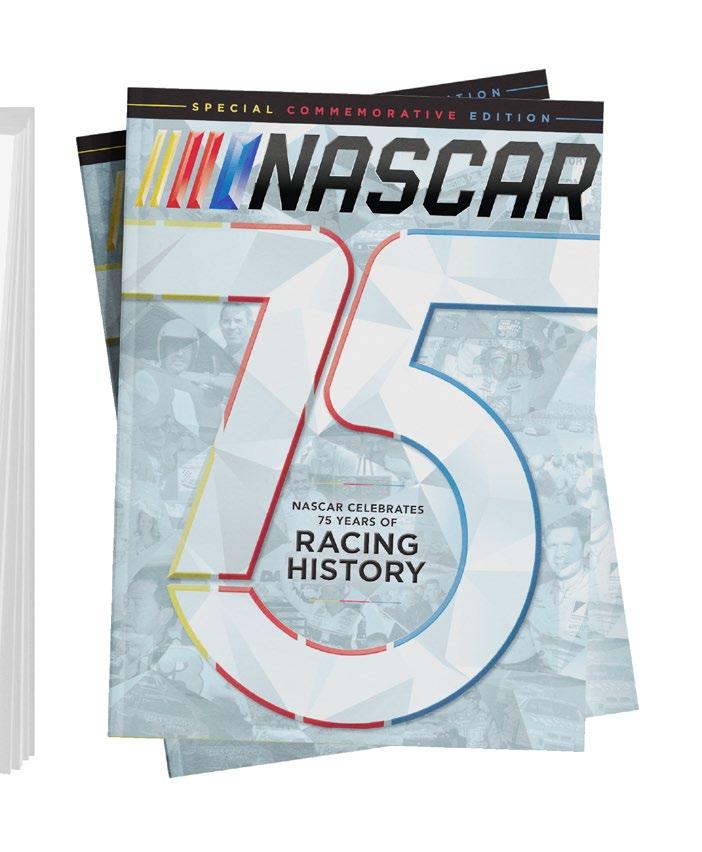
} Stable and level regardless of the ground conditions

} Compact and Durable. Stores flat or sideways without wasting space
} Attaches to any vehicle tire, travel trailer or motor home

} Cantilevers off of the tire. Fits 13” tires & up.
} Steel and aluminum available in 2 sizes
} Steel weighs under 13 pounds and aluminum under 7 pounds
} Has a retractable leg for extra support
} All part are stored on the table
} Holds up to 50 - 70 pounds
BUY IT NOW AT 75yearsofracing.com Reading This Now... Want Your Own Copy? WHERE WILL YOUR NEXT ADVENTURE TAKE YOU!
MEASUREMENTS 29”L x 24”W x 1.5”H or 34”L x 28”W x 4”H Visit TailGaterTireTable.com or call 775.622.8048
Piedmont Interstate Fairgrounds
Spartanburg, South Carolina, was a hub of NASCAR stock car racing during the sport’s formative years, and the half-mile dirt track at the Piedmont Interstate Fairgrounds became a regular stop for the nomadic series

Built in the early 1900s for horse racing, the track’s first stock car race was organized in 1939 by noted promoter Joe Littlejohn. Located only 2.5 miles from downtown Spartanburg, the fairgrounds hosted its first NASCAR Cup Series race on July 4, 1953.
Driving a 1953 Dodge Coronet, Lee Petty led all 200 laps to claim the $1,000 top prize. Buck Baker was second with Herb
Thomas third.




Defending series champion Tim Flock was badly injured in a freak accident prior to the race. Flock and another driver were napping in the infield grass following an overnight drive from upstate New York when a passenger car backed over them.
The NASCAR Cup Series ran 22 races at the Piedmont Interstate Fairgrounds with Elmo Langley winning the finale on June 4, 1966.
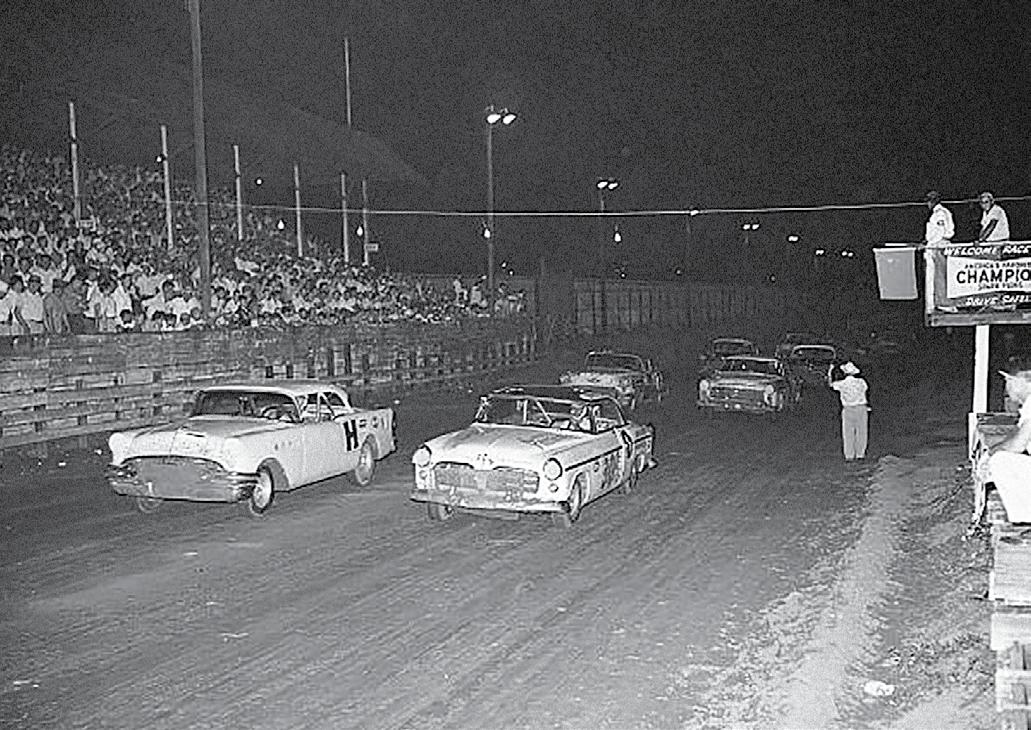
Wheeling a 1964 Ford, Langley took the lead with 40 laps remaining and the 36-year-old racer went on to score the first major victory of his career. Neil Castes
finished second, four laps behind the winner, with Doug Cooper third.
Ned Jarrett was the track’s top winner with six NASCAR Cup Series victories while Lee and Richard Petty each topped three races. Hometown hero Cotton Owens claimed two victories, but David Pearson never visited Victory Lane at the track that hooked him on racing.
After NASCAR moved on, the track continued to host auto racing in conjunction with the fair but that tradition eventually ended. The oval was revived for a charity event in 2002 and that was the last activity of note.
142 GONE BUT NOT FORGOTTEN




Asheville-Weaverville Speedway
Fueled by the popularity of stock car racing in the mountains of western North Carolina, race fans flocked to the NASCAR Cup Series races at AshevilleWeaverville Speedway for nearly two decades.
Opened in 1950, the half-mile dirt oval hosted its first major NASCAR race in 1951, and the action switched to asphalt when the racing surface was paved between the track’s pair of races in 1957.



Driving a 1951 Oldsmobile 88, Fonty Flock led all 200 laps in winning the inaugural NASCAR Cup Series race at Asheville-Weaverville Speedway on July
29, 1951. Gober Sosebee finished second and Herb Thomas was third.


A reported crowd of 8,500 braved threatening weather conditions to watch the race at what organizers billed as the “world’s first drive-in speedway.”
Despite a loyal and passionate fan base, circumstances, including NASCAR’s growth and opposition from a group of local residents, eventually brought an end to racing at Asheville-Weaverville Speedway.
Short-track wizard Bobby Isaac won the facility’s 34th and final NASCAR Cup Series race on Aug. 24, 1969.
Driving a 1969 Dodge, Isaac rallied from

five laps down after running out of gas and beat David Pearson to the checkered flag by four laps to win the 12th annual Western North Carolina 500. Dick Brooks finished third with Elmo Langley and James Hylton rounding out the top-five finishers.
Rex White tops the list of NASCAR Cup Series winners at Asheville-Weaverville Speedway with five victories. Lee Petty and Richard Petty both notched four victories at the track.
Today, the former Asheville-Weaverville Speedway property is the site of North Buncombe High School.
144 GONE BUT NOT FORGOTTEN
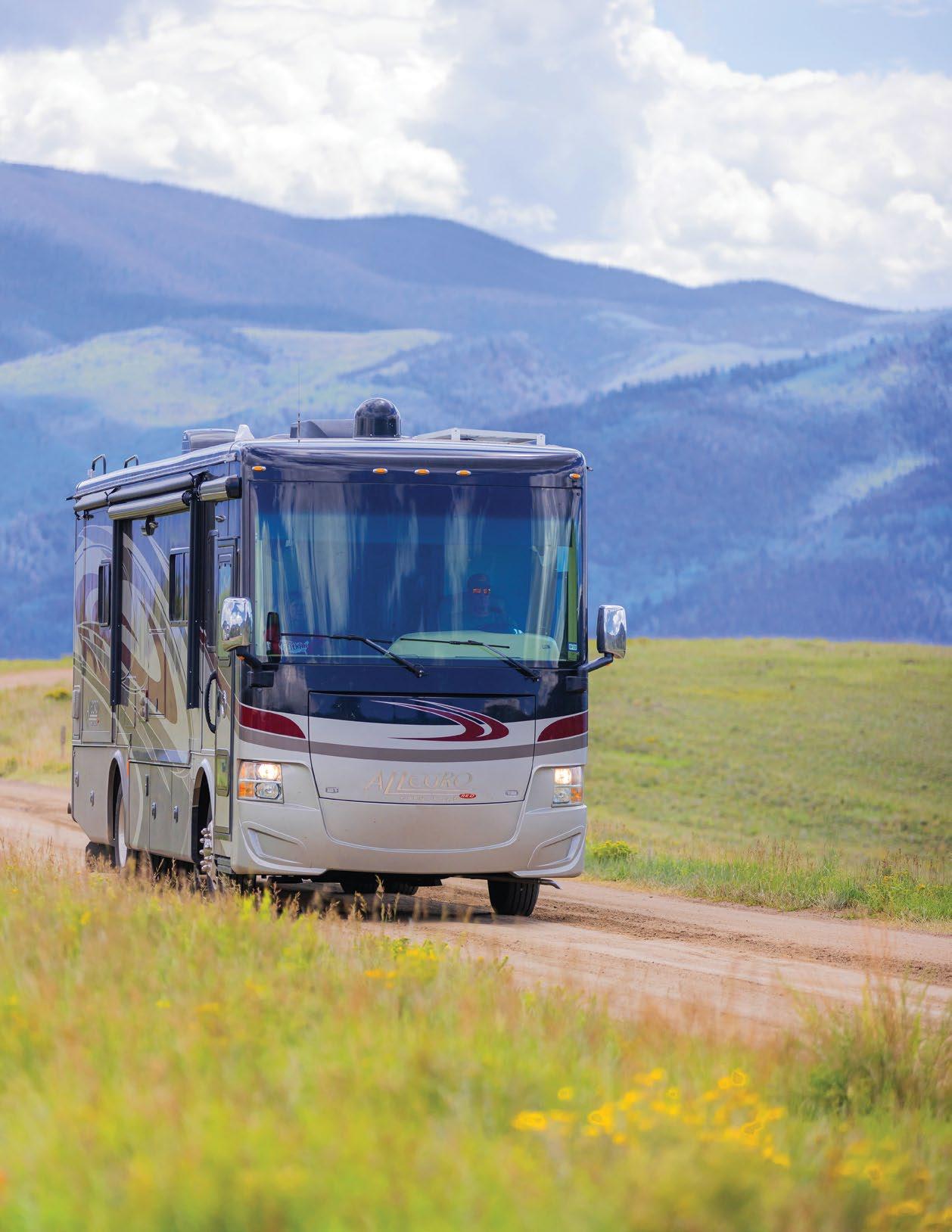


















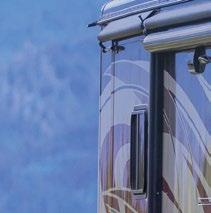


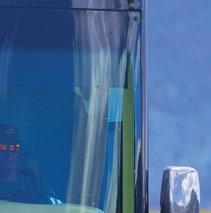































































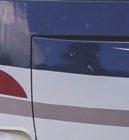






















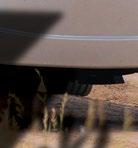



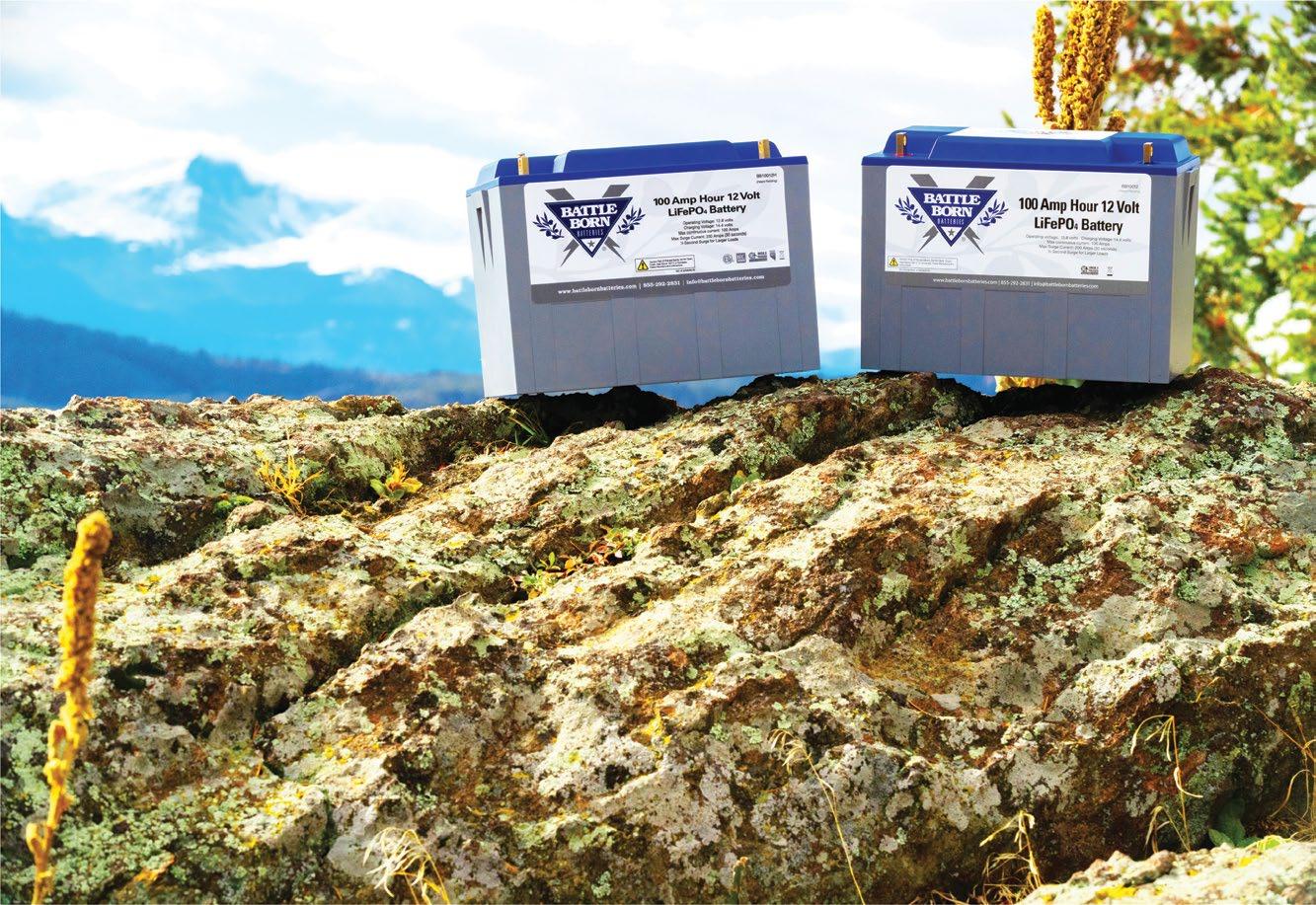
MORE POWER DROP-IN REPLACEMENT
YEAR WARRANTY
2-3X
10
Occoneechee Speedway
Built by NASCAR founder Bill France in 1947, Occoneechee Speedway in Hillsborough, North Carolina, served as a cornerstone of the fledgling sanctioning body for nearly 20 years.
The 0.9-mile dirt track hosted its first NASCAR Cup Series race during the tour’s inaugural season in 1949, and the sport’s stars last traded paint at the legendary facility in 1968.





An estimated 17,500 fans were in attendance on Aug. 7, 1949, when Bob Flock drove his 1948 Oldsmobile to victory in race No. 3 of the Cup Series’ debut season.
Flock averaged 76.8 mph in beating Goober Sosebee and Glenn Dunnaway to the checkered flag.

Occoneechee Speedway hosted 32 NASCAR Cup Series races before increasing opposition to Sunday racing at the track forced it to close. A new paved superspeedway in Talladega, Alabama, eventually took its place on the NASCAR schedule.
Richard Petty was seven laps ahead of James Hylton after 150 miles of racing during the final major NASCAR race at Occoneechee Speedway on Sept. 15, 1978. Petty led 155 of the 167 laps and
spent much of the event battling David Pearson before a blown engine relegated Pearson to 12th in the final rundown.
Buck Baker, Lee Petty and Richard Petty were to the top NASCAR Cup Series race winners at Occoneechee Speedway with three wins each. Eight drivers visited Victory Lane twice at the track.
Today, the track site is on the National Register of Historic Places and it’s maintained by a non-profit organization, The Historic Speedway Group. The site is heavily forested, but the grandstands and much of the track are still visible.
146 GONE BUT NOT
FORGOTTEN
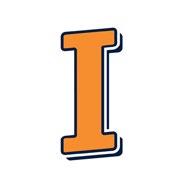











































































































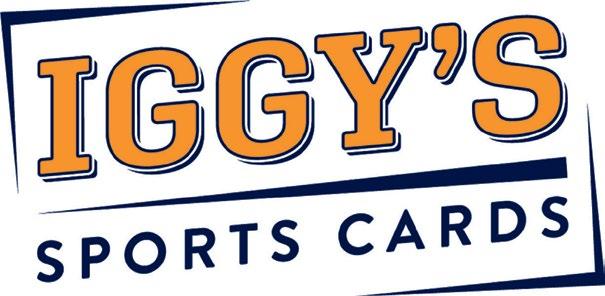


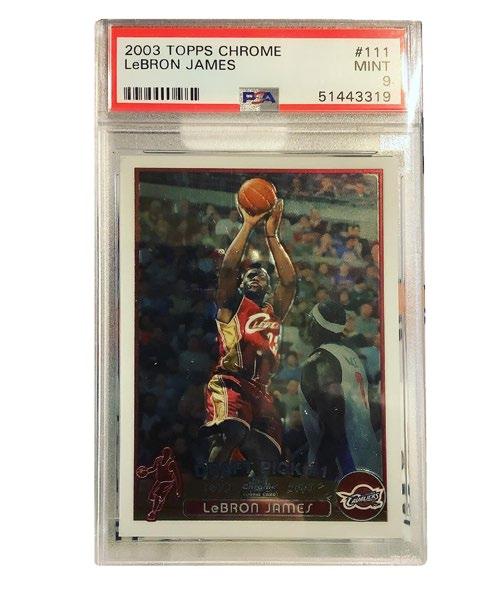
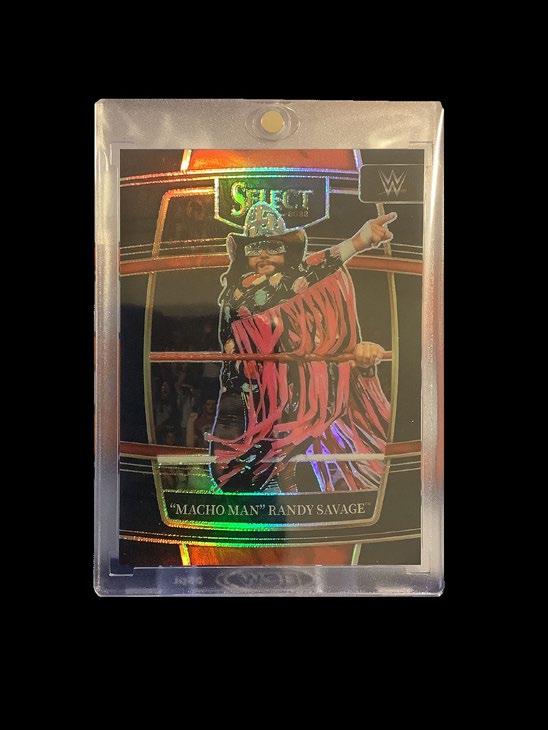
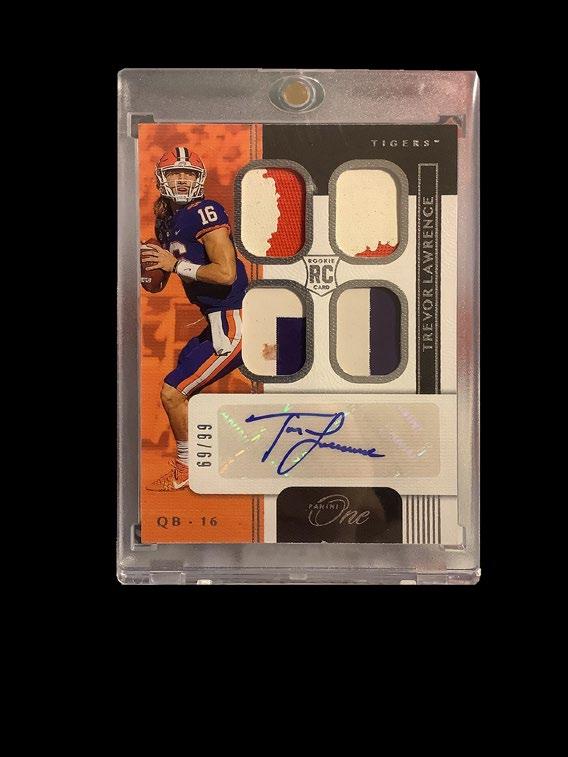
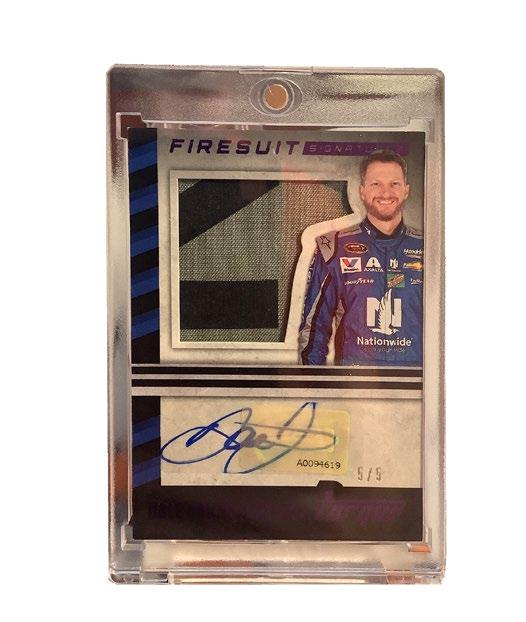
Congrats to NASCAR for 75 Years! WE DO SPORTS CARDS BREAKS ON FACEBOOK, YOUTUBE & TWITCH 4 NIGHTS A WEEK AT 9:30PMest
THEN TO NOW
TELLING THE

 BY JERRY BONKOWSKI
BY JERRY BONKOWSKI
Limited Highlights: Early on, NASCAR was looked at as more of a niche genre that editors believed didn’t warrant regular coverage. As a result, the only major coverage – other than local newspapers – came from edited 15- to 30-minute TV highlight packages shown weekly on programs such as “ABC’s Wide World of Sports” and the “CBS Sports Spectacular.” Larger races such as the Daytona 500 would generate greater coverage, including several laps both at the start and end of the race.
Primarily Print: In the 1940s and 1950s, newspapers were the primary sources of news within the sport, particularly coverage of races at local tracks, as well as various printed publications such as National Speed Sport News. In most cases, writers would type stories on typewriters and then give their written prose to be sent into newsrooms via telecopy machines (predecessors to today’s fax machines). Some newspapers preferred their reporters in the field to dictate their stories word-for-word, but that often proved both laborious and time-consuming.
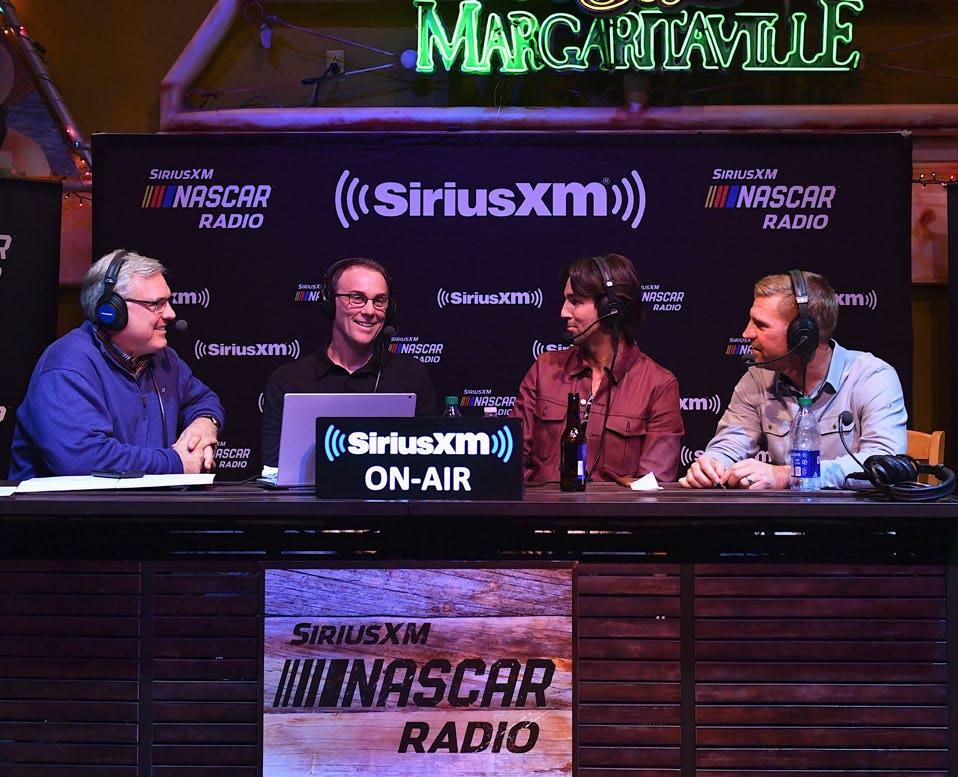
Media coverage of NASCAR racing has had more twists and turns through the years than the road course at Sonoma Raceway.
Here’s a 10-point synopsis of how that coverage has changed.
148 PHOTOGRAPHY: GETTY IMAGES NASCAR MEDIA
FROM
NASCAR STORY
Radio Improves: From NASCAR’s start in the late 1940s until the early 1970s, radio broadcasts of races were a hodge-podge of different local stations in respective markets. Then, NASCAR’s parent company, International Speedway Corp., saw a market opportunity to start its own radio network – Motor Racing Network – in 1971, and it now has more than 400 affiliates that air most Cup, Xfinity and Truck Series races held at NASCAR-owned tracks. Races at Speedway Motorsports facilities are usually covered by that company’s Performance Racing Network.
Live Television: The 1979 Daytona 500 was a game-changer in NASCAR history. Broadcast on CBS, it was the first NASCAR race televised live from start to finish. Roughly half of the country was snowed in due to a massive winter storm, and with only three major over-the-air networks, it made for a captive audience. A major postrace fight among Cale Yarborough and brothers Bobby and Donnie Allison was an added bonus.
Big-Money Contracts: The biggest TV contract to date – a $2.4 billion multi-year deal with FOX, NBC and Turner Sports – began in 2001 and changed the sport forever. FOX aired its first race, the 2001 season-opening Daytona 500, which ended with the tragic death of the sport’s most popular driver, Dale Earnhardt. With Earnhardt gone, the sport lost fans and TV ratings began to drop. However, that didn’t stop two subsequent media contracts, the last of which was worth $8.2 billion and concludes in 2024.
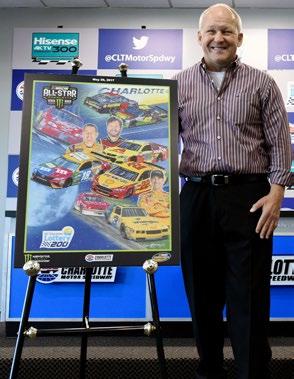

Technical Innovations: Until TV and the internet took over, newspapers and magazines were usually the No. 1 news source for NASCAR fans. The biggest technical innovation began in the late 1980s and into the early 1990s when reporters wrote their stories on portable computers and then transmitted them to their office via telephone modems. It made reporters’ jobs much easier and allowed them to do more with the versatility the computers provided.
Satellite Radio: The advent of satellite radio led to the formation of the SiriusXM NASCAR Radio channel in 2006 and it has become one of SiriusXM’s most popular sports offerings. SiriusXM NASCAR Radio airs all Cup, Xfinity and Truck Series races – typically simulcasting broadcasts from Motor Racing Network and Performance Racing Network – and has nearly 24-hour coverage on talk shows of all things and topics NASCAR-related.

Recession Hits Hard: Because of the Great Recession in 2008 and 2009, a number of media outlets drastically cut back or completely eliminated coverage of NASCAR, including Yahoo Sports, the Gaston (N.C.) Gazette, The Sporting News and even the Daytona Beach News-Journal. That coverage not only has not returned, even more reporters with newspapers, as well as some radio and TV announcers, fell by the wayside in the ensuing years.
Declining Numbers: Faced with a steadily declining number of media in 2008, NASCAR decided to allow fans who blogged or wrote about the sport to become credentialed members of the media. The so-called “citizen journalists” proved problematic with a lack of professionalism as well as oftentimes “journalists” coming to races primarily for the free food and drinks, and writing very little in return. That eventually led to NASCAR quietly rescinding credentials and all but eliminating citizen journalists.
Coverage Goes Online: As newspaper coverage has decreased dramatically and citizen journalists faded from the scene, coverage by online websites has increased significantly, to the point where most of the written coverage of NASCAR is coming from the internet. Not only is the coverage more expedient and immediate, it also has led to several former newspaper writers returning to the sport
• Podcasts and radio shows have connected with the modern NASCAR audience.
• Mike Joy has been a staple in NASCAR as the lap-by-lap voice on FOX for 20 years running.
149 PHOTOGRAPHY: GETTY IMAGES
• Artist Sam Bass was NASCAR’s first officially licensed artist. His work on various paint schemes (including Dale Earnhardt and Jeff Gordon), race program covers, and original paintings helped convey the speed and colors of stock racing to a national audience.
NASCAR Memorabilia: Every Piece Has a Story
BY DUSTIN ALBINO
Throwback shirts, hats, die-cast cars, pins and more are the focal point of NASCAR collectibles. Some are valued much higher than others, but all vintage NASCAR gear is cool in its own right.
It’s not uncommon to see a NASCAR jacket enter pop culture, with celebrities often repping Jeff Gordon’s Rainbow Warriors jacket, or even a podcast host wearing a Davey Allison T-shirt. While all are collector’s items, some limited-edition memorabilia is much harder to find.
Other artifacts honor NASCAR in different ways. There have been several marquee moments in the sport’s history, and looking back, people will do whatever it takes to secure memorabilia from a specific event. Think of the 1979 Daytona 500.

With a blizzard blanketing much of the eastern United States, additional eyeballs were on television sets that weekend. The Great American Race was being broadcast on CBS, and it happened to be the first live, flag-to-flag television coverage of a major NASCAR event.
Richard Petty won the Daytona 500 that year, which turned out to be the final of his seven Cup Series championship seasons. But the bigger story was the spectacular post-race fight. While battling for the lead coming to the checkered flag, Donnie Allison and Cale Yarborough traded paint for a chunk of the backstretch before wrecking in Turn 3.
When their cars came to rest on the apron, both drivers exited their respective vehicles and threw punches. The phrase, “And there’s a fight” from the legendary announcer Ken Squier was heard and is still played more than 40 years later. Donnie’s brother, Bobby Allison, also entered the fracas after getting hit in the nose by Yarborough’s helmet.
Earlier that week, at an event in Daytona Beach, Florida, Lamar Harris, a former car owner who raced against the Allisons before they got their start in NASCAR, was given pit passes for Speedweeks by Bill Gazaway, NASCAR’s director of racing operations at the time.
According to Harris’ grandson, Matt Harris, who wasn’t born for another three years, the package included pit passes to the 125-mile qualifying races, the NASCAR 200 modified race, the Daytona 300 and,


most importantly, the Daytona 500. Harris also received paddock parking for the Daytona 500.
After a full day at the track that included time with Donnie Allison, Lamar returned to his hotel on the beach and suffered a heart attack. He died at just 54 years old.
The pit passes went unused as the Harris family packed up and returned to their hometown of Anniston, Alabama, a stone’s throw from Talladega Superspeedway.
It wasn’t until 2016, after Matt’s father Tim passed away, that Matt knew about the history that was sitting in his father’s dresser. And while Matt isn’t a huge collector of NASCAR memorabilia, these are items he will keep forever.

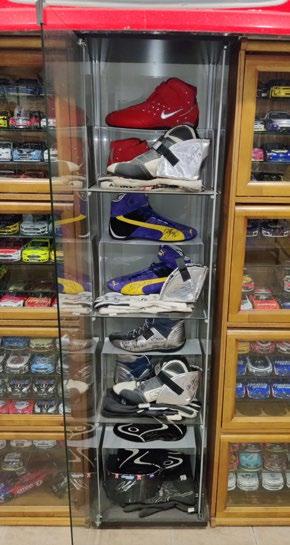
“I have a little bookshelf in my living room where I keep all of my cool little (memorabilia),” Matt Harris said. “I display them and am proud of it. It’s a part of who I am. I have it out there for people to see.”
And that’s not all. Matt Harris owns more collector’s items, including old ticket stubs and multiple NASCAR rulebooks. He also has his grandfather’s NASCAR pins from the 1960s.
Meanwhile, Iowa native and now Texas resident Larry Newbrough collects just about anything and everything he can get his hands on.
In the late 1990s, Newbrough got hooked on NASCAR via the NASCAR Racing Papyrus computer game that he got at his school’s book fair. He wasn’t an avid collector prior to 2014, when he had roughly a dozen die-cast cars. Now, he owns north of 700 die-casts, all of which are 1:24 scale, with many custom pieces. He believes his total spent is between $30,000 and $40,000.
150 NASCAR COLLECTIBLES
Off the top of his head, Newbrough’s favorite die-cast car in is collection is Dale Earnhardt’s wrecked car from the 1997 Daytona 500. While running among the contenders, Earnhardt flipped down the backstretch late in the race after contact from Dale Jarrett. After originally getting in an ambulance to head to the infield care center, Earnhardt jumped out and climbed back into his famed No. 3 Chevrolet to finish the race.
Over the years, Newbrough has had his share of favorite drivers, but currently it’s Brad Keselowski. He has a winning die-cast car from all 35 of Keselowski’s Cup Series victories; and even some from his Xfinity Series wins.
Going back through the history of collecting die-cast cars, Newbrough notes that finding scales from the Car of Tomorrow era is difficult. And should you find one of the winged cars, a lot of them are “super expensive.”
Aside from die-cast cars, Newbrough enjoys collecting sheet metal, with his first piece coming in 2007 off the center section of one of Carl Edwards’ noses in the Xfinity Series. His interest in collecting sheet metal stems back to 2002, when his family spent 11 days in Daytona for Speedweeks. And though he recalls it being hard to find sheet metal back then, when you did, it was “crazy cool.”
“They had all kinds of conferences going on with drivers going around at different places,” Newbrough said of his 2002 experience. “(My brother and I) went and saw they had auctions for sheet metal and they had Dale Earnhardt’s bumpers and everything like that. We just never in our lives thought we would be able to get any of it.
“Back then, it was so rare for things to get out because they didn’t scrap the body
on every single car every week and hang a new body on it, so there wasn’t an abundance of sheet metal that got out. The stuff that did get out was crazy expensive. So we thought we would never get any of this stuff.
“Neither of us smoke or drink, so we’ve got to spend our money on something. There could be worse things. I play golf and collect memorabilia.”
Newbrough, who is a production manager and graphic designer at a Fast Signs in Texas, believes he’s spent roughly $80,000 on his sheet metal collection. He typically purchases the sheet metal through The Racing Warehouse or RaceDay Authentics in North Carolina. His favorites include rear bumpers from Tony Stewart, Jamie McMurray and Dale Earnhardt Jr., as well as the No. 55 door from when Mark Martin drove numbers that looked like a Boston Marathon bib in 2013.

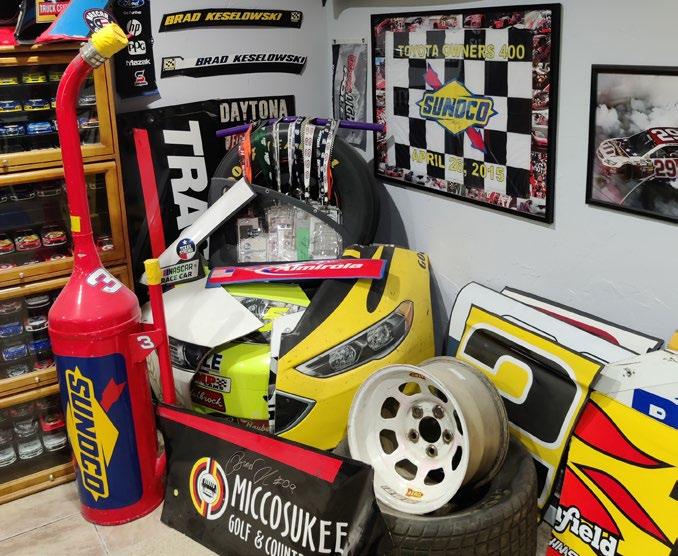
Once Martin retired, Stewart became Newbrough’s favorite driver. And he has a whole section of Stewart collectibles, including a signed visor, gloves, a foam-padded headrest and one of the pit crew helmets from Stewart’s Bass Pro Shops car. Oh yeah, he also owns a pair of Stewart’s race-used shoes from the early 2000s, which is pretty high on his list of favorite items he owns.
Recently, Newbrough purchased Michael McDowell’s pink window net from the 2022 Charlotte ROVAL race through Kurt Busch’s Window of Hope program. The program raised more than $100,000 for the second year in a row.
“The pink window net is pretty cool because I’ve had family members that have passed away from cancer,” Newbrough said. “So there’s more meaning with that one.”
Some of Newbrough’s other prized possessions include a signed pair of Dale Jarrett shoes, a pair of David Ragan shoes with the heat shields, as well as shoes from Kenny Wallace and David Gilliland. He also owns gloves from Clint Bowyer, Jeff Burton and Elliott Sadler. Aside from a race-used Goodyear tire from the inaugural Bristol dirt race, he purchased all of his collectibles.
There’s only one problem for Newbrough: He’s running out of room to store for his hobby.
“It’s good that I have enough stuff to fill all this space, but it’s bad that I don’t have enough space for it,” he said.
Currently, he stores the majority of his purchases in what was a two-car garage. He also dubbed one of his rooms as the “American room” in his house, so anything that comes off a car that is red, white and blue goes in there.
NASCAR collectibles will always be a habit for many race fans. And some of them have fascinating stories behind them.
151
NASCAR LEGENDS




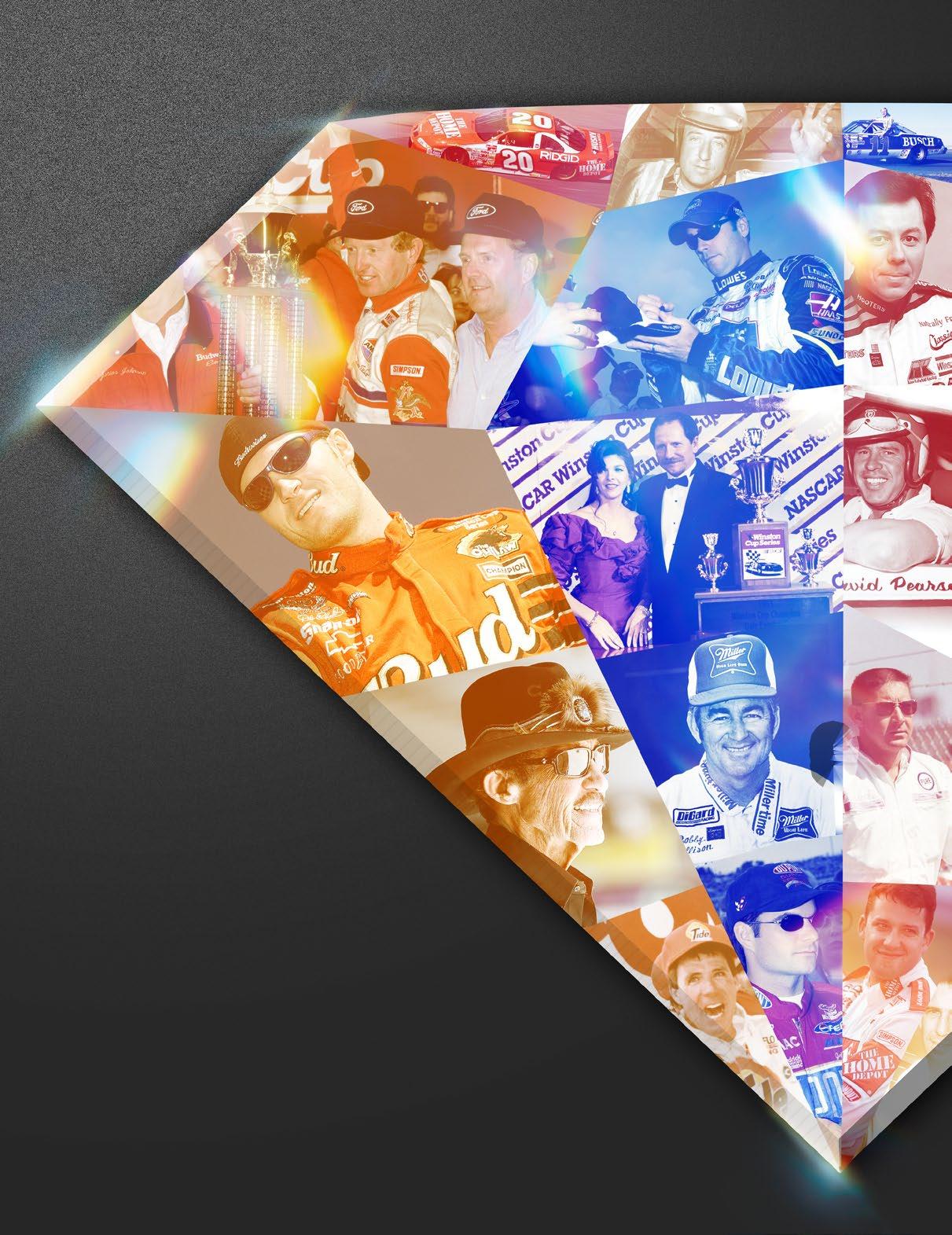 WRITTEN BY RACING HISTORIAN BEN WHITE
WRITTEN BY RACING HISTORIAN BEN WHITE

 EDITED BY KEITH WALTZ
EDITED BY KEITH WALTZ

152 NASCAR LEGENDS
Richard Petty
Richard Petty entered his first NASCAR race at Canadian Exposition Stadium in Toronto, Ontario, on July 18, 1958, at age 20. Over 35 seasons, the seven-time NASCAR Sprint Cup Series champion recorded an incredible 200 career victories.
Born in Level Cross, North Carolina, on July 2, 1937, Petty is the older of Lee and Elizabeth Petty’s two sons. His father worked in the mills, farmed cotton and even sold moonshine before discovering NASCAR at age 35 in 1949. He was the first racer to make a living driving in NASCAR competition.
Young Richard and his cousin, Dale Inman, serviced Lee Petty’s Plymouth as teenagers after school. During many late nights, they turned wrenches on the family’s racing machine while Petty’s brother, Maurice, kept the engines running at full song.
Richard Petty helped his father win NASCAR championships in 1954, 1958 and 1959 before focusing on his own driving career. The second-generation speedster scored his first NASCAR victory on Feb. 28, 1960, at the Southern States Fairgrounds in Charlotte, North Carolina. In 1964, he won his first of seven Daytona 500s and first of seven championships. Other titles followed in 1967, 1971, 1972, 1974, 1975 and 1979.

Petty’s final victory came at Daytona International Speedway on July 4, 1984. All told, his 555 top-five finishes, 712 top-10 results and 123 pole positions chronicle the greatest success story in NASCAR history.
Petty’s 1,184th and final start came at Atlanta Motor Speedway on Nov. 15, 1992, where he finished 35th after being caught up in a crash.
Since then, Petty has fielded cars for many of the sport’s top drivers while also serving as NASCAR’s greatest ambassador. He is one of the most recognized icons in all of professional sports.
BEST SEASON
IN 1967, PETTY ENJOYED HIS GREATEST SEASON with 27 victories in 48 Cup Series starts. Driving the famed 1966 Petty blue No. 43 Plymouth, his triumphs included a string of 10 in a row that began on Aug. 12 at Bowman Gray Stadium in Winston-Salem, North Carolina, and continued through Oct. 1 at North Carolina’s North Wilkesboro Speedway.
43
RECORD SETTER
PETTY’S SEVEN DAYTONA 500 VICTORIES AND seven championships as a NASCAR driver and team owner best define his career. Many of his accomplishments still stand as records and it is widely believed that no one will ever reach the 200-win milestone that tops his list of untouchable records.
QUIET TALENTED INSIGHTFUL DEDICATED PATIENT
KNOWN FOR
THROUGHOUT A CAREER THAT SPANNED FROM 1958 to 1992, Petty was one of the NASCAR’s most popular drivers, winning the Most Popular Driver Award from the National Motorsports Press Association nine times. He had a reputation for signing autographs for every fan requesting one, even after winning 500-mile races.
My name is beside all those wins, but it’s not just about Richard Petty. So many people have worked countless hours and contributed so much to all that success. It’s not about me.
153
–RICHARD PETTY
Dale Earnhardt

Dale Earnhardt was determined to follow the driving career of his father, 1956 NASCAR Sportsman champion Ralph Earnhardt. The seemingly impossible career path he set in motion is one of the greatest success stories in all of professional sports.

While racing on some of North Carolina’s most noted short tracks following his father’s death in 1973, Earnhardt struggled mightily to fund his racing operation. He often borrowed money from a local bank on Thursday to race that weekend. Payments had to be made the following Monday without fail. So Earnhardt had to race hard and had to win. Drivers were often left fuming when the checkered flag fell.
Beginning in 1975, four NASCAR Cup Series starts for Ed Negre, Johnny Ray and Walter Ballard helped Earnhardt make an impression at stock car racing’s highest level. His best ride materialized with five events for team owner Rod Osterlund in 1978 and a full schedule of races for the California businessman in 1979, the year he won Rookie of the Year honors with a victory at Bristol, 11 top-five finishes and 17 top-10 results. The next season, Earnhardt stunned the racing community by winning his first of seven Cup Series championships in Osterlund’s Chevrolet. When the team was sold to J.D. Stacy in 1981, Earnhardt exited with 10 races remaining and joined former Cup Series driver Richard Childress.
After parting ways for two seasons, they reunited in 1984 and created one of the greatest dynasties in NASCAR history. Six of Earnhardt’s seven Cup Series titles and 67 of his 76 victories came while driving for Childress, including the 1995 Brickyard 400 at Indianapolis Motor Speedway and the 1998 Daytona 500.
Earnhardt lost his life in a crash on the final lap of the 2001 Daytona 500. His contributions to the sport he so dearly loved are considered immeasurable.
ANYTIME

SAVVY CHAMPION INTIMIDATING VICTORIOUS FOCUSED
BEST SEASON

THE YEAR (1987) EARNHARDT won his third Cup Series championship, the Kannapolis, N.C., native logged 11 victories, 21 top-five finishes, 24 top-10 results and one pole position for team owner Richard Childress. Earnhardt led 3,354 of 9,043 total laps that season with an average finish of 5.9 during the 29-race schedule.
RECORD-SETTER
EARNHARDT IS THE ONLY driver to win the Cup Series Rookie of the Year title and the Cup Series championship in successive years (1979 and 1980). A second championship came in 1986, followed by five more titles in 1987, 1990. 1991, 1993 and 1994. Earnhardt finished second in points during his final full season in 2000.
THE NO. 3 CAR
KNOWN FOR DURING A CAREER THAT spanned from 1975 to the season-opening Daytona 500 in 2001, Earnhardt was one of the most aggressive drivers in NASCAR history. A member of the inaugural NASCAR Hall of Fame Class in 2010, he is recognized as an icon among the sport’s greatest drivers.
YOU GET THE OPPORTUNITY TO WIN A RACE, YOU’RE GOING TO WIN THE RACE.
I AM NEVER GOING TO BACK OFF. I NEVER WANT TO RUN SECOND.
3 154 NASCAR LEGENDS



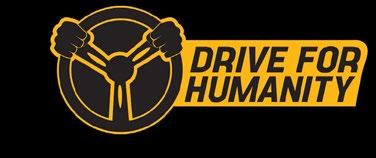

RACING TO STOP HUNGER & HOMELESSNESS GIVING BACK THROUGH LIFE-CHANGING EXPERIENCES. SCAN THE QR CODE TO LEARN MORE AT DRIVEFORHUMANITY.ORG >>>>>> AUTO REPAIR VIN STICKERS IS A PROUD SPONSOR OF BRAYTON LASTER “THE P IZZA MAN ” 317-413-1169 • autorepairvinstickers.com Make sure your vehicle can pass all DOT inspections. DON’T WAIT UNTIL ITS TOO LATE! WILLIAMSBURG CONTRACTING IS A PROUD SPONSOR OF RYAN VARGAS W: WILLIAMSBURGCONTRACTING.COM E: WILLIAMSBURGCONTRACTING@GMAIL.COM PROUDLY SERVING HAMPTON ROADS, VIRGINIA
Jimmie Johnson
Jimmie Johnson excelled throughout a 20-year NASCAR Cup Series career that included 83 victories. He also joined Richard Petty and Dale Earnhardt as the series’ only seven-time champions.
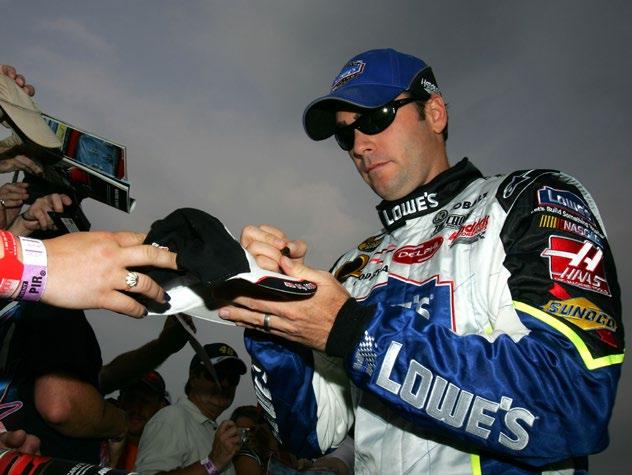
Born Sept. 17, 1975, in El Cajun, California., Johnson began racing motorcycles when he was 5 years old. Offroad racing followed and led to a chance meeting with Herb Fishel, head of motorsports at General Motors during the early 1990s.
Johnson’s short-track success opened the door for him to eventually drive for Cup Series team owner Rick Hendrick.
Johnson began racing in the American Speed Association series in 1998, having made only six starts in a full-bodied race car before taking on his new role. He was fourth in points by season’s end and was crowned rookie of the year.
From there, the aspiring star joined the NASCAR Xfinity Series. In 2000, Johnson raced the full Xfinity Series for Herzog Motorsports, finishing 10th in points. He notched his first and only Xfinity Series victory in 2001 at Chicagoland Speedway.
That same season, Johnson joined Hendrick Motorsports for three Cup Series races after becoming friends with four-time NASCAR champion Jeff Gordon.
Johnson was then paired with crew chief Chad Knaus and they developed a magical chemistry for success. Starting in 2002, their on-track success established Johnson as one of NASCAR’s greatest drivers. He retired from Cup Series competition in 2020.
BEST SEASON
DURING THE 2007 SEASON, JOHNSON LOGGED 10 victories with six coming on superspeedways and four on short tracks, including four in a row near season’s end. His second Cup Series championship season also featured 24 top-10 finishes in 36 starts. He held the championship point lead through the final three races.
RECORD SETTER
JOHNSON WILL BE BEST KNOWN FOR COLLECTING seven NASCAR Cup Series championships while competing under several different championship point systems. Even though he didn’t make the playoffs in his final season (2020), he will be remembered as one of the sport’s most talented racers in its most competitive era.
KNOWN FOR

THROUGHOUT 20 YEARS OF CUP SERIES RACING, Johnson was known as a smooth driver who rarely became agitated in the heat of battle. His ability to perform quietly under extreme pressure gave the impression of having a soft nature. Still, success through seven championships and 83 Cup Series victories tells his story.

48
DEDICATED CALM TALENTED SMART DETERMINED
My bucket is full. NASCAR has been so wonderful for me. This journey has been more than I could have ever dreamed of or expected or hoped for.
156 NASCAR LEGENDS
–JIMMIE JOHNSON









Rex White
Rex White entered his first NASCAR Cup Series race on Feb. 26, 1956, on the Beach and Road Course in Daytona Beach, Florida. Amazingly, he finished 22nd among the 80 drivers in the starting field.
Born Aug. 17, 1929, in Taylorsville, North Carolina, White left school as a teen and moved to the Washington, District of Columbia, area where he found work as a cook and later as an attendant at a gas station.
In 1951, a race promoter placed a placard in the window of the station advertising races at West Lanham (Maryland) Speedway. With no money to buy a ticket, White sneaked into the pits and loved what he saw.
He eventually began working for 1952 NASCAR Modified champion Frankie Schneider but decided to leave to pursue his own racing career, initially picking up a ride here and there. In 1954, he bought a 1937 Ford and began winning on numerous short tracks in the Northeast.
His success led to joining the Cup Series ranks in 1956 where he logged many impressive finishes. White’s first-career NASCAR premier series victory came at North Carolina’s Asheville-Weaverville Speedway on June 9, 1958, while driving for Julian Petty. The following year, White fielded his own Chevrolets and collected five wins that season.
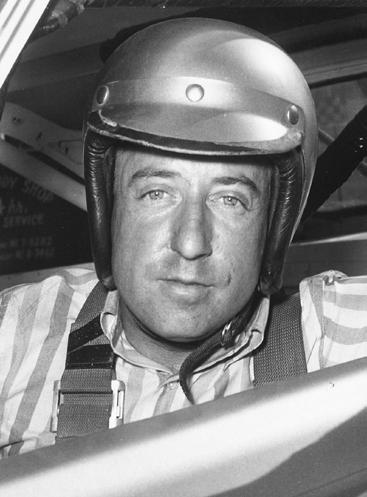
Then in 1960, White recorded six more wins, finishing among the top 10 in 35 of 40 races and claimed the championship over Richard Petty by almost 4,000 points.

White scored 28 NASCAR Cup Series victories before retiring in 1964. The 2015 NASCAR Hall of Fame inductee is listed among NASCAR’s 50 Greatest Drivers and is also a member of the International Motorsports Hall of Fame, the National Motorsports Press Association Hall of Fame and the Georgia Racing Hall of Fame.
WITTY QUIET APPRECIATIVE ADVANTAGEOUS AGGRESSIVE HONORED


BEST SEASON
WHILE HEADING TOWARD the 1960 NASCAR Cup Series championship, White earned six wins, 25 top-five finishes, 35 top-10 results and three pole positions. He was a threat to win everywhere he raced, setting the foundation for scoring his lone Cup Series championship. White was the underdog against the top teams.
RECORD-SETTER
WHITE’S AVERAGE START of 8.1 and average finish of 9.0 is considered to be an impressive statistic. From 1956 to 1964, he completed 48,512 laps and led 4,370. Twentyseven of his 28 victories came on short tracks with one superspeedway victory coming in October 1962 at Atlanta Motor Speedway.
KNOWN FOR WHITE WAS SHORT IN stature but strong behind the wheel of his famed No. 4 gold-and-white Chevrolets. His ability to adapt to cars and make them finish better than intended gave him a reputation as a skilled driver. Team owners asked but he liked driving his own cars.
THE NO. 4 CAR
ONCE I SAW THE CARS ON THE TRACK, I KNEW THAT WAS FOR ME. I WORKED HARD AND FOUND A WAY TO DO IT. I’M STILL AMAZED ABOUT WHAT WE ACCOMPLISHED.
4 158 NASCAR LEGENDS



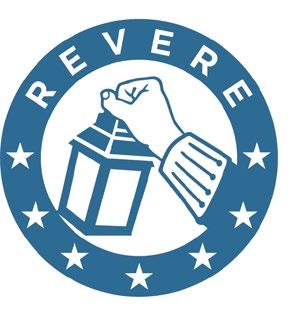
CONGRATS NASCAR ON 75 YEARS OF RACING HQ: 39555 Orchard Hill Place Novi, MI 48375 W: rpsystems.com P: 833.300.4043 NOW HIRING Scan the QR Code to Apply now
Junior Johnson
Junior Johnson won 50 NASCAR Cup Series races, the most by any driver who never claimed a series title. The biggest victory of his Hall of Fame career came in the 1960 Daytona 500.
Born June 28, 1931, in Ronda, North Carolina, the fourth of seven children, Johnson’s family was known for being heavily involved in the illegal whiskey business since the 1800s.
His father, Glenn Johnson, was a lifelong bootlegger and spent more than half his life in prison for making and selling moonshine. The Johnson homeplace was frequently raided by revenue agents.
Junior Johnson began helping with the family business as a youngster. He also spent one year in an Ohio prison in 1956 for having an illegal still but was never caught hauling moonshine on mountain roads throughout North Carolina.
Johnson’s racing career was just beginning when he went to prison. During his first full season in 1955, he won five races and finished sixth in points. Over the next 10 years, Johnson logged 45 additional victories, including the 1960 Daytona 500, which he won driving a car owned by John Masoni and prepared by Raymond Fox.
Johnson’s victories included 11 superspeedway triumphs and 39 short-track wins. He retired from driving in 1966 and forged a second career as a car owner at NASCAR’s highest level.
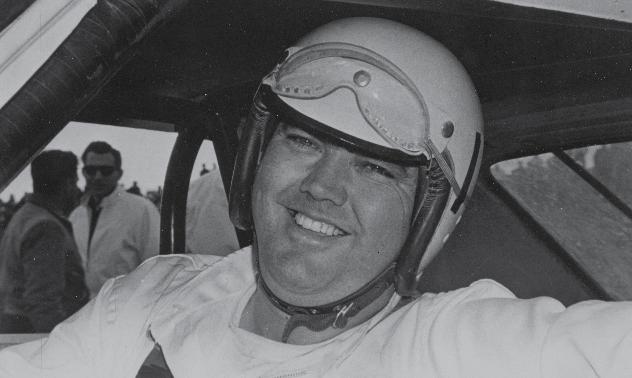
Johnson was instrumental in bringing R.J. Reynolds Tobacco Co. to NASCAR as a series sponsor, saving the sport in 1971.
From 1967 through 1995, Johnson’s teams earned six NASCAR Cup Series championships with drivers Cale Yarborough and Darrell Waltrip, as well as 132 Cup Series victories over a 30-year period with a variety of drivers. Johnson died on Dec. 19, 2019, at the age of 88.
BEST SEASON
JOHNSON LOGGED 13 OF HIS 50 NASCAR CUP Series wins during the 1965 season. His biggest victory that year came on May 8 at Darlington Raceway. Johnson was the driver to beat during the 54-race season, notching 18 top-five finishes while driving a Ford he fielded himself.
RECORD SETTER
AS A DRIVER IN NASCAR, JOHNSON COMPLETED 51,988 laps and led 13,021 of them. His highest rank in the points was seventh in 1955, his third year of NASCAR competition. His highest season in winnings came in 1960 – the year he won the Daytona 500 – when he banked $38,989.
KNOWN FOR

HIS PAST LIFE AS A MOONSHINE RUNNER IN Wilkes County, North Carolina, added to the lore of outlaw turned racer and drew fans to the tracks to watch him drive. When Johnson retired from driving and became a car owner, he looked for wheelmen who were as fearless as he was.

11
“I certainly feel that I gave a lot more to stock car racing than I took away from it.”
–JUNIOR JOHNSON
LASER-FOCUSED
DRIVEN DEDICATED STRONG-WILLED 160 NASCAR LEGENDS
TALENTED

The Spirited Story of Stock Car Racing and Down-Home Distilling Discover North Carolina’s NEW Moonshine and Motorsports Trail and experience our state’s history of perseverance and innovation like never before.
Tony Stewart


Tony Stewart won 49 NASCAR Cup Series races as well as series championships in 2002, 2005 and 2011. His biggest victories came in the Brickyard 400 at Indianapolis Motor Speedway in 2005 and 2007.
Stewart set his sights on winning at an early age. He captured his first gokart championship in 1980 and earned a World Karting Association title seven years later.
Stewart was named USAC’s rookie of the year in 1991 and he won the USAC National Midget Series championship in 1994.
In 19995, Stewart became the first driver to win USAC’s version of the Triple Crown, earning championships in all three of the sanctioning body’s major divisions – Sprint Cars, Midgets and Silver Crown. His victories in the Hut Hundred and 4-Crown Nationals were the highlights of the year.
The Columbus, Indiana, native made his NASCAR Xfinity Series debut in 1996, driving for car owner Harry Rainer. In the 1997 Indianapolis 500, Stewart led 64 laps and finished fifth. He went on to win the 1997 IndyCar Series championship. A year later, Stewart ran a majority of the Xfinity Series events for team owner Joe Gibbs. In 1999, he collected his first Cup Series victory at Richmond International Raceway, becoming the first rookie driver to win in NASCAR’s premier series since Davey Allison in 1987.
Stewart remained with JGR through 2007, recording 32 race wins and Cup Series championships in 2002 and 2005. Then, he and businessman Gene Haas formed Stewart-Haas Racing in 2008 and claimed 17 additional victories and the 2011 Cup Series title. He was the first driver-team owner since Wisconsin native Alan Kulwicki in 1992 to win a Cup Series championship.
Stewart was inducted into the NASCAR Hall of Fame in 2020.
ADAPTIVE HEADSTRONG OUTSPOKEN AGGRESSIVE TALENTED
BEST SEASON
WHEN HE NEEDED TO SHINE his brightest, Stewart won three of the final four races in 2011, leading to his third-career Cup Series championship. The Columbus, Indiana, native tied Carl Edwards of Roush Fenway Racing in championship points but won the title by virtue of race wins with five to Edwards’ one.
RECORD-SETTER
DURING HIS NASCAR CUP Series career, Stewart logged 49 wins, 308 top-10 finishes and 15 pole positions. He is the most successful driver to move from open-wheel racing to stock cars. Others have made the move but only Stewart won championships in both IndyCar and NASCAR racing.
KNOWN FOR

THROUGHOUT HIS driving career, Stewart was one of motorsports’ very best and displayed a signature determination all his own. However, if ever he felt he had been wronged by other drivers on the track or the sanctioning body, Stewart never shied away from speaking his mind.

RACE CARS, NO MATTER
WHAT SIZE OR SHAPE THEY ARE, THEY DO THE SAME THINGS. IT IS NOT COMPLICATED.
20 162 NASCAR LEGENDS
Congrats Nascar on 75 Years!





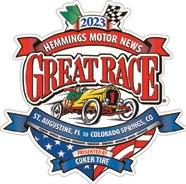
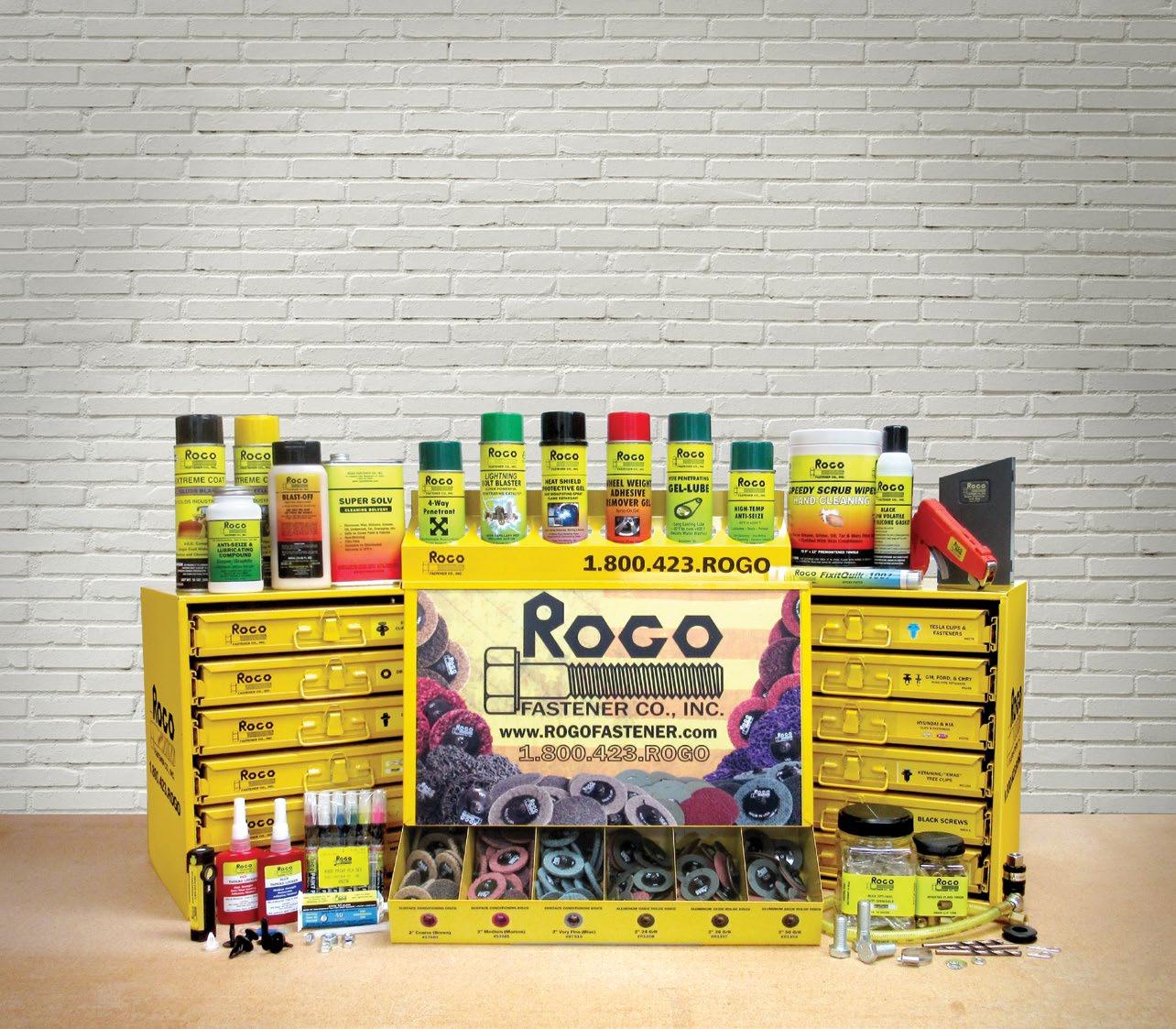
ESTABLISHED 1992
Bill Elliott
Bill Elliott began his driving career on the north Georgia dirt tracks near his home in Dawsonville. He won 44 Cup Series races from 1976 to 2012, logging 320 top-10 finishes and 55 pole positions.
Born Oct. 8, 1955, Elliott began driving makeshift race cars in his father’s junkyard against the likes of his brothers, Ernie and Dan. Of the three siblings, Bill emerged with the most desire and talent to drive cars on a local level.
Success on short tracks in the Southeast led to an eight-race NASCAR Cup Series effort in 1976 aboard a Ford owned by his father, George. Over the next seven seasons, the fledgling family team entered 71 races, recording eight top-five finishes, nine top-10 results and earning one pole.
At the start of the 1983 season, the Elliott family sold its team to Michigan businessman Harry Melling and collected their first Cup Series victory in the season finale at California’s Riverside International Raceway. Three wins in 1984 set the stage for a phenomenal 1985 season that featured 11 victories, including the 1985 Daytona 500 as well as the Winston Million bonus paid by R. J. Reynolds Tobacco Co. for winning three of the four premier races on the schedule.
Elliott collected 18 additional victories as well as the 1988 Cup Series championship before leaving Melling Racing in 1991 to join Junior Johnson and Associates. After seven victories and a second-place finish in points through 1995, Elliott started his own team but did not break into the win column.
Elliott eventually joined forces with former crew chief and upstart team owner Ray Evernham. Together, they won three times, including the 2001 Brickyard 400. Elliott retired from the Cup Series in 2012.
BEST SEASON
DURING THE 1985 SEASON, ELLIOTT ENTERED 28 Cup Series races and won 11 times, with superspeedway victories coming at Daytona, Talladega, Dover, Atlanta (2), Darlington (2), Pocono (2) and Michigan (2). Elliott logged 16 top-five finishes and 18 top-10 results with an average start of 4.9 and average finish of 8.7.
RECORD SETTER
IN QUALIFYING FOR THE 1985 DAYTONA 500, Elliott posted a record pole speed of 205.114 mph. Then, on May 5, 1985, he turned another record lap of 209.398 mph at Talladega Superspeedway. Finally, on May 3, 1987, Elliott ran 212.809 mph at Talladega, a record that may never be broken.

DEDICATED BELOVED FOCUSED INNOVATIVE DETERMINED
KNOWN FOR

THROUGHOUT HIS NASCAR CAREER, ELLIOTT enjoyed a tremendous fan following. Even though he hasn’t driven in NASCAR competition for nine years, he was part of this summer’s six-race Camping World SRX Series. He occasionally works as a spotter for his son, defending Cup Series champion Chase Elliott.

9
I feel the experience that I gained working on the race cars helped me immensely and really made me understand them a lot more.
164 NASCAR LEGENDS
–BILL ELLIOTT

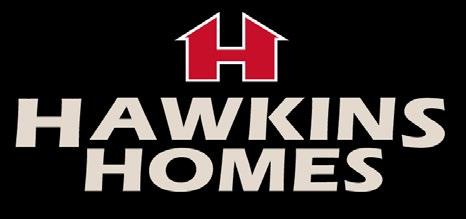


CONGRATS NASCAR ON 75 YEARS Serving the Clarksville, TN area for over 29 Years One of the fastest growing cities in the nation! At Hawkins Homes, we know what discerning homebuyers expect, and every day we strive to deliver homes of solid quality and value. We work to construct homes that will fit each client. Contact us to learn more about our home options: P: (931) 647-3902 W: hawkinshomes-llc.com A: 1865 Old Trenton Road Clarksville, TN 37040
Cale Yarborough

Having grown up just miles from the storied 1.366-mile superspeedway, Cale Yarborough entered his first NASCAR race at South Carolina’s Darlington Raceway on Sept. 2, 1957. Yarborough went on to claim three series championships and 83 victories in 560 starts.
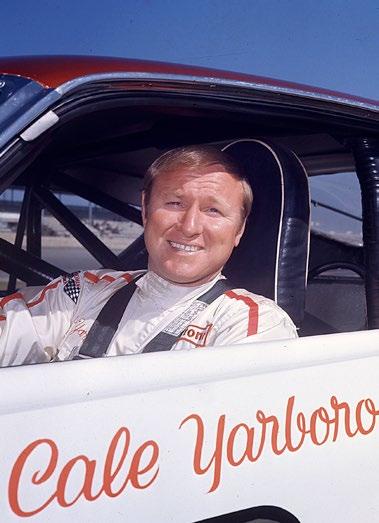
Born in Timmonsville, South Carolina, on March 27, 1939, Yarborough is the oldest of three boys born to Julian and Annie Yarborough. His family made their living through owning a local store and farming tobacco and cotton. After his father died in a private plane crash during the late 1940s, young Cale began working hard to help his mother manage the family business.
Yarborough famously slipped under a fence to see the inaugural Southern 500 at Darlington Raceway in September 1950 at age 11. He began his fledgling driving career with one event in 1957. Seven years later in 1965, Yarborough logged his first NASCAR Sprint Cup Series win at Georgia’s Valdosta Speedway for team owner Kenny Myler. The victory shifted his career into high gear, prompting several of the sport’s iconic team owners, such as Banjo Matthews, Glen Wood, Junior Johnson, M.C. Anderson and Harry Ranier, to hire him as their driver.
While driving for Johnson from 1973 through 1980, Yarborough collected 55 of his 83 Cup Series victories and championships in 1976, ’77 and ’78, becoming the first driver to win three consecutive titles in NASCAR’s premier series.
Yarborough also drove Indy cars with limited success in 1971 and 1972 for team owner Gene White. He made two starts in the Indianapolis 500, finishing 16th in 1971 and 10th the following year.
In addition to his racing, Yarborough engaged in various business ventures, including his longstanding Honda dealership in Florence, South Carolina. His present-day passion is his 4,000-acre farm and a six-acre lake he built himself at age 76.
QUIET TOUGH SMART DETERMINED STRONG PATIENT
BEST SEASON
IN 1978, THE YEAR OF Yarborough’s third Sprint Cup Series championship, he logged 10 victories, 23 top-five finishes, 24 top-10s results and claimed eight pole positions while driving for Junior Johnson. He also enjoyed a 10-win season four years earlier in 1974 in Johnson’s famed No.11 Chevrolet.
RECORD-SETTER
ONE OF YARBOROUGH’S greatest accomplishments as a NASCAR driver came on March 25, 1973, during the Volunteer 500 at Bristol Motor Speedway. While driving for team owner Richard Howard, he miraculously led every lap of the 500-lap race and logged his 15th of 83 series victories.
KNOWN FOR

DURING A CAREER that spanned 31 years, Yarborough was considered to be one of the sport’s toughest and most determined drivers. He had a reputation for driving cars to better positions than expected, giving his very best effort during every lap of the race.
 THE NO. 11 CAR
THE NO. 11 CAR
I’VE BEEN BLESSED TO HAVE ENJOYED A VERY SUCCESSFUL NASCAR CAREER, BUT I DEFINITELY DIDN’T DO IT ON MY OWN. I HAD SOME GREAT PEOPLE HELP ME ALONG THE WAY.
11 166 NASCAR LEGENDS
Rusty Wallace

Rusty Wallace entered his first NASCAR Cup Series race on March 6, 1980, at Atlanta Motor Speedway, driving for team owner Roger Penske. The newcomer proved he possessed a great deal of driving talent.
Born in Fenton, Missouri, on Aug. 14, 1956, Wallace began racing on short tracks in his home state as a teenager.
Prior to joining the NASCAR circuit, Wallace won more than 200 short-track events as he found himself racing from Florida, where he claimed a pair of local track championships, to Wisconsin, where he routinely won races sanctioned by the American Speed Association.
In 1979, Wallace was named rookie of the year with the United States Auto Club’s stock car division after finishing third in points behind A.J. Foyt and Bay Darnell. Two years later, he finished second in the USAC stock car championship standings behind eventual NASCAR driver Joe Ruttman.
Wallace finally collected an elusive ASA title in 1983, topping a star-studded field that included future NASCAR wheelmen such as Mark Martin, Alan Kulwicki and Dick Trickle.
From 1980 to 1983, Wallace entered only nine NASCAR Cup Series races. The following year, he joined the Cup Series circuit full time, driving for Cliff Stewart, and earned rookie-of-the-year honors.
He joined Raymond Beadle’s Blue Max operation in 1986 where he won 18 times over five seasons and claimed the 1989 Cup Series championship. Wallace returned to Team Penske in 1991 and won 37 more races before retiring in 2002.
After stepping out of the cockpit, Wallace spent some time as a NASCAR Xfinity Series team owner and he has more recently served as an analyst for television and radio coverage of NASCAR races. He was inducted into the NASCAR Hall of Fame in 2013.
BEST SEASON
DURING THE 1989 NASCAR CUP SERIES SEASON, Wallace managed to log six victories, 13 top-five finishes, 20 top-10 results and four pole positions in Pontiacs owned by drag racing legend Raymond Beadle. By season’s end, he bested Dale Earnhardt by only 12 points to secure his lone Cup Series championship.
RECORD SETTER
WALLACE’S AVERAGE START OF 13TH AND AVERAGE finish of 14th is considered enough to produce a consistent winning effort. From 1980 to 2002, he led 19,995 of the 204,818 laps he completed. Twenty four of his 55 victories came on short tracks with 26 on superspeedways and five on road courses.
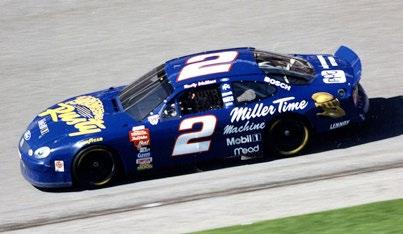
KNOWN FOR
ALWAYS A TOUGH COMPETITOR, WALLACE WAS KNOWN for his ability to put his cars up front on a variety of track configurations, especially short tracks. He was also a consistent championship contender, finishing among the top-five in points seven times and the top-10 on 17 occasions.
2
I am honored to have enjoyed such an awesome career in NASCAR. I am so thankful to my team owners and crews for helping to make my dream come true.”
–RUSTY WALLACE
167
Richard Childress
Richard Childress entered 285 NASCAR Cup Series races as a driver, logging 76 top-10 finishes during 12 seasons before claiming series championships in 1986, ’87, ’90, ’91, ’93 and ’94 as a team owner.
Childress was born in Winston Salem, North Carolina, on Sept. 21, 1945, one of nine children raised by Alice and Joseph Childress. He was introduced to stock car racing by selling concessions at Bowman Gray Stadium in his hometown during the early 1960s. While taking breaks from walking through the grandstands selling peanuts, popcorn and soft drinks, Childress would watch such stars as Junior Johnson, Ned Jarrett and Rex White, to name a few, as they raced on the quarter-mile track.
A few years later, Childress bought his own race car for a mere $20 and began his driving career in the Street Stock division at Bowman Gray Stadium. He worked his way through the ranks before coming to NASCAR in 1969.
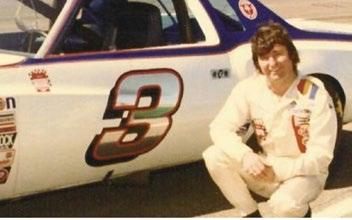
He entered 285 Cup Series races without going to Victory Lane but recorded six top-five finishes and 76 top-10 results. Many of those finishes came in cars supported by CRC Chemicals, Childress’ primary sponsor during his best years as a driver in 1979 and 1980.
After starting 20 Cup Series races in 1981, Childress elected to step away from the driver’s seat. NASCAR was quickly becoming a rich man’s game and he needed help. His final start as a driver came in the 1981 Talladega 500.
Expenses continued to rise, prompting Childress to make the decision to retire and place Dale Earnhardt in the car. Earnhardt went on to collect 67 of his 76-career wins with Childress as well as six of his seven Cup Series championships.
WINNER DETERMINED SUCCESSFUL TALENTED SAVVY
BEST SEASON

DURING THE 1975 CUP Series season, Childress logged two top-five finishes and 15 top-15 results. His average start was 16.9 and average finish was 12.6 with his best finish being a fourth at Martinsville Speedway on Sept. 28, 1975. There was also a string of five top-10 finishes that fall.
RECORD-SETTER
THE 2017 NASCAR HALL of Fame inductee was a respected driver in NASCAR’s top level of competition. All told, Richard Childress Racing has celebrated more than 50 years of racing and earned more than 200 victories and 16 overall championships in the top levels of NASCAR competition.

KNOWN FOR RACE FANS RESPECT HIM because he came from very humble beginnings. In 1969, he made his move into NASCAR at Talladega Superspeedway in the Grand American division at Talladega Superspeedway and used his winnings to buy his first race shop. RCR now has many divisions with hundreds of employees.
 THE NO. 3 CAR
THE NO. 3 CAR
I HAD SOME GREAT FINISHES DURING MY DRIVING CAREER. HAD I HAD JUST A LITTLE BIT MORE LUCK, I COULD HAVE GONE TO VICTORY LANE MANY TIMES.
3 168 NASCAR LEGENDS
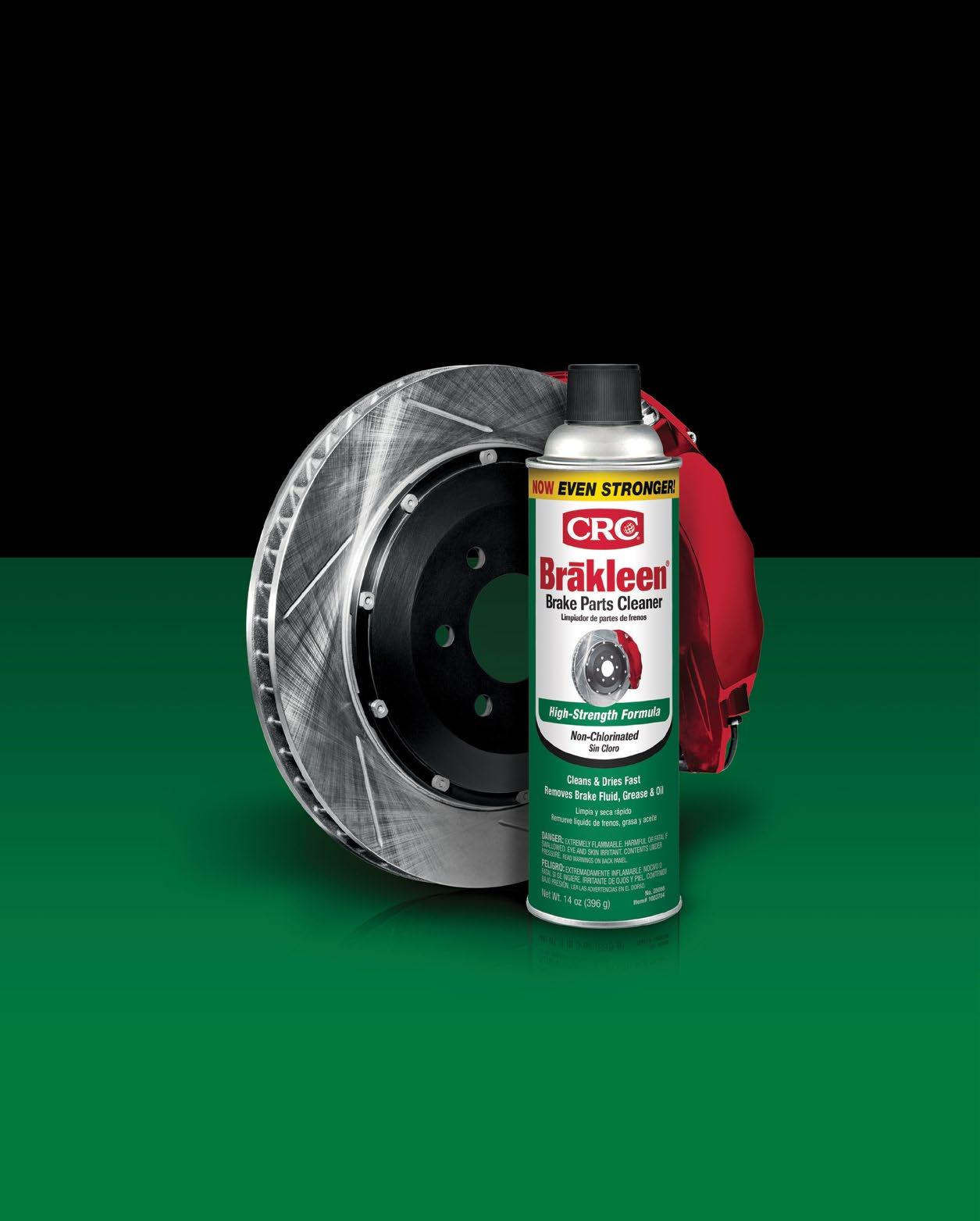

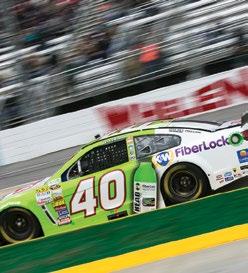










crcindustries.com
in celebrating a long, rich history of racing and offering
top-performing products.
CRC Industries joins NASCAR
fans
Lee Petty
Lee Petty drove his own Oldsmobiles and Plymouths to NASCAR championships in 1954, 1958 and 1959 and recorded 54 victories throughout a 16-year career. His accomplishments include 332 top-10 finishes and 18 pole positions.
Born March 14, 1914, in Randleman, North Carolina, Petty spent time working in local mills around Randolph County to support his wife and two sons. However, he longed to drive race cars and eventually became the first NASCAR racer to make a living as a stock car driver.
His winnings of $7,695 in 1950 would be equivalent to more than $83,000 today. Still, there were cars and equipment to buy as well as travel expenses for himself and his crew.
Petty’s biggest victory came in the inaugural Daytona 500 in February 1959 after a three-day review of the finish. Johnny Beauchamp was initially crowned the race winner, but NASCAR officials later determined Petty had crossed the finish line first. He received his trophy and check in his living room days after the race had ended.
Petty was severely injured at Daytona in 1961, leaving him hospitalized for two months. After his recovery, he ran sporadically on short tracks before his retirement from driving in 1964.

From there, Petty turned his attention to building Petty Enterprises. The team eventually earned 11 championships and 268 NASCAR Cup Series victories.
Lee Petty passed away in 2000 at age 86 due to an abdominal aneurysm.
I FIGURE YOU GET OUT OF LIFE WHAT YOU PUT INTO IT.
–LEE PETTY
BEST SEASON
42
DURING THE 1959 NASCAR CUP SERIES SEASON, Lee Petty won 11 of the 42 races he entered. Of those wins, 10 came on short tracks with one lone superspeedway win coming in the prestigious Daytona 500. Petty amassed 27 top-five results while failing to finish only eight races that year.
RECORD SETTER
ASIDE FROM HIS ABILITY TO WIN ON ALL TYPES OF track configurations, Petty enjoyed a reputation for getting the most performance out of his race cars. His career average start of ninth and average finish of seventh made him one of the most consistent NASCAR drivers during the 1950s.
DETERMINED FOCUSED INNOVATIVE STRONG DEDICATED
KNOWN FOR

ASIDE FROM A SUCCESSFUL CAREER AS A THREEtime NASCAR champion, Petty was able to build a powerhouse organization utilizing the talents of iconic drivers and mechanics that led to 11 championships and 268 victories. Son Richard Petty logged 198 of his 200 victories under Lee Petty’s steady guidance and direction.

170 NASCAR LEGENDS
CLASH AT THE COLISEUM
SUN | FEB 5 | 8 PM | FOX
DUEL AT DAYTONA
THU | FEB 16 | 7 PM | FS1
DAYTONA 500

SUN | FEB 19 | 2:30 PM | FOX
AUTO CLUB
SUN | FEB 26 | 3:30 PM | FOX
LAS VEGAS
SUN | MAR 5 | 3:30 PM | FOX
PHOENIX
SUN | MAR 12 | 3:30 PM | FOX
ATLANTA
SUN | MAR 19 | 3 PM | FOX
COTA
SUN | MAR 26 | 3:30 PM | FOX
RICHMOND
SUN | APR 2 | 3:30 PM | FS1
BRISTOL DIRT
SUN | APR 9 | 7 PM | FOX
MARTINSVILLE
SUN | APR 16 | 3 PM | FS1
TALLADEGA
SUN | APR 23 | 3 PM | FOX
DOVER
SUN | APR 30 | 2 PM | FS1
KANSAS
SUN | MAY 7 | 3 PM | FS1
DARLINGTON SUN | MAY 14 | 3 PM | FS1
NORTH WILKESBORO (ASR)
SUN | MAY 21 | 8 PM | FS1
CHARLOTTE SUN | MAY 28 | 6 PM | FOX
WWTR SUN | JUN 4 | 3:30 PM | FS1
SONOMA SUN | JUN 11 | 3:30 PM | FOX
NASHVILLE SUN | JUN 25 | 7 PM | NBC
CHICAGO STREET RACE SUN | JUL 2 | 5:30 PM | NBC
ATLANTA SUN | JUL 9 | 7 PM | USA
NEW HAMPSHIRE SUN | JUL 16 | 2:30 PM | USA
POCONO SUN | JUL 23 | 2:30 PM | USA
RICHMOND SUN | JUL 30 | 3 PM | USA
MICHIGAN SUN | AUG 6 | 2:30 PM | USA
INDIANAPOLIS RC
SUN | AUG 13 | 2:30 PM | NBC
WATKINS GLEN
SUN | AUG 20 | 3:00 PM | USA
DAYTONA
SAT | AUG 26 | 7:00 PM | NBC
DARLINGTON*
SUN | SEP 3 | 6:00 PM | USA
KANSAS*
SUN | SEP 10 | 3:00 PM | USA
BRISTOL
SAT | SEP 16 | 7:30 PM | USA
TEXAS*
SUN | SEP 24 | 3:30 PM | USA
TALLADEGA*
SUN | OCT 1 | 2:00 PM | NBC
CHARLOTTE ROVAL*
SUN | OCT 8 | 2:00 PM | NBC
LAS VEGAS*
SUN | OCT 15 | 2:30 PM | NBC
HOMESTEAD-MIAMI*
SUN | OCT 22 | 2:30 PM | NBC
MARTINSVILLE*
SUN | OCT 29 | 2:00 PM | NBC
PHOENIX*
SUN | NOV 5 | 3:00 PM | NBC
ALL RACE TIMES IN ET | *PLAYOFF RACES
Jeff Gordon
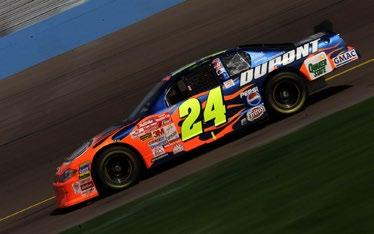

Jeff Gordon entered his first NASCAR Cup Series event on Nov. 15, 1992, at Atlanta Motor Speedway. It was the beginning of a career that featured some of the greatest accomplishments in NASCAR’s modern era.
24
Born Aug. 4, 1971, in Vallejo, California, Gordon’s formative years were spent building a very successful career as an open-wheel Midget and Sprint Car driver. Even though he dreamed of joining the Indy Car ranks, an opportunity to drive in NASCAR proved to be a fateful decision.
The rising star came to stock car racing in 1990 in what is now the NASCAR Xfinity Series. During the 1992 season, he claimed three victories and a fourthplace finish in the series standings while driving a Ford owned by Bill Davis.
That same year, Gordon joined team owner Rick Hendrick in NASCAR’s premier series, making his debut during the season finale. He earned rookieof-the-year honors in 1993 and two years later, in 1995, Gordon became the youngest driver in the modern era to claim a championship at the age of 24. He went on to win three more titles in 1997, ’98 and 2001.
Gordon currently sits third on NASCAR’s list of all-time winners with 93 Cup Series victories. His stats show 325 top-five finishes, 477 top-10 results and 81 poles in 805 starts. Among his victories are three Daytona 500s and five in the prestigious Brickyard 400 at Indianapolis Motor Speedway.
After his retirement from driving, the 2019 NASCAR Hall of Fame inductee turned his attention to co-ownership of Jimmie Johnson’s No. 48 Chevrolet at Hendrick Motorsports, as well as a promising career as a television broadcaster. Gordon remains one of NASCAR’s most popular personalities.
DRIVING FOR RICK HENDRICK
THROUGHOUT MY ENTIRE CUP SERIES
CAREER WAS ONE OF MY GREATEST REWARDS. THE PHENOMENAL PEOPLE AROUND ME THROUGHOUT MY CAREER ARE WHAT MADE IT SO GREAT.
BEST SEASON
DURING THE 1998 NASCAR Cup Series season, Gordon and crew chief Ray Evernham amassed a modernera record 13 victories in 29 starts. Also that year, Gordon posted 26-top five finishes, 28 top-10 results and seven poles. Those incredible numbers led to him winning his second of four championships.
RECORD SETTER
GORDON’S AVERAGE start of 10.5 and average finish of 12.5 are considered impressive statistics. From 1992 to 2016, he completed 231,223 laps and led 24,936.
Fifteen of his 93 victories came on short tracks with nine on road courses and the remainder on tracks of one mile or more in length.
TALENTED SAVVY ADAPTIVE FEARLESS AMAZING RESPECTED


THE NO. 24 CAR
KNOWN FOR GORDON IS KNOWN FOR his respect for fans, his team members and the media. His amazing ability as an open-wheel race car driver at times helped him to make moves in stock cars that were nothing short of miraculous. He was named one of NASCAR’s 50 Greatest Drivers in 1998.
172 NASCAR LEGENDS

Harry Gant
Harry Gant won 18 NASCAR Cup Series races between 1973 and 1994. His biggest victories came in the Southern 500 at Darlington Raceway with team owners Hal Needham (1984) and Leo Jackson (1991).


Gant was born in Taylorsville, North Carolina, on Jan. 10, 1940. He was raised on a farm before working in construction during his early 20s. He later formed his own construction company that he continues to operate at age 82.
Gant became interested in stock car racing during the mid-1960s. He and a few friends built a hobby class car that they took turns driving at Hickory Motor Speedway. Gant eventually became the full-time driver and won his first race in the track’s Sportsman division during the 1967 season.
Gant won more than 300 races with car builder and crew chief Kenneth Sigmon in NASCAR’s Sportsman division, earning national championships in 1972, ’73 and ’74.
In 1973, Gant entered his first NASCAR Cup Series race with team owner Junie Donlavey and made six starts over the next four years with two top-10 finishes. His first full season of Cup Series racing was in 1979 when he competed for rookie-of-the-year honors against Dale Earnhardt and Terry Labonte.
In 1982, he moved to the No. 33 Skoal Bandit Pontiac owned by movie director Hal Needham and actor Burt Reynolds with his first win coming at Martinsville Speedway on April 25 of that year. Gant joined car owner Leo Jackson in 1989 and remained with the team for the remainder of his career. All told, he logged 474 starts and recorded 18 victories.
BEST SEASON
33
LATE IN THE 1991 NASCAR CUP SERIES SEASON, Gant won consecutive races at Darlington, Dover, Richmond and Martinsville, prompting the nickname “Mr. September” from the media and his fans. His No. 33 Leo Jackson Racing Oldsmobile was seemingly unstoppable in each of those races.
RECORD SETTER
GANT’S CAREER AVERAGE START WAS 12.5 AND average finish was 15.9 over a period of 22 Cup Series seasons. His highest finish in points came in 1984 when he ended up second to Terry Labonte in the Cup Series standings. Gant led 8,446 laps during his 474 starts in NASCAR’s top division.
TALENTED CALCULATING AGGRESSIVE HANDSOME QUIET
KNOWN FOR

THROUGHOUT HIS LONG AND REWARDING CAREER, Gant was identified through various nicknames such as “Handsome Harry,” “The Bandit” due to his longtime SKOAL sponsorship and “High Groove Harry.” Gant was also known for his ability to keep a car in contention for the win throughout a race.

“I built houses before I started racing. If racing stopped, that’s what I’d do again.”
–HARRY GANT
174 NASCAR LEGENDS

Alan Kulwicki
Alan Kulwicki entered his first NASCAR Cup Series race on Sept. 8, 1985, at Richmond Raceway in Virginia. All told, he competed in 207 Cup Series races, winning five times and recording 38 top-five finishes.

Born in Greenfield, Wisconsin, on Dec, 14, 1954, Kulwicki began racing gokarts at age 13. His father, Gerry Kulwicki, worked as an engine builder and crew chief for several USAC stock car racers, including Norm Nelson and Roger McCluskey.
Kulwicki eventually moved from dirt to asphalt tracks, and in 1977 he claimed the Late Model championship at Wisconsin’s Slinger Super Speedway. That’s the same year he earned his mechanical engineering degree.
In 1978, Kulwicki added Wisconsin International Raceway to his schedule and finished third in points during his rookie season at the track. Over the next two years, he won a pair of titles at WIR.
By 1984, Kulwicki had realized his goal of racing in NASCAR, entering several events in what is now the NASCAR Xfinity Series. In 1985, he loaded everything he owned onto a pickup truck and trailer and moved to Charlotte, North Carolina, to pursue a career in the NASCAR Cup Series.
Originally driving for Bill Terry while assembling Alan Kulwicki Racing, Kulwicki debuted his own car, the No. 35 Quincy’s Steakhouse Ford, on Aug. 31, 1986, at Darlington Raceway. He ended up making 23 starts that season and was named Rookie of the Year.
From 1987 through 1991, Kulwicki claimed victories at ISM Raceway, Rockingham Speedway and Bristol Motor Speedway as an owner/driver. Then, in 1992, victories at Bristol Motor Speedway and Pocono Raceway paved the way for him to claim the NASCAR Cup Series championship.
Sadly, Kulwicki died when his private plane crashed on April 1, 1993, near Bristol, Tennessee.
TALENTED STUBBORN KIND RESPECTED THOUGHTFUL DETERMINED
BEST SEASON


DURING THE 1992 SEASON, Kulwicki posted victories at Bristol Motor Speedway and Pocono Raceway, as 11 top-five finishes and 17 top-10 results carried him to his lone NASCAR Cup Series championship. The consistency of Kulwicki’s team proved that a title could be won with fewer personnel and greater technology.
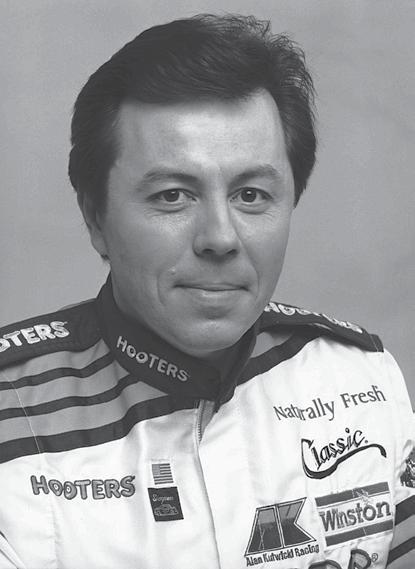
RECORD SETTER
KULWICKI’S AVERAGE Cup Series start of 10.6 and average finish of 10.6 in 1992 offered a foundation from which to build his championship effort. In the final race of the season, Kulwicki won the title by 10 points over Bill Elliott by leading a lap and then leading the most laps.
THE NO. 7 CAR
KNOWN FOR RACE FANS GREATLY appreciated Kulwicki as an independent thinker and someone who felt he could be successful with a lower budget than most teams. Fans called him “Special K” as he was a Cinderella-type figure and his Fords were known as “Underbirds” because they were underfunded but successful in NASCAR’s premier division.
IN EVERY ASPECT OF LIFE, HAVE A GAME PLAN AND THEN DO YOUR BEST TO ACHIEVE IT.
7 176 NASCAR LEGENDS
Fred Lorenzen
Fred Lorenzen built his NASCAR career by initially wheeling his own race cars and later the driver known as “Golden Boy” won 26 Cup Series races while driving for the powerful Holman Moody operation.
Born Dec. 30, 1934, Lorenzen began listening to NASCAR races on the radio in the family car as a teenager in the Chicago suburb of Elmhurst, Illinois.
Short tracks in the Chicago area drew him to NASCAR competition in 1956 and he claimed USAC stock car championships in 1958 and ’59. He returned to NASCAR’s premier series in 1960, but a disappointing season threatened to send him home to Chicago.
Sitting alone on Christmas Eve with no hope of returning to racing, Lorenzen got an unexpected phone call from Ralph Moody, offering a top ride with the legendary Holman Moody team in Charlotte, North Carolina.
Lorenzen won three of the 15 NASCAR Cup Series races he entered in the powerful pearl white No. 28 Ford during the 1961 season.
In 1962, there were two more wins with 11 top-five finishes and three pole positions in 19 starts. The next year, he logged six wins and 21 top-five results in 29 races.
From 1964 to 1967, Lorenzen won 15 additional races, including the 1965 Daytona 500. But the loss of his idol and teammate Fireball Roberts in a 1964 crash at Charlotte Motor Speedway and health issues of his own prompted an early retirement from driving on April 24, 1967.
Stock car racing’s handsome superstar said goodbye to a distinguished career as one of the sport’s most revered and respected drivers of the era.
Lorenzen briefly returned to NASCAR from 1970 to 1972, but he did not win. His career earnings totaled $496,572.
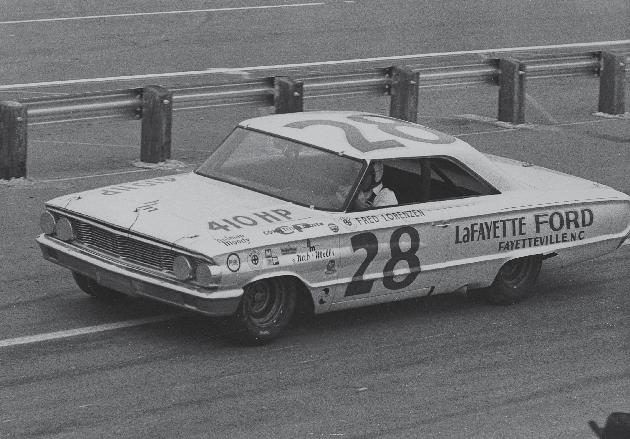
BEST SEASON
DURING THE 1964 SEASON, LORENZEN ENTERED 16 NASCAR Cup Series events and won eight, including superspeedway races at Atlanta, Charlotte and Darlington. Lorenzen had his No. 28 Ford out front for 2,375 of 5,375 laps completed. He was a fan favorite everywhere he raced throughout his 12-year career.
RECORD SETTER
LORENZEN ENTERED RACES WITH THE HIGHEST purses and put his cars up front when lap money was on the line. His total earnings of $122,587 in 1963 made him the first NASCAR driver to win more than $100,000 in a single season. He was often spotted calling his stockbroker after victories.
OPTIMISTIC INNOVATIVE DETERMINED STRONG-WILLED FOCUSED
KNOWN FOR
LORENZEN WAS HANDSOME AND HAD QUITE A female fan following. He was known to date movie stars and magazine models when his schedule allowed. He never partied the night before a race and felt getting a good night’s sleep was a huge advantage on the track against his fellow competitors.
28
“I want to go out while I’m on top. I’ve won everything that you can win and there’s no way to go but down.”
–FRED LORENZEN
177
Dale Earnhardt Jr.
Dale Earnhardt Jr. won 26 NASCAR Cup Series races between February 1999 and November 2017. His most significant triumphs came in the sport’s biggest race – the 2004 and 2014 editions of the Daytona 500.


88
Earnhardt Jr. began his racing career in 1991 at age 17, wheeling a Street Stock at North Carolina’s Concord Motorsport Park. Two years later, he ran various tracks in Late Model competition while working at his father’s Chevrolet dealership as a mechanic and attending Mitchell County (N.C.) Community College, where he earned an associate’s degree in automotive technology.
Earnhardt Jr. ran nine Xfinity Series races in 1996 and 1997 for Dale Earnhardt Inc. as well as team owner Ed Whitaker. He joined DEI in 1998 and ran the full Xfinity Series, winning consecutive NASCAR Xfinity Series championships in 1998 and 1999.
Also in 1998, he made his first NASCAR Cup Series start in an exhibition race at the Twin Ring Motegi in Japan. During the 1999 season, he also ran five Cup Series races in the No. 8 Chevrolet with his best finish being a tenth-place effort at Richmond in the fall race.
Earnhardt Jr. won races at Texas and Richmond in 2000 during his rookie season in the Cup Series. Over the next seven years with DEI, he logged 15 additional victories, including the 2004 Daytona 500.
Then in 2008, he joined team owner Rick Hendrick and Hendrick Motorsports, where he added another nine victories to his résumé, including the 2014 Daytona 500.
Throughout his career, the 2022 NASCAR Hall of Fame inductee was named the National Motorsports Press Association Most Popular Driver 15 times and the NASCAR Xfinity Series Most Popular Driver in 1999.
BEST SEASON
EVEN THOUGH HE FINISHED fifth in Cup Series points, Earnhardt Jr. enjoyed six wins in 2004. He started the season with a victory in the Daytona 500 in his No. 8 DEI Chevrolet, followed by wins at Atlanta in March, Richmond in May, Bristol in August, Talladega in October and Phoenix in November.
ON JULY 7, 2001, AT DAYtona International Speedway, Earnhardt Jr. won the 400mile event with Michael Waltrip finishing second in DEI Chevrolets. Just five months earlier, Earnhardt Jr.’s father lost his life at the track on the final lap of the Daytona 500. The win helped bring closure to that tragic day.
POPULAR
HANDSOME SMART EASY-GOING DETERMINED SOFT-SPOKEN
THE NO. 88 CAR RECORD SETTER
KNOWN FOR

THROUGHOUT HIS DRIVING career, Earnhardt Jr. was someone race fans could relate to as one of their own. His down-home demeanor and similar background made him a beloved superstar, and that popularity continues today through his roles as a TV broadcaster, entrepreneur and occasional short-track racer.

I’VE ALREADY DONE ENOUGH TO HAVE EARNED ‘GOOD DRIVER,’ SO IF I CAN BE KNOWN AS A GREAT PERSON AND A GOOD DRIVER, THAT’S BETTER THAN ONLY BEING A GREAT DRIVER.
178 NASCAR LEGENDS
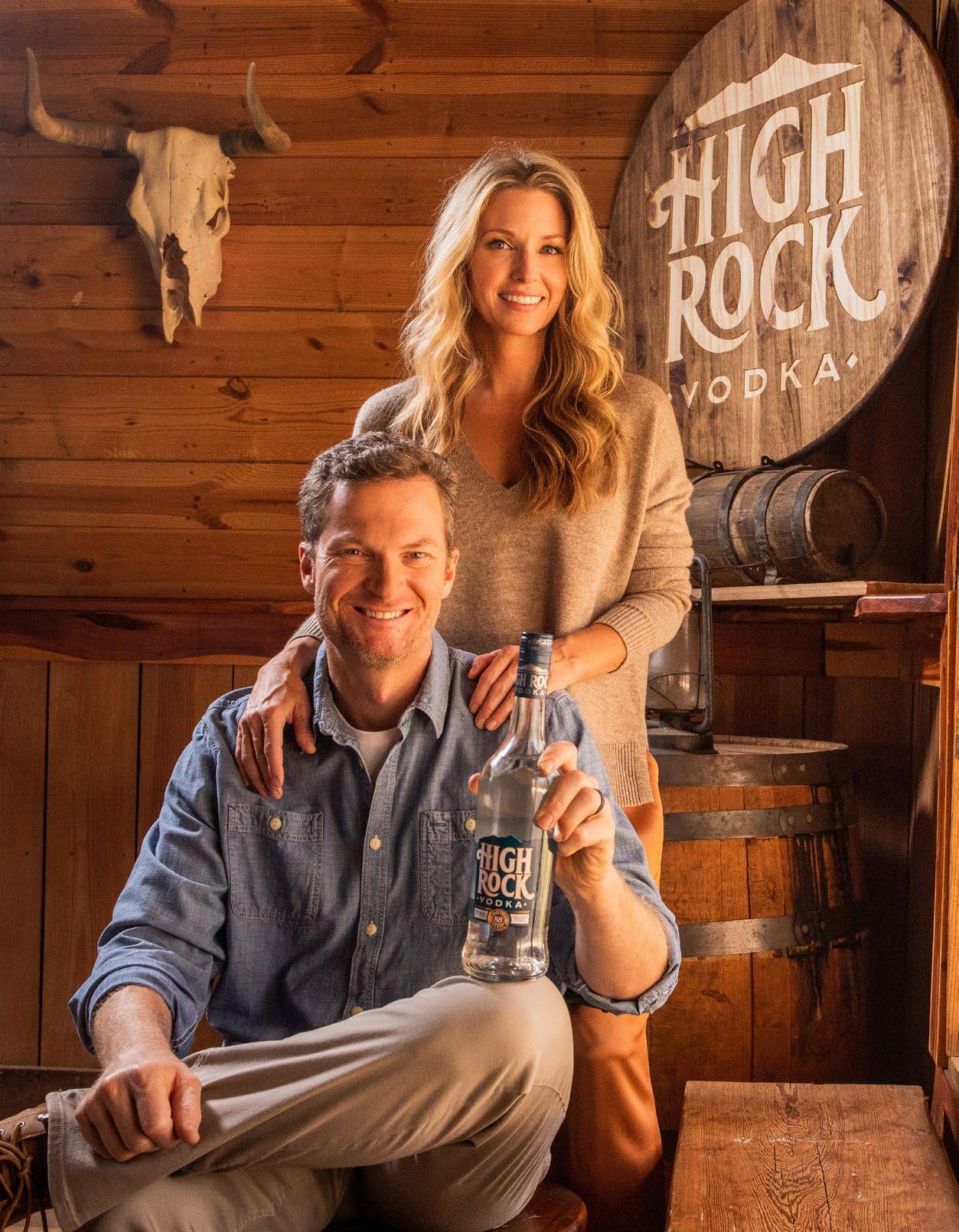


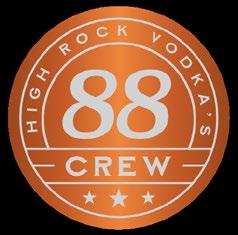
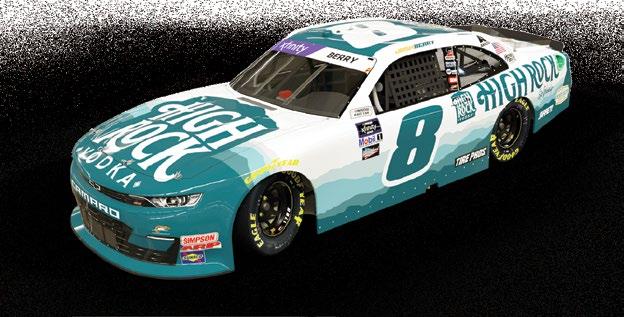
LEARN MORE AT HighRockVodka.com JOIN THE 88 CREW FOR THE LATEST NEWS, SPECIAL OFFERS, & EXCLUSIVE CONTENT FROM HIGH ROCK VODKA, DALE JR. & AMY EARNHARDT, and friends!
here!
join
Darrell Waltrip
Darrell Waltrip entered his first NASCAR Cup Series race on May 5, 1972, at Alabama’s Talladega Superspeedway. Throughout a 29-year career, he won 84 Cup Series races and claimed championships in 1981, 1982 and 1985.
Born on Feb. 5, 1947, in Owensboro, Kentucky, Waltrip began his racing career in go-karts at the age of 12. By the age of 16, he was racing stock cars, beginning with a 1936 Chevrolet coupe at a local dirt track near his home.
After high school graduation in 1965, he became one of the most successful asphalt racers in the region. Local car owners such as Harry Pedley and P.B. Crowell helped Waltrip make a name for himself at Kentucky Motor Speedway, Ellis Raceway and Fairgrounds Speedway at the Tennessee State Fairgrounds in Nashville, where he won track championships in 1970 and 1973.
Waltrip proved he was a showman by talking up rivalries between himself and Coo Coo Marlin (father of two-time Daytona 500 winner Sterling Marlin) and James Buford. Track management loved his antics as they helped sell tickets.
Waltrip’s short-track success prompted a move to NASCAR’s premier series at age 25 where he competed against superstars Richard Petty, David Pearson, Cale Yarborough and Bobby Allison, among others. Even though he didn’t hesitate to make his voice known, Waltrip eventually earned the respect of his more experienced peers. His first NASCAR Cup Series victory came at his home track, Nashville’s Fairgrounds Speedway, on May 10, 1975, as he beat the field by two laps in his own No. 17 Chevrolet.
Waltrip went on the score 83 additional Cup Series victories for such premier racing organizations as DiGard Racing, Junior Johnson and Associates, Hendrick Motorsports and his own Darrell Waltrip Motorsports.
BEST SEASON
DURING HIS FIRST YEAR DRIVING JUNIOR Johnson’s No. 11 Chevrolet in 1981, Waltrip logged 12 victories, 21 top-five finishes and 11 pole positions en route to his first of three NASCAR Cup Series championships. His biggest victory that year came in the fall race at Charlotte Motor Speedway.
RECORD SETTER
FORTY OF WALTRIP’S 84 VICTORIES CAME ON short tracks such as Bristol, Martinsville, North Wilkesboro and Richmond. His average start was 13.7 and average finish was 15.1. An aggressive style on and off the track made him a hero and a villain throughout his 29-year driving career that ended in 2000.
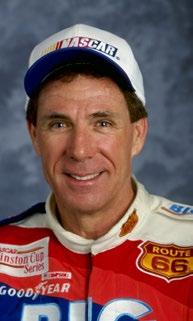
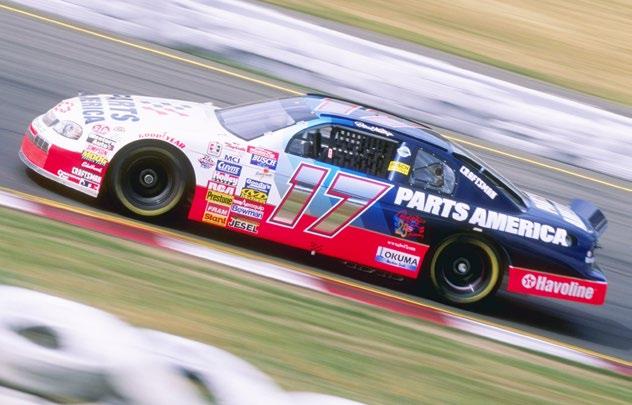
VERBAL DARING
BOLD INSIGHTFUL AGGRESSIVE SHOWMAN
KNOWN FOR

A TOUGH COMPETITOR IN ANYTHING HE DROVE, Waltrip developed a reputation for provoking his closest rivals and working on them mentally, causing them to make mistakes. His boisterous personality was new to NASCAR, often predicting he would win the race and then backing up his words.

17
“All I ever wanted to do was drive in NASCAR. I was blessed with a tremendous career with some of the very best teams and team owners in the sport.”
–DARRELL WALTRIP
180 NASCAR LEGENDS
Benny Parsons

Benjamin Stewart “Benny” Parsons ran his first NASCAR Cup Series race on Aug. 9, 1964, at North Carolina’s Asheville-Weaverville Speedway for the legendary Holman-Moody Ford operation.
The 1973 Monster Energy NASCAR Cup Series champion went on to amass 21 premier series victories in 565 career starts.
Born on July 12, 1941, Parsons spent his formative years in the Blue Ridge Mountains of North Carolina. At age 18, he moved to Detroit, Michigan, to work with his father in the taxi cab business. In 1963, he worked at a gas station, the place where he was accidentally introduced to stock car racing. A patron needing gas for his race car hauler invited Parsons to go along to nearby Mt. Clemens Speedway. The team’s regular driver didn’t show up, giving Parsons his first ride.
In a short time, Parsons gained a reputation for winning races. Enough so that Ford’s powerful Holman-Moody factory team found a place for him within its fleet of drivers. Still, he only ran that one race – at Asheville-Weaverville Speedway – in NASCAR’s premier series until 1968. He joined the ARCA Racing Series that year, winning championships in 1968 and 1969. He also logged three top-10 finishes in four Cup Series starts in 1969.
Parsons’ best season came in 1973 when he won the NASCAR Cup Series championship while driving for team owner L.G. Dewitt. His near impossible return to the track after a car-crippling crash at North Carolina’s Rockingham Speedway to claim the title is considered the most miraculous comeback in the sport’s 69-year history. Parsons is still the only driver to win both the ARCA and NASCAR championships. In 1975, Parsons won the Daytona 500, putting him among the sport’s elite drivers. He retired from driving in 1988 and went into broadcasting. Parsons died of lung cancer on Jan. 16, 2007.
STUDIOUS INSIGHTFUL COMPETITIVE DETERMINED SMART
BEST SEASON
DURING THE 1977 NASCAR Cup Series season, Parsons collected a season high four victories – Nashville, Pocono, Dover and Charlotte – in L.G. Dewitt’s Chevrolet. He also collected 20 top-five finishes and 22 top-10 results along with poles at Nashville, Talladega and Richmond. His average start that season was 4.7 while his average finish was 7.8.

THE NO. 72 CAR RECORD-SETTER
IN QUALIFYING FOR THE 1982 Winston 500 at Talladega Superspeedway, Parsons became the first man to qualify for a NASCAR event at over 200 mph (200.176). He was driving a Pontiac Le Mans for team owner Harry Ranier. Parsons logged 20-career poles during his 24-year career.
KNOWN FOR
THROUGHOUT HIS incredible NASCAR career, Parsons was a quiet competitor and often didn’t show his hand until the closing laps of races. Most of his 21 victories and 283 top-five finishes came after watching the competition battle for position as he saved his car for the final push to the checkered flag.
BENNY PARSONS WAS THE KINDEST, SWEETEST, MOST CONSIDERATE PERSON I HAVE EVER KNOWN. HE WAS ALMOST TOO NICE TO BE A RACE CAR DRIVER AND I SAY THAT AS A COMPLIMENT.
–DARRELL WALTRIP
72 181
Davey Allison
Davey Allison entered his first NASCAR Cup Series race on July 28, 1985, at Talladega Superspeedway. All told, he competed in 191 Cup Series events, winning 19 and finishing among the top five 66 times.
Born in Hollywood, Florida, on Feb. 25, 1961, Allison began sorting nuts and bolts in his father’s race shop in Hueytown, Alabama, as a child. He kept his grades just high enough in school to meet his parent’s approval to race on Alabama’s storied short tracks. By Allison’s senior year in high school, he knew every part of the race car and was a master mechanic.
His father, 1983 NASCAR Cup Series champion Bobby Allison, encouraged him to race and gave him proper instruction. Davey Allison often competed at a variety of tracks with friends and cousins helping as his pit crew.
By the early 1980s, the youngster had established himself as a strong superspeedway racer in the ARCA series. When prominent NASCAR Cup Series team owner Hoss Ellington needed a driver, he called upon this young star to wheel a Chevrolet for a team his uncle Donnie Allison had already made famous.
Another call from championship team owner Junior Johnson to fill in for the injured Neil Bonnett in 1986 got his career off the ground.
When Cale Yarborough left team owner Harry Ranier to form his own Cup Series operation in 1987, Davey Allison was given his best opportunity to date. Ranier sold his team to Robert Yates in 1988 and together, Yates and Allison collected 19 Cup Series victories amid several championship challenges.
While attempting to land his helicopter in the infield at Talladega Superspeedway in July 1993, Allison crashed and suffered fatal injuries.
BEST SEASON
28
DURING THE 1992 SEASON, DAVEY ALLISON WON five NASCAR Cup Series races, including the prestigious Daytona 500. He recorded 15 top-five finishes and 17 top-10 results in 29 starts, driving Yates Racing’s No. 28 Ford. His best starts that year came with poles at Michigan and Pocono.

RECORD SETTER
ALLISON FINISHED THIRD IN BOTH THE 1991 AND 1992 NASCAR Cup Series championship battles, posting 10 wins over two seasons. A crash triggered by another driver in the final race of 1992 at Atlanta took him out of contention and ended his best shot at claiming the title.

HELPFUL RESPECTED DETERMINED TALENTED SERIOUS
KNOWN FOR

A TOUGH COMPETITOR IN EVERYTHING HE DROVE, Allison developed a reputation for using his talent for getting the most out of his cars and often won in them. He was also a huge fan favorite with a large following throughout a driving career tragically cut short by a helicopter accident.

“There’s no question in my mind that I will finish out my career as a driver in NASCAR with Robert Yates. I simply don’t want to drive for anyone else.”
–DAVEY ALLISON
182 NASCAR LEGENDS
Lund
Lund was born into a farming family. He raced motorcycles at a young age and then moved to four wheels in midgets and sprint cars. After military duty in the United States Air Force, he returned home and attended dirt-track events across the Midwest as a spectator and competitor. He quickly discovered he had a natural talent for driving a race car – and for winning races.
Lund’s first start in NASCAR’s premier series came on dirt in Lehi, Arkansas, on Oct. 9, 1955, where he was involved in a series of flips on lap 65 of the 200-lap race. He suffered bruises and a broken arm but soon returned to pursue his dream of becoming a winner in NASCAR.
From 1956 to 1962, he logged 109 starts in NASCAR’s premier series, collecting 16 top-five finishes and 62 top-10 results with a variety of team owners, including Gus Holzmueller, A.L. Bumgarner, Petty Enterprises, Sam Rice and Bob Welborn, to name a few.
While at Daytona International Speedway in February 1963 without a ride, fate set the stage for the biggest victory of Lund’s 20-year career.
Marvin Panch of Wood Brothers Racing crashed while practicing for the upcoming American Challenge Cup race. The NASCAR star’s Ford-powered Maserati landed upside down and burst into flames. Lund ran to Panch’s aid and helped pull him from the wreckage. As a reward for his heroism, Lund filled in for the injured Panch in the Daytona 500 and won the race.
Lund was voted most popular driver four times, was elected to the International Motorsports Hall of Fame in 1994 and was included on the list of NASCAR’s 50 Greatest Drivers in 1998.
JOVIAL DETERMINED OUTGOING SMART RESPECTED
BEST SEASON
LUND, A JOURNEYMAN PARTtime racer in NASCAR, scored his biggest victory in the 1963 Daytona 500 while using only one set of tires. The No. 21 Wood Brothers Mercury he piloted as a replacement for the injured Marvin Panch was strong while leading the final 17 of 200 laps.
RECORD-SETTER
IN 303 NASCAR STARTS, LUND logged five Cup Series victories, 54 top-five finishes, 119 top-10 results and six pole positions. He averaged 15.2 in starts and 15.6 in finishes in cars often considered strong enough to win. Even though he raced limited schedules, he was often in top rides during his two-decade career.
KNOWN FOR STANDING 6-FOOT-5 AND 270 POUNDS, Lund was one of the sport’s toughest competitors. In addition to NASCAR, he was a fan favorite in USAC, ARCA and the Pacific Coast Racing Association. He won the NASCAR Grand American championship three times (1968, 1970 and 1971) and the NASCAR Grand National East championship in 1973.

‘Tiny’
Dewayne “Tiny” Lund was known as one of the most jovial competitors in NASCAR competition. Sadly, the native of Harlan, Iowa, died in a multi-car crash at Alabama’s Talladega Superspeedway on Aug. 19, 1975.
A REALLY GOOD GUY. BUT YOU DIDN’T WANT TO GET HIM MAD AT YOU. HE WAS BUILT LIKE A BULL. IF HE HIT YOU, THE LIGHTS WENT OUT.
–MARVIN PANCH
55 183
Fireball Roberts
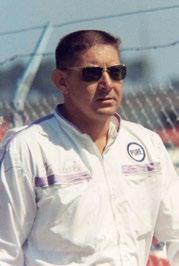
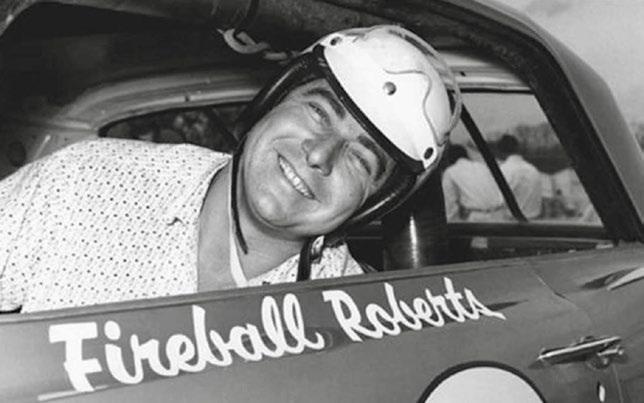
Glenn “Fireball” Roberts won 33 NASCAR Cup Series races from 1950 through May 1964. His biggest victories came in the 1958 Southern 500 at Darlington Raceway and the 1962 Daytona 500 at Daytona International Speedway.
Born in Tavares, Florida, on Jan. 29, 1929, Roberts was raised in the small town of Apopka, Florida. As a teenager, he became interested in playing baseball. He tried out for the position of pitcher for the Zellwood Mud Hens, an American Legion baseball team, and easily made the squad. His ability for throwing fast earned him the nickname, “Fireball.”
With World War II ending in 1945, many men sought ways to find adventure when they returned home. A new pastime known as stock car racing sprang up around the South among moonshiners and mechanics, and Roberts felt the sport was definitely for him.
He attended the University of Florida in 1947 and began racing on small dirt bullrings on weekends. He won a 150-mile race on the Beach and Road Course in Daytona Beach, Florida, during 1948, his first victory in NASCAR competition.
When the newly built Darlington Raceway opened for the Labor Day running of the inaugural Southern 500 in 1950, Roberts finished a surprising second among 70 drivers behind race winner Johnny Mantz. He had already won a 100-mile NASCAR Strictly Stock race, the equivalent of today’s Cup Series, two weeks earlier on Aug. 13 in Hillsborough, North Carolina.
Roberts went on to become a superstar and drove for the top car owners of the 1950s and early 1960s, such as Pete DePaolo, Smokey Yunick, Jim Stephens and Holman Moody.
Roberts died on July 2, 1964, from injuries suffered in a multi-car crash at Charlotte Motor Speedway on May 24.
BEST SEASON
IN 1957, ROBERTS WON EIGHT NASCAR CUP SERIES races while driving for team owner Pete DePaolo. Roberts recorded 27 top-10 finishes in his famed redand-white No. 22 Ford. He also logged four pole positions in 52 starts that season and led 1,414 laps.
RECORD SETTER
OVER A PERIOD OF 13-AND-A-HALF SEASONS in NASCAR’s premier division, Roberts entered 206 races and won 33 times, recording 93 top-five finishes, 122 top-10 results and 32 pole positions. His average start was 7.8 with an average finish of 13.2. He was considered a top contender throughout his illustrious driving career.
ARTICULATE DETERMINED SMART POPULAR
KNOWN FOR

ROBERTS WAS ONE OF THE MOST POPULAR drivers of the 1950s and early 1960s. Many NASCAR fans who saw him race compare his allure to the late Dale Earnhardt. When Roberts passed away in 1964, the sport was deeply shaken just as it was when Earnhardt died in 2001.

22
“He was a man first, competitor second and teacher third.”
–RICHARD PETTY
184 NASCAR LEGENDS
Donnie Allison
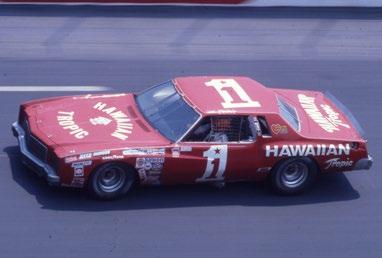
Donnie Allison entered his first NASCAR Cup Series race on Oct. 16, 1966, at Charlotte Motor Speedway. He went on to compete in 242 series races, winning 10 and finishing in the top 10 115 times.
Born in Miami, Florida, on Sept. 7, 1939, Allison began racing after a neighbor came home with a 1940 Ford. They took the car to nearby Hialeah Speedway and Allison proved he was the better driver.
By the early 1960s, Allison was routinely winning races and championships throughout the Southeast. He began a career in NASCAR’s top stock car series in 1966 when team owner Robert Harper offered him a ride at Charlotte Motor Speedway. In only his second start with Harper, Allison finished ninth at the track in Rockingham, North Carolina.
The following year, Allison logged seven top-10 finishes in 20 starts with various team owners. Then on June 16, 1968, his first victory came at Rockingham Speedway while driving for car owner Banjo Matthews. A second win followed with Matthews at Charlotte in October 1969 and three victories during the 1970 season sent his career into high gear.
Allison won on his home track in Talladega, Alabama, for Wood Brothers Racing in May 1971. For the next five seasons, he fell into a victory drought until another win came at Charlotte for team owner Hoss Ellington in October 1976. He won twice more for Ellington in 1977 and another in 1978 rounded out his roster of victories.
Allison suffered a near-fatal accident at Charlotte Motor Speedway in 1981 but eventually returned, making his final start at Michigan International Speedway on Aug, 21, 1988. For the past 25 years, he has worked with young drivers as a consultant.
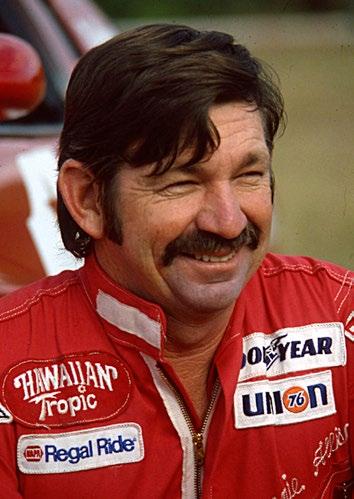
SERIOUS HELPFUL TOUGH DETERMINED RESPECTED WINNER
BEST SEASON
THE 1968 NASCAR CUP Series season saw Allison win at Bristol in April, Charlotte in May and Daytona in July. He posted 10 top-10 finishes in 19 starts while driving Banjo Matthews’ No. 27 Ford. His best start was second on the short track in North Wilkesboro, North Carolina.
RECORD-SETTER
ALL BUT ONE OF Allison’s 10 NASCAR victories came on superspeedways. His average start was 9.4, and his average finish was 16.7. He could adapt to any type of race car, which was proven by his performance in the Indianapolis 500 where he finished fourth in 1970 and sixth in 1971.
KNOWN FOR
ALWAYS A TOUGH competitor in anything he drove, Allison developed a reputation for using his talent to get the most out of his race cars. He was also known for being able to adapt to any type of car on any type of race track, large or small.
THE NO. 1 CAR
I CHOSE NOT TO RUN FULL SCHEDULES IN NASCAR BUT STILL HAD GREAT SUCCESS. I ENJOYED WINNING IN MY OWN CARS ON SHORT TRACKS WHEN I WASN’T RACING IN CUP EVENTS.
27 185
David Pearson

David Pearson ran his first race in NASCAR’s premier series in February 1960. He eventually claimed three Cup Series titles and amassed 105 victories in 574 series starts, second only to Richard Petty (200) in the win column.
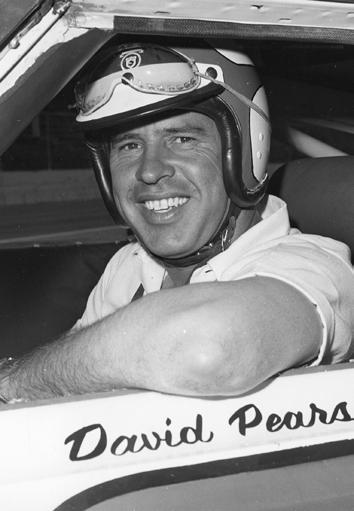
Born in Whitney, South Carolina, in 1934, Pearson’s first race came in a 1952 Hobby Stock event at a track in nearby Woodruff. He earned $13.
In February 1960, Pearson built a Ford for Late Model competition and hauled it to Daytona International Speedway. The next year, he collected major Cup Series victories at Daytona International Speedway, Charlotte Motor Speedway and Atlanta Motor Speedway en route to rookie-of-the-year honors.
By 1966, Pearson had joined team owner and fellow South Carolinian Cotton Owens and logged 15 victories and his first Cup Series championship. Two more titles came with Ford’s powerhouse Holman-Moody organization in 1968 and 1969.
In 1970 and 1971, Pearson began racing a limited schedule of Cup Series races for Holman-Moody and car owner Ray Nichels. He enjoyed his best years with Wood Brothers Racing from 1972 to 1979 as he won 43 races with the Virginia-based team, including 11 of 18 starts in 1973.
Pearson and team owner Glen Wood parted ways in April 1979 after a pit road miscue at Darlington Raceway. Pearson returned to the track that September to win as a substitute driver for the injured Dale Earnhardt. Pearson’s final Cup Series victory came at Darlington in April 1980 in Hoss Ellington’s Chevrolet, while his final start was six years later at Michigan International Speedway.
Throughout his career, Pearson’s reputation for laying back and striking late unnerved his rivals. Of those, he and Richard Petty finished first and second 63 times with Pearson winning 33 and Petty coming out on top 30 times.
SAVVY UNASSUMING INGENIOUS MOTIVATED SMOOTH


BEST SEASON
PEARSON WON HIS second of three NASCAR premier series championships in 1968 with 16 victories, 36 top-five finishes, 38 top-10 results and 12 pole positions for team owners John Holman and Ralph Moody. Pearson led 3,950 of 13,907 laps that season with an average finish of 5.8 over the 48-race schedule.
THE NO. 17 CAR RECORD-SETTER
ONE OF PEARSON’S greatest victories came in the 1976 Daytona 500 at just 20 mph after a last-lap crash with Richard Petty. Pearson was chosen Driver of the (20th) Century by a select group of NASCAR media members who covered the sport in that era.
KNOWN FOR DURING A 26-YEAR career, Pearson was considered to be one of the smartest, yet elusive drivers in NASCAR’s long and storied history. Even his own crew members and team owners didn’t know his strategies for the closing laps of races. He was known for saving his cars until the final 50 laps.
I ENJOYED BEING WITH THE WOOD BROTHERS. WHEN WE WERE AT THE RACE TRACK, WE WERE ALWAYS JOKING AND KIDDING EACH OTHER. IT WAS THE JOY AND HIGHLIGHT OF MY LIFE.
17 186 NASCAR LEGENDS
Bobby Allison
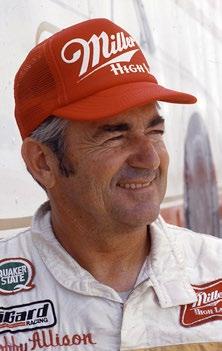

Bobby Allison entered his first NASCAR premier series event on Feb. 24, 1961, at Daytona International Speedway in a 100-mile qualifying race. Many in the garage saw the newcomer possessed great talent for driving.
Born in Miami, Florida, on Dec. 3, 1937, Allison began racing modifieds in his home state as a teenager. Because he was only 17 years of age, his parent’s signed permission for him to race.
When Allison discovered it was only for one race, he began using the alias of Bob Sunderman in hopes of not getting caught. Eventually, his father discovered a photo in the newspaper after a victory and decided to bless his son’s efforts.
Numerous short-track wins prompted Allison and his brother, Donnie, to move to Alabama to compete against even tougher competition. Both excelled as drivers and by the early 1960s, each found their way into NASCAR’s top series.
By 1965, Bobby Allison was fielding his own Chevrolet on a limited budget. A year later, he enjoyed wins at Islip (N.Y.) Speedway, Oxford (Maine) Plains Speedway and Beltsville Speedway in Maryland as part of NASCAR’s Northern Tour. Those wins opened the door to drive for top organizations such as Holman Moody, Junior Johnson, Bud Moore, DiGard Racing and Stavola Brothers Racing.
Allison enjoyed a reputation for quickly adapting to stock cars, open-wheel cars and sports cars on a variety of track configurations. Throughout his 25-year career, he won 84 NASCAR Cup Series races and claimed the series championship in 1983.
Highlights of his career include Daytona 500 victories in 1978, 1982 and 1988.
Sadly, his driving career ended on June 19, 1988, after suffering a near-fatal head injury in a crash at Pocono Raceway.
BEST SEASON
WHILE DRIVING MERCURYS FIELDED BY HIS OWN team and the powerhouse Holman Moody operation in 1971, Allison logged 10 victories, 27 top-five finishes and 31 top-10 results. The numbers stand as his overall best season during his storied 25-year career. He is still beloved by fans as one of NASCAR’s greatest superstars.
RECORD SETTER
ALLISON’S AVERAGE START OF 8.5 AND AVERAGE finish of 11.5 is highly respected by NASCAR historians. From 1981 to 1988, he completed close to 198,000 laps and led 27,551. Twenty-three of his 84 victories came on short tracks, while six came on road courses and 58 on superspeedways.
INNOVATIVE REMARKABLE SMOOTH BELOVED
KNOWN FOR
A TOUGH COMPETITOR IN EVERYTHING HE DROVE, Allison was known by his fans for being down to earth. Allison had the ability to get the most out of an ill-handling car. As a result, team owners from a variety of racing organizations called on him to wheel their race cars.
“I was incredibly fortunate to have enjoyed such an amazing and rewarding career. There are so many people along the way that helped me find the success I enjoyed in NASCAR.”
22
–BOBBY ALLISON
187
REFLECTIONS OF A CHAMPION
ALLISON LOOKS BACK ON HIS RACING CAREER
BY BEN WHITE
Robert Arthur Allison turned 10 years old on Dec. 3, 1947. Eleven days later on Dec. 14, gas station owner, stock car driver and business entrepreneur “Big Bill” France gathered 35 men for four days of meetings at the Streamline Hotel in Daytona Beach, Florida....
The distinguished group represented the most influential names in the racing industry at the time and included drivers, mechanics, promoters, car owners, journalists, businessmen, and a recording secretary there to document the historic event.
In what has been dubbed “The SmokeFilled Room” by NASCAR historians, participants scribbled notes on bar napkins and a few legal pads, eventually constructing the informal beginnings of the National Association for Stock Car Auto Racing. France, a towering 6-foot-5, envisioned what the sport would become. He could see into the future with remarkable accuracy and spoke prolifically about where he wanted to take the sport in the decades to come.
“Stock car racing has got distinct possibilities for Sunday shows and we do not know how big it can be if it’s handled properly.” France said. “It can go the same way as big car racing (Indianapolis), I believe stock car racing can become a nationally recognized sport by having a National Point Standing. Stock car racing as we’ve been running it is not, in my opinion, the answer. … We must try to get track owners and promoters interested in building stock car racing up. We are all interested in one thing – that is improving the present conditions. The answer lies in our group right here today to do it.”
Bobby Allison and “Big Bill” France were on a collision course but neither one knew it at the time. Years later, their paths would collide and both would be major players in
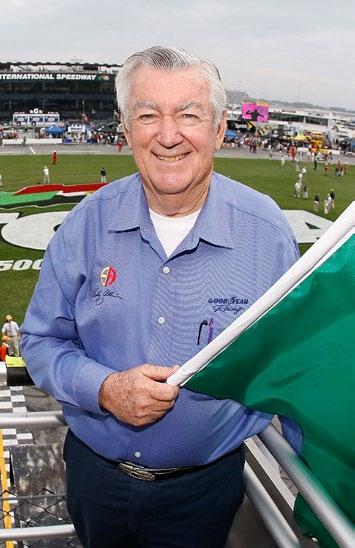
the story of NASCAR’s 75th anniversary.
First, a bit of backstory about Allison’s path toward becoming one of NASCAR’s greatest legends helps to set the scene.
Allison’s boyhood focus was on playing with cars on the beach a few blocks from his home and helping his father sweep floors at his business, which installed and maintained car lift equipment at service stations.


“My dad, Edmond “Pop” Allison, was a neat guy but he worked all the time,” Bobby Allison recalled. “He had us 10 kids on the go all the time. He didn’t put up with lagging around and doing nothing. There was always something that needed to be done.”
At the time France was making plans, Allison also had a unique opportunity that would change his life.
“I’ve been a race fan since I was a kid,” Allison said. “There were race tracks around even before NASCAR came into existence. This was the summer of 1948 and I hadn’t turned 11 yet. The guys would put old cars together and race them, and we lived in Florida and it was hot all the time. There was this track called Opa-lacka Speedway. It was on the old Naval Air supply aera. They had all these paved lanes that were parallel, and they made the turns with dirt that they eventually paved.
“My grandfather – my mom’s dad – lived with us and he loved all kinds of sports. One Friday night, he told me he was going to the car races and wanted to know if I wanted to go along. I thought, ‘Sure. That would be great!’ I’m a 10-year-old kid and I’m looking
for anything that’s exciting. We get there and I’m thinking this is the greatest thing I’ve ever seen. I bugged anybody that had a car to take me to the race track. Not long after that, I started riding my bicycle to see the races.”
It was no surprise a few years later while in high school that Allison began racing in the amateur division at the newly built Hialeah Speedway in Hialeah, Florida. He had his 1938 Chevy but wasn’t quite old enough to race it. After begging his mother, Kitty, to sign the permission slip, she said for one race and Bobby was thinking for 100 years.
He moved up through the ranks and started winning Late Model races, so he began using an alias because the sports page of the newspaper started posting results. When the victory lane photo of Allison didn’t match the license, he borrowed one that read Bob Sunderman. Allison’s dad figured out what was going on.
“My dad told me if I was going to race, I should use my own name and to so it with honor,” Allison said. “Mom wasn’t high on the idea at all. Mom’s sister Patty and her husband Jimmy Halley lived in Wisconsin. Uncle Jimmy was the sales manager for Mercury Outboard Motors. Mom called him and asked him to put me to work there to get me away from racing in Florida.”
Little did she know that every small town in Wisconsin has a race track. Further, Carl Kiekhaefer, the owner of Mercury Marine, was heavily involved in NASCAR, fielding a multi-car operation during the mid-1950s.
Allison ended up heading to Charlotte to work on the cars driven by Buck Baker, Speedy Thompson, Jimmy Thompson, Jack Smith, Herb Thomas, just to name a few, in 1955 and 1956. His mother eventually gave in to his dream of a racing career, ending her hopes that he would attend college to become a doctor or lawyer.
Bobby Allison continued to race around Florida until he, brother Donnie Allison and Red Farmer discovered that there was money to be made racing in Alabama, thus becoming the cornerstones of the famed “Alabama Gang” in 1962.
Bobby Allison was winning everywhere and became a top star in short-track racing, earning back-to-back Modified special titles in 1962-’63, then two consecutive NASCAR National Modified crowns in 1964-’65.
188 PHOTOGRAPHY: GETTY IMAGES NASCAR REFLECTIONS
Three years before that first Modified title, Allison started five NASCAR Cup Series races in 1961, driving a Chevrolet owned by brother-in-law Ralph Stark. His best finish was 20th at Daytona in a qualifying event.
Then in 1965, he entered his own Chevelle in Cup Series competition and logged three top-10 finishes. The next year, he won Cup Series races at tracks in Islip, New York, Oxford Plains, Maine, and Beltsville, Maryland. He had finally arrived as a winning driver in NASCAR’s elite series.
It was the beginning of an amazing career, a dream come true that began for a young 10-year-old boy who simply didn’t sleep at night for weeks after seeing his first race with his grandfather way back in summer of 1948. It was a world of color, fast cars, excitement – even better than the Buck Rogers adventures in space he had read about and the baseball games with hot dogs, sodas and cracks of the bat when they connected for home runs.
Allison had seen his early racing heroes drive, win and then retire, only to become a Cup Series driver, struggle to make a name for himself on short tracks, field his own cars until being discovered, and then win a remarkable 84 Cup Series races while posting 336 top-5 finishes, 446 top-10 results and 59 pole positions. Among those stats, he won the Daytona 500 in 1978, 1982 and 1988, the last one over his son Davey Allison. It’s the only time in NASCAR’s 75-year history that a father and son have battled for a Daytona 500 victory.
One of the most famous ends to the 500 came in 1979 when Cale Yarborough and Donnie Allison crashed while racing for the win, giving the victory to third-place Richard Petty for his sixth victory in the 500. After stopping to check on his brother, Bobby Allison became entangled in a fight between Yarborough and Donnie Allison. The fight was seen live on CBS by millions of viewers who were snowed in by a storm that blanketed the East Coast.
Though simply by circumstance, the outcome of the race introduced NASCAR to a sizable new audience.
“The fight after the 1979 Daytona 500 is something I’ve talked about countless times over the past 40 years,” Allison said. “It was one of those things that just happened. I was there to give Donnie a ride back to the garage area and, somehow, I got involved. (Laughter) As I’ve said many times, Cale Yarborough kept running into my fist with his nose.
“As it turned out, it was a negative that turned into a huge positive for NASCAR because so many people that had never seen a NASCAR race were suddenly talking about what an incredible finish it was all across the United States. Plus, they were trapped because of the snow and they saw what NASCAR was all about. As it turned out, it was an incredible step in the right direction, but certainly unintended.”
Allison, a 2011 NASCAR Hall of Fame inductee, had driven for 13 team owners and finished second in Cup Series points in 1970, ’72, ’78, ’81 and ’82 before winning his lone championship in 1983, while
driving for DiGard Racing. The title was a sweet accomplishment that had eluded him for decades.
“The 1983 championship was something I had worked so hard for,” Allison said. “We would run good so many times in so many seasons. Then, we’d have something happen right at the end of the year and we would fall short. I was second in points those five years and they would somehow slip away. Then, it all came together in 1983. Winning it was quite a thrill for me and the highlight of my career for sure.”
Allison was on top of the world in 1988 when everything seemingly came crashing down. During an event at Pocono Raceway, Allison’s No. 12 Buick was struck in the driver’s side door, causing near-fatal injuries that ended his career.
After a lengthy recovery, Allison returned to the sport in 1991 as co-owner of Bobby Allison Motorsports.
He had watched his son, Davey Allison, build his own NASCAR career and win 19 Cup Series races, including the 1992 Daytona 500. Davey Allison lost his life in a helicopter crash in July 1993.
Allison’s younger son, Clifford, lost his life during a practice session prior to a NASCAR Xfinity Series race at Michigan International Speedway in August 1992.
Still, even though there has been unspeakable personal sadness, there has also been incredible joy from being a part of the sport as a competitor and an ambassador. Allison has always searched for the good times and dwells upon them.
“There have been some extremely good days and some incredibly, unspeakably hard days. But through it all, I wouldn’t take anything for being able to be a part of the sport,” Allison said. “The fan support has been tremendous throughout my career and I’ve always appreciated them so much. When I was racing, I worked hard to sign every autograph of every person in line. That was very important to me, even after winning a 500-mile race.”
Bobby Allison has seen many changes within the sport through the years and he continues to watch the sport evolve.
“It’s hard to believe it’s been 75 years,” Allison said. “So much has changed in the sport from the time myself and Donnie (Allison) and Red (Farmer) came into this 60 years ago.
“The cars are different, safety continues to get better and better, the drivers are different, the ways things are done is different, the tracks, the people – it’s all different. It’s all moving forward with the times.
“I enjoyed my time in NASCAR racing against Richard Petty, David Pearson, Cale Yarborough, Dale Earnhardt, Buddy Baker – all the drivers of the ’60s, ’70s and ’80s – the drivers of my era. We had some incredibly intense races and we respected each other every time we were on the track and off of it. I think every era of drivers respected each other because they knew they were racing against the best.”
189
There have been some extremely good days and some incredibly, unspeakably hard days. But through it all, I wouldn’t take anything for being able to be a part of the sport.
NASCAR 75th ANNIVERSARY





MAGAZINE
AN OFFICIALLY LICENSED
PUBLICATION OF NASCAR

23110 STATE ROAD 54, SUITE 293








LUTZ, FL 33549

EMAIL: INFO@AE-ENGINE.COM
WEB: POLEPOSITIONMAG.COM; AE-ENGINE.COM


THE CREW
PUBLISHER: CRAIG BARONCELLI
COMMERCIAL
VICE PRESIDENT: DAVID WATSON
DIRECTORS: MARK MORALES, ROWLAND GEORGE, ARNOUT KOK
CONTENT







CREATIVE DIRECTOR: JOE RABUCK

DIGITAL MEDIA DIRECTOR: NICOLE COOPER
DIGITAL CONTENT DIRECTOR: JOSH MULL
EXECUTIVE EDITOR: ERIC ESTEPP
COPY EDITOR: KEITH WALTZ
CONTRIBUTORS: JARED TURNER, KEITH
WALTZ, BEN WHITE, JOSEPH WOLKIN, JERRY

















BONKOWSKI, DUSTIN ALBINO, MIKE NEFF
SOCIAL MEDIA COORDINATORS:
AIDAN ANDERSEN, ETHAN ANDERSEN, SHOGUN


PHOTO CREDITS: GETTY IMAGES, NASCAR, FREEPIKS.COM


SPECIAL THANKS TO: ANDREW ENGEL (NASCAR)



















A.E. ENGINE SPECIFIES THAT POST-PRESS CHANGES MAY OCCUR TO ANY INFORMATION PRESENTED IN THIS PUBLICATION AND TAKES NO RESPONSIBILITY FOR GOODS OR SERVICES ADVERTISED.

NASCAR® IS A REGISTERED TRADEMARK OF THE NATIONAL ASSOCIATION FOR STOCK CAR AUTO RACING, INC.


























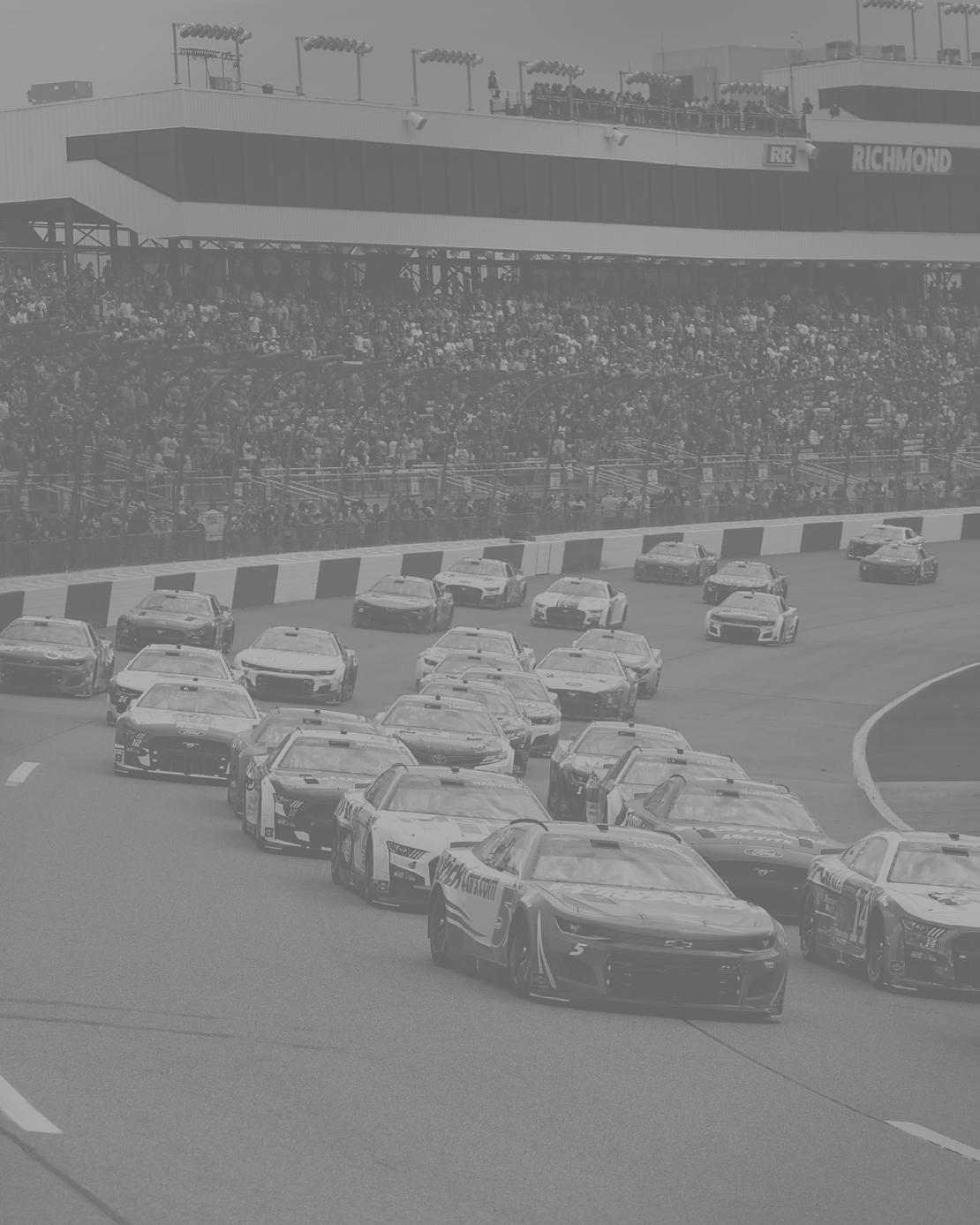
MAIL ORDER: TO PURCHASE A COPY, SEND
A CHECK OR MONEY ORDER FOR $20.00 TO:





A.E. ENGINE, 23110 STATE ROAD 54, SUITE 293, LUTZ, FL 33549. PLEASE INCLUDE YOUR RETURN MAILING ADDRESS AND AN EMAIL ADDRESS AND MAKE THE CHECK PAYABLE TO A.E. ENGINE.

ONLINE ORDER: SUBSCRIPTIONS AND INDIVIDUAL COPIES CAN BE ORDERED ONLINE AT POLEPOSITIONMAG.COM.
PRINTED IN THE U.S.A. (OH YEAH!)
SUBSCRIBE TO NASCAR POLE POSITION FIVE EDITIONS FOR $26.95 POLEPOSITIONMAG.COM/BUY A High Rock Moment Dale Jr. & Amy Earnhardt launch premium Vodka brand P. 10 The Next Gen is Here All eyes are on NASCAR’s new race cars WHEN NASCAR RULED THE CONSOLE GAMING WORLD BLAST FROM THE PAST 1961: A Fight to the Finish Wow your friends with these facts and figures MEET THE BURTONS: JEB & WARD DRIVER Q&AS ALEX BOWMAN NOAH GRAGSON MYATT SNIDER ZANE SMITH NASCAR POLE POSITION FEBRUARY-MARCH 2022 chase elliott KEVIN HARVICK DRIVERS POSTERIZED ELLIOTT // DEEGAN // CINDRIC // & MORE @NPPMAG FREE NASCAR COLLECTIBLES SHOW YOUR STUFF RACING JOBS NASCAR PETS SAY HELLO TO NASCAR Salutes Q&A with Black Rifle Coffee Company CEO Evan Hafer P. 22 For the Record An exclusive interview with living legend Richard Petty DRIVERS POSTERIZED BYRON // LOGANO // BUSCH BROS. BEHIND THE SCENES AT MISCRAFT’S STOP-MOTION WORKSHOP ROSS CHASTAIN ‘Eat, Drink & Sleep Racing’ CHRISTOPHER BELL ‘WE HAVE ALL THE PIECES’ @NPPMAG FREE NASCAR POLE POSITION JUNE JULY NASCAR Tracks App Download now to plan your next NASCAR adventure P. 08 Driver Throwbacks Dale Earnhardt, Jeff Gordon, Tony Stewart + more P. 62 NASCAR POLE POSITION AUGUST SEPTEMBER DRIVERS POSTERIZED BOWMAN // SUAREZ + MORE Harry Gant 1964 Q&A A LIFE OF RACING: BOBBY LABONTE NASCAR LEGEND SEASON REWIND NASCAR HOME TRACKS JENNERSTOWN SPEEDWAY THE BUSINESS OF RACING WOOD BROTHERS KAULIG RACING THORSPORT POLEPOSITIONMAG.COM @NPPMAG FREE The New ROXOR is Here Welcome to the way, way off-road. Built to thrive where others won’t Austin Dillon Q&A NASCAR veteran Austin Dillon talks God, country and cowboys P. 36 AUSTIN CINDRIC’S CUP SERIES CAREER STARTS WITH A DAYTONA 500 WIN NASCAR POLE POSITION APRIL MAY WHY FANS LOVE NOAH GRAGSON ZANE SMITH LOVES HIS POOCHES MONDAY NIGHT RACING: A FUN ESPORTS ALTERNATIVE ROOKIE ROAR SEASON REWIND 1961 NASCAR LEGEND JUNIOR JOHNSON DRIVERS POSTERIZED WALLACE // BLANEY // BRISCOE @NPPMAG FREE Across the Board Bringing NASCAR families back to the kitchen table P. 10 My Favorites Rajah Caruth: one of NASCAR’s most promising racers P. 14 POLEPOSITIONMAG.COM @NPPMAG FREE FOR THE RECORD RUSTY WALLACE NASCAR HOME TRACKS EVERGREEN SPEEDWAY NASCAR LEGEND FIREBALL ROBERTS BEHIND THE SCENES WITH DALE JR.’S DIRTY MO MEDIA FAST RELIEF Bayley Currey on Alka-Seltzer’s return to NASCAR YO, PARKER! Catching up with NASCAR’s multidimensional talent NASCAR POLE POSITION OCTOBER NOVEMBER ELLIOTT // LARSON // HAMLIN
A.E. ENGINE IS PROUD TO BE A LONGTIME LICENSEE OF NASCAR
What 75 Years of NASCAR Means to Me
BY BEN WHITE
It was a simple question really. One of those you don’t pay much attention to at first.
My dad asked, “How would you boys like to go to a stock car race in a couple of weeks?”
His words were directed to myself and my two older brothers. I was 11, Doug was 12 and Cullen was 13. It was 1972.
I was the first to speak as I was the adventurous, outgoing one among us.
“That sounds great! When is it?”
“Two weeks from today, April 16,” dad said, “It’s called The Rebel 400 and it’s a NASCAR race at Darlington Raceway.”


“What is NASCAR?”
Doug chimed in. “It’s Richard Petty and those guys. He’s the guy that does those Ray’s Hamburger commercials. Drives that blue 43 car. He also does the Polaroid sunglasses commercials. They race around in a circle.”
Cullen said, “Sounds like fun. Let’s go.”
It really was a big deal. We didn’t do many things like that growing up. Going to a NASCAR race was pretty special. Sunday, April 16, finally came. I was up at 5 a.m. and was soon ready to leave. Mom made sandwiches and brownies. We put everything, including a bunch of cheap grocery store soft drinks, in a cooler.
The soft drinks were 10 cents each and saved money over the name-brand labels.
After a three-hour drive to South Carolina, we were there. Holy cow! This was the coolest thing I had ever seen. Darlington Raceway was huge. We were sitting on the concrete bleachers on the backstretch about halfway down. The excitement was building.

We sat for a couple of hours until we heard the national anthem and the cars fire up on the frontstretch. The sight of the cars on the pace laps honestly took my breath away. They were a sea of color with drivers waving to the crowd. Then things got wild … and fast! David Pearson started on the pole with Bobby Allison alongside. Rubber, sun, loud engines … it was crazy. It was 293 laps of fighting for position, spins, excitement. Pearson won his first of 43 races for Wood Brothers Racing that day and my life changed forever. I will never forget it. It’s still very vivid in my mind.
I am now 62 years old. This past April marked the 50th anniversary of that race and I’ve been a part of the sport ever since.
Because of that one trip to Darlington to see that one Cup Series event, I’ve driven race cars, worked as a crew member for Richard Childress Racing in 1980 and devoted 40 years of my life to motorsports journalism, covering NASCAR via print, radio and television.
I’ve covered two Cup Series races in Japan. I’ve also had the honor of writing 10 books about NASCAR and the personalities within the sport, along with countless articles about the history of the sport. And I’ve met so many amazing people.
It goes a bit deeper. My son, Aaron White, began working for RCR while in college. Upon graduation in 2014 with a bachelor’s degree in mechanical engineering, he worked at ECR Engines before becoming a supervisor in his current role with Childress Technologies.
I’m truly blessed to say I’ve personally seen much of the sport’s 75-year history unfold right before my eyes. I’m even more blessed to have personally known several of the legends I saw race on April 16, 1972, as well as many, many more that have enjoyed incredible careers in the sport since. That is the greatest gift of all.
Through a fun family outing to Darlington Raceway as an 11-year-old child, I found my place in life by experiencing a new world called NASCAR.

In a matter of seconds, a life was changed, a path was set, a destiny was fulfilled, and a beautiful and remarkable mystery was set into motion.
PHOTOGRAPHY: GETTY IMAGES NASCAR REFLECTIONS
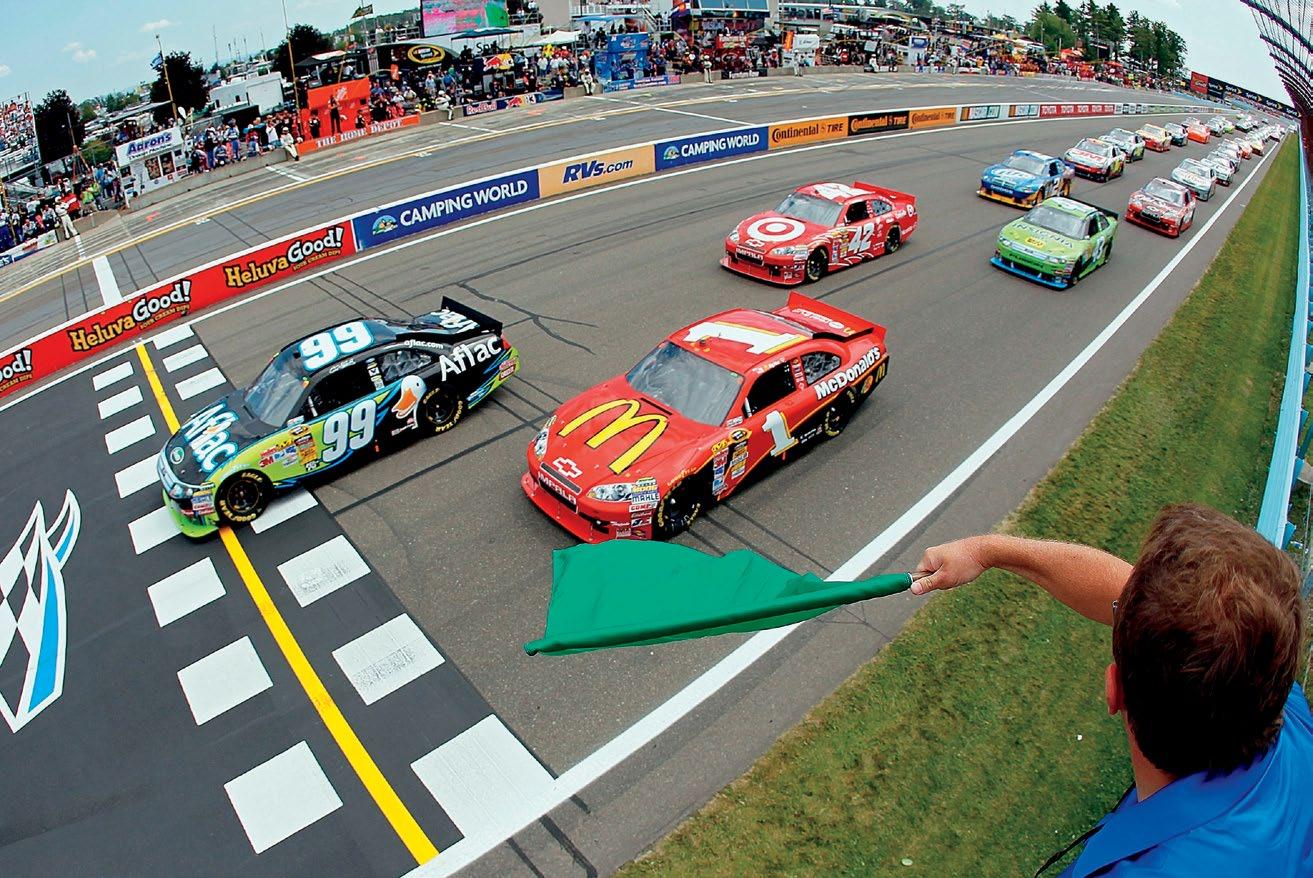
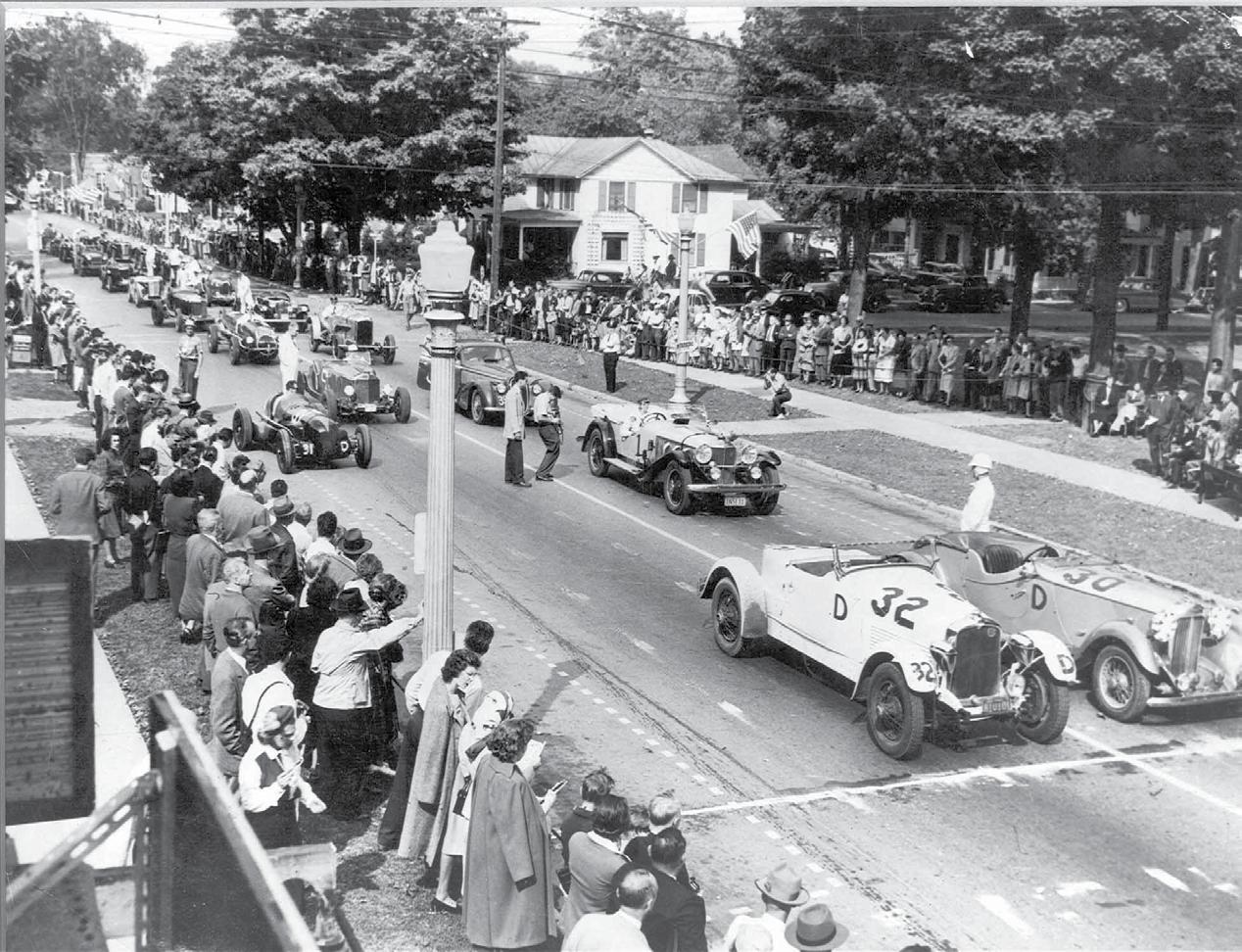




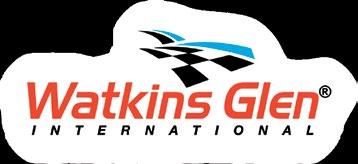


R a c i n g P a s t , P r e s e n t , a n d S o M u c h M o r e . . .
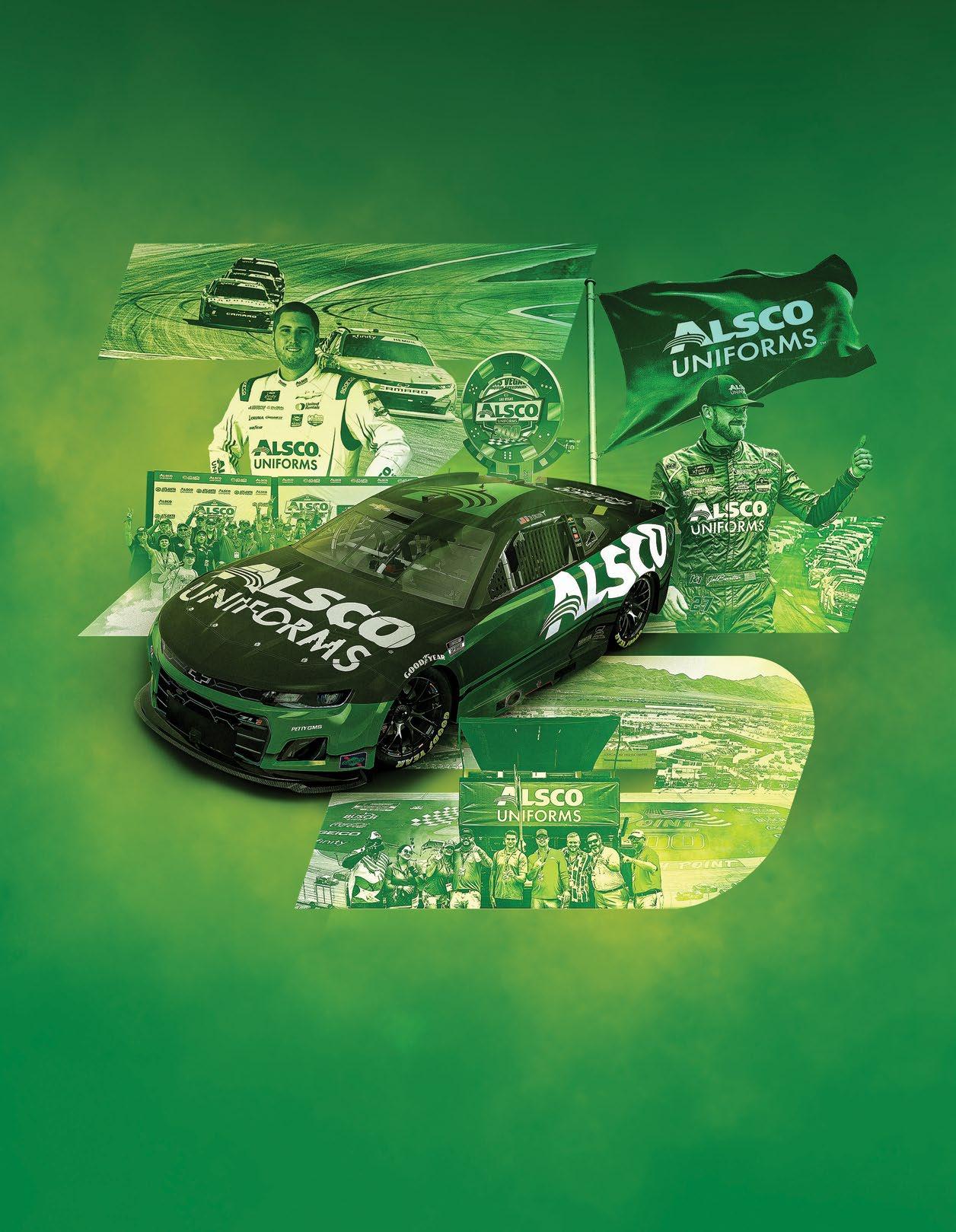
© 2023 Alsco Inc. All
All other
are
of their
rights reserved.
marks
property
respective owners.
































































































































 BY JARED TURNER
BY JARED TURNER





 1979 DAYTONA 500
1992 HOOTERS 500 AT ATLANTA
1979 DAYTONA 500
1992 HOOTERS 500 AT ATLANTA

























































































































 BY BEN WHITE
BY BEN WHITE







 WRITTEN BY RACING HISTORIAN BEN WHITE
WRITTEN BY RACING HISTORIAN BEN WHITE






































































































































































 CWEATHERLY (12) and JACK SMITH (47)
with EDUARDO DIBOS (37)
TOM PISTONE (59)
DRIVERS: JOE WEATHERLY, JACK SMITH, EDUARDO DIBOS, TOM PISTONE
SPONSORS: AIR LIFT SHOCKS, PURE GASOLINE, RUPERT BELTS
CWEATHERLY (12) and JACK SMITH (47)
with EDUARDO DIBOS (37)
TOM PISTONE (59)
DRIVERS: JOE WEATHERLY, JACK SMITH, EDUARDO DIBOS, TOM PISTONE
SPONSORS: AIR LIFT SHOCKS, PURE GASOLINE, RUPERT BELTS












































































































































 WRITTEN BY RACING HISTORIAN BEN WHITE
WRITTEN BY RACING HISTORIAN BEN WHITE









































 THE NO. 3 CAR
THE NO. 3 CAR



























































































